Harold Tristram Squire: october 28, 1868 - may 16,1938 - Artist
The above works, commenced in 1926, were mention in a newspaper in 1930 - there had been an earlier version in 1924 of a H T Squire elephant - more below.
Squire.— On the 6th November, at the Kangaroo Flat Railway Staton, the wife of Mr Tristram E. P. Squire, of a son. Family Notices (1864, November 8). The Herald (Melbourne, Vic. : 1861 - 1954), p. 2. Retrieved from http://nla.gov.au/nla.news-article245508674
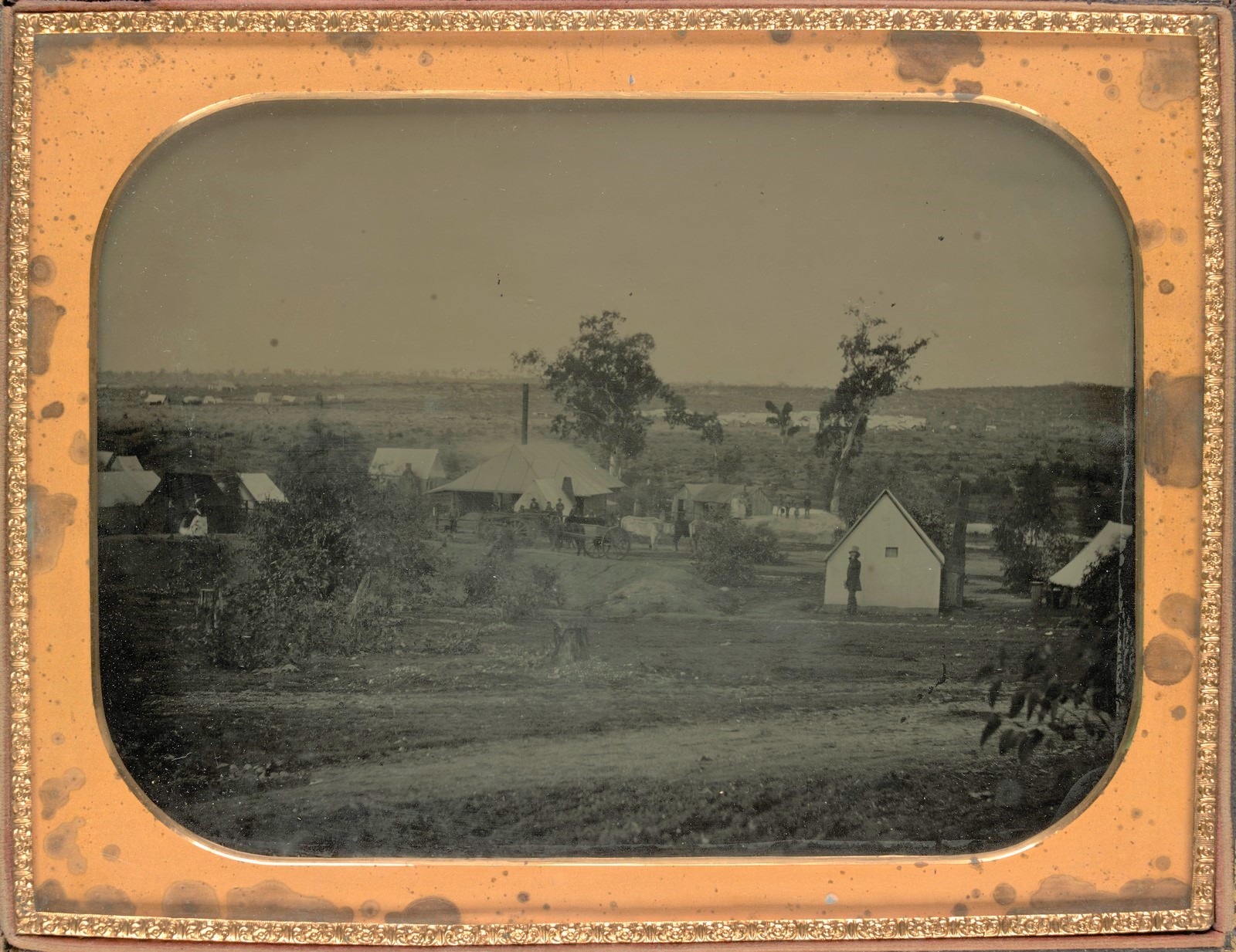
Mining township at Kangaroo Flat or near Ballarat Date [ca. 1856-ca. 1859], courtesy State Library of Victoria. Item: H89.57/2
His father was born in Hants, near the Portsmouth dockyard, the eldest surviving son of William Squire of the Royal Navy and landed in Melbourne a week and a half before Christmas 1852, aboard the Prince Alfred. T. E. P. Squire was 21 when they landed, his brothers Edward Lancaster Fawcett Squire, then aged 14, Henry, then aged 17, and their mother Mary, aged 42, came too. His father was aged 60 according to shipping list records, although his age is given as 74 when he passes away 12 years later.
They came out during the gold rushes towards Mount Alexander in Victoria and when thousands were fleeing the Great Famine (Irish Potato Famine), and Consumption (Tuberculosis) Typhus and Typhoid were rife and taking lives - as they would for decades yet. The Squire family members came via what was then called the 'Mutual Cooperative Principle'.
SHIPPING INTELLIGENCE.
ARRIVED.
December 12-Prince Albert ship, 476 tons Wm Browne, commander from London, via Plymouth, August 3rd. Passengers-one hundred and sixty-one on the Mutual Cooperative Principle. W. Pierce, Esq Surgeon. Raleigh, Locke, Thorpe and Co. agents. SHIPPING INTELLIGENCE. (1852, December 14). The Argus (Melbourne, Vic. : 1848 - 1957), p. 4. Retrieved from http://nla.gov.au/nla.news-article4788512
The Bombay has been placed in quarantine at the Heads, two cases of typhus fever having occurred recently. We have been unable to obtain further particulars. The passengers by the Prince Albert came out under the system adopted by Hall Brothers &c., in London. One of the passengers, named Mr Ross, died suddenly, from a fit of apoplexy, on the voyage. PORT OF GEELONG. (1852, December 14). The Argus (Melbourne, Vic. : 1848 - 1957), p. 4. Retrieved from http://nla.gov.au/nla.news-article4788515
LETTERS for Mr William Squire, from Liverpool, at Mr. Alexander Walker's, 214, King-street. Advertising (1852, December 18). The Argus (Melbourne, Vic. : 1848 - 1957), p. 5. Retrieved from http://nla.gov.au/nla.news-article4788553
A little about the 'Mutual Cooperative Principle':
FAMILY COLONIZATION.
(From the Times, Jan. 16.)
IT appears that the plan lately re com-mended for organizing a system of emigration to Australia on sound business principles is likely to be attempted without delay, and that the Family Colonization Loan Society, founded by Mrs. Chisholm, will constitute its- basis. The course of that society has been to send out emigrants of good character in family groups, a portion of the necessary expenses being advanced, to be repaid from their earnings in the colony. Its success, has been hitherto remarkable, so far as its limited constitution allowed, but the object now is to give it a commercial bearing that shall insure its extension so as to meet the existing emergency. The funds employed by Mrs. Chisholm's society have been raised by voluntary contributions, and, although it was found that strong reliance could be placed upon the punctual repayment of the loans made, and that consequently the principal sum would long be kept intact, new loans being made as old ones were paid off, there was no provision for a proper rate of interest, nor for such additional payment as would cover the risk from occasional defaulters.
The plan, therefore, in that state commended itself merely to those who regarded it for its philantrophy, and, as is usually the case when the fact is lost sight of, that true philanhtropy should be made consistent with mutual advantage, some of the best wishes of its promoters were at the same time counter-acted. They desired to cultivate the independence of the emigrant by placing it in his power to reach his new home, not as a pauper, but as one intending to discharge all the obligations he had incurred. By lending him money, however, without interest or fair compensation for risk, that principle was wholly departed from. If he accept a gift in such a shape he becomes at once a dependent on charity. Whether the sum be £1 for interest or £20 for his passage can, as far as his self-respect is concerned, make no difference. Let this matter be remedied as, it is to be hoped, is now the intention, and not only will he at once assume the position that is desirable, but from that time there will be no further difficulty in raising whatever amount may be required for emigration purposes.
The risk of loss from dishonesty on the part of persons sent out after due inquiry into character will be found much less than most people would anticipate. In the case of emigration to Australia, where the rewards of industry are certain, this would be especially felt. Employers of all kinds would, for their own sakes, co-operate with the Government authorities in giving facilities to protect any society such as is now contemplated, and the emigrants would be known to each other, and would have a mutual interest (which should consist in a reduction of premiums, or a partial return of profits) in promoting punctuality. But, what-ever the risk, the first calculations should be such as fully to cover it in all possible contingencies. Any actuary could define at once its various forms, and no charge that might be required could be anything to set in the scale against the gain which the emigrant would derive. Among other advantages of such a movement will be the adoption of extensive reforms in the management of emigrant vessels, since the profits of a commercial company must depend upon its reputation. Ultimately, also, the still greater benefit may accrue of putting an entire stop to charitable or pauper emigration in any form. No one should be sent to the colony who is incapable of labour, or who, when provided with labour, would refuse to defray what had been expended in enabling him to reach it. The land fund could then be applied to its legitimate uses of constructing internal improvements, and these very improvements would furnish work for fresh arrivals. With such prospects the foundation may be laid of an association which shall offer a new and secure field for capital, and produce incalculable effects on the welfare of the labouring classes. FAMILY COLONIZATION. (1852, May 29). The Sydney Morning Herald (NSW : 1842 - 1954), p. 6. Retrieved from http://nla.gov.au/nla.news-article12937181
AUSTRALIAN MUTUAL COOPERATIVE ASSOCIATION.
Formed for the purpose of ensuring economy in the outfit, comfort in the passage, and success in the Colonies, by J. Q. Ruuball, Esq., of Harpenden Hall, Herts, Member of the Royal College of Surgeons of England, Licentiate of the Apothecaries' Company, and Fellow of several learned Societies ; who is about taking out his own sons to Australia.
The rush to Australia has only commenced. Man has too long felt himself in this country a weed; woman a burden; and children a curse. He wildly seizes, therefore, any opportunity of escaping from so much sorrow, and throws himself headlong into a new land, where he hears that his burdens will be removed, and himself become the most valuable product of the soil.
Can we wonder that his one sole thought is how to leave here, and how to get there ? He asks not-cares not-how he may be robbed before he starts, ill-used on his voyage, or thrown destitute among a rapidly increasing rabble, whoso "auri sacra fames" deprive them of the last touch of humanity long years of disappointed selfishness have left them. To scramble among convicts and outcasts of every nation for that gold which, when found, will neither purchase food nor raiment, nor friends, nor help in sickness or in sorrow ; to live with the drunkard and die his death is and must be the lot of many who are now leaving the land they live in for one which contains, it is true, riches beyond their wildest dreams, but which, also, is the name of the serpent and the sinner.
Such facts as these may well make any man, and especially any parent, think deep and long before he commits himself, or those dear to him, to an under-taking pregnant with good or evil, not only mighty in amount, but which will endure for ever.
Still, this country is overdone. Whilst young men are ready to pay large premiums for the privilege of shutting up their masters' shops, and governesses advertise six lessons a week for four shillings whilst in every rank of life hundreds are starving who would gladly work, were there work (which there is not) to do, the present opportunity will be seized by thousands, as it is by the projector of the following plan, who hopes by its means to secure those who accompany him, as much as may be, from all unnecessary suffering, and, further, to bring about, under God's blessing, the largest and surest obtainable success. He is, therefore, forming a body of young men, sons of farmers, professional men, and respectable tradesmen, whose education and position in life will enable them to join as companions and friends in the formation of any co-operative scheme that may be thought desirable, on their arrival, when a knowledge of the whole condition of the country, and of their own tempers, hopes, and powers, shall place them in a position to form the best plan their then means will enable them to carry out.
At present, it is only necessary to state that the following are the Rules and Regulations suggested for their guidance :
Rule 1.-That no one be admitted whose character, conduct, or conversation would preclude his admission at home. ,
2.-That, although it will be better to leave female members to follow, they will not be rejected if members of the family of those who go.
3.-That each member provide his own particular outfit, subject to inspection and approval by a properly appointed person.
4.-That £10 each be ready for this purchase of tents, tools, and whatever may be found desirable, to take out as common property.
5.-That a vessel be chartered, or passages taken, as may appear most advantageous, on or before July 10th, to sail on or before the tenth of August ; and that half-the passage money be ready by the 10th of July, and the other half one week before sailing on or before the 10th of August.
6.-That each individual possess a reserved fund of £10, to be applied, if so agreed, on arrival in the colony to the support and purposes of the party.
* 7.-Since commencing this plan, Mr. Rumball finds that much more exertion, expense, and responsibility are required of him than he anticipated ; and as every labourer is worthy of his hire, his remuneration must be by a fixed sum of £5 from every individual joining his party-half to be remitted with the first half of the passage money, and the other half with the remainder: none of it to be received by Mr R. until he has fulfilled that portion of his . engagements to which they severally refer. The first half accrues when the passage is taken, the second when on board.
8.-But, that all the sums be forwarded to some respectable Banker, Broker, or Merchant, as they become due, to be employed under his guarantee and 'responsibility, wholely and solely for the purposes for which they are remitted; anti that Mr. Rumball shall not have, nor shall any other person have, over it any control whatever-his services being confined to the following: viz., to ascertain the best, cheapest, and safest mode of transit; To ascertain and provide everything necessary to the voyage and operations; then to see that all goods, whether personal or joint stock, be of the best quality, properly packed and stowed; To collect every information in his power, and facilitate the whole arrangement ; To go out as 'Surgeon of the ship, and to consider the whole hotly as possessing the same claims upon him with his own sons. When there, it is recommended that a plan be arranged and engagements entered into for an equal division of labour and profits; thus, whether as farmers, cooks or carpenters, merchants or shepherds, bankers or gold diggers, the one principle of union' may still be carried out That, as a company, whilst some dig, buy sheep, land, or gold dust, the only difference in any man's emolument shall be measured by his own industry. That there will be much difficulty in working out this scheme is evident ; hut, though all should sever on landing, and go each his own way, seeking his own good, still the option will remain, and, at all events, all will have been done that human forethought can accomplish.
9.-Sufficient for the day is the evil thereof. The question is a simple one-whether union is strength or not. Whether a combination, such as described, is not far more likely to succeed than isolated efforts? And whether the morality and physical comfort of such a party will not be more certainly ensured than of a single individual, with no one by to be a present help in trouble, or a cheerful companion in success.
10.-The total amount of money wanted for each is £50-thirty for personal and twenty for joint-stock purposes. Should a separation take place, an equitable division must be made; but this question, like many others, can be better settled by the whole body interested, either on the passage out or on their arrival, than by any individual-beforehand. Of course each individual may take as much more money as he may think desirable for his own private use.
11.-That Melbourne be the destined port, unless some circumstance shall arise before fixing which shall be considered by all parties as making it ineligible.
As Fares are rapidly rising, immediate application (with references) is necessary to J. Q. Rumball, 5, Arthur-street, New Oxford-street. At home daily from 12 till 2. 5, Arthur-street, New Oxford, June 30.
Sir,-I forgot to state yesterday that the joint-stock purposes won't do. No money will be wanted there fore for that purpose, unless by those who choose to unite out there. Each individual will therefore supply his own wants. What they are I will write to you if you agree to send your sons with me, and will treat them as my own, both out and there.
Your obedient servant,
J. Q. Rumball.
Whitehouse, Kirkby Lonsdale,
July 1st.
Sir,-I duly received^ your kind reply, and beg to say that since communicating with you I have seen a most intimate acquaintance of mine, who, with his whole family, has determined (owing to the depression of the farming interests in this country) to emigrate ... of my case, offered to take charge of my two sons out there for very reasonable terms, viz. tor £30 each, I am induced to accept his offer, more especially as he sails from tho Port of Liverpool, which being much nearer at hand, I shall have the opportunity of seeing the two lads off myself. I am greatly obliged for your kind reply, and if I could serve you in any other way, hi recommending other intending emigrants, it will afford me much pleasure.
I am, Sir yours most respectfully, To J. Q. Rumball, Esq., Haipenden Hall, Herts. AUSTRALIAN MUTUAL COOPERATIVE ASSOCIATION. (1853, March 16). The Courier (Hobart, Tas. : 1840 - 1859), p. 2. Retrieved from http://nla.gov.au/nla.news-article2239521
A description of the 'gold rush' to Mount Alexander by one who was part of it:
A SAILOR'S TRIP FROM MELBOURNE TO MOUNT ALEXANDER.
The following graphic and spirited sketch of a trip from Melbourne to Mount Alexander, appears in the Sydney Morning Herald, and is as good as anything we have seen in that line :
This long looked for, half dreaded event was now to come off; the ride of eighty miles "outside of a horse " was to be undertaken; and as my two friends and fellow travellers came up to the gate fully equipped for the road, I felt a slight misgiving as to the result of this my first serious essay as a horseman. Sundry visions floated before my eyes of the wild ungovernable steed running away with me, or, still more terrible, giving me a specimen of buckjumping. This I have been told is purely a colonial accomplishment. Whether that be the case or not, mattered little to me then. I had often seen it exhibited, and though wonderful in appearance, like the motion of a ship in a head sea, to which I had been tolerably well seasoned, I felt would in reality be quite a different affair, and that my sea legs would "advantage me nothing" in that sort of motion, but over the bows of the horse I should be certain to go. I was no judge of horse-flesh, or I need not have driven myself the slightest concern ; for the one-eyed charger which was to carry me was quite incapable of any such feat of agility.
Well, having got fairly under way, we scampered out of town at a tolerable rate.
The weather was oppressively hot, one of those clear hot wind days, when the rays of the sun seem to reach you through a burning glass, and every puff of air, in-stead of cooling and refreshing, comes as if it were a hot blast from a furnace, raising with a whirlwind those singular pyramids of dust, which however interesting and picturesque as they may appear, as they unquestionably do in the distance, are anything but pleasant when "whirled" over you, filling your eyes, nose, mouth, ears, and shirt collar, with dust. Under these circumstances, of course we had to stop at the first available place to " clear the cobwebs," out of our throats. This was at the Inn at Flemington, two miles out of Melbourne, where while we were discussing our lemonade, some of the numerous loungers outside the door managed to steal my whip, so that my horse, who had already begun to require it, was likely to have it all his own way.
I was told that organized bands of vagabonds are always lurking about these inns, watching mostly for opportunities to rob the returning gold digger, but filling up any spare time they may have on their hands by such petty thefts as these.
A few miles further on the road, we fell in with a friend returning from the diggings, with several pounds weight of gold strapped on the pummel of his saddle, in his blanket. He had been keeping company with the escort through the most dangerous part of the road, and was now pushing on for town, having left them a few miles behind. Knowing the qualities of my steed better than I did, he kindly offered me one of his spurs, telling me 'very significantly' that I should soon want it, and having in my short, experience arrived at the same conclusion, I gladly accepted it.
Another heave-to, to "whet our whistles" at an inn a few miles further on our road kept by a Vandemonian, where the entertainment for travellers was of rather a rude description; and the landlord, land-lady, and the whole houseful of customers seemed brutish in the extreme, and quite at variance with my preconceived notions of the quiet of a country inn ; but I was only a sailor, and had a great deal to learn. However, great allowance must be made for golden times, as each of these publicans must be making a rapid fortune, and as a general rule my experience of the world has taught me that in proportion as the money comes in among uneducated men at least, so common civility goes out.
Stopped to dinner at the Deep Creek Inn, about a dozen miles out of town. This is another of these houses, which evidently had never been the resort of any but the genus " bullock driver " prior to the discovery of gold, and ought never to have risen above that level. Here we dined with three gentlemen, unmistakable gentlemen by their conversation, though their long beards, blue over-all shirts, and muddy trousers if dress were a standard of gentility, would rather have led to the supposition that, they belonged to the class for whom the hospitalities of the Deep Creek Inn were evidently originally intended.
They were returning from the Diggings, where they had done well, but complained much of the scarcity of water for washing out the gold, and even for drinking purposes, the latter causing much illness. Two out of the three were suffering much from inflammation of the eyes, caused as they supposed by the flies, which they told us were very numerous and excessively troublesome, and judging from appearances I should say extremely painful also.
During our meal two "gentlemen" of another kidney arrived, handcuffed together, and under the charge of two mounted policemen, who having left their horses, immediately entered the room where we were, took the irons off their prisoners and "sans ceremony" all four sat down together at the some board with ourselves; one of these men it appeared was commit-ted to take his trial for a felony, the other in default of bail to keen the peace, was to serve six months in gaol for an assault.
Both were travelling to Melbourne on foot in that oppressively hot day, and each endeavoured to obtain permission from the sergeant in charge to remain where they were for the night ; the assaulted tried his most pathetic powers of persuasion ; the felon tried what in colonial parlance is expressively termed "bounce," by saying that he had come fifteen miles already that morning, and that he neither could or would go on---but the ruler of their movements was inexorable, and with the invariable answer "my orders are for Melbourne to-night" they were at last marched off, growling as far as we could hear, that they would go no farther.
At eight o'clock, being just after dusk, we arrived at the Bush Inn, thirty-five miles from Melbourne. On enquiring for entertainment we found that the horses, our first care, could not by any possibility be stabled, so it being quite dark we led the animals over a rugged road to another hostelerie, a quarter of a mile off, where we found plenty of room in the stables, but nothing for them to eat, so tired enough we retraced our steps to the Bush Inn, placed the animals in the stockyard, and by dint of the most obsequious behaviour to the ostler, procured a few armsfull of hay, which having taken to the horses ourselves, and waited to see them eat, we sought the interior of the inn, there to administer some comforts to our inner man. After the same course of proceeding with the waiter, us with the ostler obtained for our horses, we at length procured some supper for ourselves. I was inclined to have used a different tone, but was significantly reminded by my friends that " in these gold digging times bounce won't do."
The house was full of people of all classes, and I was informed, I have no doubt with truth, that the landlord during this stir is in the weekly receipt of from eight hundred to eleven hundred pounds. This for an obscure country inn is enormous, and I have no doubt that at last two-thirds is profit. With difficulty we obtained " beds for three" in a small closet of a place, every cranny of the house being filled with be is ; and when I awoke in the morning, and looked out on the verandah, I could see several persons sleeping on, and others just risen from beds, evidently made up there from the insufficiency of room within the hotel. We breakfasted at six o'clock, saddled, our horses, and started. The hot wind of yesterday had been succeeded by a chilly morning, and dark clouds travelling rapidly from the westward, with occasional spittings of rain, gave omen of a cooler ride than that of yesterday. A short distance from the Bush Inn we entered the Black Forest, and soon the rain, which before was confined to a few drops occasionally, came down in real earnest, thick, fast and constant. We were soon wet through, and our steeds, none of the best originally, showed symptoms of preferring a walk to any other pace. The excessive heat of the previous day, added to a rough night in a stockyard, with but little to eat, had not improved their powers of progression. We however jogged on at a slow pace, the continuous strings of wayfarers up and down which we had never ceased to pass since leaving Melbourne, still kept up their scarcely broken lines, but by far the greater proportion were like ourselves ----outward bound. The rain seemed to have no effect in delaying or retarding their progress. On horseback, in carts, on foot, alongside of drays that were carrying their luggage, swag they called it, or alongside of no drays, but carrying the swag themselves, they plodded along, seemingly unconscious of the drenching they were getting, or probably thinking that as the great bune of the diggers was want of water, the good in perspective would more than counterbalance any present inconvenience. I confess this was in my thoughts, and when the next day those we met told us that the rain had not extended to the Mount, I felt disappointed. Safely through the Black Forest, and slowly on the road we wended our way. The rain had cleared off, and a cutting wind set in ; but no " cutting " seemed to affect our steeds, which we were frequently obliged to dismount and take in tow, and when we arrived at the township of Kyneton, twenty miles from the Diggings, they were evidently too much knocked up to perform the remain-der of the journey that day at least, so they were turned into a paddock, and we were compelled most reluctantly again to seek the shelter of an inn on the road to the Diggings. Crowded like the one of last night, in bar and parlour, in kitchen and tap room, in every imaginable part of the lower portion of the house, with men in every garb and of various physiognomies, in which the decidedly scampish greatly predominated, promised anything but it pleasant night. However we early engaged our three beds together in the same room, for which we soon had cause to congratulate ourselves. (To be continued) A SAILOR'S TRIP FROM MELBOURNE TO MOUNT ALEXANDER. (1852, May 19). The Argus (Melbourne, Vic. : 1848 - 1957), p. 6. Retrieved from http://nla.gov.au/nla.news-article4785126
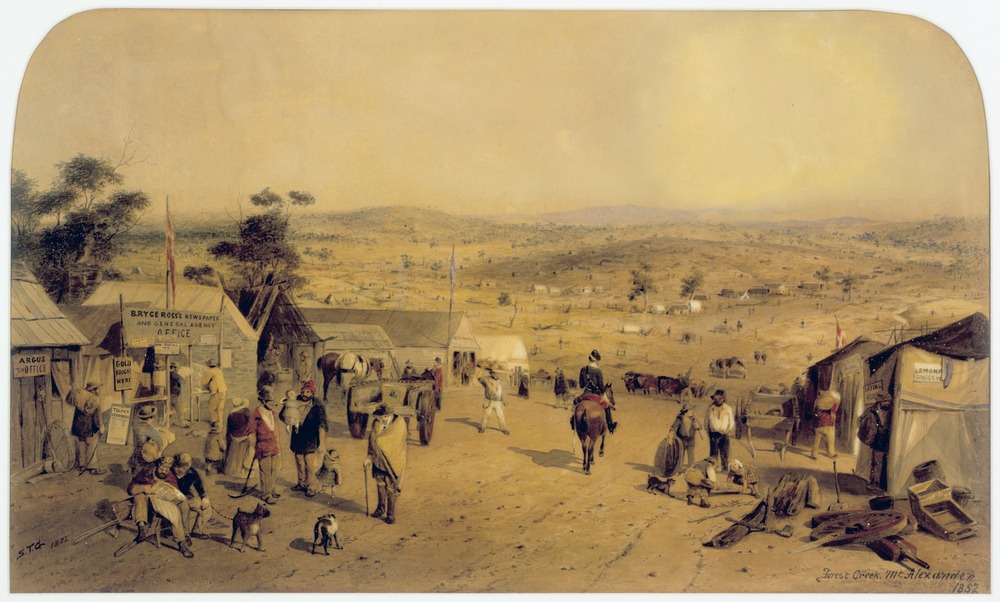
Forest Creek, Mt. Alexander 1852 [picture]. by S. T. Gill (Samuel Thomas Gill), 1818-1880.- Titled lower right., Signed and dated lower left: S.T.G. 1852. Frame: gilt wood. Gift of Miss Blundell 1930. This work, and its pendant, Eagle Hawk Bendigo, was first exhibited in Melbourne in February 1853. Shows from left, Bryce Ross's Newspaper and General Agency office, M & S Marks Adelaide Store, and Eating house. Courtesy State Library of Victoria. Item b28337:2600204/ SLV Source ID: 1653668
The Squire family did not rush to the goldfields - their two youngest son Edward went to South Australia and commenced a career in the public service, T.E.P. Squire stayed in Victoria, to work and to marry.
SHIPPING INTELLIGENCE. I Saturday, February 5—The Government schooner Yatala, 81 tons, Nation, master, from surveying along the coast. Same day—The brigantine Adelaide Packet (formerly Arabian), 138 tons, Boberts (late of the Selma), master, from Melbourne, 28th January. Passengers—Mr and Mrs Walker and two daughters, Mr and Mrs Squire and two children … SHIPPING INTELLIGENCE. ARRIVED. (1853, February 12). Adelaide Observer (SA : 1843 - 1904), p. 5. Retrieved from http://nla.gov.au/nla.news-article158092960
William (Bill) Squire R.N., had been born on February 24 1790, in Stoke Damerel, Plymouth, Devonshire, England to Tristram Austin Squire and Ann (born Charnley - sometimes spelt 'Cholmondeley'). Tristram was born on March 6 1747, in Stoke Damerel, Plymouth, Devonshire, England, UK and Ann was born in 1757, in Devonshire, England. Tristram married Ann at Stoke Damerel on May 1st 1775. The Marriage entry states that Tristram was a tin plate worker.
William was one of at least 11 children, which included a brother who would also serve his country in the armed forces, Tristram Cholmondeley or Charnley Squire, 1782/85 - 1855. William's wife, Mary Isabella Squire (born Rankin) was born in 1792, in Norwich, Norfolk, England. Their son Tristram Edward Pitfield was born in 1831, one of at least 10 children, some of whom they lost along the way through disease.
William entered the Navy July 19th, 1805; passed his examination in 1814(Name Squire, William Rank: Lieutenant Date of Appointment: 12 August 1814); obtained his commission 10th January 1825; was appointed 16 November following, and 19th Feb 1830 to the Ramilles and Talavera 74’s, Coast-Blockade ships, both commanded by Capt. Hugh Pigot; and from April 15 1831 until the early part of 1834, was employed in the Coast Guard.
Lieutenant William Squire served on these ships:
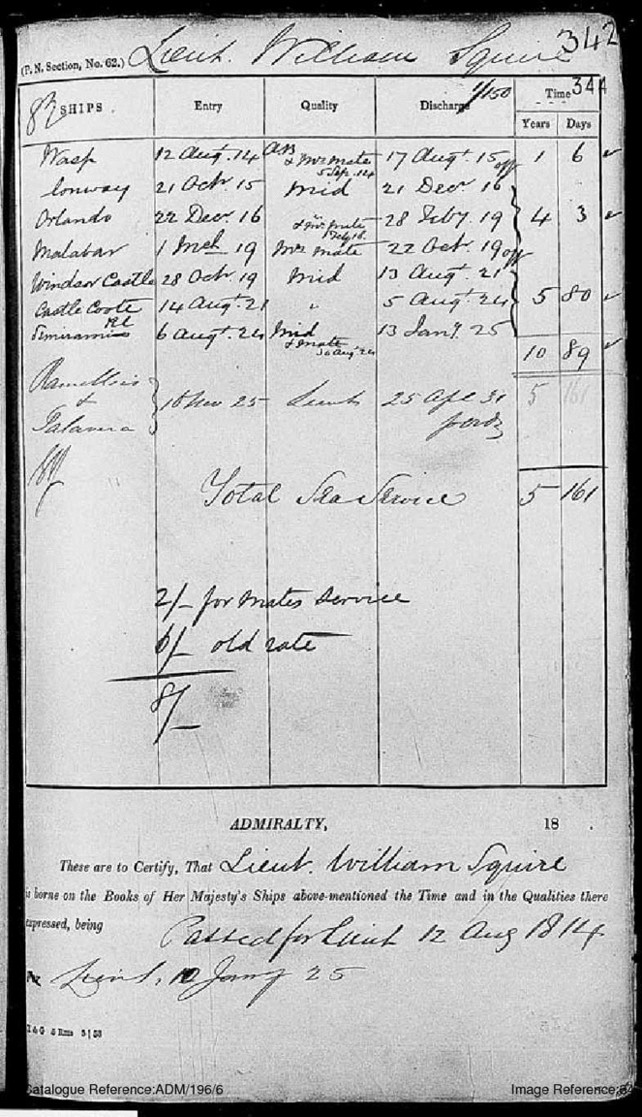 Wasp – entry August 12th 1814 Asst and NWS? Mate – discharge August 17th, 1815 – 1 year, 6 days: HMS Wasp (1812) was an 18-gun Cruizer-class brig-sloop launched in 1812. She was broken up in 1847.
Wasp – entry August 12th 1814 Asst and NWS? Mate – discharge August 17th, 1815 – 1 year, 6 days: HMS Wasp (1812) was an 18-gun Cruizer-class brig-sloop launched in 1812. She was broken up in 1847.
Conway – entry October 21st, 1815 – midshipman – discharge December 21st 1816: Four ships and a shore establishment of the Royal Navy have been named HMS Conway after the River Conwy in North Wales, formerly known by its English name of Conway. Two were launched as Conway, while another two were renamed: HMS Conway (1814) was a 20-gun sixth rate launched in 1814 and sold in 1825; she became the merchantman and whaler Toward Castle and was wrecked in 1838
Orlando – entry December 22nd 1816 - ?? mate – discharge February 28th 1819: HMS Orlando has been the name of four ships of the Royal Navy. HMS Orlando (1811) was a 36-gun fifth rate launched in 1811, used for harbour service or as a hospital from 1819 and sold in 1824.
Malabar – entry March 1st 1819 – m?? Mate – discharge October 22nd, 1819 - HMS Malabar (1804) was a 56-gun fourth rate, previously the East Indiaman Cuvera. The Admiralty purchased her in 1804 and had her rebuilt as a 20-gun storeship in 1806. She was renamed HMS Coromandel in 1815 and transported convicts to Australia in 1819. From 1828 to 1853, when she was broken up, she served as a prison hulk in Bermuda, beginning a long association between this name and the colony. Malabar 74 (1818) – hulked as coal deport Portsmouth 1848, renamed Myrtle 1883, sold 1905: HMS Malabar was a 74-gun third-rate ship of the line of the Royal Navy, launched on 28 December 1818 at Bombay Dockyard.
_after_N._Condy_1832.jpg?timestamp=1583113860768)
Windsor Castle – entry October 28, 1819 – Mid- discharge August 13th, 1821 Windsor Castle 98 (1790) – razed to 74-gun-ship 1814, broken up 1839
Castle Cootle or Cooli or Coote? – entry August 14th, 1821 – Mid – discharge August 5th, 1824
Simission ? Simisassion – entry August 6th, 1824 – Mid and Mate (august 1824) – discharge January 13th, 1825
Ramilles and Talavera – entry November 18th, 1825 – Lieut. – discharge April 25th , 1831
At first the family seems to have gone to Canada after his discharge:
1834 – arrivals in Quebec and Montreal - Arrived at the Port of Quebec Saturday May 24th - MG
May 21 bark Joseph Storey Mullent 03 April From London Lieut. Squire, R.N., lady, family and servants ; Messrs. Edington and Price | 8 settlers to Lemesurier / general cargo
In 1837 he is in Montreal Harbour where their son Edward Lancaster Fawcett Squire (25 September 1837 – 7 October 1893) was born. Edward would later be Deputy Postmaster General and Superintendent of Telegraphs, in the colony of South Australia. Historical accounts state 'Edward Squire was born the youngest son of Lieut William Squire RN (c. 1790 – 20 July 1864), an English ship's captain, on board his ship, in Montreal harbor. - born on September 25 1837, in Gulf of St.Lawrence, Canada.'
No name is given for that ship - but a decade later Lt. Squire is still on the seas;
Letter from William Spooner to Sir Nesbit Willoughby: The Family and Estate Papers of the Willoughby Family, Lords Middleton, of Wollaton, Nottinghamshire, Middleton,...Papers of Admiral Sir Nesbit Josiah Willoughby (1777-1849), Captain Francis D.... Petitions Sir Nesbit for help in getting a commission aboard the Brig Packet bound to the Cape of Good Hope under Lieutenant William Squire. Source; Held by: Nottingham University Library, Department of Manuscripts and Special Collections. Date: 02 March 1847
And just prior to embarking for Melbourne, Australia:
At St. John's, Forton, Hants, John, eldest son of the Hon. Colonel Ross, Commander of the Garrison at St. Helena, to Mary-Isabella, only surviving dau. of Lieut. William Squire, R.N. of Brockhurst, Hants, and niece of Col. Tristram Charnley of Ghuzuee Lodge, Devon and Abrdige, Essex- . Source: The Gentleman's Magazine - Volume 186 - Page 199 1849
In February 1853, Edward Prickett, Solicitor, aged 58, his wife Frances, aged 58, and two daughters, Alice aged 20 and Fanny aged 26, disembarked from the Barrackpore in Melbourne. They left England on November 10th the previous year
February 13.—Barrackpore, from London : 46,810 boards, 36 wheels, 142 packages, 8 bales, 420 cases, 21 chests. The Barrackpore, a fine ship belonging to the Messrs. Lindsay, of London, arrived here, yesterday, making a pleasant passage of ninety-four days from Dartmouth. She brings a large number of passengers, and is commanded by Captain R. Underwood, formerly of the Dickson.—Ibid. MELBOURNE SHIPPING. (1853, February 19). Empire (Sydney, NSW : 1850 - 1875), p. 2. Retrieved from http://nla.gov.au/nla.news-article60137941
Also aboard this ship were relatives of the Prickett family, Edwain (aged 16) George (aged 25) and Llewellyn Jones (aged just 6 years):
On the 24th February, at No. 210, King-street, Melbourne, after a short illness, Llewellyn Prickett Jones, aged 6 years, the beloved and lamented nephew of Mr. Prickett, solicitor, of the above place, and the youngest son of the late Commander Richard Jones, R.N. Family Notices (1853, March 1). The Argus (Melbourne, Vic. : 1848 - 1957), p. 4. Retrieved from http://nla.gov.au/nla.news-article4790248
In the Will of Richard Jones, Retired Commander in the Royal Navy of Borough of Plymouth , Devon – July 1st, 1847 – his wife Emily is named, although she has clearly not made the journey.
IN THE SUPREME COURT OF THE COLONY OF VICTORIA.'
I, EDWARD PRICKETT, lately residing at Aylesbury, in the County of Buckingham, in that part of the United Kingdom of Great Britain and Ireland, called England, but now residing in Little George-street, Collingwood, in the City of Melbourne, in the Colony of Victoria aforesaid, gentleman, one of the attorneys of her Majesty's Court of Queen's Bench at Westminster, do hereby give notice, that on Monday, the fourth day of April next, being the last day of the first term, for the present year, of the Supreme Court of" the Colony of Victoria, I intend to apply to be admitted an attorney, solicitor, and proctor of the said Court.
Dated this seventeenth day of March, 1853. EDWARD PRICKETT. Advertising (1853, March 23). The Argus (Melbourne, Vic. : 1848 - 1957), p. 1. Retrieved from http://nla.gov.au/nla.news-article4790930
In 1841 – Aylesbury: from The 1841 census of Aylesbury, Buckinghamshire. Taken on 6th June 1841.
Walton Street 63 Edward PRICKETT Age 45 Attorney
Walton Street 63 Frances PRICKETT Age 40
Walton Street 63 Louise PRICKETT Age 30
Walton Street 63 Edward PRICKETT Age 11
Walton Street 63 Alice PRICKETT Age 9
SUPREME COURT.
FIRST TERM SITTINGS.
Monday, April 3rd, 1853.
(Before the full Court)
The Court opened at ten o'clock this morning, at which hour the body of the court was crowded with the applicants for admission to practice as Attorneys by gentlemen recently arrived from England.
ADMISSION OF ATTORNEYS.
This being the last day of term, the following gentlemen from the various Courts at home, were admitted as Attorneys, Proctors, and Solicitors of the Supreme Court of the Colony of Victoria:—Edward Sandford, Joseph Hines, Frederic Atkyns, John Armstrong, Joseph Gibbes Duffett, Charles Shaw, Hamilton Gray Gardner, William Edward Troynam, Richard Comins, Edward Fitzgerald, John George M. Wigley, Charles C. Bancroft, James Benson, Thomas Patten, Hugh Wallace, Henry Adolphys Bronkhurst, Nathaniel Davis Jones, Samuel Bradford Vaughan, Oliver Lumen Han-burg, Samuel Toynber, James Macoboy, Edward Prickett, Frederick John Coote, Robert Boyle Davis—twenty-four in all. SUPREME COURT. (1853, April 5). The Argus (Melbourne, Vic. : 1848 - 1957), p. 9. Retrieved from http://nla.gov.au/nla.news-article4791297
Within a short time, T. E. P. Squire marriage to the elder Prickett daughter, Fanny, took place - it is uncertain whether the Royal Navy connections shown in other Prickett relatives led to this connection but those still in the RAN today have a saying 'once in the Navy, always in the Navy' so even if Commander Richard Jones and Lieutenant William Squire did not know each other when working as Royal Navy officers, there would have been a connection, perhaps made stronger in this new place and land:
MARRIED.
On the 24th inst, at St. Andrew's Church, Brighton, by the Rev. Samuel Taylor, Tristram Edward Pitfield, eldest son of Lieutenant William Squire, Royal Navy, late of Gosport, Hants, to Fanny Maria, eldest daughter of Edward Prickett, Esq., solicitor, Melbourne, late of Aylesbury, Bucks. Family Notices (1855, February 28). The Argus (Melbourne, Vic. : 1848 - 1957), p. 4. Retrieved from http://nla.gov.au/nla.news-article4804980
News and letters from home brought sad news for his father and also show he and his wife are in Melbourne:
DIED. On the 10th June, at Felpham Lodge, Bognor, Sussex, Lieutenant-Colonel Tristram Charnley Squire, late of her Majesty's 13th Light Infantry, only brother of Lieutenant William Squire, R.N., of this city, —a brave and distinguished officer, deeply and deservedly regretted by his sorrowing family and friends. Family Notices (1855, October 2). The Argus (Melbourne, Vic. : 1848 - 1957), p. 4. Retrieved from http://nla.gov.au/nla.news-article4819794
Births. On the 16th instant, at Williamstown, the wife of Tristram E. P. Squire, Esq., of a daughter. Family Notices (1857, March 18). The Argus (Melbourne, Vic. : 1848 - 1957), p. 4. Retrieved from http://nla.gov.au/nla.news-article7146378
This child is named Alice Fanny, a combination of her aunt and her mothers' names. Unfortunately this daughter did not live long:
Deaths. On the 15th inst., at 43 Victoria-parade, Collingwood, Alice Fanny, the infant daughter of Mr. Tristram E. P. Squire, and grand-daughter of Mr. Prickett, solicitor, Melbourne, aged 10 months. Family Notices (1858, January 18). The Argus (Melbourne, Vic. : 1848 - 1957), p. 4. Retrieved from http://nla.gov.au/nla.news-article7145217
In February 1859, Mary Squire, T E P Squires' mother, died at Ararat, which had become a new goldfield from 1857 on. She is not named in this simple Notice:
DEATHS.
On the 5th inst., at Ararat, the wife of Lieutenant W. Squire, R.N. Family Notices (1859, February 17). The Argus (Melbourne, Vic. : 1848 - 1957), p. 4. Retrieved from http://nla.gov.au/nla.news-article7309997
Ararat is a city in south-west Victoria, Australia, about 198 kilometres west of Melbourne, on the Western Highway on the eastern slopes of the Ararat Hills and Cemetery Creek valley between Victoria's Western District and the Wimmera.
By June of the same year the local newspapers report gold being sent to Melbourne as: SATURDAY'S ESCORT.—Ararat, 5027 ounces; Pleasant Creek, 1633 ozs. 10 dwts.; total, 6665 ozs. 10 dwts.
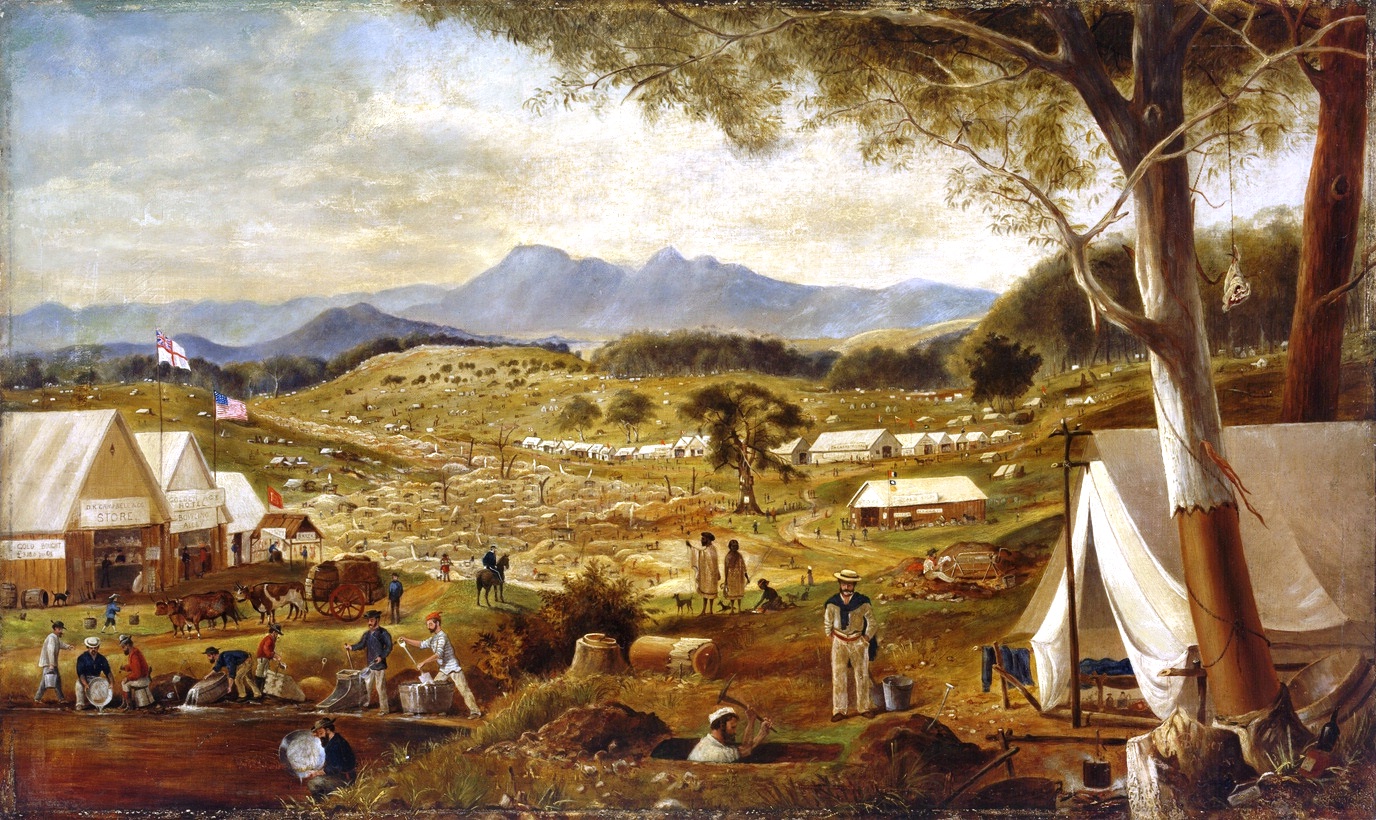
Edward Roper, Gold diggings, Ararat, ca. 1854–58, oil on canvas, courtesy Mitchell Library, State Library of New South Wales
Prior to the European settlement of Australia, Ararat was inhabited by the Tjapwurong Indigenous Australian people. Europeans first settled in the Grampians region in the 1840s after surveyor Thomas Mitchell passed through the area in 1836. In 1841, Horatio Wills, on his way to selecting country further south, wrote in his diary, "like the Ark we rested" and named a nearby hill Mt Ararat. It is from this entry and the nearby Mount that the town takes its name. The Post Office opened 1 February 1856 although known as Cathcart until 31 August 1857.
In 1857, a party of Chinese miners en route to the Central Victorian gold fields struck gold at the Canton Lead which marked the beginning of great growth in Ararat. The Chinese community was substantial in Ararat, and the Gum San Chinese Heritage Centre commemorates the history of the community. Rapid growth brought about a municipality, which was incorporated as a borough on 24 September 1858.
No record of Mary Squires death exists in Victoria’s Births, Deaths and Marriages registers. Mary Squires' grave or last resting place, who died during Summer and would have been quickly buried, is unknown. William Squire then went to South Australia, where he passes away 5 years later.
Later that same year Tristram Squire lost his wife, the Death Certificate stating she died of 'Fever that lasted 11 days' and that a child, Mabel Rose was born in 1959 and is 5 weeks old.
On the 13th inst., at Brunswick-street, Collingwood, Fanny Maria, the beloved wife of Mr. Tristram E. P. Squire, and eldest daughter of Mr. Prickett, solicitor, Melbourne. Family Notices (1859, September 15). The Argus (Melbourne, Vic. : 1848 - 1957), p. 4. Retrieved from http://nla.gov.au/nla.news-article5688096
On December 21st, 1860, in Melbourne, Tristram E P Squire married Fanny's younger sister, Alice Mary.
As can be seen above, the loss of at least three members of his family, and moving from one address to another, would have been expensive, with the result:
Tristram Edward Pitfield Squire, of Brighton, station master. Causes of insolvency: Sickness in family, pressure of creditors, reduction of salary to an amount-barely sufficient for the support of himself and family, thereby preventing his setting apart any portion of his salary for the payment of his creditors. Debts, L83 18s 5 jd ; assets, L8 deficiency, L80 18s 54d. Official assignee, Mr. Jacomb. INSOLVENT COURT (1861, April 10). The Herald (Melbourne, Vic. : 1861 - 1954), p. 7. Retrieved from http://nla.gov.au/nla.news-article244308592
The L8 debt discharged, perhaps Edward Prickett stepping in to help out what is left of his relatives:
IN the SUPREME COURT of the COLONY of VICTORIA : Insolvency Jurisdiction.-In the Estate of TRISTRAM EDWARD PITFIELD SQUIRE, of Brighton, Stationmaster.-Notice is hereby given, that the above-named Tristram Edward Pitfield Squire intends to apply to the Chief Commissioner of Insolvent Estates for the colony of Victoria, on Monday, the twenty-ninth day of July next, at the hour of ten in the forenoon, that a CERTIFICATE of CONFORMITY and DISCHARGE under the Act of Council 7 Victoria, No, 19, be granted to him. Dated this 27th day of June, 1861. T. E P. SQUIRE, In person. Advertising (1861, June 28). The Argus (Melbourne, Vic. : 1848 - 1957), p. 8. Retrieved from http://nla.gov.au/nla.news-article5701419
SQUIRE.—On the 13th inst., at Brighton, the wife of Mr. Tristram E. P Squire of a daughter. Family Notices (1861, October 15). The Argus (Melbourne, Vic. : 1848 - 1957), p. 4. Retrieved from http://nla.gov.au/nla.news-article5705005
This daughter is named 'Edith Alice' and as can be read, the family is now at Brighton, where once again Tristram Squire is a station master:
THE LATE ACCIDENT ON THE BRIGHTON RAILWAY.
The following is the report of the Government Engineer-in-Chief, Mr Higinbotham, on this accident. The report was laid on the table of the Legislative Assembly yesterday evening by Mr Johnstone —
Engineer-in -Chief's Office, Railway Department, Melbourne, 27th May, 1862. Sir, — I have the honor to report to you on the accident which occurred on the Brighton Railway on Thursday last, the 22nd inst. The facts are these: —
The down train which left Melbourne at 9.45 on the morning of Thursday last, ought, if it kept time, to have arrived at Brighton Beach at 10.20 a.m.; it did not, however, arrive until 10.55 a.m. After the engine had been uncoupled from the train, she went forward to the points and got off the rails when, about twelve feet from them, in consequence, it is stated, of the road being out of guage. The station master, Robert Tupp, directed the guard, John Billinge, to go back to Bay street and tell Mr Squire, the station master there, that the engine was off the line, and to send men and screw-jacks, as there were no screw-jacks on the engine.
The station master is positive that this is the only message he sent, but he says that the guard Billinge, who took the message, also took a message from the engine driver, William Mathinson, to the stationmaster at Bay street, that he was to send a message to Chapel street to work the Chapel street end of the line only, as the Brighton end was stopped. Another witness, Edwin Balleabury, states that he heard this message given to the guard by both the stationmaster and the driver; but the guard is positive that the only message he was directed to deliver was, that for the men and screw jacks. The engine-driver, Mathinson, says that, after the guard had left he requested the stationmaster to send a message to Bay street to the stationmaster there, directing him to dispatch a man to Chapel street with the intelligence of the accident, and informing the authorities there that the line was to be worked between Melbourne and Chapel street only; and Mathinson states further, that the stationmaster, Tupp, went to the hotel and endeavored to get a horse, that the message might be conveyed more quickly, but he failed to do so. There is some discrepancy in the evidence on this point. I believe that this account of the engine-driver, John Mathinson, is the most accurate. It is quite certain, however, that the only message delivered at Bay street was that asking for the men and screwjacks. But the station-master at Bay street appears to have felt the necessity for communicating what had occurred to Chapel street; and the guard, Billinge, having a hurt which prevented his walking, a porter of the name of Roche was despatched, carrying a message to the engineer and traffic manager, Mr Sacre, that the engine had slipped off the points at the beach, and that this was the cause of the detention.' This message, like all the others, was a verbal one, Mr Squire stating that he was unwilling to detain Roche by writing it. Roche left Bay street at about twenty minutes past eleven o'clock, and proceeded on foot to Chapel street. At Elsternwick. station he met the station-master, to whom he told the message. He told, also, some platelayers on the road. On his arrival at Chapel street, he was told that Mr Sacre was at the Melbourne end, but was expected by the next train. Roche arrived at Chapel street about twenty minutes past twelve o'clock. Mr Sacre came to Chapel street by the next train from Melbourne, which arrived there at forty-three minutes past twelve p.m., and Roche appears to have delivered his message at once, and in the terms in which he received it. Mr Sacre inquired of Roche at Chapel street if he knew any particulars of the accident, or could tell if the engine was badly off the rails? But Roche, who had come from Bay street, and had not seen the accident at the Beach, could not give any information, and said he could not. Mr Sacre determined to proceed with the down train, believing, as he said in evidence, that Mr Squire would not have sent a special messenger if the accident was not a serious one. On arriving at the Balaclava station, however, he appears to have felt some apprehensions, for he again spoke to Roche, who was in the guard's van, and states that he asked him if he was sure that Mr Squire did not tell him that he would forward the 'up ' train without waiting for notice from him (Mr Sacre) ? and that Roche replied he was sure he did not, and that though he knew nothing of the accident, he thought it must be very serious. Roche, when asked about this conversation at Balaclava station, said that he recollected Mr Sucre speaking to him at Balaclava, but did not recollect what was said. Mr Sacre again determined to proceed, and went on at a steady pace towards Elsternwick, whistling frequcntly, for the purpose of warning the platelayers and gate-keepers. About a quarter of a mile on the Melbourne station the collision took place. Mr Sacre states that at the time of the collision the down train was travelling at the rate of ten miles and the up train at about fifteen miles an hour.
I have been anxious to give the facts of the case at large, in order that the ground upon which my opinions on this accident are formed may be fully known.
The person upon whom the responsibility of this accident rests is, in my opinion, Mr Sacre, the engineer of the Brighton Railway, and the line manager both of the Brighton and Melbourne Railways.
The rule of the line is distinct, that no down train is to pass Chapel street till the up train has arrived there, and it is on this rule that the station master At the Brighton Beach and at Bay street relied in despatching the up train. MPhersin, tho guard of the down train, states in his evidence, 'I did not think of proceeding to Brighton, but I got the Brighton passengers out of the train, and the train went hack to Melbourne at the regular time. If Mr Sacre had not been at Chapel street I would not have thought of proceeding to Brighton with the 12. 55 down train, the up train not having arrived. The rule in working the line is not to pass Chapel street with the down train until the up train has arrived 'The only information Mr Sacre had was, that an engine was off the line at the beach, and when he got this information, an hour and three quarters had elapsed since the accident occurred, sufficient time, unless the accident was a very bad one, to get the engine on again. Mr Sacre would not, in my opinion, have been justified in proceeding with the train beyond Chapel street station, unless he had received from the Brighton end of the line the most distinct infoimution that the up train would be detained there till his arrival, but not only did he proceed beyond Chapel street, without such information, but he neglected the common precaution of sending a man forward with a danger signal, though the line between Chapel street and Elsternwick is for a great part of the way on curves which obstruct the sight, and where two engines may be within one hundred yards of one hundred yards of one another without the drivers being aware of it.
The station-masters, both at the Beach and May street, deserve, in my opinion, censure for not having sent a complete account of the accident, in writing, to Chapel street. They appear, however, as I have before stated, to have relied on what was undoubtedly the rule of the line; and this makes the great difference, in my opinion, between their conduct and that of Mr Sacre. The drivers and guards acted under the orders of their superior in authority, and are therefore free from all blame. It is due to Mr Sacre that I should state that the station-master at Chapel Street says that, under the same circumstance, he would have despatched the down-train ; and the stationmaster at Elsternwick says that he would not have allowed the up-train to leave the station if he had not supposed that instructions had been sent from Chapul street, for the train to come up ; but he did not inquire, either from the driver or guard of the up train, if such instructions had been received. The source of this accident can be traced to the attempt to carry on the traffic of the Melbourne and Brighton railways jointly, and with means quite insufficient for the purpose. Both companies had, previously to this unfortunate attempt, carried on their traffic on the line regularly and with safety to the public, but subsequently to it the trains kept bad time, and irregularity and confusion prevailed. It should be borne in mind that the officers and servants of the Company have had a most harassing and difficult duty to perform, and that the circumstances under which they have been working have made it impossible that they should perform their duties satisfactorily.— I have the honor to be, &c, (Signed.) F. HIGINBOTHAM, Engineer-in- Chief. THE LATE ACCIDENT ON THE BRIGHTON RAILWAY. (1862, June 14). The Age (Melbourne, Vic. : 1854 - 1954), p. 5. Retrieved from http://nla.gov.au/nla.news-article155007990
In the Winter of 1864 William Squire passes away at his son Edward's home:
SQUIRE.-On the 20th July, at Mount Barker, Lieutenant William Squire, R.N., aged 74 years, much and deservedly respected. Family Notices (1864, August 1). South Australian Register (Adelaide, SA : 1839 - 1900), p. 2. Retrieved from http://nla.gov.au/nla.news-article39128049
SQUIRE.--On the 29th ult., at Mount Barker, South Australia, Lieut. William Squire, Royal Navy, in his seventy-sixth year. Family Notices (1864, August 11). The Argus (Melbourne, Vic. : 1848 - 1957), p. 4. Retrieved from http://nla.gov.au/nla.news-article5751466
In 1864 Alice Mary and Tristram Squires son Edward Tristram Prickett is born:
Squire.— On the 6th November, at the Kangaroo Flat Railway Staton, the wife of Mr Tristram E. P. Squire, of a son. Family Notices (1864, November 8). The Herald (Melbourne, Vic. : 1861 - 1954), p. 2. Retrieved from http://nla.gov.au/nla.news-article245508674
In 1866 Francis William Tristram Squire is born. No Birth Notice can be found for Harold Tristram Squire, born October, 1868, although every other child appears. The reason may be the succumbing to illness of the second daughter he had with his first wife, who is now Mabel Fanny instead of Mabel Rose, the baby her sister Alice Mary would have looked after from birth:
Squire —On the 27th August, at the Railway Station, Kangaroo Flat, Bendigo, after a long and painful illness, Mabel Fanny Squire, eldest daughter of Mr Tristram E. P. Squire, and granddaughter of Edward Prickett, Esq-, solicitor, Melbourne, aged ten years. Family Notices (1869, August 30). The Age (Melbourne, Vic. : 1854 - 1954), p. 2. Retrieved from http://nla.gov.au/nla.news-article188571669
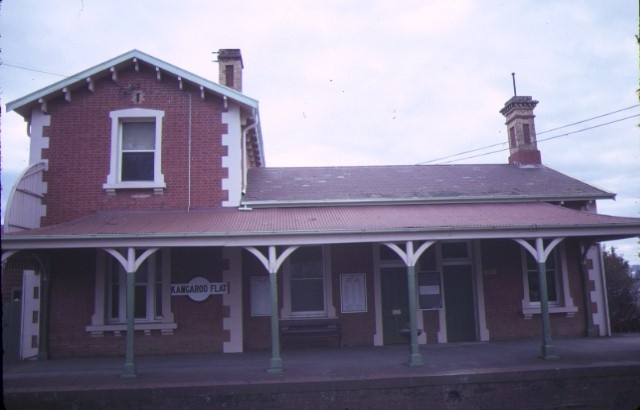
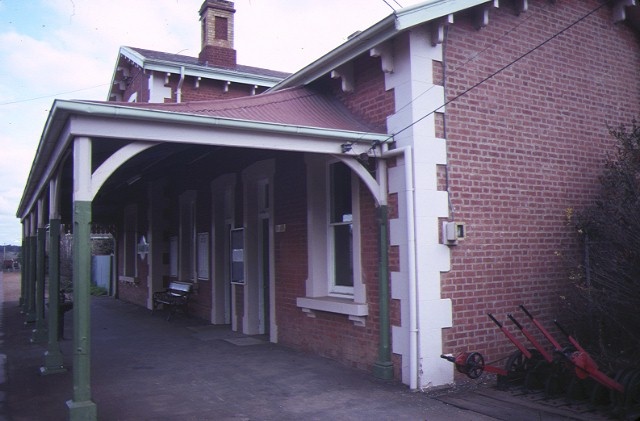
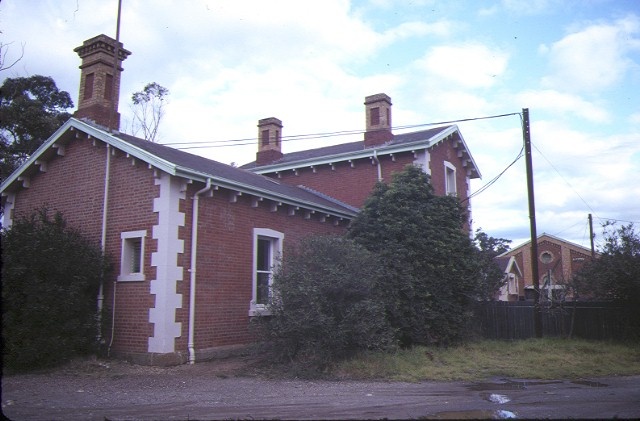
Kangaroo Flat Railway Station: Front, Platform and Rear views - Courtesy Heritage Council of Victoria - photos taken in July 1984
'In 1862, the contract for construction of Kangaroo Flat station was let. In 1904 it was renamed 'Kangaroo', resuming its original name in 1916. By 1926 facilities included a signal frame, a pair of side platforms on the double track, a goods siding and shed on the eastern side of the line, and a crossover between tracks. In 1938 the stationmaster was withdrawn, being worked by the Porter-in-charge under Caretaker conditions. ' Retrieved from: https://vhd.heritagecouncil.vic.gov.au/places/610
In 1872 the couple have another son, named 'Tristam Cholmley', his birth is recorded at Footscray.
PRICKETT. On the 10th December, at 34 Malvern road, Prahran, Frances Maria, the beloved wife of Edward Prickett, solicitor, of Melbourne. Victoria, formerly of Aylesbury, Buckinghamshire, England, and mother of Mrs. Tristram E. P. squire, North Melbourne Railway Station, in her eighty-third year. Family Notices (1877, December 15).Weekly Times (Melbourne, Vic. : 1869 - 1954), p. 16. Retrieved from http://nla.gov.au/nla.news-article220466039
Here again the station master is hard at work:
A COLLISION AVERTED.
Reports from several officers of the Railway department, in reference to the narrow escape of two trains from coming into collision on Tuesday last, were laid on the table of the Legislative Assembly on Oct. 24. The traffic manager reports as follows : —
It appears that in consequence of the alterations going on in the yard the mixed ten minutes past four train to Geelong, consisting of' about twenty vehicles, did not get away till twenty-six minutes past four, and that' the twenty-minutes past four train to Williamstown was also late. This latter train being light overtook the ten minutes past four at North Melbourne, passed the danger signal, and ran up at considerable speed to within forty yards of the Geelong train standing at the platform, causing some alarm to the passengers ; at this same time the five minutes past four p.m. up from Williamstown was also stranding there. I have not yet received any report as to why the driver of the twenty minutes past four train (who I believe saw the ten minutes past four start) should have disregarded the signal, and run at such a high speed so close to the other, train, but I am quite certain that had the twenty minutes past four train been fitted with the ordinary in the place of the continuous brake, there would have been a severe collision, accompanied I am certain with serious injuries, and probably loss of life to the passengers in all three trains I consider that the station master at Melbourne evinced very great lack of judgment in starting outwards a heavily-loaded mixed train only one minute in advance of a purely passenger train running on the same line.
The station-master, Mr. Tristram Squire, writes : —
I have to report the driver of the twenty minutes past four p.m. this evening for approaching this station at an incautious speed, the signals being against him, protecting the ten minutes past four down Ballarat standing here taking up passengers. Had it not been for the station brake, which enabled him to pull up about forty yards from the standing train, a collision would have occurred. The Ballarat train arrived here at twenty-nine minutes past four, and the Williamstown at half-past four p.m.
Mr. Mirls, the locomotive superintendent, states in his report : — The Williamstown train stopped before passing the ' home' semaphore, that being the point to which trains are to run when the ' distant' semaphore is against thorn, the distant semaphore again protecting the stopped tram outside the station. The driver states that he saw the Ballarat train standing at the station, also saw , the signals against him, and that he let off steam, applied the brakes, and stopped at the proper place. The train was under proper control. I beg to attach driver's report. The Ballarat mixed train should have left Spencer-street at ten minutes past four p.m., but did not leave « till twenty-five minutes past four, owing to shunting trucks. The Williamstown train was delayed until after the Ballarat train started properly so I think, because the Williamstown’s train stops at all stations, and the Ballarat does not. I know of no reason why all trains should not leave Spencer Street at the published times punctually.
The driver of the train, J. Summers, has addressed the following letter to the Locomotive department : — Sir,— Upon reading this morning's Age I found an erroneous report had been supplied to that journal, ranking it. appear that a collision was likely to take place at North Melbourne station between the 4.20 p.m. Williamstown and the 4.30 p.m. Geelong trains. I have to state that upon approaching that station I saw the signal' at danger, also the train standing there. I shot off steam as the train did not leave, I applied I ' the brake upon nearing the home signal, and stopped at the proper place. The train was under proper control, and I could have pulled up any where within fifty yards of the place I did stop …Thinking the Geelong train would move away, I deforced putting on the brake, not wishing to apply it a second time, but as the Ballarat train did not move I stopped my train at the home signal. A COLLISION AVERTED. (1878, October 26). Leader (Melbourne, Vic. : 1862 - 1918), p. 20. Retrieved from http://nla.gov.au/nla.news-article197286249
In april Alice loses her father:
PRICKETT.—On the 2nd inst., at Malvern-road, Prahran, Melbourne, Edward Prickett, solicitor, formerly of Aylesbury, Buckinghamshire, England, in his 86th year. Aylesbury papers please copy. Family Notices (1880, April 6). The Argus (Melbourne, Vic. : 1848 - 1957), p. 1. Retrieved from http://nla.gov.au/nla.news-article5981092
In January they lose their first born child who is followed later that year by their youngest son:
SQUIRE.—On the 12th inst., at the North Melbourne railway station, Edith Alice only daughter of Mr. Tristram E. P. Squire, aged 19 years. Family Notices (1881, January 13). The Argus (Melbourne, Vic. : 1848 - 1957), p. 1. from http://nla.gov.au/nla.news-article5978660
SQUIRE. — On the 31st August, at Molesworth street, Hotham, Tristram Cholmeley, youngest son of Mr. Tristram E. P. Squire, North Melbourne Railway Station, aged nine years and ten months. Family Notices (1881, September 3).Weekly Times (Melbourne, Vic. : 1869 - 1954), p. 19. Retrieved from http://nla.gov.au/nla.news-article220488225
16th January,— I beg to report that a black man was found dead on the line near the level Crossing gates this morning by Gatekeeper Smith. It would appear that deceased must have been knocked down by either the first up Williamstown train other Essendon train. Constable Brown and two of the ratepayers removed the body to the Melbourne Morgue. — Tristram Squire, Stationmaster. MELBOURNE. (1881, July 18). Mount Alexander Mail (Vic. : 1854 - 1917), p. 3. Retrieved from http://nla.gov.au/nla.news-article198693176
In 1893 T E P Squires' younger brother was killed:
SQUIRE.—On the 7th inst., through a buggy accident, Edward Squire, Deputy Postmaster General, Adelaide, South Australia and brother of Tristram E. P. Squire, Parkville, Victoria Family Notices (1893, October 11). The Argus (Melbourne, Vic. : 1848 - 1957), p. 1. Retrieved from http://nla.gov.au/nla.news-article8700108
Edward Lancaster Fawcett Squire (25 September 1837 – 7 October 1893) was killed when the trap he was driving down the Old Belair Road capsized after its brakes failed and the horses bolted, and its occupants thrown on the road. His son Tristram and daughters Emily and Fanny and a female relative escaped serious injury, and their maid servant, Miss Chew, sustained a broken arm. A popular gentleman, the South Australian papers ran a series of reports on the accident:
A TERRIBLE ACCIDENT.
THE DEPUTY POSTMASTER GENERAL KILLED. TWO LADIES SERIOUSLY HURT. MR. SQUIRE'S SON BADLY INJURED.
All news flies apace, and although it was after 4 o'clock on Saturday afternoon when by a terrible accident on one of the sharpest descents of the Belair-road Mr. Edward Squire, Deputy Postmaster - General and Superintendent of Telegraphs, lost his life the sad intelligence was generally known throughout Adelaide early in the evening.
As is usual in such cases, many versions were given to the story as it passed from mouth to mouth, but the substantial fact remained to cause universal and profound regret. The melancholy task of breaking the fearful news to Mrs. Squire fell to the lot of Mr. Adkisson J. Wright, chief clerk in the letter branch of the General Post-Office, who for more than a quarter of a century has been associated with Mr. Squire in the department, and who is an intimate friend of the family. To Sir Charles Todd, who was prostrated by the suddenness and sorrow of the news, the story was first told by Superintendent Peterswald. Sir Charles joined the Government service in Adelaide on February 10, 1855, and Mr. Squire entered the post-office less than five years afterwards, while an exactly similar period elapsed between the appointment of the former to the Postmaster-Generalship and the promotion of Mr. Squire to the position of deputy. A very close and cordial relationship, which was far more than that merely of principal and subordinate, subsisted between the two gentlemen, and the tragic death of Mr. Squire was felt as keenly as that of a brother would have been. En-quiries and messages of condolence kept the telephone at the Observatory almost ceaselessly ringing on Saturday night and during Sunday, for it was recognised that thence the most re-liable information was sure to be obtained, while it was felt that expressions of sympathy would there be highly appreciated. Every-where the information concerning Mr. Squire's untimely end and the method in which it was brought about elicited symptoms of the most profound and genuine grief. For very many years he has held one of the most prominent as well as one of the most onerous positions in the South Australian Civil Service, and the nature of his business brought him into contact with all sorts and conditions of men, both in the metropolis and throughout the provinces. It was indeed a fortunate circumstance for the colony that it had at the head of its most generally utilised department two officials of such first-rate ability as that possessed by Sir Charles Todd and Mr. Squire. When the former some years ago went away on a well-earned and lengthy holiday the administration of the Post and Telegraph Office was carried on in a thoroughly efficient manner, and there were no arrears to work off when the chief returned. With the numerous employes of the postal and telegraphic service at headquarters and in all parts of the colony, with business men, and with the general public, Mr. Squire was equally a favorite. Courteous always, well acquainted with every detail of the management of the vast establishment more directly under his charge, and invariably willing to oblige, it was seldom that he was appealed to on any subject without satisfaction being obtained by the applicant. He felt a deep personal interest in the work of the office and in those engaged in doing it, and it is a singular and sad coincidence that on the very morning of his death he fol-lowed to their last resting-place in the Roman Catholic portion of the West-terrace Cemetery the remains of the late Mr. M. J. O'Brien, once postmaster at Strathalbyn. The Belair-road, on which by the failure of a brake—an imperatively necessary appendage on such a sharp and sinuous gradient—the fatality occurred, has been the scene of many accidents, but never before, not excepting the catastrophe which befel a picnic party from Messrs. James Marshall & Co.'s establishment several years ago, has such a sensation been caused by any previous fatality. Full particulars, as gleaned from an occupant of the disabled vehicle and from the only eye-witness, are given below.
From these accounts it is evident that Mr. Squire clearly saw the danger, that he retained his coolness and presence of mind, and that he did all in his power to avert the accident which on such a road and under such circumstances, was almost inevitable. Mr. Squire was still in the prime of life, and in the ordinary course of nature might reasonably have looked forward to many years of active and useful service; but "Man proposes and God disposes," and special regret is added to the sorrow incident to the loss now sustained by the reflection than "the due season has been disturbed." "One of the best masters we ever had," said an old employe of the post-office, with tears in his eyes, as he referred to the death of Mr. Squire, under | whom he had served ever since his transference from Gawler to the dignity of Deputy Postmaster-General. Nor was this spontaneous tribute at all singular. Mr. R. W. Foster, M.P., telegraphing from Quorn on Saturday night, says :—"The most profound regret was expressed here on the receipt of the sad intelligence of the death of Mr. Squire. He was looked upon in the north as one of the ablest and most conscientious, as he was one of the most respected, officers in the Government service, and the gloom cast over the local officers of the Post-Office and Telegraph Department speaks eloquently of the affection entertained by the employes for their lifelong superior officer and friend." From other parts of the colony similar messages have come for Mr. Squire's duties took him throughout the length and breadth of South Australia, and his kindly, generous, and just character made him welcome everywhere, and in all places won for him respect and admiration.
DESCRIPTION OF THE ACCIDENT. The scene of the dreadful accident is one of the most treacherous pieces of the old Belairroad, which dips sharply down along the side of the rise overlooking the Brownhill Creek. There is no more picturesque drive near Adelaide than this one, but the rapid drive along the declivity behind spanking horses is always attended with some danger on account of the steepness of the grade and the tortuous course. From the top of the hill right down to Mitcham the brakes have to be kept hard on and the horses must be well in hand. In this instance there appears to be little doubt that the brake power was totally inadequate and that primarily this fact was the cause of the fatality. Early in the afternoon Mr. Squire, accompanied by Mrs. Warren, a sister-in-law, who had come from Robe on a visit, his son (Mr. T. Squire), Miss Chew, and two young daughters left the city for Belair in one of the vehicles of the department to gather wild flowers and to spend the afternoon in the hills. After enjoying an hour
or so in the neighborhood of the rural township a start was made for home, and all went well until the descent was begun. It was soon observed that the pace was becoming perilously fast, and Mr. Squire, jun., remarked to his father—"l don't think the skid is acting." Mr. Squire evidently realised the danger of the situation, but not wishing to frighten the others he simply replied—"No, I think not; but I'm in a hurry to get home." Knowing he was an expert driver the occupants of the vehicle were not so dismayed as might otherwise have been the case, but still they naturally became more and more fearful of the results as the journey proceeded. By the time a few hundred yards of the road had been covered the horses were going at a swinging gallop, the weight of the load behind absolutely propelling them forward, despite resistance offered by hanging back on the polestraps. About half a mile of the winding road was traversed safely, but on "the pinch" a catastrophe came. At the particular point the serpentine way and the stiff descent combine to make the locality extremely dangerous under some conditions. It is impossible to say accurately how the accident was caused, whether the vehicle struck a projecting rock or whether it locked and jerked the occupants out. It was at a slight curve where they were precipitated from the trap. Mr. Squire, Mrs. Warren, and one of the children occupied the front seat, and Mr. T. Squire, Miss Chew, and the other child were at the back. A member of our staff drove to the locality on Sunday after- noon, and after examining the spot came to the conclusion that the wheel struck the rock, which bears a conspicuous mark where a piece has been knocked off. However the fatality happened it is certain that the whole of the party were thrown from the trap, with the seats, on to the rocky side of the road. The vehicle did not capsize until it collided with a spring-dray, in which Mr. J. Shields, a market gardener, of Upper Sturt, was driving, about 60 yards further down the hill. The upper edge of the road is shut in by a great wall of boulders, which bear evidence of having been subjected to the force of blasting powder when the siding was being constructed. It was against this wall that the members of the party were hurled. Mr. Squire struck the rocks with his head, which received a compound fracture. On the base of the skull there was a hole nearly deep enough for the doctor who subsequently examined the body to bury his two fingers in. Mrs. Warren was seriously injured about the head and body, Miss Chew had one of her arms broken, Mr. T. Squire received some internal injury which caused slight hemorrhage, and the children were more or less bruised. Immediately after the event Mr. T. Squire, who was the best able to be of use, set about the painful task of attending to his companions, and he at once perceived that the accident would prove fatal in the case of his father, who was then unconscious, and who died in less than five minutes.
STORY OF AN EYE-WITNESS.
There was only one eyewitness of the terrible fatality other than the participants in the occurrence. This was Mr. Shields, with whom our reporter had an interview on Sunday after-noon at the scene of the mishap. "I was going home," he said, "in my spring-dray, and the first I saw of Mr. Squire's vehicle was when it turned the corner about 100 yards farther up the hill. Between us the road was very steep and the turns awkward. The horses were coming along at full gallop and as quickly as possible I drew on to the side to give them room to pass. I imagined it was a bolt, and it took me all my time to pull off. Before the trap reached me, however, the accident happened. I don't know whether the wheels locked or whether the nave of one of them struck the rock, but just at the turn, about 20 yards from me, everybody was jerked out. My idea is that the wheels locked. Strange to say the trap was not overturned there, although the seats went out with the occupants. The horses continued to tear down the hill and the vehicle collided with a nave of my wheel. Even then it did not capsize at once. It went on about 30 yards with a lurch and struck the fence two or three times before overturning on the side of the road. There was a young man named Brady coming up the hill behind me, and of course having rushed up and seen the condition of Mr. Squire and the others I sent him back to Mitcham for a doctor, but I think he obtained the services of a cyclist, who rushed down the hill with the news. In the course of a short time some other people driving along the road came to my assistance, and Mr. Fenn, I believe it was, took two of the sufferers down to Mitcham to be attended to by a doctor, and also to give information to Lance-Corporal Bertram, the officer in charge of the Mitcham police-station. I guarded the body of Mr. Squire and attended as well as I could to the others until Mr. Bertram arrived, and he then took charge. In the meantime news had been sent to Adelaide for the ambulance van, which arrived later on —about 6 o'clock, I should think. It was just about 4 o'clock when the accident happened. Mr. Squire was killed at once. He came in contact with the stones with his head first, and turned right over. He never moved or groaned, and was dead in a minute or two. I don't know whether the brake would not act or what it was, but it seemed to me to be a bolt, for they were going along at a regular gallop." That is the story Mr. Shields related to our reporter.
WHAT MR. T. SQUIRE SAYS.
The great grief into which the members of Mr. Squire's family have been plunged has naturally upset them, and those who were in the vehicle are unable to form any positive opinion as to how the accident occurred. "The skid was not acting," says Mr. T. Squire, "and I called my father's attention to it, and asked if it had given way, but I don't think he wanted us to get frightened, so he merely replied, 'No, I don't think so, but I'm in a hurry to get home.' We were going along at a swing gallop down the steep and winding road, and the horses were quite unable to hold the trap back. It was when we were turning a slight curve that we were thrown out. Father's head must have struck the rock. He was quite unconscious when I got up, and I placed my hand on his chest to see if the heart was beating. It was beating, but in the course of about three minutes it stopped, so that death was almost instantaneous. My aunt has a nasty gash on her fore-head, and besides being bruised in different parts she received a great shock to the system. Miss Chew broke her arm, but the children escaped with little more than a shaking. I cannot give you any names of the people who came to our help later on, for in the excitement I forgot to ask for them, but they were all exceedingly kind, and I would like to thank them through The Advertiser. Miss Chew and I were driven down to Dr. Gault, at Mitcham, at once, and he set her arm before driving back to attend to Mrs. Warren and to my father. Mrs. Warren appeared to be in a serious condition, and the doctor ordered her removal to the hospital without delay. In obedience to his orders she was conveyed to Norwood, and placed in Miss Noble's hospital, where she now lies. The ambulance van was sent up to the spot, and my father's body was brought to our home in Hackney. The horses were not startled at anything. The skid would not grip the wheel, and they were really forced along by the loaded vehicle. Unbounded kindness has been shown to all of us since the accident, kindness that we shall never forget."
REPORT BY THE POLICE.
Lance-Corporal Bertram of Mitcham lost no time in ordering the ambulance van and proceeding to the spot when apprised of the accident, and he did everything to comfort the sufferers and to facilitate their removal to the city. On Saturday night he formally informed the city coroner of the accident in a report as follows:—"I very much regret having to report that a very sad accident occurred this afternoon about 4.15 p.m. on the Belair-road, about half a mile from the Belair railway-station, and Mr. Edward Squire, Deputy-Postmaster-General, lost his life by being thrown out of a trap. At about 5.15 p.m. a messenger reported at this station that an accident had taken place on the Belair-road. I left at once for the scene of the accident, and on arrival ascertained that Mr. Squire, Mrs. Warren, a relative and visitor, one of his sons, two young daughters, and servant girl had been thrown out while driving in the hills with a pair of horses and waggonette. They were returning home, and when coming down the hill it appears the brake would not hold and the horses became uncontrollable, and in attempting to pull them up Mr. Squires pulled them to the near side, which consists of a high rocky bank, against which the trap struck, the occupants being thrown out, while the vehicle was turned upside down and broken. I found the body of Mr. Squires lying beside the bank, with a large wound on the crown of his head, and the skull being fractured death must have been instantaneous. The other occupants of the vehicle escaped with several cuts and bruises, except the servant, who had also her left arm broken. In compliance with your instructions I sent for the ambulance van, and conveyed the corpse to the deceased gentleman's residence at Hackney, where it now lies. I have been unable to obtain the statements of witnesses this evening on account of the severe shock they received from the accident, but from what I have gathered it was a pure accident." The vehicle was considerably damaged and the horses were slightly marked. On Sunday a number of friends of the deceased gentleman visited the scene of his death, and upon the rough rocks scratched words to denote the exact spot where Edward Squire, one of the best known and most highly respected officers in the Government service, met his death. In chalk some one had marked the place by writing "Squire killed, October 7, 1893," but this will probably be obliterated by the first rains. Not so with the two words "Poor Squire," over the date, which had been cut in the stone with a knife or other hard instrument.
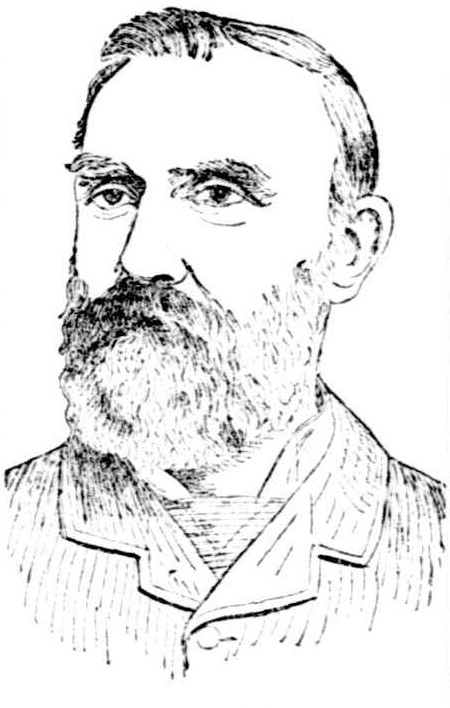
Mr. Edward Squire.
On the rock in two places near the ground there are patches of congealed blood, and in the gutter where Mr. Squire breathed his last there is a pool of blood, showing clearly that the bleeding must have been profuse. When Dr. Whittell was communicated with he gave instructions preparatory to holding an inquest, which will be started at the Kent Town Hotel at 10.15 this morning. Mr. Shields will attend, but the enquiry will probably be adjourned pending the recovery of Mrs. Warren. The funeral will leave Mr. Squire's late residence at 3 this afternoon, and it is certain to be very largely attended. The arrangements are in the hands of Messrs. Pengelley & Knabe. For many years Mr. Squire has attended St. Bartholomew's Church, Norwood, and on Sunday the Rev. Canon Andrews, in the course of his sermon, commented on the sad event, of which he heard only a little while before entering the church in the morning. He spoke in feeling terms of the value of the life so abruptly ended and commended the widow to the loving sympathy of all.
MR. SQUIRE'S CAREER. To the courtesy of Sir Charles Todd we are indebted for some particulars of Mr. Squire long and useful career in the public service. The deceased gentleman, who was then about 21 years of age, entered the telegraph department in October, 1859, at the time when his elder brother was in charge of the telegraph office at Goolwa. About 1860 Mr. Squire was appointed stationmaster at Robe, at that time a much busier station than now, and of importance owing to the fact that it was situated on the only telegraph line to Melbourne. In 1866, on the completion of the telegraph line to Sydney, he was appointed to the charge of the South Australian side of the office at Wentworth, a very responsible position, as all the messages between South Australia and New South Wales were repeated there, and the telegraph accounts were kept between the two colonies. From Wentworth he was transferred to Gawler on the amalgamation of the post and telegraph offices at that place. On February 1, 1875, Mr. Squire, in consequence of the report of the Commission appointed to enquire into the post-office robbery of the previous year, was transferred to the General Post-Office as suc-cessor to Mr. H. L. Hurst, the former chief corresponding clerk. Mr. Hurst was trans-ferred to the letter branch of the department as chief letter clerk, the position now occupied by Mr. Wright. On the death of Mr. Cunning-ham, Assistant Superintendent of Telegraphs, Mr. Squire was appointed Deputy Postmaster-General and Assistant Superintendent of Tele-graphs on August 25, 1875. He was then relieved of the corresponding branch, Mr. Waddy, the present secretary, taking that post. Mr. Squire held his new position, the second in importance in the postal and telegraphic departments, until his death. "By his death," said Sir Charles, who is naturally much affected at the decease of one who was not only an old colleague in work but a cherished friend, "the Government have lost a most valuable officer, and the officers of the department and I have lost a very valued friend. He was a man in whom one could place the most implicit confidence, and he was of the most kindly disposition. He did not mind how hard he worked for the department, and he was exceedingly jealous of its reputa-tion."
Mr. Squire married a daughter of the late Captain Brewer, who was for many years Government Resident at Guichen Bay at a time when that part of the colony was practically far distant from and but slightly con-nected with the central Government. He leaves four sons, three of whom are in the telegraphic and postal departments. One is an operator at Alice Springs and another son is in the railway service. He also leaves four daughters, and has lost two sons by death. Very pleasant recollections of Mr. Squire, whose place it will be extremely difficult to fill, are retained by all those engaged in the head office, and the expression made use of by one of his subordinates: —"There is hardly one of us who is not indebted to him for some personal favor " seems to voice the feeling of all.
SYMPATHY FROM THE COUNTRY. Mount Barker, October 8. General regret is felt here at the death of Mr. Squire, Deputy-Postmaster-General, and much sympathy is expressed for the family. Port Augusta, October 8. Much regret is expressed here at the news of the untimely death of Mr. Squire, Deputy-Postmaster-General. A TERRIBLE ACCIDENT. (1893, October 9). The Advertiser (Adelaide, SA : 1889 - 1931), p. 6. Retrieved from http://nla.gov.au/nla.news-article25666425

Edward Squire. Photo – courtesy State Library of South Australia - Photograph dated 1890. Available at Pictorial Collection (B 4755)
THE LATE MR. E. SQUIRE.
A REPRESENTATIVE FUNERAL.
The respect in which the late Mr. Edward Squire (Deputy Postmaster-General) was held was amply testified on Monday by the large number who attended the burial, which took
place at the West-terrace Cemetery during the afternoon. In the morning Dr. Whittell held an inquest on the body, at which a verdict of accidental death was returned. As a mark of respect to the memory of the late Mr. Squire the Union Jack was flying at half-mast on the tower of the General Post-Office on Monday afternoon, and shutters were up at several business establishments. The Minister of Education, who is Ministerial head of the Postal Department, on Monday forwarded a letter of condolence to Mrs. Squire expressing his deep regret at her husband's untimely end. Mr. Squire joined the service in 1859, and was entitled to a retiring allowance on the basis of the average salary which he had been drawing for three years before 1881, when the Act abolishing retiring allowances came into force. The amount thus due to him was about £1,000, and this has borne interest since that date at 4 per cent. per annum, so that the total amount to be received by the rela-tives will approximate to £1,500. Mr. Squire was also a member of the Public Provident Fund, and this is the second claim upon that fund. It is somewhat strange that Mr. Squire on Saturday morn-ing attended the funeral of Mr. O Brien, by whose death the first claim was made upon the fund, and the levy upon the members for both claims will be made at the end of this month. Mrs. Warren, who was injured at the same time that Mr. Squire was killed, and who is in Miss Noble's private hospital at Norwood, was a little better on Monday, but some days will e!apse before she is in a fit condition to leave the institution. Our Wallaroo correspondent wired on Mon day night:—"Desp regret is expressed here by the triends of the late Mr. E- Squire at his death under such painful circumstances. He was held in the highest esteem by thetele grsphio and postal officials here." Our Scrathalbyn correspondent also telegraphed: —'"Very great regret was expreated here to-day at the news of Mr. E. Squires death, and the utmost sympathy is fold tor the bereaved family." THE INQUEST. On Monday morning the city coroner (Dr. Whittell) began the official enquiry into the circumstances connected with the death of Mr. Squire. The jury tout at the house of the deceased gentleman in Hackney, and haviog beerj sworn in there they proceeded to the Iv«nt Town Hotel, where evidence was taken. Tristan Squire, clerk in the General Post office, identified tha body as that ot his father, the Deputy Postmaster-Genera], who with Mis. Warren, Miss Chew, witness, and two children started in a trap belonging to the Telegraph Department from Palm-place, Hackney, at 2 p.m. on Saturday last, and drove to Belair. They reached Belair about half-past 3 o'clock, and after remaining half an hour on the main road turned the horses' heads once more towards the city. They had scarcely covered more than a quarter of a mile from the summit of the hill when witness remarked to the deceased that the brake did Dot seem to operate efficiently. Witness's words were. "I don't think the brake is acting." The horses at this time broke into a gallop, and he asked deceased, "Can you pull up 1" Deceased replied, "I want to get home early." Witness did not remember any more till he found himself lying upon the side of the road a few seconds later, and on looking round he saw deceased and the remainder of the party lying close against the bulk. As coon as he was able to move picked op Miss Chaw, the servant, who had a broken arm. He then picked up the children, aud subsequently went to bis father, whose heart was beating, but be did not speak. There was a wound on the top of deceased's head and his mouth was full of blood. Deceased expired about three minutes later.
At the time of the accident Mrs. Warren, the deceased, and one of the children, were sitting on the front seat. Knew the horses well, and had often ridden behind them. One of the animals was very excitable, and had proved troublesome upon two or three former occasions. No difficulty was, however, experienced on Saturday on the way up to Belair. Had accompanied deceased down the hill in the same trap upon a prior occasion. Deceased was a splendid driver, having had a large experience. So far as witness knew the brake of the vehicle was in thorough repair. The descent from the hill was commenced very slowly, but the ipeed gradually increased. Deceased applied the brake when the descent began. The horses did not become unmanageable, but the weight of the trap seemed to urge them forward.
James Shields, market gardener, of Upper Start, said he was driving from Adelaide on Saturday afternoon along the old road to Belair, and when he got to a point a little above what was known as "the elbow," about a mile from Mitcham, be saw the trap earning down at a. galloping pace. At a slight curve the wheels appeared to become locked and all the occupants of the trap were thrown out. The horses continued their career down the hill, and the trap struck the nave of the spring-dray be was driving. This collision caused the trap to overturn, but the horses dragged it tome distance down the hill. It was before this collision that Mr. Squire and the others were throtra out. He immediately made bis turn-out secure, and ran to see whether the people were injured. Mr. Squire never moved, and appeared to have buen killed on the spot. Michael Jow-ph O'Donnell, stablekeeper in charge of the West-terrace yard in connection with the Telegraph Department, deposed that on Saturday morning he had driven the deceased to the funeral of Mr. O'Brien. the late postmaster at Strathulbyn. The same horses were used on that occasion as were used by deceased on Saturday afternoon. About C p.m. re ceived a telephonic communication to the eSect that Mr. Squire was dead. Immediately visited the scene of the accident on the Belair road, where he Raw the trap. Owing to the darkness, however, he could not see the extent of the damage.
On the following morning again inspected the trap and found that it was terribly knocked about. The seats were merely strapped to the body of the vehicle. The trap belonged to the Government, but deceased was allowed to use it for private purposes. The brake attached to the conveyance was in perfect order on Saturday morning. Considered the hones safe, although one of them was a trine nervous. The trap was only intended to accommodate four people, although with a little inconvenience six could be seated in iv. Did not think the vehicle was so over orowded by the party as to cause deceased to lose control over the animals. Lance-Corporal Bertram, of Mitcham, said that a cyclial informed bun of the accident and he proceeded to the spot an once. Found Mr. Squire on the side of the road, and that his skull was badly fractured, the bune being driven in. Mr. Squire was dead, and as soon as the ambulance-van, which had been sent for, arrived the body was removed to Hackney to the residence of the deceased. The jury retired and after a brief delibera tion returned with a verdict of accidental death, adding that no blame was attachable to anyone.
THE FUNERAL.
The funeral of the late Mr. Squire took place en Monday afternoon. The cortege left his late residence, Palm-place, Hackney, shortly after 3 o'clock. Over 80 carriages were in the procession, and on passing the General Poet-Office a large accession to its ranks was made in the shape of a number of officials connected with the department, who were desirous of paying their last tribute of respect to the deceased. They all walked on foot in front of the hearse, and they were preceded by a number of mail-carts. The steps of the Post-Office and the pavement in front of the building were crowded with Epectatorsas the funeral went by, and the union jack was at half-mast above the Post-Office tower. The interment took place in the West-terrace Cemetery, where a number of friends of the deceased were assembled to take part in the proceedings around the grave. The carriages of his Excellency the Governor and of his Honor the Chief Justice were in the procession. The Ministry were repre sented by the Premier (the Hon. C. C. King ston), the Minister of Education (the Hon. Dr. Cockburn), the Chief Secretary (the Hon. J. H. Gordon), and the Commissioner of Crown Lands (the Hon. P. P. GiUen). The funeral service was performed at the house and at the grave by the Rev. Canon Andrews. Three beautiful wreaths from various branches of the postal and telegraphic services were placed on the coffin, while many others were also presented by friends of the de-jeased. The following gentlemen acted as pall bearers :—Messrs. E. Lawrence, A. J. Wright, C Fry, J. J. Watson, & S. Summers, and R. Waddy. The chief mourners were—Messrs. T. Squire and F. Squire (sons), R. Hoile, G. Gottscbalck, G. HaU, R. Harris, J. Thomas, and A. Woodroffe.
The following officials in the postal aid tola, graphic services formed part of the cortege:— The Postmaster-General and Superintendent) of Telegraph (Sir Chas. Todd, K.M.G.). Secretary's branch—Messrs. R. W. M. Waddy(Secretary G.P.0.). EL L Hurst, T. E. Cooke, S& Smith, H. J. Summers, and G. I* Dix. Accountant's branch—Messrs. E. P. Pilgrim, J. D. Whittam, J. E. Gill, C. E. Miller, W. P. Evans. R. Cavanagh, J. McMillan, W. E. Colman, J. A. S. Kayeer. H. Bellhouse, H. J. Evans, E. Waddy, and A. Piittmann. Depnty Postmaster-General's offioe—M"wrn. A. W. Winter aud G. W. Rogers. Money order branch—Mw?=re. S. Bnmmen (superintendent of the branch), EL & Olifent, F. A. Przygoda, M. 6. Healy. D. Williams, F. W. Huoook. EL W. Chariick, W. Steed, O. M. Billin, and E. W. Simpson. Stamp issuer's branch—Messrs. A. M. Worsnop (issuer of stamps) and A. O. Sum mere. Stamp printin? offioe—Messrs. J. B. Cooks (stamp printer), T. J. Ames, O. Kwm-i^.^ and C. Harrison. Cashier's offioe—TW<«am?. H. Lawrence (cashier G.P.0.) and C. J. McDonald. Storekeeper's branch — Messrs. J. M. Finnm (storekeeper G.P.0.), W. H. H. Par sons, W. Witherick, EL Witheriok, M. Francis, R. Chappie, and J. Harris. Carpenters—Messrs. W. Baker (caroenter), C. Hodder, and J. Chaetan. Drawing office—Messrs. J. B. Richards (chief overseer of lines), F. EL Chance, and E, K. Baker. Mechanical branch—Mammi jr. Fomaonon, L. H. Griffiths, A. T. Du?ieu, F. Thomas, P. Wohelm, E. A. Johnstone, F. E, Jaokman, F. V. Woodman, W. E. Chambers, C. E. Gray ™, G. Bachmann, EL Bywatnr, C. De La PerreUe, E. F. Blatohfoxd, and EL N. Lawton. Telegraph receiving and issuing office— Messrs. Charles Fry (oaehier Telegraph Depart ment), Thomas Irwia, C. WrCavflL W. F. Richardson, C. C. Paltridge, C. J. Chambers, A. T. Altenkirch. Messengers—Messrs. EL Dennis, M. f£. Wilson, E. Harvey, A. EC Hill, A. G. Chaplin, H. Jolly, I*. Renfrey. A. S. Morgititch, F. A. Hider, A. C. Sinoock, W. C. Beaumont, and A. A. Kirkpatriuk. Check office—Memrs. W. D. H. Claxton, J. ODea, J. Phillips, F. Adams, W. Ooz, and EL H. lsiog. Letter branch—Messrs. A. J. Wright (Chief Clerk), EL Gillman, J. Conigrave, EL EL Dollman, J. Olifeut, J. F. Grntzmaouer, F. G. Dallman, Goo. Brown, J. J. Elwood, Geo. Hudson, F. R. White, N. Opie, T. G. Pitman, T. F- A. Tarbill, C. T. Wnght, F. Leak, J. L. Motony, J. L. Strout. G. Gottaohalek, F. J. Gaioper, R. Ekyn Smyth, J. T. Pearson, H. Potter, W. Haley, R. A. Bohme, F. J. Adams, P. Donnelly, Wm. Chapman, J. H. Lee. E. Black, W. Mitchell, & G. Kidman, F. J. Habble, D. Mahoney. & SuokUng, E. Niehus. W. EL Sntcon, A. J. Arrowsmith, C. C. Duncan, J. EL Black, W. H. Waflis, H. Moroom. M. Walsh, N. J. Neate, J. EL Maloney, J. O'Halloran, R. Y. Taylor, •?. Clarke, John Condon, Wm. Condon, £,' J. Conlon, M. Collins, T. Cornelias, A. E. Chester-man, W. EL Hodge, E. W. Gray, E. Horrooks, A. W. AUmond, T. O. Bacon, C. EL F. Mueller, C. Graham, A. Jackson, W. J. Jackson, J. Kemp, and G. Tom. Operating-room—Messrs. J. J. Watson operator in charge), E, Broad, E. Johns, W. C. Crawley, F. Poyzer, H. C. Obittleboroueh, ' E. A. Webb, T. Baker, T. A. Bradshaw, W. B. Griffiths, A. W. Badger, F. W. Chaplin, W. A. Catheart, H. Shroeder, 8. BenneML It Temple, EL S. RumbalL W. Af?T^4.| m p. N. Watt, G. EL Field, W. EL Gratariok. W. Moffat, EL W. HodgeWa. A. K. West A. Hiscock, P. Ryan, P. MnKwhni?. 3. F. O. Anricht, W. J. Harris. D. H. Rollison, D. N. Peek, T. Peaoook, A. Comelins, EL J. Rotter, A. A. Campbell. W. Milne. C. XL G. Sim tnoos, D. M. Yorke. J. O'HaUoran, EL A. PufFtim, EL W. Woodard?, EL CarmiohaeLF. Gregor, EL Yeatman, A. Croft. A. E. Edwards, D. Ryan, EL J. Graham, W. EC L'Estage, T. J. Shanaban, E. Klotz, J. 3. Supple, V. It Jagoe, W. EL Fergnsson, 8. Jtowd, J. Ryan, M. Cornish, F. Collins, P. DeS. SUpleton, E. A. AUchuroh, W. J. Denny, H. R. Rogers, E. Sinoock, J. Fiak, E. F. Bnttfield, and EL Bishop. Observatory branch—Messrs. W. E. Cooks R. F. Griffiths, and W. B. Wilaon. Stable men—Messrs. M. J. O'Donnell Mid F. A. W. Wood. Post and telegraph stations—AAfloMf railway-station, Messrs. F. S. Smith (station master), C. E. Kerr, E. Mogge, and R. Hawke; Glenelg, Mr. G. Bell (stationma?ter) ; Hindmarsh, Mr. A. Howley (p*?t?f«"nipjj??r) ; Jamestown. Mr. T. H. Henderson (station master); Kooringa, Mr. J. lone (station master) ; Port Adelaide, Messrs. J. Bastard stationmaster), C. Edwards, X J. F. Bench, L R. Holder^E. Burke, C. R. Dudley, J. IT. RondelL EL Hounslow, EL Bncldnfrnam, and W. F. Dowsett; Port Wakeneld, Mr. T. W. Hillman ; Balaklava, Mr. A. B. C. Dodge j Moonta,Mr. J.Clark; Kaprnida. Mr. B.Clarkej Gawler, Mr. J. W. B. Croft; Wallaroo, Me. H. Higrans; Kadina, Mr. D. J. Sands ; Anbtun, Mr. T. E. Idpaon; Milang, Me. B. Obtowayj Clare, Mr. F. Bleechmore; Laitts Bay, Mr. J. ' W. Goes; Morgan, Mr. J. Rowe; Nodb Adelaide, Mr. C. G. Sobedlick; Mount Barker, lie W. Rossi; and Alberton, Mr. W. W. Leslie; and also the following in the service: Messrs. W. G. Turner, S. J. Pearoe, "M. Oal> man, C. Slater, EL Knuokey W.T. Porker, W. Bean, J. Mnrph, T. Hawker, ;E. Sanders, O. Gant, J. Cronin, J. Bradbury, and J. Atten borougn. Among the others who were present on the occasion were the Hons. J. Darling, M.li.C^ and W. A. Robinson. M.L.C., Messrs. J. G. Jenkins, M.P., V. £. Solomon. M.P., W. Griffiths, M.P., J. Monle, M.P., Lieutenant-Colonel Gordon (military commandant), the Commissioner of Police (Mr. W. J. Petersvald), Inspector Sullivan, Sub-Inspector Shaw, the Rev. F. W. Cox, Messrs. J. Gordon, P.M.. L. EL Sholl (Undersecretary), C. E. Bristow (Government Printer), G. EL Ayliffe (Registrar-General of Birnis and Deaths), G. .S. Wright (secretary to the Commissioner of Crown £and?)t James Bath (Reeretary to Minister of Educa tion), J. A. Hartley, 8.A.. B.Sc (Inspeotor-Generalof Sohools), L. W. Stanton (assistant Inspector-General), J. W. Jones (Conservator of Water), J. Mann (secretary to iba Commis sioner of Public Works), T. N. Stephens (Under Treasurer), C. E. Owen Smyth. Superintendent of Publto Buudings), T. GuL A. Searqy (secretary to the Marine Board), W. Strawbridge (depnty Surveyor-General), G. W. R. Lee (chief clerk Edncation Depart ment), A. Pendleton (Railway General Traffio Manager), A. *Vaughan (phobographer Sur veyor-General's Department), G. M. Smith (chief clerk Land Office), J. Gardiner (accoun tant Publio Works Department), W. Gul (Conservator of Forests). F. Servants, W. B. Carter (Registrar-General of Deeds), E. J. Heath (deputy Registrar-General of Deeds), E. W. Giles, A. Stow (Registrar of Probates), H. B. Middleton (chief clerk Superintendent of Public Buildings), G. L. Reed (chief dark Commissioner of Police), T. HaD, F. R. C Frost (chief clerk Surveyor-General's Department), F. E. Benda (chief clerk to the Minister for the Nordiem Territory), W. G. BandalL F. Fabweather, H. S. Winton. C H. Hams, Alderman Fuller, Councillor Myers, Messrs. J. Langdon Bonython. J. EL Reed, R. W. Bernard (agent Eastern Extension Telegraph Co.), WT & Douglas, J. B. Austin, C. J. Holder, E. Saint, X P. Scott, C. Bastard, W. J. Evans, C. Bagot^, W. E. Cheesemao, C. A. Murphy (Consular Agent for the United States), J. Witheriok, R. C. Castle, Joseph HDL S. J. Mitchell, J. Rounsevell. H. M. Hardy, E. C. Gwynne, C. R. Todd, W. H. Selway, W. T. McLean, H. Fraser. J. Deeney, H. L. Todd, G. DeMole, J. DeCean. J. Pickering, jun., W. £. Cave, and J. B. Scott. The Savings Bank was re presented by Messrs. F. A. Ebsworth (ao oountant), W. B. Poole (assistant accountant), H. M. Mudie, and J. Sadler. . . . Apologies for absence were received from Mesas. E. G. Blaekmore (clerk of Parlia ments), Thos.: Worsnop (town clerk), F. J. Sanderson (Collector of Customs), E. P. Clarke Chief Inspector of Distilleries), Chris. Giles accountant G.P.0.), who was detained by severe family affliction, and C. Unbehaun (implement fitter), and the following connected with the Post and Telegraph Department:— Messrs J. Oatey, J. McDonnell, A. i. Shed lich. H. McKechnie, J. G. Daly, V. Gurr, C. G. Shedlich, jun., John Molony, George De Cean, A. L Hamilton, J. MacKenne, S. Ramsay, H. Eland, G. Edwards, George Margitioh, J. C. Harris. H. A. Hussey. A. Hamivn, C. Giles, and W. L. Ekers. Passages expressing sympathy and regret at being unable to attend were received from stationmasters and postmasters through out the colony. His Excellency the Governor wrote a letter of sympathy to Sir Charles .Todd. The funeral arrangements were in the hands of Messrs. Pengeuey and Knabe, and were most efficiently carried out. The coffin was of polished cedar with massive silver mountings. THE LATE MR. E. SQUIRE. (1893, October 10). The Advertiser (Adelaide, SA : 1889 - 1931), p. 5. Retrieved from http://nla.gov.au/nla.news-article25666523
A Student of Art
In 1883 Harold Tristram Squire commenced what would be six years of study at the National Gallery School in Melbourne, which commenced in 1867, and by 1870 was associated with the National Gallery, Australia's oldest Art Museum, founded in 1861.
ACADEMY OF ART.
A deputation from the Victorian Academy of Art had an interview with some of the trustees c: the Public Museum and National Gallery on Pr: day. Their object was to ask that assistance should be rendered to them in carrying out their desire to establish a School of Art on a plan somewhat similar to those existing in connection with tire Royal Academy of Scotland and of London. They asked whether a room could not be provided for them wherein to hold their meetings and a portion of the Exhibition Building, known as the carriage annexe, be granted for the purpose of holding exhibitions of pictures annually, the proceeds of which was to be applied in furthering the objects of the academy. After some conversation respecting the intentions of the promoters, and the kind of instruction which it was proposed to impart, the deputation was desired to put their application in writing I ire 1 it would receive consideration. It was mentioned that it was contemplated by the trustees to appoint a professor of painting and a master of the school of design, in connection with the National Gallery, and it was thought at first that the proposal of the deputation might clash therewith, and divide the strength which ought rather to be concentrated. The object of both was to impart the same instruction, and it was considered that some understanding would be necessary, so that if possible the views of the artists representing the Academy of Arts, and the trustees of the National Gallery, might be made to harmonise. The deputation undertook to state explicitly the wishes of the academy in writing, but would accept any advice which might be tendered, in order to effect an arrangement with the trustees. ACADEMY OF ART. (1870, April 2). Weekly Times (Melbourne, Vic. : 1869 - 1954), p. 15. Retrieved from http://nla.gov.au/nla.news-article219364697
By June:
THE NATIONAL GALLERY and SCHOOL of PAINTING.
The trustees are prepared to receive applications from persons desirous of being admitted as STUDENTS, subject to the rules and regulations framed by the trustees, particulars of which can be obtatained from the clerk to the trustees. MARCUS CLARKE, Clerk Trustees. Advertising (1870, June 20). The Argus (Melbourne, Vic. : 1848 - 1957), p. 8. Retrieved from http://nla.gov.au/nla.news-article5823495
The University of Melbourne archives state:
The National Gallery Art School, School of Design took its first students in June 1867. In 1870 the school split. Eugene von Guerard was appointed instructor of painting and master of the School of Art and Thomas Clark was appointed instructor and master of the School of Design. The two schools were run as separate institutions — the School of Design prepared students for the School of Painting. In 1887 the School of Design became the Drawing School.
The roll book of the National Gallery Art School reads like a who's who of Australian art history. Students included Rose MacPherson (Margaret Preston), Leslie Wilkie, George Coates, George Bell, Norman McGeorge, Hugh Ramsey, Max Meldrum, David Boyd and Joy Hester, who were taught by the likes of Frederick McCubbin and Bernard Hall.
In 1973 the National Gallery Art School became the first school of the Victorian College of the Arts, which itself became an affiliated college of the University of Melbourne in 1991.
All the artists represented in Australian Impressionism received at least some of their art training at the National Gallery School in Melbourne, which opened in 1870. Tuition at the school varied over the years, according to the interests of different teachers. Generally, however, classes followed the model of the European art academies. Students commenced their studies in the School of Design where they learnt the fundamentals of drawing, including outline drawing and tonal modelling of form. In the process they progressed from drawing plaster casts of antique sculptures to drawing from the human figure.
The School of Painting taught traditional painting skills. These included compositional skills and the academic technique of building up a painting in many layers, starting with thin paint and dark tones, and finishing with thicker paint and lighter tones on the surface. Some teachers also encouraged their students to make oil sketches en plein air.
Frederick McCubbin enrolled at the National Gallery School in 1871 and attended classes for fifteen years. He was appointed drawing master in 1886, a position he held until his death in 1917. His students included Arthur Streeton, Conder and Harold Tristram Squire as well as the Harvey sisters, and Sutherland, a contemporary of McCubbin’s, who had a sustained involvement with the school as a student between 1871–1886. Australian Master of painting Tom Roberts began attending classes at the school in 1874. He later deepened his understanding of traditional academic art practice when he enrolled at the Royal Academy School in London in 1881.
The traditional art training offered by the National Gallery School was particularly important for Roberts and McCubbin. The ambitious narrative and figure compositions painted by these artists, including On the wallaby track 1896 by McCubbin and Shearing the rams 1890 by Roberts, reflect the skills the artists developed in figure drawing, composition and modelling of form. Retrieved from: https://www.ngv.vic.gov.au/australianimpressionism/education/insights_artistic.html
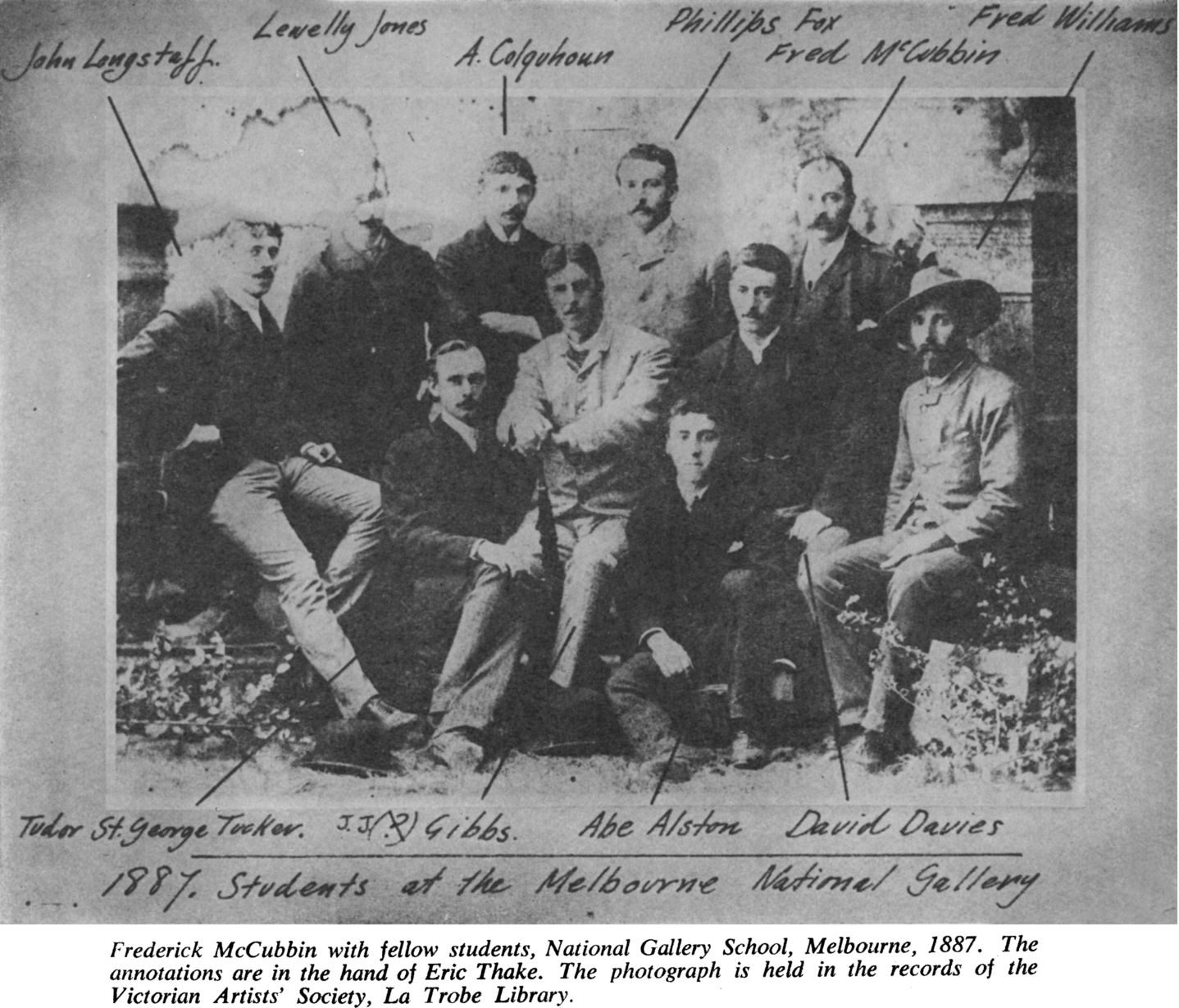
Photo: Frederick McCubbin with fellow students, National Gallery School, Melbourne 1887. The annotations are in the hand of Erick Thake. The photographs is held in the Victorian Artists’ Society
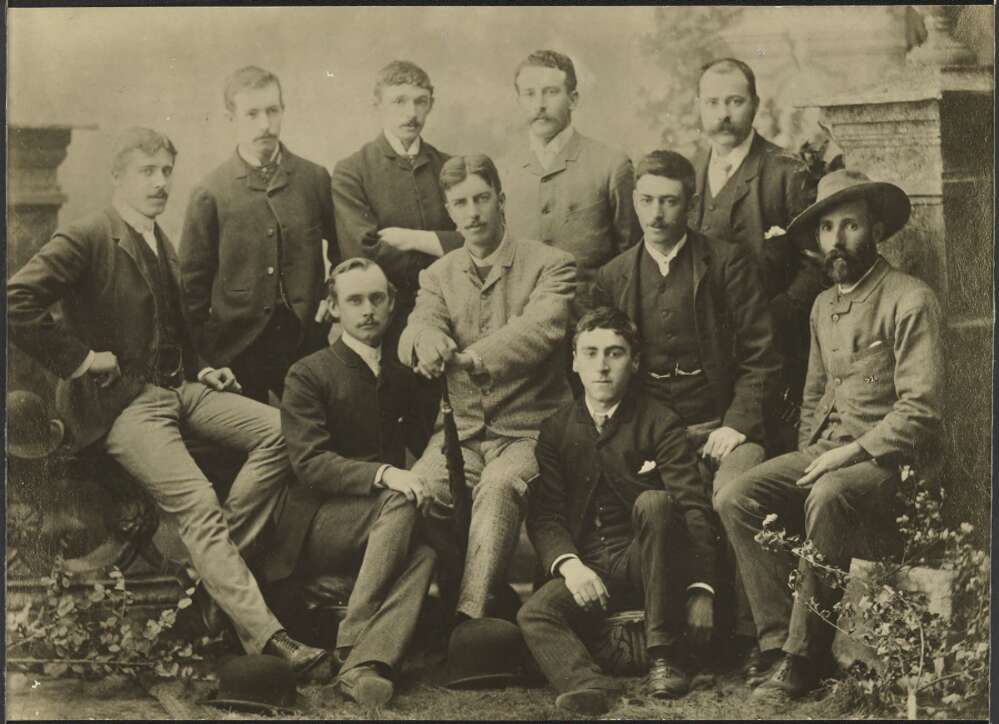
(1887). Group of students, National Gallery Art School, Melbourne 1887 Retrieved from http://nla.gov.au/nla.obj-135881521
Compare one of the most intriguing photographs shared with us, courtesy of David James OAM, former Mayor and Councillor of Pittwater, which underlines some Artists who have been very successful, and associated with names such as Roberts and Streeton at Sirius Cove at Mosman, such as McCubbin, Longstaff, Alec Colquhoun, Abbey Alston, Fred Williams, from the Melbourne sprung Heidelberg School of Painting members, have created Art that focused on and celebrated Pittwater. Fred Williams, for instance, once lived at 'Green Hills' Narrabeen.
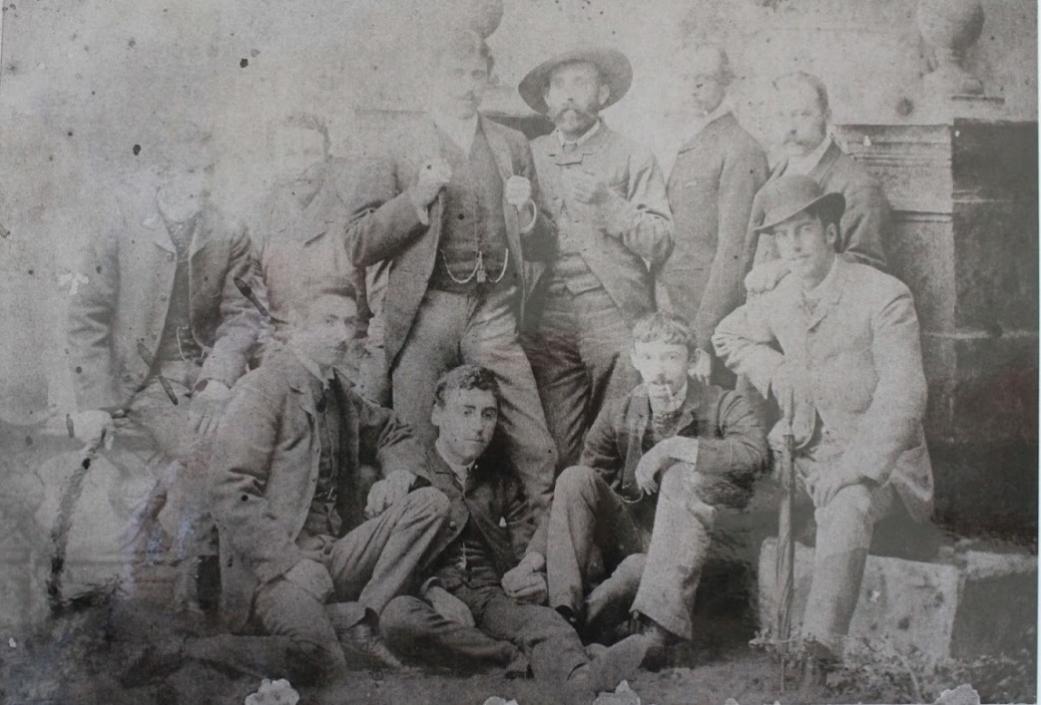
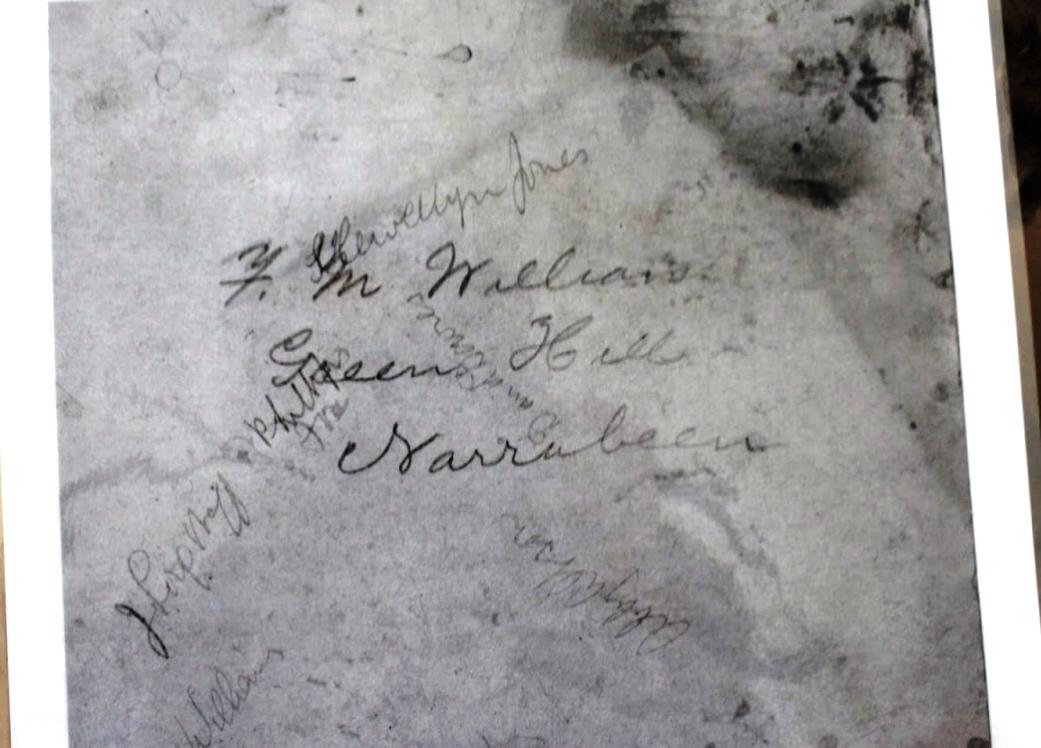
Founded in 1861, the National Gallery of Victoria is Australia's oldest, largest and most visited art museum. The National Gallery of Victoria houses an encyclopedic art collection across two sites: NGV International, located on St Kilda Road in the Melbourne Arts Precinct of Southbank, and the Ian Potter Centre: NGV Australia, located nearby at Federation Square. On May 24th, 1874, the first purpose built gallery, known as the McArthur Gallery, opened in the McArthur room of the State Library, and the following year, the Museum of Art was renamed the National Gallery of Victoria. The McArthur Gallery was only ever intended as a temporary home until the much grander vision was to be realised. However such an edifice did not eventuate and the complex was instead developed incrementally over several decades.
The National Gallery of Victoria Art School, associated with the gallery, was founded in 1867 and remained the leading centre for academic art training in Australia until about 1910. The School's graduates went on to become some of Australia's most significant artists. This later became the VCA (Victorian College of the Arts).
In 1887, the Buvelot Gallery (later Swinburne Hall) was opened, along with the Painting School studios. In 1892, two more galleries were added: Stawell (now Cowen) and La Trobe. In 1888, the gallery purchased Lawrence Alma-Tadema's 1871 painting The Vintage Festival for £4000, its most expensive acquisition of the 19th-century.
George Frederick Folingsby (23 August 1828 – 4 January 1891) was an Irish-born Australian painter and art educator. Folingsby was born in the County of Wicklow, Ireland. At the age of 18 he emigrated to Canada. Later he went to New York City, studied drawing and contributed illustrations to magazines of the day, including Harper's Magazine. In 1852 he went to Munich and spent two years at the drawing school of the Royal Academy. He then went to Paris and for a few months was a pupil of Thomas Couture. Returning to Munich he worked for five years under Carl von Piloty.
In 1864, Folingsby's picture Bunyan in prison, was purchased by the National Gallery of Victoria. He continued to live in Munich but occasionally exhibited in Ireland and England; his The first lesson was hung in the Royal Academy in 1869 and Lady Jane’s victory over Bishop Gardener in 1871. He was awarded medals for historical paintings at the exhibitions held at Vienna in 1871 and Philadelphia in 1873.
Folingsby arrived in Melbourne, Australia with his ten-year-old daughter, on July 1st 1879. His reputation as a figure painter preceded him and he was quickly sought after as a portraitist, making a living from commissions of eminent members of Melbourne society. Folingsby was offered the position of Master in the School of Painting at the gallery and was appointed on 1 June 1882.
In September of that year, he was appointed as the first Director of the National Gallery of Victoria and reorganised the painting school. The practice of making copies of pictures ceased and every encouragement was given to working from life. Among his pupils were John Longstaff and Aby Altson, the winners of the first and second travelling scholarships, and Harold Tristram Squire.
THE NATIONAL PICTURE GALLERY AT THE PUBLIC LIBRARY.
One of the events which has attracted most attention during the last few weeks has been the opening of the National Picture Gallery in the new wing of the Public library. About twelve months ago the Legislature voted the sum of;£1000 for the purchase of pictures, and little time was lost in, forming the nucleus of what will one day no doubt be a very valuable collection of works of art. A number of pictures were selected with great care from the studios of Great Britain and ', the continent, and these, together with some colonial works of art, sent in to compete for the premium' : offered by the Government, form the present picture gallery. The room devoted to this purpose, is about a' hundred feet' long and thirty feet wide, and a very, lofty ceiling, which will be tastefully ornamented with gilt tracery. The plainness of the walls is agreeably relieved by fluted columns after the Ionic order, precisely- similar in style to the corresponding wing of the building, which has for a long time been used as the public-library and reading room. The room is lighted up by to and side skylights, and at night the illuminating power will consist of two gasoliers suspended from the ceiling. Every day since its opening the gallery has been crowded, and the attendance as yet has not shown signs of diminishing. Victorians, it cannot be doubted, are sincere lovers of art, and* the establishment of such a valuable institution in the metropolis will stimulate our local artists to use their best efforts to the production of .works worthy to be placed in competition with those received from the mother country. THE NATIONAL PICTURE GALLERY AT THE PUBLIC LIBRARY; MELBOURNE.— Bks Page 7. THE NATIONAL PICTURE GALLERY AT THE PUBLIC LIBRARY. (1865, January 25). The Australian News for Home Readers (Vic. : 1864 - 1867), p. 8. Retrieved from http://nla.gov.au/nla.news-article63170907
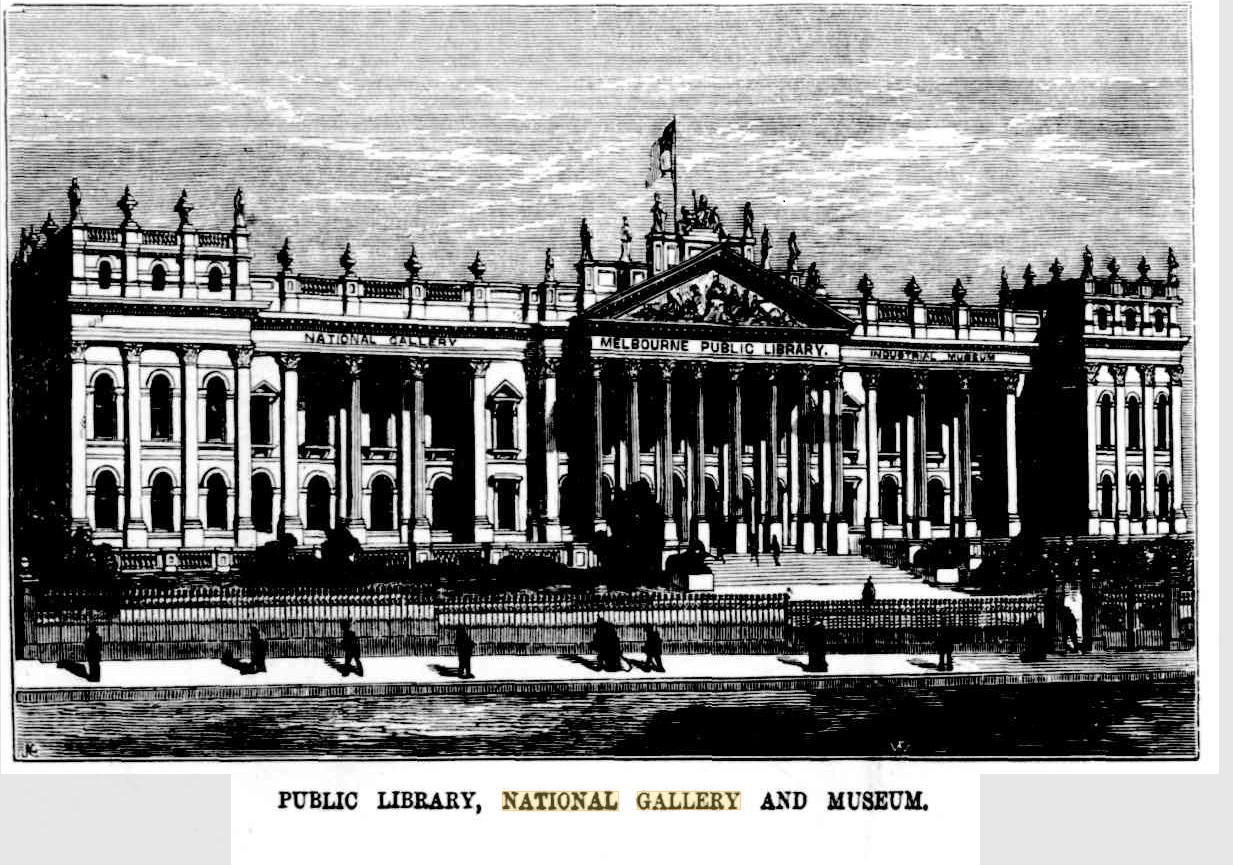
THE NATIONAL PICTURE GALLERY AT THE PUBLIC LIBRARY; MELBOURNE.— Bks Page 7. PUBLIC LIBRARY, NATIONAL GALLERY AND MUSEUM. PUBLIC LIBRARY, NATIONAL GALLERY AND MUSEUM. (1878, June 10). Illustrated Australian News (Melbourne, Vic. : 1876 - 1889), p. 89. Retrieved from http://nla.gov.au/nla.news-article60095292
After the death of Folingsby, Lindsay Bernard Hall was appointed Director of the National Gallery of Victoria.
MR. S. BERNARD HALL. NEW ART DIRECTOR FOR THE
MELBOURNE NATIONAL GALLERY.
A portrait is given of Mr. S Bernard Hall, who succeeds the late Mr. Folingsby, as art director at the Melbourne National Gallery. Mr. Henry Blackburn prophesies that he will prove to he a thoroughly competent teacher, an orderly and methodical curator, and a cautious adviser in the buying of pictures.
Mr. Hall was educated at Cheltenham College, in England, under the Rev. Jex Blake (now Dean of Worcester). His art education began at Antwerp, when he was about 19. He studied in Munich from 1880 to 1882, and may be said to be of the school of Piloty, who was then the reigning influence. He has lived and worked since that time principally in London, but has visited the best schools in Europe. Mr. Hall has exhibited repeatedly in the Royal Academy, but perhaps the best and most complete of his pictures is " The Litany," which was exhibited in the Suffolk-street Gallery of British Artists in London in 1889.
Under the title of ''Fixed and Wandering Thoughts," an engraving of this picture was given in The Australasian of December 13,1890, or about 15 months ago. It is a painting of childhood, youth, and age at prayer. Mr. Hall is now 32 years of age.
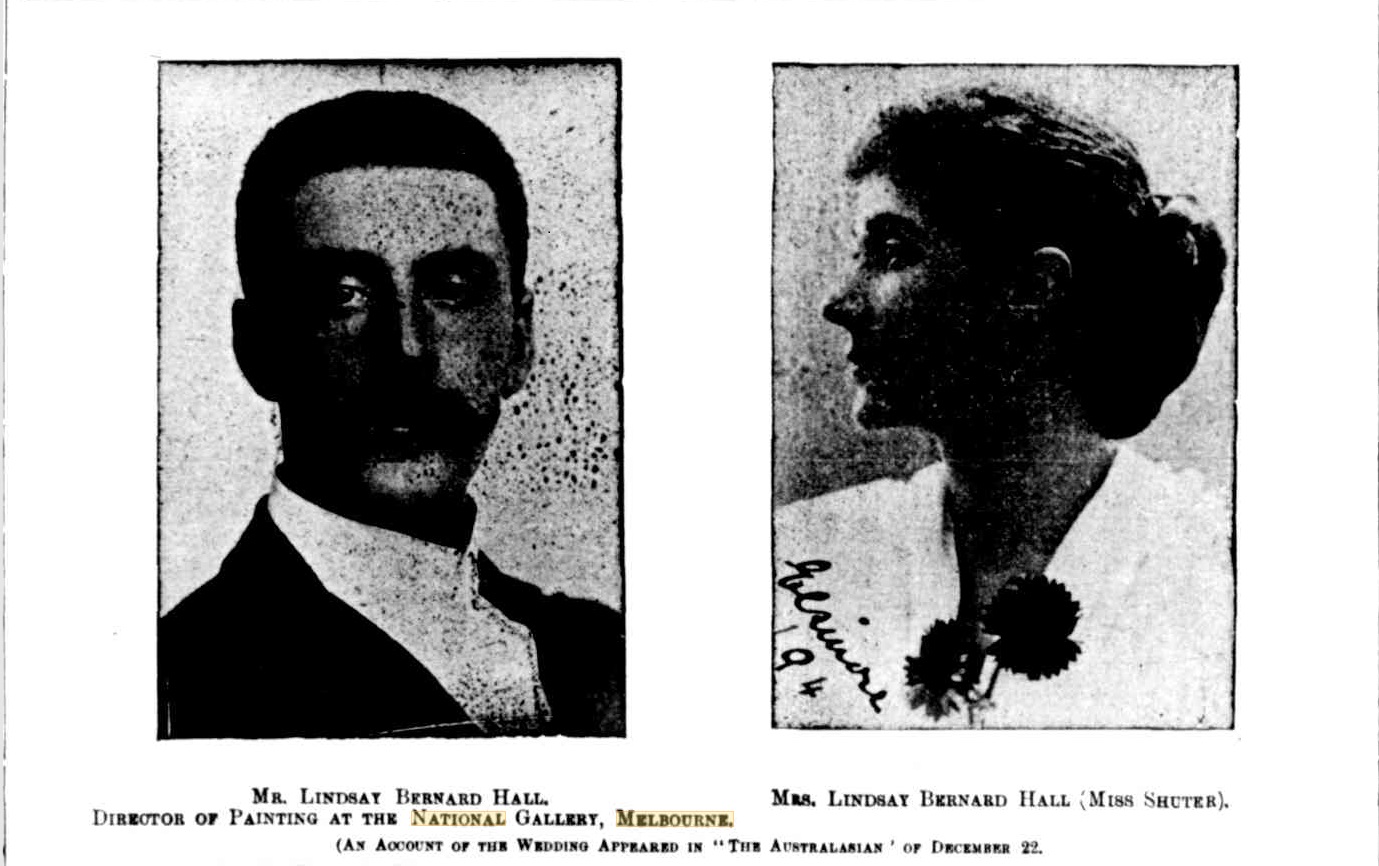
Photo is from same paper - December 29th, 1894
MR. S.. BERNARD HALL, NEW ART DIRECTOR FOR THE MELBOURNE NATIONAL GALLERY. MR. S. BERNARD HALL, NEW ART DIRECTOR FOR THE MELBOURNE NATIONAL GALLERY. (1892, March 26). The Australasian (Melbourne, Vic. : 1864 - 1946), p. 41. Retrieved from http://nla.gov.au/nla.news-article138624987
Lindsay Bernard Hall (December 28 1859 – February 14 1935) was an English-born Australian artist, teacher and art gallery director. Hall was born at Garston, Liverpool, England, the son of a broker of the same family as Captain Basil Hall, writer of books of travel; his maternal grandfather was conductor J. Z. Herrmann. Hall was educated at Cheltenham College and grew up in an atmosphere of culture. He studied painting at the South Kensington School of Art, Antwerp and Munich, and worked for several years in London. He exhibited at the Royal Academy and was one of the original members of the New English Art Club. He exhibited with the club in 1886 and 1887, along with Clausen, Sargent, Gotch, Kennington and others.
On the death of George Frederick Folingsby in 1891, he was appointed director of the National Gallery of Victoria and master of the School of Arts in Melbourne. He began his duties in March 1892. Hall married Elsinore Mary Shuter on 18 December 1894, however she died in 1901. He held the position at the Gallery for 43 years and many of the well-known painters of Australia were trained by him in the National Gallery of Victoria Art School. Hall also acted as adviser to the trustees for purchases for the gallery and art museum, and when the munificent bequest of Alfred Felton was received in 1904 his responsibilities were much increased. In 1905 Hall went to England to make purchases under the bequest. After his return he was expected to advise on everything submitted that might find a place in an art museum and, although he never claimed to be an expert in all these things, he supplemented his knowledge with hard reading and made relatively few mistakes.
By 1886 Mr. Squire begins to be mentioned amongst the students exhibiting works:
The pupils of Mr. Short, Mr. Fieghen, Mr. Pritchard and other artists of the city, exhibit works in the north-east corner, together with National Gallery. The best work of the pupils of private teachers is the Nut Gatherers, a figure painting by Miss A. Newcombe. This must, however, be viewed from an amateur standpoint. Messrs. Collin, Thomas and Squires, National Gallery students, show some capital still-life pictures. BENDIGO JUVENILE INDUSTRIAL EXHIBITION. (1886, November 16). The Age (Melbourne, Vic. : 1854 - 1954), p. 6. Retrieved from http://nla.gov.au/nla.news-article196012921
The following year his work receives 'special mentions':
STUDENTS EXHIBITION AT THE NATIONAL GALLERY.
DISTRIBUTION OF PRIZES.
The annual exhibition of paintings and drawings by students in the art classes connected with the National Gallery was opened yesterday by the Premier, who also presented the prizes awarded to the most successful students. The ceremony took place in the main gallery, the eastern end of which was curtained off for the display of the pictures exhibited. The drawings were displayed upon screens at the other end of the gallery. The company present was numerous and representative, and was composed largely of ladies. Mr. Gillies took the chair, and among the other gentlemen present were Sir George Verdon (chairman of the trustees), Sir James MacBain, Dr. Dobson, M.L.C., Mr. Winter, M.L.C., Mr. P. Hanna, M.L.C., the Chancellor of the University (Dr. Brownless), the Warden of the University Senate (Mr. C. A. Topp), the Rev. Dr. Bromby, Mr. R. L. J. Ellery, Mr. H. G. Turner, Mr. James Smith, Mr. Thos. Carrington, and Mr. George C. Gordon, the three last-named gentlemen being the honorary judges.
Sir GEORGE VERDON, in opening the proceedings, said his first duty was to express the great regret of the trustees that His Excellency the Governor and Lady Loch were not able to be present. He was also charged by them to say that they, too, were exceedingly sorry that they were unable to be there. It was his next duty and pleasure to thank Mr. Gillies for the honour he had conferred on the trustees in consenting to take the chair on that important occasion. The trustees had many evidences of the goodwill which the Government exhibited to this institution in very many substantial ways. This was the second exhibition which the students in the classes of drawing and painting had held within those walls, and it afforded the trustees great gratification to be able to say that, although the first exhibition was a very great success, there were distinct signs of improvement in the works exhibited on the present occasion. (Applause.) There were now no less than 187 students in drawing and painting in the classes of the National Gallery. This was as many as could be instructed with the accommodation available, but it was hoped that the time was not far distant when they would be able to take all who presented themselves and were desirous of learning art as students of this institution. It would be found, when the works were examined, that there was a distinct and marked progress in the nature of the work shown. Some of the works would also be found to be more ambitious than those which were shown last year. The number of subject pictures would be found to be greater and the number of landscapes less, and for a very sad reason. He referred with deep regret, on behalf of the trustees, to the death of Mr. J. J. Gibbs, one of the most promising students, and whose works appeared on the walls, although, alas ! they were unfinished. They had also to regret the absence of Mr. Fox, another very successful student, who was now studying in France. It would no doubt be observed that there were a large number of studies of still life which were repetitious of the same subjects. The cause of that was that there was not room to have a large number of students working from separate models. Since the last exhibition the trustees had taken one or two very important steps. One of them was the appointment of a lecturer of anatomy, from which great good was expected to result ; but perhaps the most important step of all was the establishment of a travelling scholarship, for the most successful student exhibiting on this occasion. It was most satisfactory to all who cared for the progress of art in this country that the gentleman selected for this honour and advantage had shown by the work he had done, and which was exhibited that day, that he was worthy to go forth to the great centres of art in Europe, there to perfect his education and to produce work which should not only be admired here, but challenge the admiration and approval of still higher critics in other parts of the world. (Applause). It was, perhaps, right to mention that no kind of copying was permitted in this exhibition. Copying was strictly excluded from the course of study. It used not to be so, but it was agreed that a valuable departure had been now made in this direction. One of the advantages which the school had derived was the bequest of the late Dr. Gilbee of £1,000 for the purchase of a picture of an English artist on some subject of a distinctly Australian character. This was mentioned in the hope that it might lead to other benefactions of a similar nature. Art institutions in the old world continually received assistance from such sources, and it was well that in our own community we should not look too much to the state. It was not too much to hope that not only would the institution receive the gifts of living benefactors, as had already been the case to a large extent, but that men making their wills would remember the institution, and add to the collection some work which would add honour to their memory, and be a welcome addition to the National Gallery. The trustees had to acknowledge the gift of Mr. Wallen, who sent, as before, an amount to be spent in prizes, which evidenced the interest he took in the progress of the art classes. (Applause.) The last duty he had to perform was to ask Mr. Gillies to inspect the pictures, but he could not conclude without expressing the great obligation which the trustees were under to Mr. Folingsby, the director of the classes, and to Mr. M'Cubbin, the instructor in drawing, for the care and zeal which they had devoted to their work, the successful results of which he now invited them to see on the walls of the gallery at the other end of the room.
An inspection having been made of the pictures exhibited, Dr. Bride (secretary to the trustees) read the report of the judges, which was as follows :—
To the Trustees of the National Gallery.
Gentlemen,—We have the honour to report that we have carefully examined and compared the paintings and drawings exhibited by the students, and beg to recommend the award of the following prizes :—
The gold medal carrying the travelling scholarship to Mr. Longstaff, for his "Breaking the News " ; £30 to Mr. Colquhoun, for his group of figure subjects, £20 to Miss Edeson, £10 to Miss Rae, £5 to Mr. T. St. G. Tucker, also for groups of figure subjects ; £12 10s to Miss Edeson, for her " Back Beach, Sorrento," £12 10s. to Mr. J. L. Jones, for his " Beach near Cheltenham," the two being equal ; £5 to Mr. Colquhoun, for his " Deserted " ; Mr. Wallen's prize of £5 5s. to Miss Walker, for her " Portrait."
We desire to make special mention of the paintings by the late Mr. J. J. Gibbs, Miss Collis, Mr. H. T. Squire, and Mr. D. Davies ; and honourable mention of those of Miss Muntz, Mr. F. Williams, Miss Meston, and Miss Southern. STUDENTS EXHIBITION AT THE NATIONAL GALLERY. (1887, April 26).The Argus (Melbourne, Vic. : 1848 - 1957), p. 9. Retrieved from http://nla.gov.au/nla.news-article7920283
ARTS. THE STUDENTS' EXHIBITION AT THE NATIONAL GALLERY.
A large number of ladies and gentlemen assembled at the National Gallery on Monday afternoon, on the occasion of the opening of the collection of students' work. The proceedings were opened by Sir Geo. Verdon, who thanked the Premier for his kindness in attending to inaugurate the exhibition in the absence of his Excellency the Governor and Lady Loch, both of whom he know greatly regretted their inability to be present. He believed and trusted that the work they were about to inspect would afford evidence of the success of the efforts made by the trustees in the direction of a higher degree of excellence year by yean One important step taken had been the arrangements for the institution of lectures on anatomy to aid in drawing from the life ; and a second and most important one was the travelling scholarship, enabling the winner to obtain, subject to certain conditions, instruction in Europe from personal inspection of the highest schools of art. He believed that the more the general public appreciated the earnestness of their purpose the more funds would be placed at their disposal for art purposes. A bequest of £1000 from Dr. Gillbeo was invested pending its disposition according to the intentions of the legator; and Mr. Wallen's donation of £5 5s. for the best portrait was acknowledged with thanks. Since they last met death had taken away one of their most promising pupils, Mr. Julian Gibbs ; and Miss line was unable to be present owing to prostration on a bed of sickness. The best thanks of the trustees were due to Messrs. Gordon, Carrington and Jas. Smith; and to Mr. Folingsby he tendered their hearty congratulations on the success of his pupils. He then requested Mr. Gillies to inspect the adjacent collection and declare the building open.
Of the pictures exhibited, Mr. Longstaff's Breaking the News tells its own story in a realistic and pathetic manner which is perfectly irresistible. Dismissing the accidental coincidence of the Bulli disaster as unpremeditated by the artist, unless in the spirit of prophecy, we find the inspiration of the painter in some colliery accident at home witnessed or narrated, and which has taken a hold upon his feelings. A domestic interior, whose homely and neat surroundings are represented with scrupulous fidelity, discloses an anxious mother, babe in arm, already more than half guessing the awful tidings about to be imparted to her by an aged man, hoary in locks, but browned with toil, presumably her father, which are that the bread winner has perished, that the home will be broken up, and that possibly herself and infant may be separated. The half open door shows the colliery derrick in the distance, and mournful figures, hushed into silence, stand on the outside. None but those who have the sympathy to fool these tragedies, in addition to the art to portray them, can adequately do so. We shall be surprised it this picture, whatever be the price set upon it, is not snapped up by a purchaser as soon as shown. The next picture in the collection is Miss Lena Edeson's sea piece, named By the Sad Sea Waves. It is a beautiful work, nil of life and air, and most meritoriously and carefully painted. The same promising young artist sends' a vigorous head, and another portrait, a small three-quarter length of a lady, very good work, perhaps containing a little too much millinery. The Dismissal, by this lady, is most carefully worked out. The group of the vulgar mother and spoilt child is the best part of it. The discarded governess is a little out of the picture, and the young lady's bands are represented unduly coarse. The introduction of the portrait on the wall is a happy idea. Next in order of merit we place an artist (the term is used advisedly) whom we never board of before, and certainly a student, for be has much to learn. But Mr. A. Altson's pictures display a promise which it is to be trusted his future performances will justify. Tho work in bis Fisher Boy is most excellent, and his charcoal studies show that he can seize a point and emphasize it. Such work as this is actual genius, and not mere trickery. Mr. Colquhoun's best work is a lively little indoor scene, possessing special interest from its being the representation of tho studio of the lamented and genial J. Julian Gibbs, who has a panel to himself, and whose most important exhibit will be found reproduced in Mr. Colquhoun's presentment. This beautiful little concentration is called The Vacant Chair. Divided Attention, Out Patients, and Deserted, by the same artist, wilt all find, admirers, the latter especially, an exquisite study of real nature. But the Sundowner, a finished picture, and Meditation, or rather, as it should be called, A Drown Study, an unfinished sketch, must at once attract notice from their incisive power. Miss Collis's works are too masculine in treatment; in other words, she plasters on her color rather too savagely; but Brothers in Adversity, viewed from a sufficient distance, tones down wonderfully ....harsh becomes harmonious and mellow. The same remarks apply in a minor decree to her other exhibits. The place of honor in the room is given to Miss J. Kae's Persuasion. The composition is elegant, while some question may arise as to the harmony of the colors chosen by the artist in the dresses. It would, however, be unjust to comment unfavorably on the picture, for portions of it are clearly not finished, such as the Chinaman's hair and other details. Her study entitled Old Age is too sere and yellow in texture. The same may be said of Mr. Llewellin Jones's works, six in number. They would engrave capitally, but many of their present flat surfaces of paint instead of detail. Two, however, merit special commendation— a picture singularly named "With the Stream'', but which is curiously like a waterhole on the Merri Creek, and the Beach near Cheltenham. Mr. T. F. Tucker's important picture, Jealousy, is rather disappointing, being unduly dull in tone. He represents the interior of Westminster Abbey, with a female prowling behind the custored shafts which support the triforium of that venerable structure, and lying in wait for a bridal party visible in the distance — not to her, but to the spectator— coming down the choir. The bridegroom, it may be assumed, has jilted or deceived her. Miss Cuntz makes a speciality of fruit, wielding a brilliant study. Mr. M'Cubbin is this year no longer a contributor to the students' exhibition, his time being entirely occupied in teaching drawing. The result of his labors is very apparent in the vast improvement exhibited, both in drawing and chiaroscuro, in the specimens shown on the panels. While it would be absurd to say that no defects are visible, especially in foreshortening, there, are very few drawings that are not worth a place. Mr. Altson's drawings have already been alluded to ; and those of Mr. T. St. George Tucker evince great care, painstaking and accuracy. It will be observable that all the work is done " from the round," i.e., from living models or busts, and that the practice of drawing from the flat — which, sooner or later, degenerates artists into copyists — is tabooed. Dr. Bride read the judges' report which stated that they had sincere gratification in referring to Mr. Longstaffs picture as the best figure painting that had yet teen produced by a Victorian artist, and justifying the expectation that his artistic career in Europe would reflect credit on his instructor as well as on himself, and fully confirm the wisdom of the policy which had founded the scholarship. Permission was also requested to present Mr. Altson with a prize of 3 guineas from the judges in recognition of the admirable work in his drawings and the great promise displayed in his oil paintings. In conclusion, they had much satisfaction in noting the steady progress made both by the students in oil painting under Mr. Folingaby, and by those in drawing under Mr. M'Cubbin, who appeared specially well qualified for the post he occupied. The report was signed by Messrs. George C. Gordon, Thomas Carrington and James Smith, who awarded the prizes as under : — The gold medal, carrying the travelling scholarship, to Mr. Longstaff, for his Breaking the News. Figure Subjects. — 1st prize, £30. To Mr. Colquhoun; 2nd, £20, to Miss Edeson ; 3rd, £10, to Miss Rae; 4th', £5. to Mr. T. St. G. Tucker. Landscape — £12 10s. to Miss rdeson, for her Beck Beach, Sorrento ; £12 10. to . Mr. J. L. Jones, for his Beach near Chelthenham, the two being equal; £5 to Mr. Colquhoun for his Deserted. Mr Wallen's prize of £5 5s. to Miss Walker for her Portrait Special prize. £3 3s., to Mr. Altson for his drawings.
Special mention was made of the paintings by the late Mr. J. J. Gibbs. Miss Collis, Mr. H. T. Squire and Mr. D. Davies; and honorable mention of those of Miss Mintz, Mr. F. Williams, Miss Meston and Miss Southern. The judges recommended an award of £2 10'. each to Mr. Tucker and Mr. Altson for their drawings: and they desired to make honorable mention of those of Miss B. Wedel, Miss Collis, Miss Thomas, Miss Baskerville and Messrs. A. Streeton, Davies and Cherry. The prizes were then presented to tho various recipients by Mr. Gillies, who remarked that the most gratifying circumstance connected with the distribution was the report received from year to year of the steady progress made by the students, who, under the tuition of an institution like the National Gallery, enjoyed great and special opportunities of developing the innate talent they possessed. Artistic gifts, if properly cultivated and used for legitimate purposes, were a source of pleasure alike to their possessors and to those who acquired and viewed their works. In conclusion, he remarked that, in his opinion, if no other picture of merit other than the pathetic work which had gained tho scholarship had been produced, it alone would have justified the existence of the Melbourne school. The proceedings then terminated, the company, before separating, taking another turn round the gallery, and also inspecting the charcoal drawings placed against the door. The opinion was general in support of the propriety of most of the awards, and unanimous respecting that to Mr. Longstaff. FINE ARTS (1887, April 30). Leader (Melbourne, Vic. : 1862 - 1918), p. 37. Retrieved from http://nla.gov.au/nla.news-article198039022
Breaking the News shows the interior of a miner's cottage on the Victorian goldfields with an old man breaking the news to a woman of her husband's death in a mining accident. The woman holds an infant in her arms, and two other miners appear in the doorway, carrying the body of the husband on a stretcher. Behind them in the distance stands the mine's headframe. Breaking the News became etched in the popular imagination, and by the 1890s was "known by reproduction in every mining township in Australia".
Painted when Longstaff was still an art student, it won him the National Gallery of Victoria Art School's first travelling scholarship in 1887. The Argus described it as "a vivid and accurate presentment of a familiar incident in Australian life". Only one month after the painting was first exhibited in Melbourne, eighty-one coal miners perished in a gas explosion at the Bulli Mine in New South Wales. The New Australasian Gold Mine disaster, Australia's worst below-ground gold mining disaster, occurred on December 12th 1882 in Creswick, less than twenty kilometres from Longstaff's hometown of Clunes. According to biographer Nina Murdoch, Longstaff's childhood memory of a mining fatality was the direct inspiration for Breaking the News: "the day at Clunes, following the tragic cortège from mine-head to cottage door, he had heard the stricken cry of the young wife at the sight of the stretcher-bearers' burden".
Renowned Australian writer and poet Henry Lawson declared himself a "worshipper" of Longstaff after viewing Breaking the News, and discussed the painting's sentimental and social impact at length in an 1899 essay for The Bulletin titled "If I Could Paint", concluding that he'd "be prouder of a picture like Breaking the News than of a hundred exquisite alleged studies in the "nood"." The following year, The Bulletin co-founder and then-owner of Breaking the News, J. F. Archibald, commissioned Longstaff to paint a portrait of Lawson. Archibald greatly admired the portrait, prompting him to set up a bequest for the Archibald Prize, now Australia's most prestigious prize for portraiture. Longstaff went on to win the Archibald five times.
Breaking the News was the inspiration for a 1912 film of the same name. Directed by W. J. Lincoln and shot near Melbourne, it depicts the flooding of an underground mine and daring attempts to rescue the miners. The film was a commercial success and received favourable reviews from critics. It is now considered a lost film. Breaking the News was acquired by the Art Gallery of Western Australia in 1933.
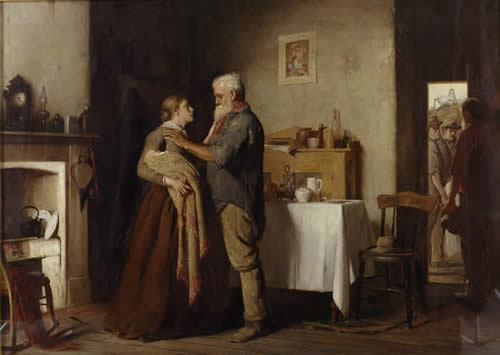
Breaking the News - John Longstaff, 1887. Medium: Oil on canvas, Dimensions 109.7 cm × 152.8 cm (45.1 in × 60.2 in)
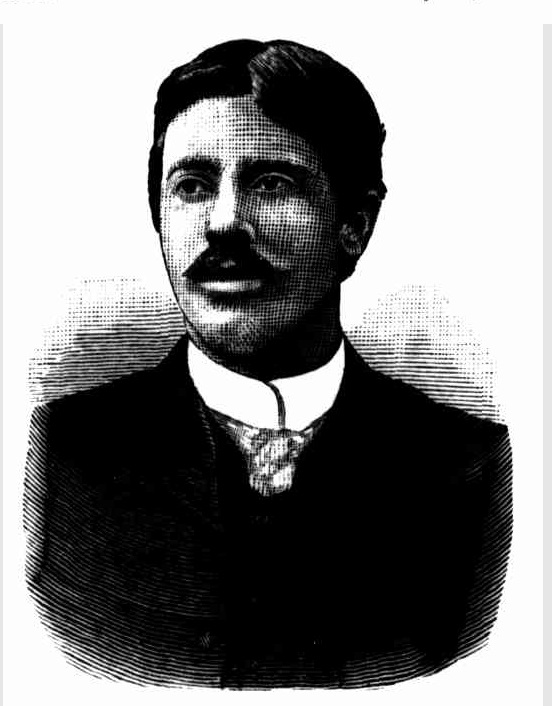 MR. J. LONGSTAFF,
MR. J. LONGSTAFF,
THE FIRST VICTORIAN GOLD-MEDALLIST FOR ART.
MR. J. LONGSTAFF is the painter of that beautiful picture now being exhibited among the year's work of the students at the National Painting School, and entitled " Breaking the News." At the private view the picture was purchased for the sum of 100 guineas, by the firm of Messrs. A. E. Clarke and Co. Mr. Longstaff is a native of Clunes, and a son of Mr. J. Longstaff, of Shepparton. At an early age he carried off many first prizes as a juvenile student in the local Schools of Design.
Four years ago, when the National Painting School was just finding its new stability, under its present most efficient director, Mr. Folingsby, young Longstaff became one of its students. At the end of the first year he obtained the second prize for painting; at the end of his second year the first prize, and he repeated the achievement at the end of his third year, when he offered to the Melbourne art world his pathetic picture called "Motherless."
A fourth year has ripened his technical skill and intensified his pathos. So that now at the age of 25 he has been placed by the judges as the Gold Medallist for Art in Victoria. This medal is now awarded for the first time. It carries with it a travelling scholarship of CI50 per annum, and Mr. Longstaff will proceed to Paris in three months' time. There he will be attached to a studio and to the National School of Fine Arts for three years. At the end of the first and second years he will furnish a copy of an "old master "for our National gallery, and at the end of the third he must send to the same gallery an original painting. Besides the pride and satisfaction of encouraging such high native genius the colony will thus also get good value for its money. Mr. Folingsby's conduct of the school as director is a triumphant success. Even if he had done no more than develop this one talented young genius, the country might well rest satisfied with the experiment. We wish Mr. Longstaff a brilliant and useful career. MR. J.LONGSTAFF. (1887, May 5). Melbourne Punch (Vic. : 1855 - 1900), p. 10. Retrieved from http://nla.gov.au/nla.news-article174571386
Right: engraving of Longstaff from above article.
The following year a description of a painting and a Notice of a prize received:
THE NATIONAL GALLERY. THE STUDENT ANNUAL EXHIBITION.
The annual exhibition of oil pictures and drawings by the students in the schools of painting and drawing connected with the National Gallery will be opened this afternoon by His Excellency the Governor and Lady Loch the admission being by card or invitation The exhibits comprise nearly 70 oil paintings …
‘’Sunlight’’, by H. T. Squire represents a young lady of the period surprising a fair friend whose hair is of that dreadful red which one always associates with freckles and straw coloured eyelashes and whose eyes she bandages with both hands but, it may be asked, would not the victim of the practical joke put up both her own in such a case in order to disengage those of the other? The textures of the dresses are nicely rendered in each instance and the face of the new comer is full of pleasantry. … THE NATIONAL GALLERY. (1888, November 13). The Argus (Melbourne, Vic. : 1848 - 1957), p. 8. Retrieved from http://nla.gov.au/nla.news-article6908771
This extract records Harold and Mabel, his soon to be wife, in the same report:
Mr. Harold Squire, of Parkville, exhibits for the second time giving proof of continued progress and gaining second prize for glure painting. Miss Mabel Harvey, of Caulfield, has been less than a year at this institution, but her studies are very promising. Art Students' Exhibition. (1888, November 16). Table Talk (Melbourne, Vic. : 1885 - 1939), p. 14. Retrieved from http://nla.gov.au/nla.news-article146024878
Parkville is a suburb located in Melbourne, and now home to several large hospitals, Melbourne University, Melbourne Zoo and the city's largest park, Royal Park. Mabel Harvey is the lady he would soon marry. Painting in the 'Glure'
For the decade from 1880 to 1890 the average weekly wage was £1.40, and so earning a prize in the annual Students Exhibition secured a way forward, for at least a little while - so this Notice:
THE NATIONAL GALLERY
THE EXHIBITION OF PAINTINGS BY
THE STUDENTS. DISTRIBUTION OF PRIZES.
The fifth annual exhibition of paintings by the students of the National Gallery was held yesterday afternoon in the National Gallery. Mr I" Langton, the Vice president, was in the chair His Excellency the Governor, who had been entrusted to distribute the prizes to the successful students of the term was present, accompanied by Lady Loch there was also a large general attendance.
... in the course of his address, stated that the change in the date of holding the exhibition from April to November had been unavoidable, but as it enabled many visitors who were drawn to Melbourne by other causes to attend the students exhibition, the delay was not at all a matter for regret. Moreover, by meeting at this season of the year, the students were only following the practice of the Royal Academy of London and the Salon in Paris, whose exhibitions were fixed for the beginning of summer In the art classes of the National Gallery there were no less than 202 students of whom 2°- were devoting themselves to painting and 171 to drawing. This large discrepancy between the two classes was not however, ti subject for unfavourable comment, for it indicated that Mr Folingsby the director, was adhering to the system which he had adopted on taking charge, namely, that before a student was to be permitted to paint he must show conclusively that he understood the elements and principles of drawing. The exhibition this year would have been larger but for the absence of six of the students in Paris one of whom had won the travelling scholarship and the five others had decided to proceed thither at their own expense rather than miss the advantages of European study. The present occasion was a very favourable one on which to reply to the criticisms that the trustees of the gallery had both been subjected to in respect of selection of a number of the pictures. Many of the criticisms had been anonymous, and one of the critics of that character had gone so far as to describe the works exhibited on the walls of the Victorian National Gallery as rubbish. Various methods of selection had also been advocated by the same parties to avoid in future what were deemed to be mistakes, but, speaking as a trustee who had been many years in office, he could say that every one of those met here is of selection had been considered by the masses and been dealt with on its merits. The pictures had been secured on the representation of acknowledged authorities in art. One picture, the selection of which had incurred for the trustees unmeasured blame, had actually been specially praised by ....Of that great work, however both the Art Journal and the Athenieum had spoken very highly, and supported by those authorities the trustees could well disregard the strictures of local duties. The National Gallery he was pleased to say, was growing in public favour, and supplied every year elevated and refined entertainment for 600 000 visitors... Gentlemen -We have the honour to submit the following recommendations with respect to the awards -
For the best figure Subjects-Mr Alisons group £5 for the second best. Miss J Muntzs group £2 10 ...Best Landscape - Mr D Davies for his group Best still life-Miss Walker for her group £4, second best Miss T L. Evans... Best Study in Oils-Mr H Squire, for his group, £4 second best Miss V Clarke for her group £2 honourable mention Miss Harvey and Mr Cherry ... Ailsa Corbett Miss Holgate and Messrs Alison, Streeton, Davies (who are not competitors) Miss Hunts and Miss Clarke (who are also non competitive) and.... We desire to record our gratification with the excellent work which Is being Accomplished under the direction of Mr Follingsby, and to express our thanks of the valuable services which are being rendered to the cause of art education in this colony by that gentleman.... THE NATIONAL GALLERY. (1888, November 14). The Argus (Melbourne, Vic. : 1848 - 1957), p. 13. Retrieved from http://nla.gov.au/nla.news-article6908892
The Students' Exhibition at the Melbourne National Gallery.
The sixth annual exhibition of student's work at the National Gallery was opened last Tuesday afternoon. Previous to viewing the exhibition, a brilliant and representative gathering of ladies and gentlemen witnessed the presentation of prizes by Lady Loch to the successful students. Grouped around the viceregal party, which included Sir William Robinson and the Hon. A, Yorke, were Sir George Yeldon, the Minister of Education, Dr. Brownless, Professor M'Coy, Mr. E. Murray Smith, Mr. James Smith, Mr. H. G-. Turner, Mr. J. A. Panton, Mr, G- F. Foilngsby, Dr. M'Inerney, Captain Gurnet, and Mr. E. L, Ellery, Mr. Edmund Finn and Mr. Tennyson Smith, Mr. Edward Langton and Dr. Bride made the usual report, and Sir William Robinson briefly responded on behalf of Lady Loch. The prize list is as follows
For the Best-Portrait and Figure Subjects.—Mr. A. Altson. Special Prizes for Portraits.—Miss A. Wodol, £5 ; Mr. O, Harcourt £5, For the Second Best Figure Subject.—Mr. D. Davies, £20. Honourable Mention.—Miss Yale, Miss Irvine, and Miss C. Grant. For the Best Landscapes.—Mr. L. Jones, £20. For the Best Still-life Pictures.—Miss E. Clarke, £5 ; Mr. T. B. Hanson, £5. Special Prizes for Still Life.—Miss Vale, £8 Miss Muntz, £8 Miss L. G. Johnson, £8 Mr. J. Cairo, £3. For the Best Charcoal Drawings.—First Year Students—Mr. H. G. T. Ghoo, £8 ; Miss Grace J. Joel, £3. For the Second Best—Miss O Paterson, £2. Honourable Mention—Miss L. Mitchell, Miss A. Poters, Miss Wilkins, Miss Stone, Mr. J. M'Donald. For the Best Charcoal Drawings.—-Second Year Students—Mr. H. J. Bocknell, £3,. Mr. J, Quinn, £3, For the Second Best—Miss J. Hawkins, Miss Lister, Mr. Lascelles, £2 each. Honourable Mention—Mr. Trehair. Mr. Wallon's prize of £5 os.: to; Miss Muntz for Memories of Long Ago.
In though case of Mr, A. Altson, no actual prize was given although the credit of first prize was awarded, as owing to one of the rules of the institution no student can carry off the prize for two successive years. Lady Loch, spoke a few graceful words to Mr. Altson, expressive of her sympathy with his earnest work) and her hopes of his eventually successful career in Paris.
The students' work is exhibited in the studios upstairs) above the Grosvenor Gallery. Out of 218 students, twenty-eight, are in the painting class, under Mr. Folingsby, and 190 in the drawing class, under Mr. M'Cubbin, who himself is one of Mr. Folingsby's first pupils in Victoria. The large collections of drawings show excellent work throughout—in many cases the crayons are masterly, and Mr. M'Cubbin must be heartily congratulated on the year's result. The judges, Mr. James Smith, Mr. George Gordon and Mr. Thomas Carrington, had no easy task in comparing the exhibits and allotting the prizes; but with characteristic patience and fairness they gave every picture the fullest attention, and got through their work in a very satisfactory manner, both to themselves and to the students.
The Paintings are eighty-five in number, and are an improvement on even the excellent standard of last year. Mr. Folingsby's fine teaching power has at no time resulted in such interesting work from his pupils, and those among them who have been fortunate enough to have their sole instruction from this experienced artist, have every reason to be proud of their work and their progress. … The Students' Exhibition at the Melbourne National Gallery. (1889, November 15).Table Talk (Melbourne, Vic. : 1885 - 1939), p. 5. Retrieved from http://nla.gov.au/nla.news-article147280445
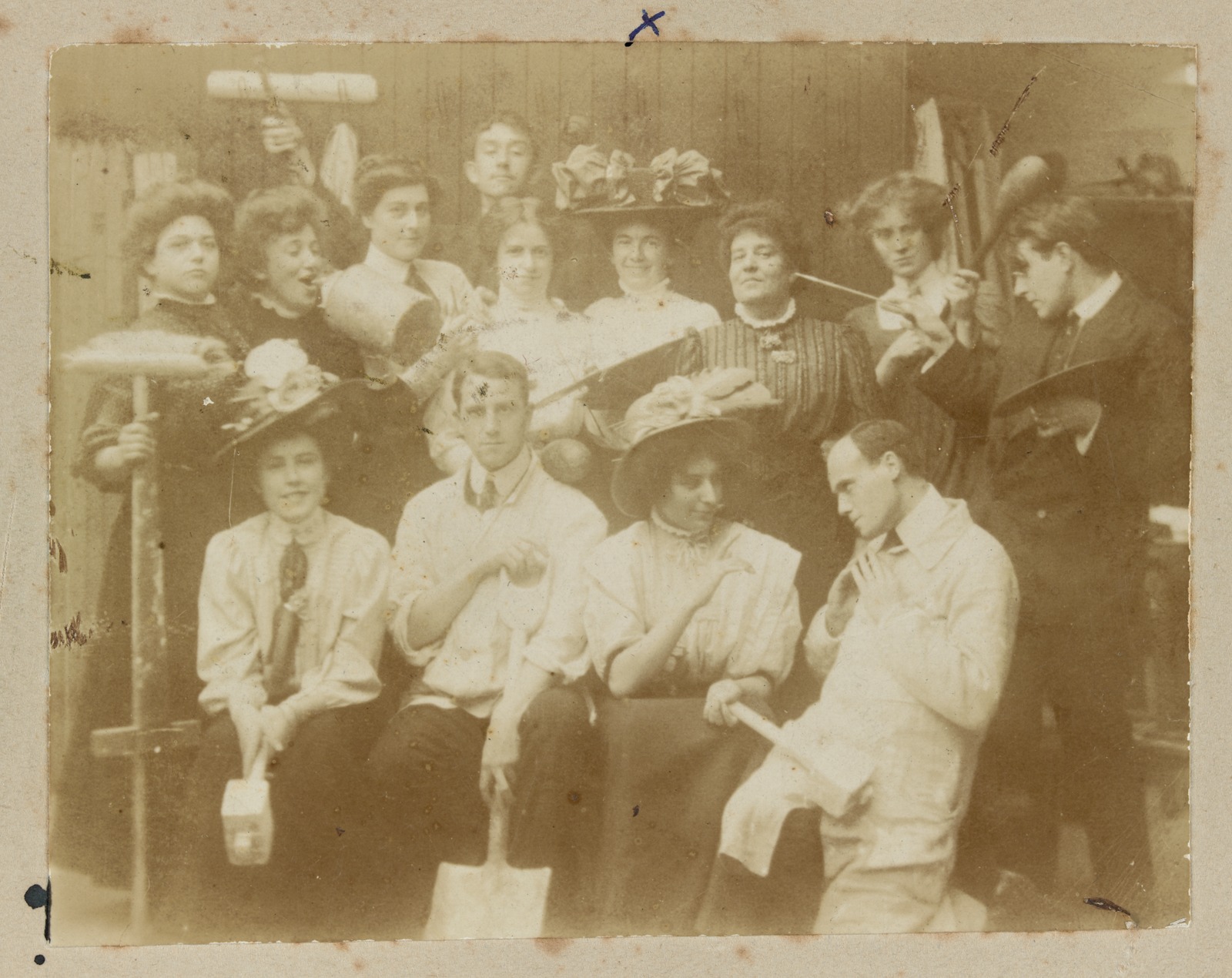
Students at the Gallery, including women circa 1900 -1910, Item: FL15657279, courtesy State Library of Victoria
On page 6 of this comprehensive description of the works on display:
Mr. H T. Squire
Mr. H T. Squire in an attractive little study, Under the Pier, manages the foamy surface of the waves skilfully. Good work is also exhibited by Mr. A. W. Pratt, Miss M. Holgate, Miss M. Morgan, Miss Mussett, Miss E. Williams, Miss Broyer, Miss Corbett, Miss E. N. Davies, Miss A. Guest, Miss B. A Harvey and Miss M. E. Harvey. Mr. H. T. Squire (1889, November 15). Table Talk (Melbourne, Vic. : 1885 - 1939), p. 6. Retrieved from http://nla.gov.au/nla.news-article147280433
The above refers to not only Harold but Mabel Eunice Harvey (born 1865 at Cauldfield) and her sister Beatrice Annie (born 1859 at the same place). This may be referring to Beatrice Annie or Helen Edith Harvey (born 1856), another Harvey girl who was also an Artist:
STUDENTS' EXHIBITION
AT THE NATIONAL GALLERY.
The sixth annual exhibition of paintings and drawings by the students of the National Gallery is held this year in the studios which occupy the upper floor of the north wing It is not so attractive, on the whole, as in former years partly because some of the post successful exhibitors on those occasions are at the present time pursuing their studies in Paris and partly because- two or three of the female students whose work has been generally much admired are on the sick list. The exhibition is weak In landscapes With the exception of Mr J L. Jones s "View on the Yarra near Heidelberg'', which contains some skilful passages, and his poetical sketch entitled ' After Sunset, there is nothing in this branch of art which one would wish to possess. Even Mr Allson, who has shown himself capable of better things, has allowed himself to he betrayed into the follies and delusions of the impressionists and his "Sunlight is a pain folly inane production On the other hand, the good quality of the painting in his portrait of a lady, and the men tonaus workmanship of his 'Children's Children', are entitled to recognition and praise. Excepting that the fore arm of the aged invalid seated in the chair is too long, the picture contains much to admire, the textures are painted with especial care, and no pains have been spared in the execution of the details Mr D Davies, in his 'From a Distant Land, shows us the interior of a boab hut, the solitary occupant of which has Just received a letter from the other side of the world, and is plunged into a brown study by its contents while the bearer of it ambles away from the door with a placid indifference to the emotions which he ii the means of exciting in the minds of those to whom he may be a messenger of joy or »or row The sentiment of Miss Munts' ' Memories of Long Ago " is of a kindred character A white haired old lady has been perusing a letter which recalls distant scenes and old familiar personages, and a shadow of pain passes over her face, which is full of expression and character, and skilfully mampalsted Mr Grant's "Cup Tipsters,' representing two street arabs, one of whom is tested on the pavement puffing away at a cigarette, while the other scrawls on a wall the names of Singapore and Bravo as the probable first and second horses in the great race looks like a transcript from actual life Miss Vales "Home Again," and her portrait of a father, show that she is making steady if not rapid progress in her profession Nor must the studies' of Miss A. Wedel, Miss M Holgate, and Mr, C Harcourt be passed over without a word of special praise, but the one strong feature of the exhibition is the still his department. Many of the examples of this kind of work are unusually good such tor example, as the Roses of Miss F Clarke the fruit pieces of Mis» ltlr»ine,and the composition» of Mis» F \ Davies Miss L Q Johnson, Miss Muntz, and Mr 1 Hansen As we have remarked on a former occasion, our female artists seem to be developing a special talent tor flower painting, and some of the best of the ex hibitors ore so young as to hold out the promise of important results hereafter
The charcoal drawings from the life and from the antique are extremely numerous, and those of Miss Grace Joel, Miss Harvey, and Miss Rennick, and of Messrs Ghee, Hansen, Pratt Quinn, Lawrence, and Wilsins will repay examination, but these names by no means exhaust the list of meritorious works of this class. THE STUDENTS' EXHIBITION AT THE NATIONAL GALLERY. (1889, November 14). The Argus (Melbourne, Vic. : 1848 - 1957), p. 11. Retrieved from http://nla.gov.au/nla.news-article8571567
Miss B. A. Harvey's ''In the Studio'' shows, careful drawing and natural colouring - Art and Artists. (1890, November 14). Table Talk (Melbourne, Vic. : 1885 - 1939), p. 17. Retrieved from http://nla.gov.au/nla.news-article147283437
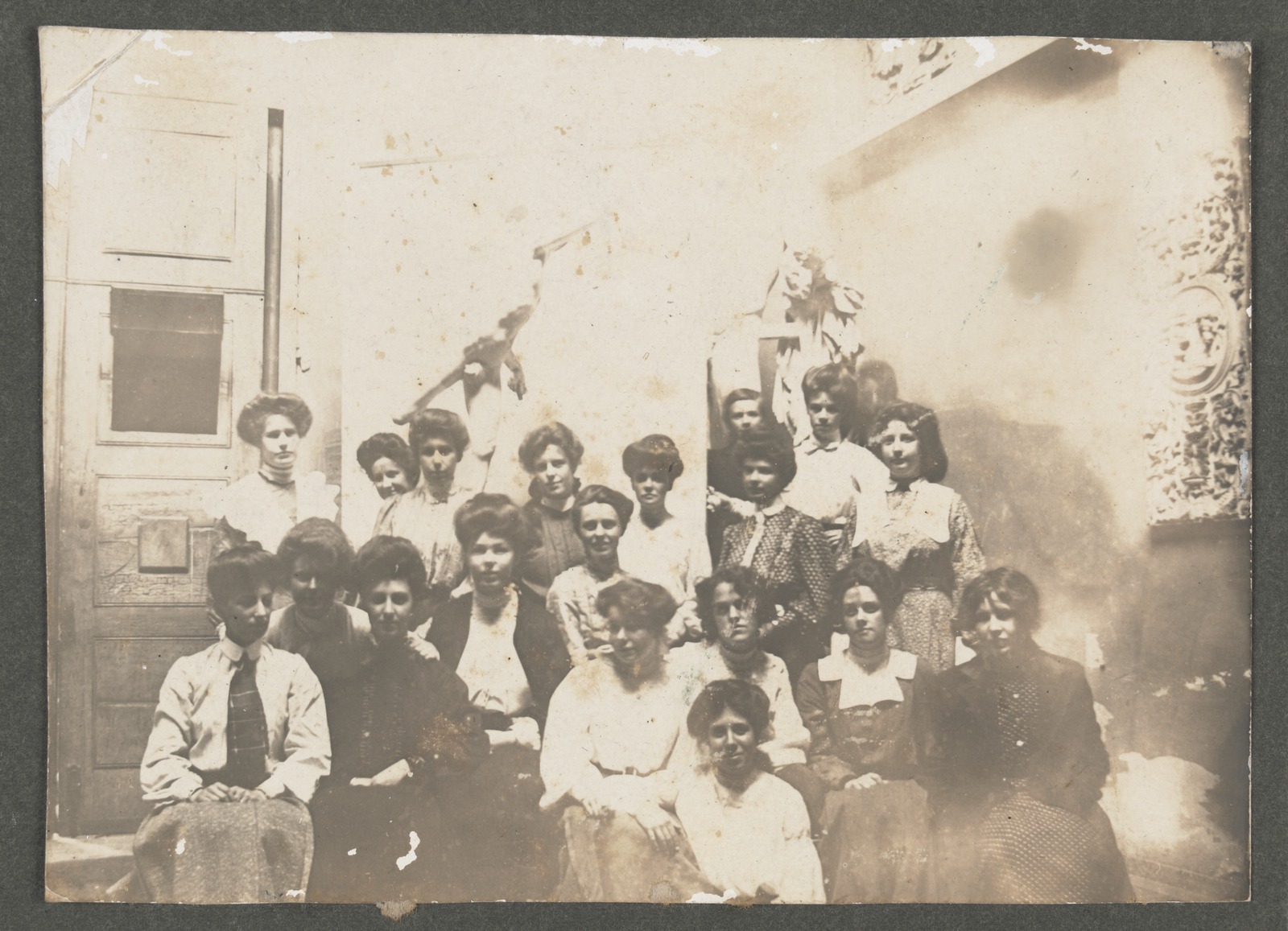
Students at the Gallery, including women circa 1900 1910, Item: FL15655304, courtesy State Library of Victoria
Art: The Exhibition at the National Gallery.
The eighth annual, exhibition of paintings by the students of the National Gallery was opened at the National Gallery, Swanston-street, on Tuesday, November, 17 by His Excellency the Governor.. In connection' with the students' work a competitive exhibition of pictures by Australian artists was also held, all the pictures being.hung in the gallery adjoining the plaster cast gallery. There are 186 works by students hung and all the productions show that the course of training is sound, and Mr. McCubbin is to be congratulated upon the progress his pupils have made. The life studies are good, especially those of heads, and in some instances the students show marked ability, in the treatment of the full figure. The paintings of still life show careful handling and correct colouring, and the flower paintings are of a specially right order of merit. Amongst the more ambitious paintings Mr.-J. W. Cairo's picture, " Schoolmates," - makes a pleasing group. Mr J. G. Grant's Strike Sufferings is a powerfully designed group of -a young workman seated-at a table with fills young wife standing in evident remonstrance with his persistence in refusing work, Mr.T, B. Hansen-is also successful J with his picture; Love or-Duty. Miss Harvey's painting of the interior of St. Paul's Cathedral is an elaborate production of considerable merit; Mr. Leon Polo's The Village Laundress shows much careful work, and gained the second prize of £10,; Mr. Guinnis Old Fossicker is a capital bit of work, and gained the first prize of £20. The landscapes are poor, most being the merest rough sketches, Mr. B. F, Gee's Evening at Malvern being the best.
The exhibition of pictures by Australian artists comprises some 54 oil paintings and 11 water-colors, mostly good, though it is to be regretted that such a few artists competed, and that so many old works should have been sent in. Mr. James Peele contributes many New Zealand landscapes, all of interest, and some specially meritorious, His coloring is good, his atmospheric effects skilful, and the subjects are unrivalled for natural grandeur. His best painting is Evening Shadows, Otira Gorge, a grand landscape ably treated. Signor Catani contributes his well-known painting, Faith, the idealised portrait of singularly impressive looking old Parson in the act of praying. The coloring and drawing are admirable and the more one examines the picture the more one recognises its sterling merit. He also shows a couple of attractive little landscape subjects, the Mail Coach, floundering through 'boggy bilpf road; and a view of the grounds in front- of the esplanade at Queenscliff. Mr. J. A. Turner exhibits several sketches of bush life, all, however; finished 'with" that mechanical exactitude typical of the "pot-boiler." Mr. Gordon Coutts' Washing Day, an old woman lading out clothes from a portable copper in a corner of a suburban backyard, is a clever powerfully painted picture showing much promise; of future improvement.. Signor Lburoiro's large canvases, Spring ' and Morning, attract much notice, Spring represents two young maidens in classic costumes standing by a blossoming almond or pear tree in an orchard where 'the grass is tall and studded with yellow flowers which his little boy in the back…Art and Artists. (1891, November 20).Table Talk (Melbourne, Vic. : 1885 - 1939), p. 6. Retrieved from http://nla.gov.au/nla.news-article147286102
A Teacher of Art
In October 1889, after six years of studying and working, Harold Tristram Squire was engaged to teach. This reflects in many ways the upbringing his father may have bestowed on Harold and his siblings - an attitude clearly inherited from his grandfather. Art may be a means to make a living as an Artist but for so many the path to being able to be an Artist must also be accompanied by a parallel path of teaching art, especially if you wish to eat and live somewhere and support a family:
School of Art and Design.—We are pleased to inform our readers that Miss Morphew has been successful in making arrangements with a competent teacher to take charge of the School of Arts. This gentleman, Mr H. T, Squire, has been a student at the National Gallery, Melbourne, for six years, and holds certificates of competency from Mr Follingsby and Mr M'Cubbin. He has had great experience in teaching in private classes and schools, and has received prizes and special mention for painting, and thoroughly understands perspective, mechanical, and architectural drawing. The Riverine Herald (1889, October 10). The Riverine Herald (Echuca, Vic. : Moama, NSW : 1869 - 1954; 1998 - 2002), p. 2. Retrieved from http://nla.gov.au/nla.news-article114672401
Echuca Mechanics' Institute
We have great pleasure in reporting that our School of Arts and Design has been very successfully conducted by Miss Morphew until October, when she accepted an appointment at Daylesford. Since then Mr H. T. Squire, a member of the Melbourne National Gallery, has taken the management of the school. There is a good attendance; and every prospect of an increase. Mr Lane has conducted the telegraphy clubs with very marked success. In October 11 candidates went up for telegraphy examination, and out of this number eight passed. This is a much higher percentage than any other examination which has been brought under the notice of the committee, and reflects the highest credit on Mr Lane as a painstaking, energetic teacher.' The committee desire to express their thanks to J. H. Abbott, Esq., for a donation of ten guineas, to Mr W. T. Webb, M.L.A., for £5, and to W. O. F. Illingworth, Esq, M.L.A., for five guineas. In conclusion the committee desire to express a hope that the general public will avail themselves of the many advantages of the library and reading rooms, and that our young people will also attend in larger numbers our school of arts and telegraphy class. ECHUCA MECHANICS' INSTITUTE. (1890, February 26). The Riverine Herald (Echuca, Vic. : Moama, NSW : 1869 - 1954; 1998 - 2002), p. 2. Retrieved from http://nla.gov.au/nla.news-article114676302
ORIGINAL CORRESPONDENCE.
Whilst this column is always open for the free discussion of public topics, we do not hold ourselves responsible for any opinions expressed by the writers of the letters.
OUR CHAMBER OF COMMERCE.
(to THE EDITOR OF THE RIVERINE HERALD.)
- Dear Sir,—I very respectfully beg to inform the members of the Chamber of Commerce that a technological committee connected with the Mechanics' Institute has been my work for a considerable time. The present committee are Messrs H. McKenzie, G. M. Gavel,, R. Mackay, and E. Homan. The Drawing Classes met last night, and will meet again this afternoon, and perhaps it would not be unadvisable for the members of the Chamber of Commerce to inspect the pupils' work, and the suitability of the room. The teacher, Mr Squire, will be happy to show what the pupils are learning, and will be thankful for any suggestions.
-Yours,
JOHN GOODCHILD.
(to THE EDITOR OF THE RIVERINE HERALD.)
Sir,—I notice in your report of the Echuca Chamber of Commerce that those gentlemen are trying to secure a room for the Technological School. Will you allow me to ask the meaning of this? I was for several years a member of the National Gallery, and I am the only representative of the Technological Commission in Echuca, and I am quite sure that the commission will not appoint another teacher here without acquainting me of the fact. At any rate if the gentlemen connected with Chamber of Commerce would like to inspect the room (late Millewa Club) where we work, I have no, doubt that they will find that there is no room better suited for drawing classes than the present one, which I need not say is the only one recognised by the Technological Commission, and, I may add, that it is my great desire to have a properly qualified architect appointed to teach drawing here, but we must bear in mind that the architectural and mechanical teachers can only teach their own subjects, necessitating two extra teachers.
I am, etc.,
H. T. SQUIRE,
Art Studio, Echuca. ORIGINAL CORRESPONDENCE. (1890, April 12). The Riverine Herald (Echuca, Vic. : Moama, NSW : 1869 - 1954; 1998 - 2002), p. 2. Retrieved from http://nla.gov.au/nla.news-article114677422
The Technological Commission was the brainchild of Samuel Henry Bindon's (1812-1879), Victorian minister of justice, judge and pioneer of technical education. His consistent conviction was the need to develop the agricultural and industrial wealth of the country, a concern born of the problems of his mining constituency and partly of his Irishman's hope for economic independence from England. Early in 1865 he moved for the establishment of a department under a minister for industries and instruction, but later had to withdraw the motion. He succeeded in passing special grants for industrial exhibitions, which led to the Melbourne Exhibition of 1866. His greatest single success was when he inspired and became chairman of the technological commission of 1869, Australia's first official organisation for technical education. His Industrial Instruction in Europe and Australia was published at Ballarat in 1872.
The Hon. Bindon resigned his seat in parliament in October 1868 but remained publicly active as a trustee of the Public Library, Museum and National Gallery of Victoria, as chairman of the Industrial and Technological Museums Committee, and as a member of the Acclimatisation Society of Victoria. [3.]
From March 1869, when Harold was not yet a year old:
TECHNOLOGICAL COMMISSION.
The following is the first progress report of the Technological Commission, addressed to His Excellency the Governor, and presented to Parliament last week :-
"We have the honour, as commissioners appointed for the purpose of promoting technological and industrial instruction, by lecture and otherwise, among the working-classes of Victoria, to submit the following progress report. We consider that lectures on industrial instruction should be periodically delivered in Melbourne and in other localities throughout the country, for the purpose of diffusing useful information on the most recent and approved scientific methods of conducting the practical details of such arts and manufactures as are at present, or may hereafter be, carried on with profit in Victoria; and we are engaged in making arrangements for the delivery of such lectures. Having regard to the special occupations and requirements of the people in different localities, we think the following classification suggests subjects which deserve primary and early consideration :-
"1. Animal products, considered in relation to manufactures, with the newest chemical and mechanical appliances in re-lation thereto. Under this head may be men- tioned the tanning and preparation of leather; the preservation of meats for exportation; the manufacture of glue, soap, candles; the preparation of wool, silk, &c.
"2. Vegetable products and their manufacturing uses, with the chemistry and machinery incidental thereto—for example, the preparation of fibre; the manufacture of paper; wine making; the theory and manage- ment of fermentation; distillation, brewing, &c.; the extraction of dyes, oils, and perfumes, &c.
"3. Mining and Mineral Products.—(a) Gold, its extraction from alluvium, quartz, and pyrites, making known the most recent European and American methods of washing, &c., and seizing; the construction of ma-chinery, and the most recent improvements; the chemistry incident to testing, smelting, amalgamating, and assaying, &c. (b) Coal, Shale, and Mineral Oils—with reference to their existence in this country, and economic value, &c. (c) Sulphur, in connexion with the manufacture of gunpowder, sulphuric acid, &c. (d) Clay and Sand.—Their uses in building, terracotta, pottery, glass-making &c. (e) Building Stones, &c.—The several varieties in the country, the supply, their quality, analysis, &c.
"4. Mechanics and machinery applied as hydraulics, in relation to the storage of water, irrigation, the construction of pumps, the sinking of wells, dams and reservoirs, &c.
"5. School of Design.—Considering how intimately connected the arts of drawing and designing are with manufactures and machinery, and that the mechanics and artisans of this country are without that assistance afforded both by the manufacturing capitalists and Governments of Europe, we are of opinion—(a) That a teacher of decorative drawing should be engaged to give instruc-tion to artisans and others, specially with reference to ornamental and decorative work as used in the arts and manufactures—(b) And also, that a teacher of mechanical drawing, with suitable appliances, be appointed to give instruction to artisans and others in architectural and engineering drawing and plan-making. We propose to consult the representatives of the several trades for the purpose of ascertaining how far such a project as the foregoing may be supported by the mechanical classes, and from some information already received we believe that the result will be satisfactory.
"6. Technological and Industrial Museum. —We believe that an institution of this sort, devoted to industry and art, is essential, if it is expected that the mechanics or artisans here are to compete with those in England—an institution where models of machinery, of new inventions and improvements, could be examined; where specifications of patents could be compared with the models explanatory of same; where samples of materials—mineral, vegetable, and animal— used in manufactures, could be arranged for permanent exhibition, and continually employed in illustrating the details of such manufactures; and thus the appliances of science to the material, to the processes, and machinery of manufacture exemplified in such a manner as would greatly contribute to industrial knowledge, and the increase of our producing and manufacturing power. We propose, so far as we are able, to collect samples and specimens for this purpose.
"We may remark that attention has been called to a Parliamentary paper, printed by order of the House of Commons, 2nd November, 1867, being a letter from Mr. Bernhard Samuelson, M.P., on technical education in various countries abroad, and addressed to the vice-president of the committee of the Privy Council. The information and suggestions contained in this paper no doubt will be of value considering the status of industrial instruction in the schools of this country. "In submitting this report so soon after our appointment, we have merely offered an opinion on some of the industrial requirements of this country, and have indicated the course of action which the commission proposes to itself to follow. In doing so, our object is to place at the disposal of the working classes some of the special educational aids which, by the liberality of the state, are given to other classes in this country, and by the munificence of individuals and Government assistance are afforded to the working classes in Europe; and, without any expectations that we can effect all that is desirable, we hope to make a beginning of a work which enlightened statesmen and practical men unite in thinking essential to the manufacturing progress of England, and which is yet more essential for manufacturing progress among us." TECHNOLOGICAL COMMISSION. (1869, March 13). The Australasian (Melbourne, Vic. : 1864 - 1946), p. 21. Retrieved from http://nla.gov.au/nla.news-article137563841
TECHNOLOGICAL COMMISSION.
A meeting of this commission was held at the Public Library, on Friday afternoon. There were present - Mr. W. M. K. Vale, chairman, and Messrs. Burtt and Blackett, M.L.A., and the secretary. The following report was read from the inspector of schools of design, Mr. S. H. Roberts :-
"The decision of the commission in reference to this year's examination of the pupils of the schools of design and the exhibition of their works, has been fully carried out. The examinations were largely attended, over 400 pupils having competed. The subjects of the examination were - The harmony and principles of colour, mechanical drawing, architectural details of construction, perspective geometry, and freehand drawing, from the model and from flat examples. The hours were so arranged that every pupil had an opportunity of competing in as many subjects as might be desired, and a large proportion of the papers were in the opinion of the examiners very carefully worked. The facilities so courteously granted by the Commissioner of Railways, to enable the teachers and pupils to visit the Exhibition, were availed of by most of the country schools. Cheques were received in payment, which were handed by me to the Railway department as the tickets were received. The exhibition at the Fitzroy Town-hall was not so well attended this year as on former occasions, owing to the inclemency of the weather during the five days it remained opened, and also to its not being held in so central a position as heretofore. The amount already received by the commission of this year's grant is £888 0s. 6d., leaving a balance to be received of £261 19s. 6d.; total, £1,150.
There have arrived per S.F. Gulf of Finland and Orient, 40 portfolios of examples of geometrical ornamental design, and mechanical drawings as used in the continental schools; 50 sets of Hulme's Marlborough drawing copies; and a selection of casts of ornament as used in the German and French Technological Schools - the whole forming a collection that will be very useful to the schools, and which are now ready for distribution. Since the last meeting, the hon. chair- man, with Mr Burtt and the secretary, have attended the annual meetings of the schools at Ballarat, Coburg, and Footscray. The number on the rolls of the schools for last quarter is 1,552 pupils, being the greatest number enrolled in one quarter since the commencement of the work of the commission in 1869. In compliance with a letter from the registrar-general, the statistics of the schools for the last year have been compiled, and for- warded to the Statist's Office, and copies of all programmes, circulars, and examination papers sent to the Public Library. Circulars have been issued (pursuant to the resolution of the commission), calling for designs based on the Australian flora, for a certificate of honourable mention, the competition to be confined to pupils of the schools, and the designs to be sent in by the 30th of June."
The report was received and adopted.
It was decided to send to England for 10 copies of Owen Jones's Grammar of Ornament, so that each school of art with over 50 mem-bers should have a copy on loan for reference and study. 100 of Redgrave's Manual of Colour are also to be ordered.TECHNOLOGICAL COMMISSION. (1882, June 10). The Argus (Melbourne, Vic. : 1848 - 1957), p. 7. Retrieved from http://nla.gov.au/nla.news-article11543364
Mechanics' Institutes are educational establishments and were originally formed to provide adult education, particularly in technical subjects, to working men. Similar organisation are sometimes simply called Institutes. As such, they were often funded by local industrialists on the grounds that they would ultimately benefit from having more knowledgeable and skilled employees (such philanthropy was shown by, among others, Robert Stephenson, James Nasmyth, John Davis Barnett and Joseph Whitworth). The Mechanics' Institutes were used as 'libraries' for the adult working class, and provided them with an alternative pastime to gambling and drinking in pubs. The world's first Mechanics' Institute was established in Edinburgh, Scotland, in October 1821 as the School of Arts of Edinburgh (later Heriot-Watt University), with the provision of technical education for working people and professionals. Its purpose was to "address societal needs by incorporating fundamental scientific thinking and research into engineering solutions". The school revolutionised access to education in science and technology for ordinary people.
A meeting of the Echuca Board of Advice was held in the Mayor's-room, Town Hall yesterday, when were present …. Amongst the correspondence was a letter from H. T. Squire, offering himself as teacher of drawing at the Echuca State School. The letter was received, it being decided to notify the department that there was no teacher of drawing at their schools in Echuca. ECHUCA BOARD OF ADVICE. (1890, May 9). The Riverine Herald (Echuca, Vic. : Moama, NSW : 1869 - 1954; 1998 - 2002), p. 2. Retrieved from http://nla.gov.au/nla.news-article114678114
School of Arts—It is notified that Mr H. T. Squire will not be able to attend his class to-day, having been called away to Melbourne on important business. The Riverine Herald (1890, August 7). The Riverine Herald (Echuca, Vic. : Moama, NSW : 1869 - 1954; 1998 - 2002), p. 2. Retrieved from http://nla.gov.au/nla.news-article114680359
In the Spring of 1890 Harold and Mabel were married at her family's' local church - the position he had secured as a visible 'means of support' allowing the union:
SQUIRE—HARVEY.—On the 1st inst., at St. Mary's, Caulfield, by the Rev. H. B. Macartney, Harold Tristram Squire, of Echuca, youngest son of T. E. P. Squire, Esq., Victorian Railways, to Mabel Eunice, youngest daughter of R. Harvey, Esq., Caulfield. Family Notices (1890, September 13). The Australasian (Melbourne, Vic. : 1864 - 1946), p. 46. Retrieved from http://nla.gov.au/nla.news-article139142576
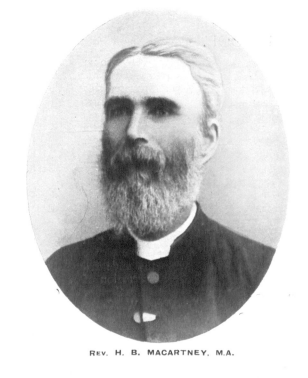

Rev. H. B. Macartney and St Marys Caulfield 1890
Harold lost his elder brother the next month, during the opening of an exhibition of his students paintings at Echuca - the first Family Notice has clearly been placed in the local paper by either Harold or Mabel - the second by his brothers' parents. That left Harold and his brother Francis William Tristram Squire as the only surviving children of the union - the rest were lost to the diseases and epidemics that raged through the population and where, in some suburbs, deaths were recorded on a day to day basis from Typus, Consumption and Typoid:
DEATH
Squire.—On the 21st October, Heighbridge House, Park-street, Parkville, Edward Tristram Prickett Squire, eldest son of Mr T. E. P. Squire, of Victorian Railways, and beloved brother of H. T. Squire, of Echuca. Advertising (1890, October 22). The Riverine Herald (Echuca, Vic. : Moama, NSW : 1869 - 1954; 1998 - 2002), p. 2. Retrieved from http://nla.gov.au/nla.news-article114682035
SQUIRE. —On the 21st inst., at 85 Park-street, Parkville, Edward T. P., the dearly beloved eldest son of T. E. P. Squire, Victorian Railways, aged 26 years and 11 months.
" Not dead ; but passed from sight,
To God in closer bond.
Not dead, but passed from night,
Into the light beyond ;
Not dead ; eternal, bright,
His morn of bliss hath dawned." Family Notices (1890, October 24). The Argus (Melbourne, Vic. : 1848 - 1957), p. 1. Retrieved from http://nla.gov.au/nla.news-article8445409
In the same month Harold and Mabel Squire held the first Exhibition of Students work for the Mechanics Institute, a practice that would continue throughout their tenure:
ECHUCA SCHOOL OF DESIGN AND DRAWING
Considerable interest was displayed yesterday afternoon by a large number of the inhabitants of Echuca, especially by the ladies, in the exhibition of paintings and drawings held in the town hall. It may be stated in passing that about a year ago it was decided by the committee of the Mechanics' Institute to better encourage classes for drawing and painting by the appointment of a highly qualified gentleman, and Mr Squire, accompanied by his wife, came here and undertook the duties. The result was apparent yesterday in the exhibition of the artistic work of the Indies of Echuca. The collection on view included drawings from round, flat, model round drawings, and ornamental, in addition to paintings of flowers from nature, landscapes, and life studies. The display was at once convincing that Echuca his in its midst an array of talent deserving of the highest encouragement, which should always be extended in the cultivation of the fine arts. It cannot be Said that the artistic works on view are perfect, but they give evidences of a refined and cultured taste. Nor, indeed, is it reasonable to expect, after only a year's training, that our ladies should be able to produce a Lydia Thompson " Boll Call," unless they should happen to be gifted with a divine genius in the arts of painting and drawing.' But this much we assert, very few districts in these colonies can boast of possessing a better array of art pupils than Mr. and Mrs. Squire have under their tuition, or a better display of drawings and paintings.
Mr G. G. Simpson, of Melbourne, who came here yesterday to judge the work, said in his report:—" I regret that the painting division was withdrawn from competition, as it would have given me great pleasure to have adjudicated upon it, seeing that there are several sections of the best type represented by good work—work of a better quality than is usual in our art schools of the colony." This is a flattering testimonial from so high an authority, and one we feel sure the art students of Echuca will be proud of. But, good as the work is—we refer to the paintings more especially—there is apparent one fault which the amateur is very prone to, and that is the extremely high toned coloring. To the artistic eye this is unpardonable, but then here we have allowances to make that raust cover a multitude of artistic sins of omission, and commission. Our art school is only a bantling, and therefore it would he unreasonable to expect that the pupils should be rapidly have succeeded in mastering the entire secrets of the art of painting, and know all at once how, when, and where to give a natural tint to their pictures. It is, however, one of the greatest mistakes i painter can make to lay the colour on too thick. It spoils a subject that otherwise would prove both attractive and effective. We do not say this in a fault-finding or carping spirit, but with an earnest desire that the ladies who have supplied Echuca with such testimonies of their talent should profit thereby. Any town would be proud of our collection of paintings, and having succeeded be well, it is the greater reason for an extended effort being made to excel in so beautiful and gifted an art.
At 4-30 yesterday his Worship the Mayor opened the exhibition, and gave the prizes to the successful competitors in the drawing sections. In our next issue we shall publish the prize list and the very pertinent remarks made by several gentlemen in connection with the opening of the exhibition. The Town Hall will be open all to-day and in the evening in order to afford the general public tin opportunity of witnessing the evidences of genius displayed by the ladies of Echuca. ECHUCA SCHOOL OF DESIGN AND DRAWING. (1890, October 18). The Riverine Herald (Echuca, Vic. : Moama, NSW : 1869 - 1954; 1998 - 2002), p. 2. Retrieved from http://nla.gov.au/nla.news-article114681949
OUR ART EXHIBITION.
In our last issue we made reference to the paintings and freehand drawings exhibited on Friday and Saturday at the Town Hall, Eohuca—an exhibition that does honor to our borough. The opening coremony, by his worship tho Mayor, attracted a considerable attendance of tho elite of tho town and suburbs, including the clergy representing eVery denomination. As no ono oxpcctcd to witness anything like such an exhibition as was presented, the visitors were something like the Queen of Sheba when she visited King Solomon of old, all feeling "That the half had not been told them."
The proceedings were commenced by Mr Goodchild, librarian of the Mechanics' Institute, reading Mr Simpson's report, and then making reference to the progress of the class. Mr and Mrs Squire, he said, had only been in Echuca twelve months, and all the artistic work on view had been executed under their supervision within that time, which all present, he felt sure, would admit was a great success. Before leaving Mr Simpson had told him that the work executed fully entitled the people of Echuca to some consideration, and if representations were made to the proper authorities, he felt sure that there would be little difficulty in obtaining a grant in aid of erecting a School of Arts and Design in the borough. He then called upon the Mayor to declare the exhibition open and distribute the prizes for freehand drawing to the successful competitors, stating that Mr Simpson had expressed himself disappointed at the withdrawal of the paintings from competition.
His Worship the Mayor said he thanked the committee of the Mechanics' Institute for the honor they had conferred upon him in requesting him to open this interesting exhibition of the artistic work of the ladies of Echuca. The general beauty of their labors must be surprising to everyone who took into consideration the short time that had been employed in producing the collection. When in Sandhurst, a few days ago, he visited the art Gallery there, and by way of contrast he felt sure that the pictures exhibited at Echuca were worthy of being hung alongside them. This spoke volumes in favor of the tuiton afforded by Mr Squire and his good lady, who, he was pleased to say, had made him a promise to give a larger and even a better exhibition next year. With such an array of talent in our midst it was not creditable to Echuca in not having a proper building as a School of Arts and Design. Efforts should be made to get one as soon as possible.
Mr Squire said the expression of the Mayor and the appreciation evinced by the public had more than repaid him for the efforts he had made. He had been assisted in the most generous manner by the people of Echuca, for which he thanked them. He hoped the school would continue to progress, and that next year's exhibition would show a marked improvement.
The Rev J. O. Johnstone, M.A., in moving a vote of thanks to Mr Squire, thanked him for the treat afforded in this exhibition. The cultivation of the fine arts was an admirable work, which had the influence of refinement and made our homes attractive, beautiful and enjoyable. Mr Mnriton, of Moama, seconded the motion, which was carried.
The Mayor then distributed the prizes, as follows:— senior, competition (over fourteen).. Model Drawing Round—(A). Model Drawing Figure.—Firse prize, Miss A. H. Gavel, No. 72 ; second prize, Miss E. Irwin. Drawing Round Ornamental.—(B). Ornamental Drawing —First prize. Miss A. H. ' Grave!; second prize. Miss E. Irwin. Drawing Flat.—(C). Freehand Drawing from the Flat. - First prize, Miss Manton ; second prize. Miss Thompson.
JUNIOR Drawing.—1st, Tottie Coates ; 2nd,' P. Brown ; 3rd, V. Fairthorna ; 3rd, 3ST. Milledge ; 3rd, T. Figgis. Drawing from Flat.—1st, Eva Earnshaw } 2nd, IDute Bowden ; 3rd, Lillie Gavel; 3rd, R\lf Woolcock ; 3rd, Edith Fosdyke.
Light refreshments were provided in the Mayor's room, and handed round to those present,
The following is a list of the. paintings and painters :— Water Colors—Fruit study from the flat, Miss Gavel. Panels from life—Flowers from nature* Westeria, Mrs White ; Westeria and wattle and peony> Miss Emma Pasoue ; wattle, Mrs White ; Arum lilies and wattle, Mrs LeGeyt; Westeria, Miss Kelly. Panels from copies—Cactus, Mrs LeGeyt; landscape, Miss Gavel ; landscape, Miss Tatham ; lilies and anemone, Miss Lily Taylor. Still life studies from nature—Groups by Miss Brodribb ; Miss E. Irwin, Miss M. Manton. Miss D. Taylor. Miss Thomson, Landscapo from copies-Rydal Water, Windermere, Furneas Abbey (Lancashire), on the Cornish Coast (2), Fountain'* Abbey after a storm (from memory) and Bolton Abbey, by Mrs Morphor, who also exhibits a portrait of her daughter, taken from life, Moonlight and sunset scenes, gathering water lillies, by Miss Anniu Y. Kelly. A wet evening, Devonshire and another lands* cupe, by Mrs LeGeyt ; A Swiss scene, by Mrs Davis, Moama ; A Moonlight scene in. Normanby, gathering water lillies, L:indsend and Newquay, by Miss L. Rotrers Salmon Fishing, and In the Fields, by Mrs A. W. H. White ; A Troub Stream and Close of Day, by Mias Tatham ; on the Black Spur, at Fornahaw, by Miss M. Winckworth. Miscellaneous Collection (from copies)— Portrait of a lady, Fisher Girl, The Dog it was that Died, Dog's Head,. Miss E. Fairthborne. The Roads, Greenwich, by Miss Rogers, Miss Gavel, and Miss Winckworth.
Two Seascapes—Miss Brodribb. Flowers from Nature—-Peach blossoms, Miss E. Pascoe ; will flowers, Mrs White ; Vatfcle, Miss Brodribb ; Wattle, Miss Gavel. Flowers From Copies—Blue and white' iris, water lil.'ies, and azaleas, by .Mrs Le Geyt ; clematis, Miss Gavel ; geraniums, anemones and Marguerites, Miss B, Brown ; jasmine by Misa Brodribb ; Mar« gneriros, Mrs Davies ; The Bitor Bit, by Miss Maud Simmie. Screen—Four panels of flowers from life, Miss E. Pascoe. Several small panels from copies, by Mrs Davies, and wattle from life by Miss Brodribb, were also on view.
Among the life studies there were some very interesting subjects that have attracted considerable attention. They include a string of onions; a square gin bottle, old hat, pipe and glass in a group; lamp and book ; basin and onions ; candle, soap, scrubbing brush and jar, and other works, painted by the Misses Brodribb, Manton, Taylor, Thomson, and Irwin. Mr Simpson's opinion of Mrs White's westuria and Miss P'lsciio'a wattle and poonioo aro magnificont Works of art, and that generally speaking the class has made a decided improvement in the quality and character of the black and white studios since Mr Squire has been instructor. During Saturday and in the evening the hall was visited by large numbers of the inhabitants, who displayed a warm interest in all the exhibits. OUR ART EXHIBITION. (1890, October 20). The Riverine Herald (Echuca, Vic. : Moama, NSW : 1869 - 1954; 1998 - 2002), p. 2. Retrieved from http://nla.gov.au/nla.news-article114681983
WANTED KNOWN.-That the School of Arts and Painting Classes open to day; also, that the Moama School of Arts opens tomorrow (Friday). H. T. SQUIRE. Advertising (1891, January 15). The Riverine Herald (Echuca, Vic. : Moama, NSW : 1869 - 1954; 1998 - 2002), p. 3. Retrieved from http://nla.gov.au/nla.news-article114684128
School Of ARTS and Design-The artistic talent of Echuca is rapidly coming to the fore since the advent of Mr and Mrs Squire to this town. The exhibition of drawings and paintings last November was a credit to Echuca, but there is every evidence at present of a larger collection being exhibited this November when Mr. Simpson will again come and adjudicate. There is a marked increase in the number of students. Last quarter there were 42. This quarter 60 are at work.
Through the efforts of Mrs. Squire a £29 scholarship will be competed for next November, which will entitle the successful competitor to a year's tuition at the National Art Gallery in Melbourne, and cover all art expenses. It is also announced that the Government intend supplementing all art scholarships won. This ought to inspire our art students to persevere' in their 'studies. We notice that Mr Squire has established a "Life 'Class';" and that; on Monday next he will start a third class. ' It is also stated that as soon as a Suitable piece of land has been selected the Government will erect a building for the use and convenience of the pupils of Echuca’s School of Arts and Design. The Riverine Herald (1891, July 18). The Riverine Herald (Echuca, Vic. : Moama, NSW : 1869 - 1954; 1998 - 2002), p. 2. Retrieved from http://nla.gov.au/nla.news-article114688913
ECHUCA.-A TOWN ON THE VICTORIAN BORDER.
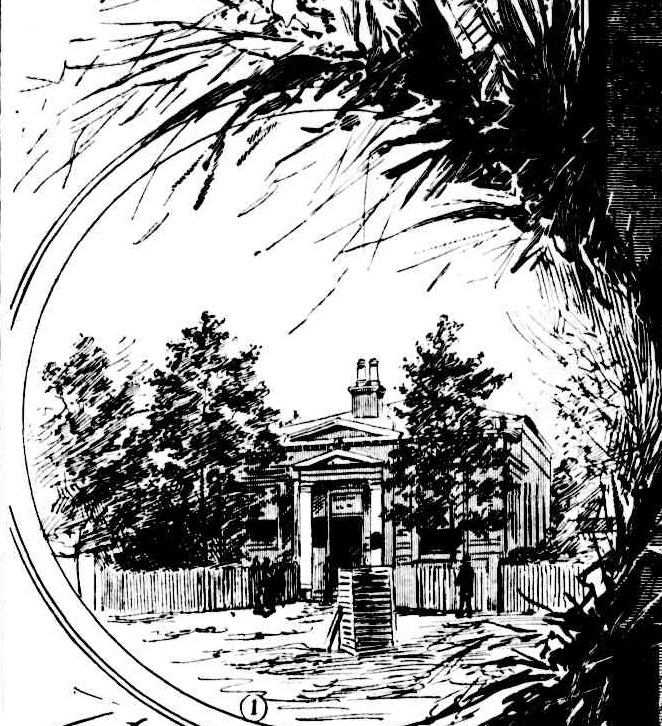
1. MECHANICS' INSTITUTE.
ECHUCA. (1891, November 21). Illustrated Sydney News (NSW : 1881 - 1894), p. 18. Retrieved from http://nla.gov.au/nla.news-article63617396
ECHUCA SCHOOL OF ARTS AND DESIGN.
The second annual exhibition of paintings and drawings of the pupils of the above school, will be opened in the Town Hall by His Worship the Mayor (Cr Nolan), at three o'clock this afternoon. During the whole of yesterday, Mr and Mrs Squires were busily engaged in hanging the pictures and panels, which number in the catalogue 137. In addition to these about 280 drawings will be on exhibition. The whole of the paintings have been locally executed by ladies of Echuca since October last, and they comprise a very beautiful collection. Among the local artists whose works will figure on the walls are Mesdames Davies, LeGeyt, and Morphet, and the Misses Brodribb, Brown, Coates, Chonhalb, Fairthorne (2), Farrall, Figgis, Fthy, Harpham, Irwin, Kelly (2), Limb, Morpliut, McBride, Milledge, Nolan, 1 Manton, Puacoe, Tftinah, Trebilco, Taylor and Watson.
In regard to the drawings, through Mr Simpson, the Government inspector, being unable to be present, there will be no ' judging, and consequently no presentation of prizes until after the drawings have been forwarded to Melbourne for adjudication. The exhibition is a great improvement on that of last year, and reflects great credit upon Mr and Mrs Squires and their pupils. It is also highly creditable to Echuca, and proves what a vast amount of artistic talent we have in this small community.
There are about 30 pupils in the painting class and 70 in the classes connected with the School of Arts and Design. We trust the public will appreciate the efforts being made in the town for the cultivation of the fine arts by attending largely at the opening and each evening during the week. The charge for admission will be 1s this afternoon, children 6d. Subsequent evenings the charge will be 1 for a adults and 3d for children, the proceeds of which is to be given in prizes to the junior classes. The pictures as a whole are very elaborately framed, which must, have made a great run on the ... of mouldings, and given the picture framers a good time of it. After the doors are thrown open to-day we believe the public will be able to congratulate Echuca on the artistic achievements of its ladies. ECHUCA SCHOOL OF ARTS AND DESIGN. (1891, November 18). The Riverine Herald (Echuca, Vic. : Moama, NSW : 1869 - 1954; 1998 - 2002), p. 2. Retrieved from http://nla.gov.au/nla.news-article114691794
This report from the following year shows H T Squire has been encouraging his students to paint outdoors, Plein air style rather than just sticking to the practice of then of making copies of celebrated works:
ECHUCA SCHOOL OF ARTS AND DESIGN.
There was a very good attendance at the Town Hall again last night to witness the fine display of paintings now on exhibition there, which have all been locally painted within the last year, under the able tuition of Mr and Mrs Squires. The exhibition will be again open this afternoon and evening, and also to-morrow. Below we give a brief criticism of each picture on view, the subjects, and the names of the students whose works are now claiming so much attention and admiration in the town : -
By Miss Brodribb, 1. Counter Lunch, (nature). Show a little timidity, but the work depicts earnestness. 2. Musio, Violin, Wine, etc. (nature.) This shows more strength. Very effective. Muoh admired. 3, Fruit and Wing. Exhibits a number of small defect?, but the coloring is good. 4. Sketch, (nature.) Scene in Echuca Park, which indicates leas timidity, and a good deal of try.
By Miss Brown, 0. Autumn, (oopy.) Very pretty, child, cat and cherries. It has many merits, but chief defect in lack of expression in child's face, but this is evidently a fault in copy. 6. At the Moor, (copy.) This picture was a general favorite. 7. Half Way. (copy.) 8. This Little Piggy Went to Mnrket, (copy.) A nice little pieoe of figure painting. 9. Clema'is. (copy.) Pretty, but a trifle defective. 10. On the Coast near Whitby, (cony.) This picture posses much merit, at the same time it is wanting in drawing.
By Miss Ooites. 12. Clematis, (copy.)1 Ordinary, little merit, 13. November Night, (copy.) This is a favwlte picture, and excellently execnted. 14. Sea Piece. (cony.1 This calls for no Bpeoial comment.
By Mrs Davies. 19. Luss Loch Lomond, (copy.) Exceedingly good, showing effectively in the foreground, but a trifle hard in the distance. 20. Soene on the Coast of Cornwall.' (copy.) 'This iB a nice bit of fresh Bea effect, being amazingly like a part of the Sydney coast. 21.- On the Marlow River, (copy.) The perspective is fine, but the work generally is only medium. 22. Harvest, (oopy.) 23 Seed Time, (copy.) A pretty little pair, Harvest being decidedly the best. 24. River Teith, Perthshire, (copy.) Evidently a bit of quiet, home work, and evening. 25. Fisher Girl, (copy.) This calls for no special comment. 26. Panel Lillies. (nature.) This is a really good picture taken from nature. 27. Panel Peach Blossom, (nature.) The same remark applies. 28. Apples (nature.) This is a ohoice gem, showing excellent work, and highly creditable. 29. Chrismas Lillies. (nature.) Another minting from nature, high in tone. 30. Peaches, (nature.) Two nice little peaches, appearing mellow, and well ripened.
By Miss Fairthorne. 31, Jessica, (copy.) A good copy, and posses much merit, good coloring. Deserves encouragement. 32. Jinolia. (copy.) Opinions divided as to real merit, but nevertheless a general favorite. 32. Mary Anderson. (copy.) Evidently taken from an inferior copy. 34. Perdita. (copy.) This is much better. 35. Screen, (copy.) Possesses some merit, but weak in various points. 36. Blood Hound, (copy.) This is good, but warranted not to bite. 37- An Angel Faoe. (copy.) This little picture could have been improved on by closer attention to copy.
By Miss Violet Fairthorne, 38. Lnch Anchrey. Considerable merit, work effective and attractive. 39. Scene, Tsle of Wight. This makes the companion pioture, and is equally as nicely executed. 40. Perdita. Bears traces of an early work, but possesses merit. 41. Sea Pieces. This may be termed a sweet little thing. 42. Ship in full Sail. Also nicely painted.
By Miss Blanche Farrall, 43. Still Life (nature.) Apples and wine. Coloring and shading good. Shows great promise. 44. Birds (nature.) Unfinished. 45. Pomegranates and Quinces (nature.) This iB a pretty bit of painting, all details being faithfully attended to. 46. Still Life. Unfinished.
By Miss Figgis, 48. Arum Lillies. Rather hastily worked. 49. Wistaria. This shows a great amount of character, nicely executed. 50. Farm by the Stream (copy.) An attractive picture, prettily tinted, the figures showing well. 51. Pansies (copy.) Colorings natural. 52. This Little Piggy Stayed at Home (copy.) The defect in this is a lack of drawing, which should be well studied in figure painting. 53. Jessica (copy.) This is Miss Figgis' masterpiece, and does her infinite credit. 54 Sea Piece (copy.) Signs of hasty work and apparently unfinished.
By Miss Fahy, 55. Water Lillies (copy ) 56. Roses (copy.) Pair of panels nicely executed from copies. 57. Glen Falloch (copy.) Scene pretty waterfall, which shows promise. 58. Hillside (copy.) Nice rural effect, and colors good. 60. Landscape (copy ) This is a very interesting picture, and shows great merit.
By Miss Harpham, 61. Still Life (nature,) This is a stable study- horse, collar, lantern, etc Shows earnest attention to details. 62 A Brown Stone Jug, effectively drawn and painted. 63. Runes (copy.) Pretty little subject. 64. Snowdrops (copy.) Same remark applies.
By Miss Irwin. 65 Fruit Study (nature.) The glass and claret jug excellent bit of work, in good color. High in tone. 06. Still Life (nature.) Cheese and ale, but not so good as the other.
By Miss Kelly, 67. Luss Loch Lomond (copy). A well executed picture, the shading good, and much admired. 68. Ben Lomond (copy). Shows good taste, and attention to details, creates admiration.
By Miss M. Kelly, 69, On the Way. (copy). Excellent work for so young a student. 70, At the Moor (copy). Nicely done, but not calling for special comment.
71, Glen Fallock (copy). This has a nice fresh effect, and shows great promise. 72, The Farm by the Stream (copy). This is a nice subject, but the work evidences too much haste.
By Miss LaGiyt, 73. To the Rescue (copy). The artist has here caught on, as the picture has been painted with a great deal of vigor, being fresh, strong, and bold in execution. 74, After the storm (copy) A faithful copy of the original. 75, Christmas Lillies (copy), (Equal'y as excellent. 76, Peaches nature). These have been painted from peaches grown in the exhibitor's own garden, and are beautifully executed. 77, Chrysanthemums (nature), 78! do, (nature}, 79 Japanese Anemones (nature). The coloring is highly effective, and the work true. 80, Scene in Echuca Park (nature). This little sketch from one of the lagoons in Echuca Park is very pleasing, and proves the artistic eye of the painter. 81, Lillies (nature), 82, Wattle Blossoms (nature), 83, Wistaria (nature), 84, Peach Blossom (nature), 85, Gladiolus (nature), 86, Arum Lillies (nature), and 87 Lillies (nature), This collection are all from nature, and well worthy of a minute inspection. 88, On the Coast of Mayne (copy). This bit of fresh sea work would almost make one feel cool on a hot day, so natural is the execution.
By Miss Lamb. 89, Sea Piece. -(copy). This exhibitor deserves encouragement, evidence of which is given in her first picture from ft copy. 90, Clematis (copy). Ordinary. 91, Passion Flower (nature). Considering this is the first work from nature it is a success, showing creditable study.
By Mrs Morphet, 92. For Now 'The Winter Surely' (copy.) Mrs Morphet is a contributor to the exhibition, and has large pictures on view. They are magnificently framed, and the subjects are attached in black letters on a gold ground. There is a lot of merit in this picture, and it has commanded a great deal of attention. The covering of snow is nicely painted, and altogether the gloom of winter is portrayed. 93. Autumn Shadows (copy.) This picture is excellent in perspective, well toned, and details carefully studied. 94. What Luck, Mates (original.) This is one of Mrs Morphets' conceptions, and does credit to her originality. The old gold fossickers appear to be very intent on their work, and the scene is characteristic of the search for alluvial gold. 95. Harvest Time (copy), and 98 An English Homestead. This pair is exceedingly English, and has a most effective appi tvrnnne.
By Miss Morphet, 97. Inf. This is the second painting of Miss Morphett's from nature, and does her credit 98. Arum lillies. Very exceptional as a first painting from nature, and displays much skill in the use of the brush.
By Miss McBride. 99. Westiria, This is a bit of good panel painting from nature. The student gives great promise. 100. On the Coast near Whitby, (copy.) This is a copy, and we must congratulate the young lady on her perseverance and success. 101. liillies. (nature.) In this the painter has made Another success. 102, Sea Piece, (copy.) There are several defects visible in this painting.
By Miss lililledge. 104. Snow, (copy.) A first attempt, and a great success for a a young girl. 105. Pansies. (copy,) Fairly good, but rather labored in style. 106. Barges on the Thames, (copy.) This is much better, being more freely worked.
By Miss Manton, 107. Peaches, A very good study from nature, showing earnest work. 108. Still Life. This is a avrary globe, showing the books and inkstand. It possesses much merit. 109. Quinces, Another study from nature, and exceedingly well depicted. 110. Roses. These are unfinished. but are being naturally formulated.
By Miss A, Nolan, 111. Onions. (nature.) This is the first attempt from nature, and possesses some merit. 112. Hillside Cottage. (copy.) A very pretty bit of work, carefully copied. 113. Sea Piece, (copy.) Not quite finished, but deserving of recognition.
By Miss Ada Nolan, 114. Off Berwick, (copy.) The word good must be applied to this picture, which is a well worked copy. 115. A Farm House, (copy.) Pleasing and in cooling colors. 116. Primroses, and 117, Pinnies, (copy) ; a nice little pair of pictures, and very attractive.
Miss Pascoe is again to the fore, and contributes a pretty collection. The ladies freely admit that her flowers are among some of the best of the show. Her lillies are not to be surpassed. By Miss Pascoe, 118. Grasses (copy), and 119, Castor Oil Plant. These are copies, and nicely painted. The grasses are on a light oak panel, and the castor oil plant on a walnut panel. 120, .Fox Gloves. This is from nature, but not so good as the lillies. 121, Cacti From nature, and effective in color. 122, Roses (nature). On a walnut panel, and strickingly effective, showing good breadth of treatment. 123, A Sketch (nature). This is a Gippsland forest scene, and well pair.ted. 124, The Yabbie Pond (nature). Here we have a local scene in the Echuca Park, which is nicely depicted. Miss Pascoe should continue her studies from life. 125, Dog's head (copy). A nice little picture, on a terra sotta plaque.
By Miss Tainsh,.126. Onions. Evidently the work of a beginner, who shows promise of something better. 127- Christmas Morning. This picture is unfinished, but shapes well.
By Miss Trebilco, 128. Still Life. This picture explains itself, and has been painted with the greatest attention to details. 129 Lamp, Book, Spectacles. A regular old historical group, nicely executed, and pleasing to the beholder.
By Miss Taylor, 130. Cheese. A look at this makes one hungry for the bar lunch, so perfectly are the details depicted, 131. Music Herein comes another violin, and the painter has not lost sight of a point to make it effective. 132. Fruit and Wine. This is the student's crowning picture, and does her credit. 133. Roses. A. good copy, well defined.
By Miss Watson, 134, 135, and 136, Leaves from the Cast. These three paintings are exceptional, as they are taken from later models. The student has proved successful, and with perseverance gives promise of much excellence in future. 137; Stiil Life. A few onions and a jug, standing on a kitchen table, which are well depicted. ECHUCA SCHOOL OF ARTS AND DESIGN. (1891, November 20). The Riverine Herald (Echuca, Vic. : Moama, NSW : 1869 - 1954; 1998 - 2002), p. 2. Retrieved from http://nla.gov.au/nla.news-article114691834
School of Arts Prizes—This evening, the prizes awarded the School of Arts pupils will be distributed in the Temperance Hall by the ex-Mayor, Cr Dobinson. The proceedings are to be enlivened with music, recitations, tableaux, and a Chinese opera. A charge of one shilling for the front seats and sixpence for the back will be made, and should there be any profit resulting, it will be given in aid of printing a new catalogue for the Mechanics' Institute. "We hope to sec a good attendance, because the fine arts ought to receive, the warmest encouragement. Mr and Mrs Squire have worked hard with their pupils and they deserve well of the public. The following are the principal prize takers :—Misses Daisy Taylor, Emma Irwin, A. Brodribb, Chisholm, E. Fairthorne ; Masters W. Watcon, C. Haigh, A. Mackay. The total prize takers number twenty-six. On the recommendation of Mr Simpson, the Government Art Examiner, the presentation of the L20 scholarship prize, collected by Mrs Squire, has been held over for a year. The Riverine Herald (1892, June 13). The Riverine Herald (Echuca, Vic. : Moama, NSW : 1869 - 1954; 1998 - 2002), p. 2. Retrieved from http://nla.gov.au/nla.news-article114699183
ECHUCA SCHOOL OF ARTS
MOAMA, Thursday
The New School of Arts is almost finished. It is a splendid building. ECHUCA SCHOOL OF ARTS. (1892, August 12). The Australian Star (Sydney, NSW : 1887 - 1909), p. 7 (SPECIAL EDITION). Retrieved from http://nla.gov.au/nla.news-article227285214
There are indications that the Squire family also engaged in farming pursuits to make a living. His brother Francis certainly had a farm further west and Harold and Mabel also pursued a rural life and the generation of income through what can be grown.
STRAYED to my Place, a Flock of Geese. If not claimed in three days will be sold to pay expenses. If owner of two Stag Bulls left in my paddocks, does not claim within seven days, will be sold to pay expenses.—H. T. Squire,'’Oaklea," Tatalia, Advertising (1893, April 13). The Riverine Herald (Echuca, Vic. : Moama, NSW : 1869 - 1954; 1998 - 2002), p. 3. Retrieved from http://nla.gov.au/nla.news-article114971541
This advertisement ran on a weekly basis throughout 1893 in The Riverine Herald. In 1891 a depression and strikes, as well as the forming of the Labor party, marked the economic times of Harold and Mabel's first year of marriage, making it necessary to supplement the income. By 1893, as can be read below, Australia was commencing a years long drought that would see many leave the land and the loss of stock as well as a home. The 1891 'recession' was followed by people losing their positions in June 1893, Harold among them, although he continued conducting classes at the Echuca School of Arts:
H. T. SQUIRE,
TEACHER OF DRAWING & PAINTING
UNDER GOVERNMENT.
PRIVATE Class Rooms, Market Buildings. Terms on Application. Advertising (1893, March 15). The Riverine Herald (Echuca, Vic. : Moama, NSW : 1869 - 1954; 1998 - 2002), p. 3. Retrieved from http://nla.gov.au/nla.news-article114970848
The retrenchment policy in the Education department, so far as it affects singing and drawing masters, was given effect to yesterday by the Executive Council, who passed an order dispensing with the services of the following ladies and gentlemen from the 30th June:
Singing— Class 1 : James C. Rennie, Wm. Perraton, Carolina S. Binns (Miss), Archibald G. Lang, Arthur T. Crook, Jas. Brightwell (jun.), Jas. J. Ryan, Wm. S. Matthews, Thos. J. Lamble, Chas. Blanchard, John 6. Lennox, John Hill, Thos. J. Buchan, Henry John Cutler, George W. Crisp, Joseph Oxlee, David J. Moutague, Andrew Millar, Arthur G. Piaster, Ohns. Tuckey, Robt. Weir. Glass 2: George E. Charlton,. Christian B. Coutts (Miss), Jas. Harvey, Robt. J. Henrno, Jas. E. Holmes, Charlotte D. Jnpp (Miss), Benjamin Hill, Lillio G. Jenkins (Miss), Sarali Lloyd (Miss), John Hackeroth, Mary Ellen Meares (Miss), John M'Lean, Henry Nelson, Frederick A. Polkinghorne, Maria Querie (Miss), Elizabeth Renob (Mrs), Maria Robb (Miss), Frank Hy- Thomas, James Stewart, John C. Vernon. Drawing- Class 1 : G. J. Kirkland, Frederick Taylor, Harry Hayward, Frederick J. C. Martell, John Sommers, Hugh J. Fogan, Frederick Foster, Olios. '1'. Radcliffe, Daniel Bartollo, Alexander Dnepol. Class 2 : Margaret F. E. Baskerville (Miss), Rudolph Conlon, Christian B. Coutts (Miss), James P. F. Hognu, Edith J. Hewetson (Miss), John James Leggatt, John Mackereth, Bertha Elizabeth Morfield (Miss), Wm. Rogers, Harold T. Squire, Laurence H. Smith, Marian Wood (Miss). NEWS OF THE DAY. (1893, June 7). The Age (Melbourne, Vic. : 1854 - 1954), p. 4. Retrieved from http://nla.gov.au/nla.news-article193428330
.jpg?timestamp=1586570951743)
.jpg?timestamp=1586570914556)
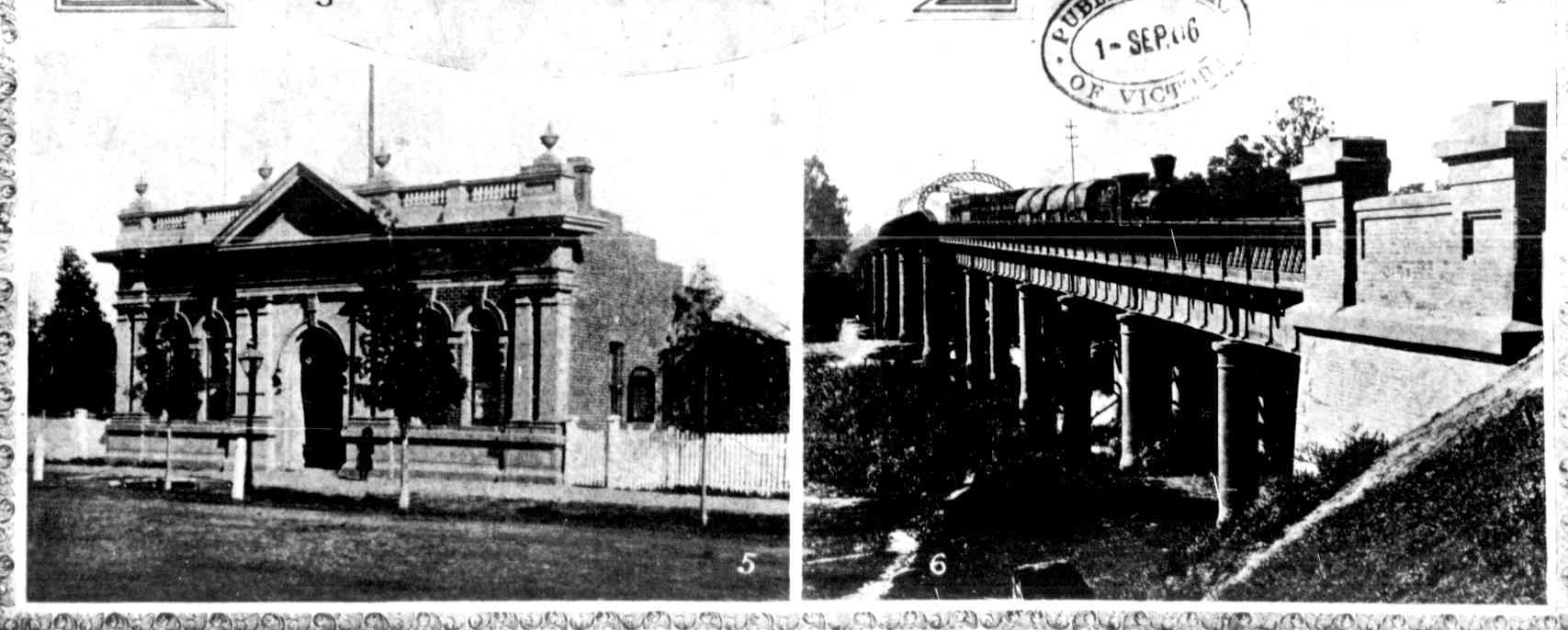
1. RIVER SCENE, MOAMA, WHARF IN THE DISTANCE. 2. POST-OFFICE 3. LOAD OF WOOD, CARTED FROM MESSRS. FALKINER AND SON'S, PEHRICOOTA STATION. 4. THE WATER-TOWER. 5. SCHOOL OF ARTS. 6. MURRAY BRIDGE, IN AND AROUND MOAMA. IN AND AROUND MOAMA. (1906, September 1). The Australasian (Melbourne, Vic. : 1864 - 1946), p. 29. Retrieved from http://nla.gov.au/nla.news-article139175129
Echuca School of Arts.
The opening of the exhibition of students' work in the Town Hall passed off with great eclat yesterday afternoon before a splendid attendance of the representative people of the district; who expressed themselves delighted with the remarkable progress made by the students during the past year, as evidenced by the splendid collection of paintings. Mr Squire is to be congratulated for his determination in endeavouring to persuade his students to take studies from nature and life, and most of the pictures reflect great credit both on the teacher and pupils. All the exhibits show that a thorough course of freehand drawing had been imparted to the students at the school, a fact which is often, unfortunately, not insisted on in art teaching.
About 3.30 p.m. the Mayor (Mr A. W. H. White) formally declared the exhibition open, and, in doing so, expressed great pleasure at the progress made by the pupils under Mr Squire, which/ he stated, was very apparent. He then distributed prizes to the following students Misses E. Irwin, Fairthorne, Lamb, D. Taylor, Maude Scott, A, Lewis, Sabeston, Tulloch, M. Fairthorne, K. Lamb, and Fleming, Mr W. Sanders, and Master Eohoris.
Amongst the best work from life were the following : — Miss Pascoe - St. Bernard dog "Wallace," Spoonbill, Crane and Black Swan ; Pigeons (two paintings) panel, Waratahs. Miss Fairthorne—Dog " Tobby’’ and dog " Wallace." Miss Broadribb—Famous sporting dog, "Cuckoo." Miss Barker—Arum Lillies. Miss Daisy Taylor—Doulton Ure. :
Those from copies worthy of mention were Miss Fairthorne—Italian Fruit Seller and The Lark. Miss Pascoe—Three panels—Swan, Heron and Cactii. Miss M.'Bride —Sea piece, " The Needles" " Loch Lomond." Miss Lamb—Two landscapes—"Evening," " Loch Lomond," and " Clematis." Miss Tainsh—Sunflowers and opal square of chrysanthemums. _ Miss V< Fairthorne—Three sea pieoes and landscape of stags. Miss Ferguson—Landscape, " Farmyard at Moontide," and two panels,. "Moonlight " and landscape. Miss Barker—Study of roses and landscape. Miss Ada Nolan—Two studies, Portia and Parisies. Miss Trebilco—" Autumn," landscape. Miss'Tulloch—Panel of " Azalias," and landscape). Miss Brodribb-Panel, "Autumn." Miss Drummond—Landscape and son piece. Miss Milledge—Panel, "Magnolia Larks," Two sea pieces. Miss K. Bowden—Landscapes, " Loch Lomond " and a snow scene.
There were also other works of merit by various students. Afternoon tea was very tastefully provided by the lady students, the surplus being thoughtfully sent to the various charitable institutions. The exhibition will only remain open until 12 o'clock to-day, instead of all the week, as was intended, on account of Mr Flannagan requiring the hall cleared for his speech night. Echuca School of Arts. (1893, December 14). The Riverine Herald (Echuca, Vic. : Moama, NSW : 1869 - 1954; 1998 - 2002), p. 2. Retrieved from http://nla.gov.au/nla.news-article114977166
ECHUCA SCHOOL OF ARTS.
It has frequently been urged to the disparagement of native born Victorians, as of English speaking people, generally,, that they show no love for the fine arts. There are many exceptional cases, however. We have State endowed art schools—schools which contribute much to the cultivation and development of the love of art. The Echuca School of Arts is one of many institutions of its kind that are distributed-over the colony, and are doing much towards the education, especially of the young in the alphabet of art. The curriculum of these schools provides for the teaching for a nominal fee of freehand drawing from plaster models and from life perspective, piano and solid geometry, including classes in crayon, pencil and charcoal. In Echuca the advantages of a school such as described are well availed of. The instructor (Mr. H. T. Squire') and his assistant (Miss Broadribb) have 28 pupils Under their tuition. Since last February the department has been very fortunate in securing some excellent rooms, admirably situated, as studios. They were got from, the Postal department, and are on the upper floor’ of the Post Office. Here the classes are well accommodated, and through the energy of the secretary of the school, Mr. R. B. Fletcher, are well supplied with studies in the shape of vary handsome plaster casts.' The facilities afforded pupils for travelling to and from the school are being largely availed of by the residents of the adjacent districts. Altogether the prospects for the future success of the school seem pretty well assured. It has had a chequered career up to the last twelve months, but under the present system of management the outlook is very promising. ECHUCA SCHOOL OF ARTS. (1894, July 25). The Bendigo Independent (Vic. : 1891 - 1918), p. 1. Retrieved from http://nla.gov.au/nla.news-article183315257
List of parcels at Echuca station Morphett, Batcher, Cox, Beckham, .... Tarrant, Connolly and Co.,Davies, Squire, ...White and Co. ECHUCA. (1894, July 9). The Bendigo Independent (Vic. : 1891 - 1918), p. 1. Retrieved from http://nla.gov.au/nla.news-article183314656
The School of Arts committee reported that a visit was paid to the school and everything was found satisfactory, the work being done reflecting great credit upon Mr Squires, the instructor. The books kept by Mr Fletcher since he had taken charge were examined and found in perfect order, and duly audited by Messrs Newson and Lind. ECHUCA. (1895, March 14). The Bendigo Independent (Vic. : 1891 - 1918), p. 1. Retrieved from http://nla.gov.au/nla.news-article194365996
Echuca School of Arts.
A large number of ladies and gentleman responded to the invitation of Mr and Mrs H. T. Squires, yesterday afternoon, to attend the fourth annual exhibition of paintings, freehand drawings, mouldings, etc., and the brief time spent in the school convinced all who know anything about art that the past '12 months has been a progressive one in connection with the work of the school. The exhibition was not confined to the past year's work solely, as a few pictures and drawings of other years wore on view, but the majority of the hangings, were productions of the year just closed. From a general point of view the work reflected much credit on the pupils, many of whom show indications of artistic ability of no mean order, whose taste and refinement were visible all over the rooms. The visitors were charmed with the work, the paintings especially being greatly admired, and many were agreeably surprised 'at such a display of local talent. That Mr Squires and his artistic wife have taken great pains to bestow on pupils the benefit of this knowledge is unmistakable, and they are entitled to high eulogium for the result as depicted yesterday afternoon.
The institution is one which should be encouraged by Echuca citizens, as, by reasonable co-portion with the principals, residents should have the pleasure of seeing the institution grow to such proportions that no one will be able to say that art is not one of the leading features of the town. When we look back to the inception of the school of arts and contrast it with its present state, we can but say that no resident is entitled to state it has not made rapid progress ; and it should be interesting to watch its developments in the future. After the visitors had inspected the ' paintings and drawings, afternoon tea was partaken of in the workroom, a most pleasant time being spent. The exhibition will be continued each afternoon as advertised, and in our next issue we will have something to say about the work exhibited. Echuca School of Arts. (1895, August 15). The Riverine Herald (Echuca, Vic. : Moama, NSW : 1869 - 1954; 1998 - 2002), p. 2. Retrieved from http://nla.gov.au/nla.news-article114983365
ECHUCA, Wednesday.
School of Art.—To-day a large gathering of residents assembled at the School of Art, which is under the able direction of Mr. and Mrs. H. T. Squires, and inspected the paintings and free hand drawing of mouldings. They were almost all this year's productions, and reflected much credit on the pupils, and showed the careful tuition by Mr. and Mrs. Squires. The visitors were regaled with afternoon tea, which was much enjoyed. OUR COUNTRY SERVICE. (1895, August 15). Bendigo Advertiser (Vic. : 1855 - 1918), p. 3. Retrieved from http://nla.gov.au/nla.news-article88956904
School of Art Exhibition.
Yesterday afternoon the exhibition of paintings, freehand drawings, etc., visa continued in the School of Art building, when a good attendance of ladies and E gentlemen were present, and they inspected the furious works with infinite, pleasure. The following are the principal paintings on view — Miss Figgis, "Italian Boy," panel, etc ; Miss Pascoe, panel of Wistaria, (very pretty), Poppies, Sunflowers, Cactus, Chrysanthemums, "Waratah," "The Like," ' Pigeons, Spoonbill Crane, Dog, " Wallace," (cleverly executed.) Miss Pascoe'a exhibits formed an exceedingly interesting feature of the exhibition. Miss A. Brodribb - Cuckoo, Peaches, panel of Virginian Creeper, panel Anemones and Bramble, Vine Leaves, and ; Still Nature, several of which were cleverly done. Mrs E. Lamb, net Fairthorne— "Toby," "The Lurk," "Italian Boy," Bull's Head, !',Desdemona,"... and other ' work, those enumerated showing taste and 1 skill. Mrs S. A. Fox, nee Fairthorne— ! Still Nature and landscape ; Miss Fairthorne, ' —Angel's Head. Miss M'Bride—Italian Boy, Seascape, Study of a Head, landscape, etec. ; Miss Tainsh—Panel Poppies, Bull's Head, panel Chrysanthemums, Wheat, Head, , etc. Miss Lamb—Two seascapes, " Loch Lomond," River Scene, etc. Miss Bowles , —" The First Flight," landscape, eto. Miss T Ferguson.—Panel " Moonlight," Waterfall, Moonlight Seascape, River Scene, etc. Miss Milledgo.—Larks, Magnolia, two seascapes, [ etc. Miss Leila Brown- Grapes, " Moonlight,' panel Chrysanthemums, Panel Opal Chrysanthemum*. Miss Manton—" Camping , on James River," Landscape., Oranges. Miss Drummond- Landscape, Still Nature (fruit; Poppies, "Playmates." Mrs Le Goyt— Panel Chrysanthemums, Daffodils. Miss Faye— Waterfall. Miss Chisholm—Panel Lillies. Miss Cunningham.—Still Nature (fruit), Snow Scene, Seascape, etc. The feature of the exhibition is a figure painting by Mr Squires, from life, which is a most artistic production. School of Art Exhibition. (1895, August 16). The Riverine Herald (Echuca, Vic. : Moama, NSW : 1869 - 1954; 1998 - 2002), p. 2. Retrieved from http://nla.gov.au/nla.news-article114983395
ECHUCA, Wednesday.
At the annual meeting of the mechanics' institute last evening, the balance sheet showed a credit balance of £33 17s. 4d. The balance sheet of the School of Arts showed a credit of £8 14a 3d. This is the first time for many years the balance has been on the right side of the ledger. THE CASE OF MRS. WALSHE. (1896, January 23). The Age (Melbourne, Vic. : 1854 - 1954), p. 6. Retrieved from http://nla.gov.au/nla.news-article193982302
Art Work.—Out of 16 pupils entered from the Echuca School of Art at the technical schools examinations, no less than 15 passed. OUR COUNTRY SERVICE. (1896, January 31). Bendigo Advertiser (Vic. : 1855 - 1918), p. 3. Retrieved from http://nla.gov.au/nla.news-article88902990
Later that same year the couple, the loss of the government income, coupled with a decrease in those able to afford fees, meant a change for HT Squire and Mabel:
The School of Arts report was received and adopted, showing that the resignation of Mr Squire as Art Instructor had been accepted and Mr Vize, of Bairnsdale, appointed as his successor. Echuca Mechanics Institute. (1896, October 15). The Riverine Herald (Echuca, Vic. : Moama, NSW : 1869 - 1954; 1998 - 2002), p. 2. Retrieved from http://nla.gov.au/nla.news-article114995522
THE appointment of Mr Frederick Vize as art instructor at the Echuca School of Mines emphasises the success that attended the training of Mr A. M. Cameron-now director of the Maryborough School of Mines--on the science side of the curriculum. Both gentlemen received the whole of their training at the Bairnsdale School of Mines. Till quite recently it was considered necessary in Victoria to import both science and art instructors from Home, and the cases in which natives filled such posts were comparatively race. Now, as we see, the very reverse is the case, and the colony, from out of her own intellectual resources, can supply the men who are best qualified to give guidance and direction to the aspirations of our youth along the paths that lead to the beautiful and the useful. The emoluments attached to these positions are, if not larish, at least respectably decent, and a fair present reward to any young man ambitious of climbing to the higher intellectual level of the devoted art or science student. In this particular case the Echuca art school can be congratulated upon having obtained as its master a sincere and honest lover of his art, one whom, it may be hoped, will find in the work of his new sphere a stimulus and an incentive to the development of a talent that is graceful and unmistakable.
Apropos of Mr Vize's appointment as art instructor of the Echuca School of Mines, it is interesting to know that since the establishment of the Bairnsdale school there are about 20 state school teachers who have been qualified, under Mr Soeebusen, to teach drawing in the state schools, and who have certificates of qualification to teach drawing. The success of Mr Ssehuson's classes has naturally the effect of attracting pupils, and there is reason to believe that before long the Bairnsdale school will launch another of its graduates upon the teaching world. The Advertiser. (1896, October 10). Bairnsdale Advertiser and Tambo and Omeo Chronicle (Vic. : 1882 - 1918), p. 2 (morning.). Retrieved from http://nla.gov.au/nla.news-article84827502
On October 21st, 1896, the Squires' are handing over to Mr. Vize and attend one of their last functions at the School of Arts - a farewell in their honour:
Gathering at the School of Arts.
Yesterday afternoon about forty past and present students assembled in one of the spacious apartments rented by the School of Arts from the postal authorities. The present lady students had provided what is generally known as an afternoon tea which was a very charming production, showing much artistic culinary Usto in the good things prepared. As well as the novelties in chinaware, the unfinished pictures of the students made the surroundings very pleasing. Miss L Brown, on behalf of the students, presented Mr and Mrs Squire with a beautiful piece of silver plate, with silver spoons. In making the presentation Miss Brown spoke of the many good qualities of the subjects of the presentation and particularly of the great interest Mr Squire always took in the progress of the students. Mr Squire said that artistic work was more in his line than making speeches, but at the same time he thanked the students for their great kindness in giving both himself and Mrs Squire such a valuable memento to take with him as a remembrance of their stay in Echuca. Mr C. Dowzer, on behalf of the students, spoke in eulogistic terms of Mr Squires general characteristic and as an art timelier, having that peculiar disposition, gentle yet firm in dealing with the many intricacies peculiar to art students. He also wished them prosperity and happiness in their new sphere of life. Miss Brodribb also spoke of Mr and Mrs Squire, and felt grieved at their departure. Mr C. Dowzer moved a hearty vote of thanks to the lady students for their excellent afternoon tea, which was seconded by Mr Vize, successor to Mr Squire, and carried by acclamation. Gathering at the School of Arts. (1896, October 22). The Riverine Herald (Echuca, Vic. : Moama, NSW : 1869 - 1954; 1998 - 2002), p. 2. Retrieved from http://nla.gov.au/nla.news-article114995706
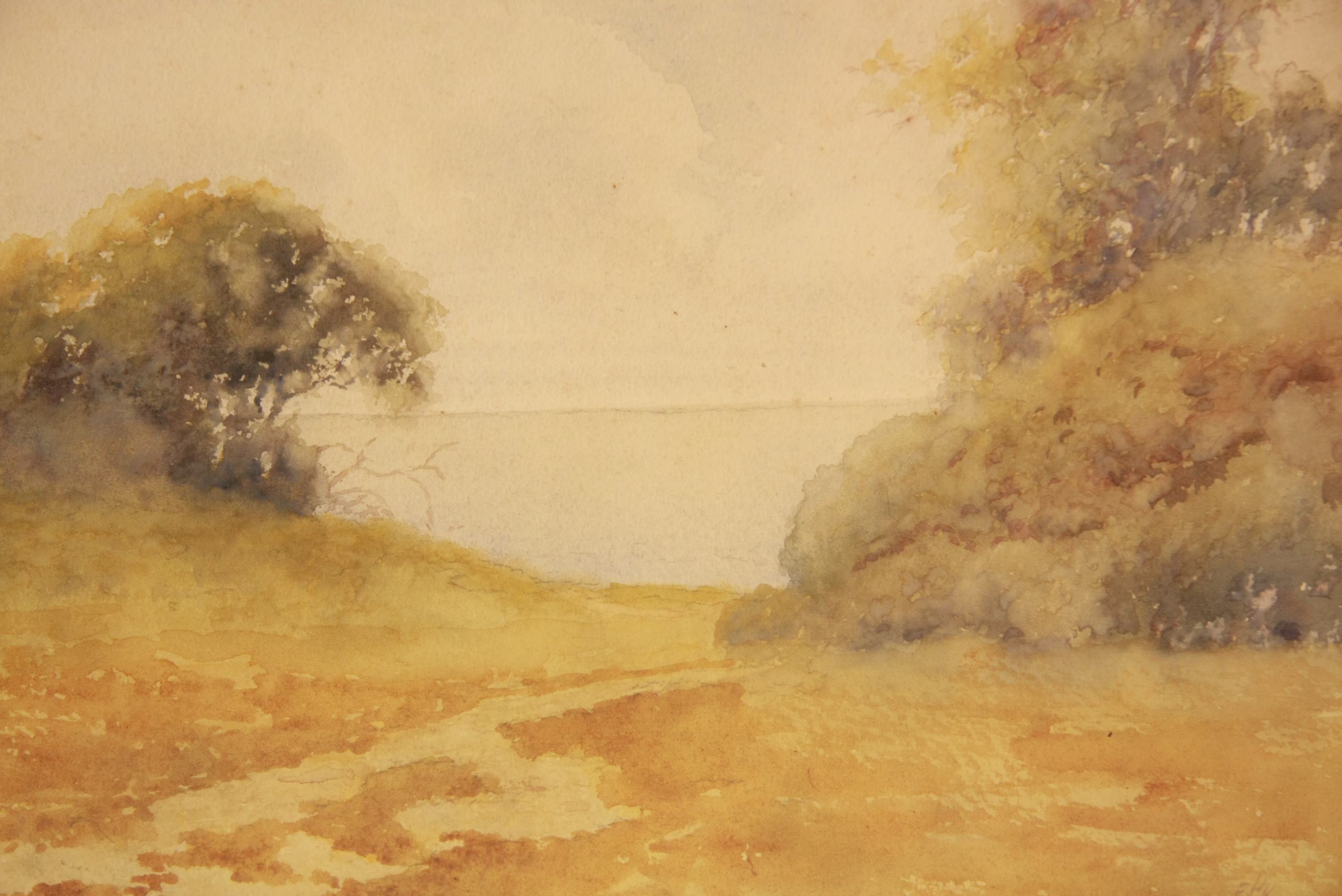
Painting by Frederick Parker Vize 'Beach Scrub' circa 1890
1895: An Invention on the Verge of a Drought
Teaching Art was not as lucrative, then, as it is, still, today. As well as advertising weekly for Drawing and Painting classes that could be taken, Mr. Squire tried to produce more income through a property called 'Oaklea'. This would hark back to his father's need to go into bankruptcy in 1861 due to debts caused by illness in the family and the tragic loss of daughters and his first wife, Alice's sister.
STRAYED to my Place, a Flock of Geese. If not claimed in three days will be sold to pay expenses. If owner of two Stag Bulls left in my paddocks, does not claim within seven days, will be sold to pay expenses.—H. T. Squire,'’Oaklea," Tatalia, Advertising (1893, April 13). The Riverine Herald (Echuca, Vic. : Moama, NSW : 1869 - 1954; 1998 - 2002), p. 3. Retrieved from http://nla.gov.au/nla.news-article114971541
Their 'new sphere of life' was at Strathbogie, near Benalla, where his mother and elder brother Francis had a farm. Strathbogie is a town in Victoria, located 187 kilometres north of Melbourne. It is in the Shire of Strathbogie local government area. At the 2016 census, Strathbogie and the surrounding area had a population of 304.
It was named after the Strathbogie pastoral run (1843) which was subdivided from the Seven Creeks run (1838) which is described in the entry on Euroa. The village is situated on a tableland that is flanked by hilly country to the south-west and the north-east. The whole land system is known as the Strathbogie Ranges, once a notorious hideout for the Kelly gang bushrangers. Strathbogie tableland was occupied by farm selectors in the 1870s. The Post Office opened on 10 July 1878. A school was built in 1879 and Methodist and Presbyterian churches were opened in 1884 and 1885. Dairy cattle and wool growing were the main industries.
In early 1895 Letters of Patent were lodged by H T Squire for:
A12568 1385 Application for Letters Patent for an invention by Harold Tristram Squire titled - Improvements in fruit-gathering rods and their attachments 1895 - 1895 7787383
A13150 11952 Specifications for registration of patent by Harold Tristram Squire titled - An improved fruit gatherer 1895 - 1895 9048310
A13151 11952 Application for registration of provisional patent by Harold Tristram Squire titled - An improved fruit gatherer 1895 - 1895
5.576. Harold Tristman Squire Tatatia, near Moama, N.S.W.—Improvements in fruit gathering rods and their attachments. 29th January. Government Gazette Notices (1895, February 12). New South Wales Government Gazette (Sydney, NSW : 1832 - 1900), p. 927. Retrieved from http://nla.gov.au/nla.news-article222221385
5,576. Harold Tristam Squire, Tatatia, near Moama, N.S.W.—Improvements in fruit gathering rods and their attachments. 29th January, 1895. Government Gazette Notices (1895, May 10). New South Wales Government Gazette (Sydney, NSW : 1832 - 1900), p. 3041. Retrieved from http://nla.gov.au/nla.news-article222223504
Even an article was run to introduce the idea to others, which points out the idea did not get a patent, and may even be referring to Francis Squire as the fruit-grower of 20 years standing:
A triple Ladder for Gathering Fruit.
As a fruit-grower of over twenty years' standing, I offer a suggestion (says a correspondent to the "Horticultural Journal") in the matter of ladders.
Plan.— Three ladders, each fastened at the top to a triangle made of three-quarter-Inch rod Iron by single hinges, screwed to the under aides of the ladders.
Material.— A rod of three-quarter-Inch iron, three feet long, to make the triangle. Six pieces of fiat bar iron three-quarters Inch wide, with eye or hinge made on one end. to be screwed to the under side of each ladder at the top by three or four screws. "Wood for the ladder aides, 1in. by 2/4ln. of the required length; rounds of ladder of ash or oak. The width between the sides 9in., to allow of two feet standing on the same round of the ladder at the same time. The hinges should be slipped on to the triangle, two to each side, before it Is Joined. The ladders may be any length, and for trees up to the ages of ten to fifteen years they are much better than double ladders, which must he made wide at the bottom to give steadiness, and where hush fruits are grown under it is difficult to find room for the two legs. A single ladder is altogether out of place in a young fruit plantation. The sides of the triple ladder should be parallel — In fact, might be narrower at the bottom If the ladders are planted for use where there Is an undergrowth, thus making it still easier to find a place for the three ladders.
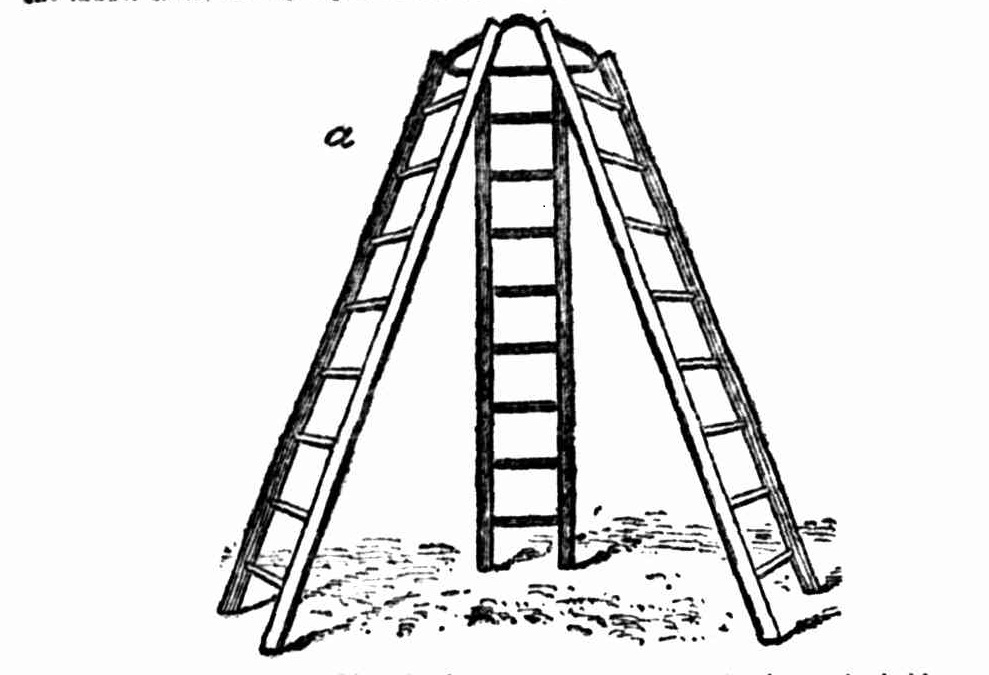
.jpg?timestamp=1583777447986)
I have sets of from eight to sixteen rounds each, and find that 1in. by 2 ½ in. deal is quite strong enough for the sides, and at that length and weight the ladders are quite portable and easy to be moved. It often happens that two women can gather on one set, when they can readily shift them round the tree, or in the shorter lengths a woman can freely work a set alone. I consider that one woman can gather as much fruit by this method as two or more can with single ladders. They are as firm at the top as the ground is, and are not affected by wind.
The ladder is not patented, and can be made by any carpenter or blacksmith. I have had them of all lengths in use for sixteen weeks, and use nothing else on my 40 acres of fruit, except, as the trees grow older, a single ladder for the tops. The illustration will assist readers who are desirous of constructing ladders on this system;— A, shows the ladder as set up for use and B, as laid down one ladder shown, illustrating the method of putting together. Of course, it will be understood that they are drawn together for carrying about. A Triple Ladder for Gathering Fruit. (1896, October 3). Weekly Times (Melbourne, Vic. : 1869 - 1954), p. 32. Retrieved from http://nla.gov.au/nla.news-article221201464
Unfortunately, this 'new enterprise' came on the verge of the Federation Drought, from 1895 to 1903, one of the worst in Australia’s history to the then years, if measured by the enormous stock losses it caused. Named for standing astride the hopeful Federation of Australia years, this drought ended squatter-dominated pastoralism in New South Wales and Queensland as bank foreclosures and the resumption of leases led to the partition of large stations for more intensive settlement and agricultural use.
Prior to this, many selectors took up ‘homestead’ blocks, in the Mallee region of North-Western Victoria in the 1870s and, in the Western Division of New South Wales (the western third of the state, comprising about 32.5 million hectares) from 1884. During this time railway lines were extended which enabled agricultural development, particularly wheat growing. Bores were sunk to access underground water, making it possible for stations to expand further into the semi-arid interior of New South Wales and central Queensland. In this period, most pastoralists carried high numbers of stock, even in low rainfall areas. Sheep were cheap, water was available and graziers relied on saltbush and other scrub to provide quality feed when overgrazing had destroyed the perennial grasses. Coupled with a rabbit plague, (rabbits had been introduced to Victoria in 1859), which dug up the roots of native bushes and ringbarked trees and shrubs, killing them, the combination of overstocking, drought and rabbits meant that pastoralists had nothing left to feed their livestock. In 1892 Australia had 106 million sheep, two-thirds of which were in the eastern states. By 1903 the national flock had almost halved to 54 million. The nation lost more than 40 per cent of its cattle over the same period, nearly three million in Queensland alone.
Drovers sought feed for hungry stock along travelling stock routes (known as the ‘long paddock’) or moved stock to pastures on the east coast and southern mountains where conditions were less dire. Droving took an immense toll on sheep and cattle with losses of up to 70 per cent recorded and, with the ground cover gone, exposed topsoil was lifted in huge dust storms, alike those seen over the past year, again.
Pastoralists were overwhelmed by the debt they incurred buying feed, controlling rabbits and repairing infrastructure damaged by dust storms. Banks foreclosed on some stations and many graziers walked off their land. Some five million acres of leasehold country in the NSW Western Division was reported to have been abandoned between 1891 and 1901.
In 1900 Harold's father passed away - his mother being stated to be a resident on his brother Francis's property in Strathbogie:
SQUIRE.—On the 12th March, at private hospital, Tristram E. P. Squire late of Victorian Railways beloved husband of Alice M. Squire, of Strathbogie, in his 70th year. Family Notices (1900, March 13).The Argus (Melbourne, Vic. : 1848 - 1957), p. 1. Retrieved from http://nla.gov.au/nla.news-article9052288
SQUIRE.—The Friends of the late Mr. TRISTRAM E. P. SQUIRE (late of the Victorian Railways) are respectfully invited to follow his remains to the place of interment, Melbourne General Cemetery. The funeral will leave 1 Latrobe-street, Melbourne, THIS DAY (Tuesday, 13th inst), at 3 o'clock. Family Notices (1900, March 13). The Argus (Melbourne, Vic. : 1848 - 1957), p. 1. Retrieved from http://nla.gov.au/nla.news-article9052290
Born in Williamstown, Victoria on September 8th 1866 to Tristram Edward Pitfield Squire and Alice Mary Prickett, Francis William Tristram Squire married Lucy Bertha Jackson (1876-1969 – born at Beaufort, Victoria – father Henry Hall Jackson, a farmer – also a civil engineer, mother Betty Susan nee Shepherd). Francis passed away in December 1945 in Creswick, Victoria, Australia. They married in 1906. Her parents married in 1856:
On the 27th inst., at St. Luke's Church, Emerald Hill by the Rev. A. J. McCausland, Henry Hall Jackson, to Miss Shepherd. Family Notices (1856, March 29). The Argus (Melbourne, Vic. : 1848 - 1957), p. 6. Retrieved from http://nla.gov.au/nla.news-article4834185
SQUIRE—JACKSON.—On the 11th April, at St. John's, Melbourne, by the Rev. C. P. Thomas, Francis W. T. Squire, Strathbogie, to Lucy B., youngest daughter of the late H. H. Jackson, Beaufort. Family Notices (1906, May 15). The Argus (Melbourne, Vic. : 1848 - 1957), p. 1. Retrieved from http://nla.gov.au/nla.news-article10007903
Henry Hall Jackson passed away at Strathbogie in 1903
JACKSON.—On the 19th February, at Strathbogie, H. H. Jackson, C. E., late of Beaufort, aged 70 years. Family Notices (1903, February 21). The Argus (Melbourne, Vic. : 1848 - 1957), p. 9. Retrieved from http://nla.gov.au/nla.news-article9819902
‘Betty’ Susan Jackson died in Beaufort in 1900
JACKSON.—On the 6th September, at Beaufort, suddenly, Rosa, the beloved wife of H. H. Jackson, C.E., aged 66 years. Family Notices (1900, September 10). The Argus (Melbourne, Vic. : 1848 - 1957), p. 1. Retrieved from http://nla.gov.au/nla.news-article9555249
Francis Squire, farmer, was running sheep on his land holdings, a 1909 report in the local paper stating he and others from Strathbogie were making good money from their wool.
ALLEGED CARELESS USE OF FIRE.
In J. Home, contractor, and six employes were charged by the police with lighting fires at Strathbogie without taking proper precautions to prevent damage to property. Senior- Constable Crisfield prosecuted, Mr. W. Leslie Park for the defence.
Francis Squire, farmer, Strathbogie, deposed that he has been lessee of the land in question, and had given it up when it was to be "scrubbed. His land adjoined it. 'Saw a fire on the land. There was no notice given of intention to light a fire. Saw several of defendants trying to put it out.' EUROA POLICE COURT. (1905, March 24). Euroa Advertiser (Vic. : 1884 - 1920), p. 4. Retrieved from http://nla.gov.au/nla.news-article65623421
From F. W. T. Squire, Strathbogie, drawing attention to the state of two culverts on the road between Taylor's and Einsporn's; near Price's, Strathbogie.- held over for a month. EUROA SHIRE COUNCIL. (1907, May 31). Euroa Advertiser (Vic. : 1884 - 1920), p. 5. Retrieved from http://nla.gov.au/nla.news-article65617499
Francis left the district in 1912, years after his brother Harold had departed, and returned to Melbourne:
STRATHBOGIE ….Mr. Squires, one of our most esteemed residents, has sold his property and is leaving the district after a long residence amongst us. Mr. and Mrs. Squires will be greatly missed by their friends here and all will wish them prosperity in their new sphere. DISTRICT NEWS. (1912, March 15). Euroa Advertiser (Vic. : 1884 - 1920), p. 4. Retrieved from http://nla.gov.au/nla.news-article65637096
While further west Harold was clearly still working as an Artist:
There is at present on exhibition at the Bernard Gallery, ColIins-street, an excellent specimen of classic art, entitled "Dawn,"' from the brush of Mr. H. T. Squire, who holds a prominent place amongst local portrait painters. The coming of day is represented by a female figure of great beauty, dispelling the clouds of night. There is a most skillfully obtained air of buoyancy about the whole picture and altogether the artist has been very happy in the handling of the composition and colour harmony. The correct and grateful modelling of the limbs, the filmy drapery and early—morning, fleecy clouds combine to make a most charming effect. Mr. Squire is to be congratulated upon his clever piece of work, which should ensure his future effort an appreciative welcome. CLIVEDEN “AT HOME.” (1903, May 7).Punch (Melbourne, Vic. : 1900 - 1918; 1925), p. 23. Retrieved from http://nla.gov.au/nla.news-article175399826
PAINTING.-Mr. H. T. Squires, Artist, who is well known in Benalla and district, has a very fine picture on view in the Bernard Gallery, regarding which Melbourne 'Punch' says:— 'There is at present on exhibition at the Bernard Gallery, Collins-street, an excellent specimen of classic art, entitled ' Dawn,' from the brush of Mr. H, T. Squires, who holds a prominent place Amongst local portrait painters. The coming of day is represented by a female figure of great beauty, dispelling the clouds of night. There is a most skilfully observed air of buoyancy about the whole picture, And Altogether the artist has been very happy in the handling of the composition and color harmony. The correct and graceful modelling of the limbs, the filmy drapery, and early morning fleecy clouds, combine to make a most charming effect. Mr. Squires is to be congratulated upon his clever piece of work, which should ensure his future efforts an appreciative welcome.' THE FEDERAL CAPITAL. (1903, July 28).Benalla Standard (Vic. : 1901 - 1925), p. 2. Retrieved from http://nla.gov.au/nla.news-article155248372
The H Tristram and Mabel Squire trail disappears for a few months after July 1903, during which, via later reports, it seems Mr. Squire was on a boat on the Murray river, painting. By the Spring of 1905 it is apparent they have been in Hobart, Tasmania for a while and here it is Mabel who appears most among published advertisements and records for undertaking a few ventures. The first is:
LE C T U R E TO WIVES, MOTHERS, DAUGHTERS, On "HEALTH AND VIAVI," the Common-sense Home Treatment, at VICTORIA-HALL, VICTORIA-ST., On THURSDAY, SEPT. 7, at 8 p.m. Admission-Free. Lecturer: MRS. SQUIRE. Advertising (1905, September 2). The Mercury (Hobart, Tas. : 1860 - 1954), p. 5. Retrieved from http://nla.gov.au/nla.news-article12316962
LECTURE To-Night to Ladies on HEALTH and VIAVI, the Natural Home Treatment, at Victoria-hall, at 8 o'clock. Lecturer: MRS. SQUIRE. Admission-Free. Advertising (1905, October 12). The Mercury (Hobart, Tas. : 1860 - 1954), p. 5. Retrieved from http://nla.gov.au/nla.news-article12321966
LECTURE TO-NIGHT TO LADIES on VIAVI (the Natural Treatment) and 'HEALTH at the VICTORIA-HALL, at 8 o'clock. Lecturer, Mrs. SQUIRE. Free. Advertising (1905, December 7). The Mercury (Hobart, Tas. : 1860 - 1954), p. 5. Retrieved from http://nla.gov.au/nla.news-article12328850
Online versions of this product and its work: 'Viavi hygiene, explaining the natural principles upon which ... [Law, Hartland] [from old catalog]' https://babel.hathitrust.org/cgi/pt?id=loc.ark:/13960/t12n67z3d&view=1up&seq=9
LECTURE-How to secure good health by rational natural means. Viavi Health School, Bank of Australasia Chambers. Thursday Evening, 8 o'clock. Mrs. M. E. Squire, Manager. Advertising (1906, November 15). The Mercury (Hobart, Tas. : 1860 - 1954), p. 5. Retrieved from http://nla.gov.au/nla.news-article12826455
In November 1907 Mrs. Squire is listed as an agent or place to purchase The Mercury newspaper from as a Town agent, giving an Elizabeth Street, Hobart address - as well as advertisements for the Viavi system. What is most poignant about these advertisements is, if you read the work/book linked to above, the focus on women having difficulties falling pregnant, or miscarrying - and the 'blame' being placed on them in the tone of that literature. An exhaustive search of all the Birth registrations for all the Australian states did not find any children being born to H T and Mabel Eunice Squire, although it is clear, reading of their work among young people and encouraging them as Artists, that children would have been very welcome.
HEALTH LECTURE. Viavi Rooms, Bank Australasia Chambers, Wed., June 12, at 3 p.m. Mrs, M. E. Squire. Advertising (1907, June 12). The Mercury (Hobart, Tas. : 1860 - 1954), p. 5. Retrieved from http://nla.gov.au/nla.news-article9924967
By mid 1908 Mabel is about to open a new business with the local Hobart papers also lending an insight into what her husband was up to - this also shows the shift to using the name H Tristram Squire instead of Harold Squire or H T Squire:
The Critic has never said a word in dispraise of ladies -intellectual, but has always sighed for the apotheosis of the cook—or rather, of the housewife. Happily there are abundant indications that the domesticated woman is coming out of that obscurity into which, for a time, the young person of the competitive examination drove her.
On Wednesday morning, the writer had chat with Mrs. Tristram Squire, Principal of the Alexandra College of Domestic Economy, which is to be born next week in the basement of the National Mutuals’ Macquarie street building. But on Wednesday Mrs. Squire was in her office, which is on the ground floor of Mr Pottenger’s pile.
And a very pretty lounge that office is, though, to the uncultured, the pictures which adorn its walls suggest anything rather than lectures on the culinary art, dressmaking, and domestic economy.
The pictures, by the way, are for the most part the work of Mr Squire, an artist with whose handwork a number of Hobart folk are familiar. His work is dainty and highly finished. He delights in moonlight effects, and once upon a time fitted up a boat in which he navigated the Murray, painting its beauty spots by moonlight. The boat was fitted with a light so shaded that its rays fell on the canvas, but not on the waters or the banks of the river.
But now Mr Squire is away on the N.W. Coast, at Sprent, doing clerical work in a scattered parish. He teaches art, and his classes are very big, naturally so, for he accepts no fees. Perhaps Mr Squire is a follower of Wagner, of the “Simple Life’’.
At any rate, he is said to be beguiling the monotony of the lay reader’s life by doing the field work of an ailing parishioner, with sick wife and children. The parson relieves the layman of his work in the potato field, that the parishioner may be at the bedside of his sick ones.
This, however, is a digression. The Alexandra College has a staff which includes two or three ladies recently from England, with Hobartians well known as Misses Searle, Susman, and Kennedy.
And for the incidental lectures, Mrs. Squires has secured the services of quite a formidable phalanx of lecturers. The Premier has placed the eloquence and the learning of the experts at the services of the College. Experts and knowledge of domestic economy the leader of the Opposition has none, but such as he has, he is giving, and the “ such ” takes the form of a talk on politics.
But of the lecturers, the chief will be the Bishop of Tasmania, who is to favor the students with a short course to open with—a talk on cookery. It isn’t every day that the World and His Wife hear a Right Rev. Prelate discoursing on the culinary art.
Yet, it’s a fine theme. There is the historic side. First, the savage days when men learnt to cook, let us hope in less costly fashion than Charles Lamb fables in his immortal Essay on Roast Port.
Then the classic days, with the almost incredible extravagance of the nights when Lucullus supped with Lucullus, on through the times of Brillat-Savann and the gourmets to our own days, when, one is told, quite young men and women, the sons and daughters of successful money rubbers, are as devoted to the pleasures of the table as were the dotards of more virile periods.
There is the poetical side, suggested by the vegetarian cult, and in its turn suggesting Shelly’s verse And that, of course, leads to the physiological and psycholical aspects of the question. The effects of a man’s eatings and drinkings on his physical, mental, and spiritual development, and these will take one into the most matter-of-fact medical prosing, or into the finest spun theories of the Theosophists. And on all these matters, be it noted, the Bishop may talk ever so wisely, even though gruel prepared by torn for a dying layman might be “ pasty as that made by Hood’s poor little governess on the Rhine.
Mark you, the Critic does not assert that Dr. Mercer’s gruel would be paste, or his cake dough. Dr. Mercer talks, writes, plays, paints, goes to the ant and considers its ways. In brief, lie is a singularly all-round man, and, likely enough, he can concoct a masterly salad, do an omelette to a turn, or brew ——. But no, shades of Crouch and Lodge rise and protest.
Well, the Bishop is to talk about cookery, Dr. Elkington about hygiene, and other men about other things. And, better still, at the opening of the College, the public are to be treated to coffee, scones, and the like, made “ before their very eyes ” by the lady graduates.
Business people apparently think well of the college, for the Gas Company is supplying a gas stove, the tramway people an electric cooking apparatus, and one of the big firms-C. Davis and Sons—the writer fancies, an oil stove. So students can practice the art in a variety of ways, and if any of them are disposed to sneer at the oil stove, let them remember that some day they may have to produce a banquet in the bush.
Nor are novelties likely to be lacking, for the American Consul is interesting himself, and has sent away to Yankee land for the latest notions in economy. That Premier, Bishops, and Consuls are disposed to take the matter up warmly is good, for their so doing tends to restore the domestic woman, be she mistress or maid, to her true place in public esteem. CASUAL CHAT. (1908, July 4). Critic (Hobart, Tas. : 1907 - 1924), p. 7. Retrieved from http://nla.gov.au/nla.news-article162965755
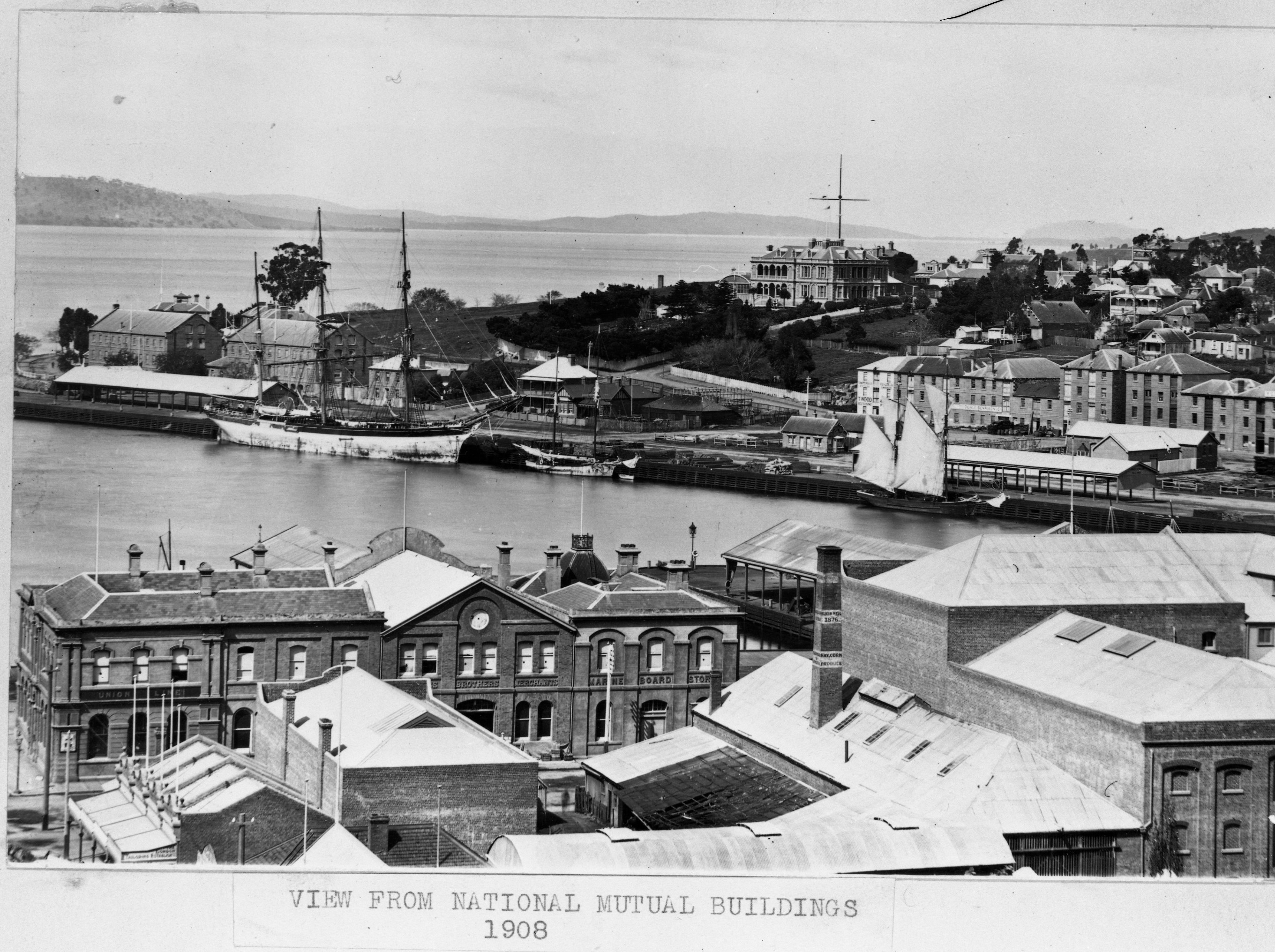
View from the National Mutual Buildings, Hobart. 1908 Item: AB713-1-11688, courtesy State Library of Tasmania.
COLLEGE OF DOMESTIC ECONOMY.
OPENED IN HOBART TO-DAY. A SPLENDID INSTITUTION.
.jpg?timestamp=1586581545766) During the last few years many new fields of industry have been thrown open to women, and tin's fact Las not .only been availed of, but it has stimulated them to devoting more time to perfecting the walks of life which are peculiarly their own. Every day shows a more or less tendency to democracy, with the result that now-a-days it 'is by no means looked upon as lowering one of what is termed "gentle" brood,
During the last few years many new fields of industry have been thrown open to women, and tin's fact Las not .only been availed of, but it has stimulated them to devoting more time to perfecting the walks of life which are peculiarly their own. Every day shows a more or less tendency to democracy, with the result that now-a-days it 'is by no means looked upon as lowering one of what is termed "gentle" brood,
….The college will be in charge of Mrs. H. Tristram Squire, a well-known exponent of domestic economy, who will be assisted by a teaching staff of 14 well qualified teachers. Intending pupils are now being enrolled, and the first term begins on the 14th instant. The scale of fees are most moderate, and the committee of management deserve much praise for making them such. In addition to the classes for continuous study, a number of instructive and interesting lectures will be given by prominent ladies and gentlemen of Hobart on subjects of special interest to women. These will be announced later. Mrs. Squire has a well-appointed office on the main floor, where she can daily be soon by anyone wishing to do so, and she will give all information required in connection with the college. COLLEGE OF DOMESTIC ECONOMY. (1908, July 8). Tasmanian News (Hobart, Tas. : 1883 - 1911), p. 1 (FOURTH EDITION). Retrieved from http://nla.gov.au/nla.news-article180376750
DOMESTIC ECONOMY COLLEGE OPENED BY THE PREMIER.
Yesterday afternoon the Premier opened, in the National Mutual Buildings, the Alexandra College of Domestic Economy and-Hygiene. The college has been started with the objects of promoting the comforts of the homo, and showing how the best results can be obtained from available income, to make labour more attractive by better provision for the health and well-being of the household, to improve the status of domestic workers, and attract a capable class of girls, thoroughly taught and fitted for all duties, and to give ladies an opportunity of increasing their incomes without leaving their homes. There was a large attendance of ladies at the opening, including Lady Lewis and Mesdames B. S. Bird, W. B. Piopsting, and H. Nicholls.
The Premier, who was accompanied by Mrs. Evans, in declaring the college open, said he had much pleasure in taking part in the ceremony, and complimented the principal (Mrs. H. Tristan Squire), the committee, and the teaching staff, on placing an elaborate syllabus before the people of Hobart. Work of a similar description had been taken up before in the city, and at the beginning there was manifested a desire on the part of the ladies to obtain information; but within a short time the classes, owing to a want of support, had to be abandoned. He had taken part in similar inaugurations to the one that day, but he had to state that at no time had there been apparent such an interest, or so complete a prospectus submitted. If one half of the items on the prospectus could be called into effect, then he -was certain success would attend the efforts of the principal and the committee. The syllabus referred to the health and well-being of the household, and that was a very important factor in home life, for they must not overlook the fact that, in gaining information re-gal ding home life, they were helping in every possible way the national interests of the State. To thoroughly teach girls in all duties was another course from which great benefit, would be derived, and as for the class which would teach ladies how to manage their incomes without leaving their homes, that should become most popular. He had much pleasure in taking part in the opening ceremony, and wished the college every success. (Applause.)
Mr. A. J. Taylor also congratulated the organisers of the movement on the success of the opening.
In the basement of the building several firms displayed their goods. Messrs. Burgess Bros, show oil stoves for economical cooking and heating, and the Gas Company have an exhibit of cooking stoves and electric radiators, the latter developing heat for many purposes. The Carlton Cafe showed a tempting assortment of goods, and Messrs. W. D. Peacock and Co. jams, jollies, and sauces. Messrs. Dehlo, Bennison, and Co. exhibited a fine collection of "Pineapple" brand edibles, and ladies were much interested in their economical "O.K." washer. Day's furniture arcade and Singer's Sewing Machine Co. had a fine array, and some dainty millinery was shown by the Misses Bennett, and toilet requisites by the Misses McKay.
During the afternoon tea and coffee were supplied by Mr. H. Moore, of Liverpool-street, and musical items were rendered by Mrs. Edgar Phillips and her pupil (Miss Claire Chancellor) Miss Fletcher, and Master Paul Abbott. In addition to the classes for continuous study, a number of lectures will be given, the Premier intimating that, with the consent of the Council of Agriculture, he had agreed to allow the Government exports to discourse on their special subjects. DOMESTIC ECONOMY. (1908, July 9). The Mercury (Hobart, Tas. : 1860 - 1954), p. 7. Retrieved from http://nla.gov.au/nla.news-article12681203
On Wednesday afternoon the Premier opened the College of Domestic Economy, of which Mrs Tristram Squire is principal.
As we pointed out last week, there is a fine opening for first rate lessons in cooking, hygiene, and kindred topics. Mrs Squire’s venture starts under the most favorable conditions. It is blessed by Premier and Leader of the Opposition, and it is darkly hinted that a prominent Laborite was discovered discussing the coffee and scones. The Critic hopes the College will have a very prosperous career. CASUAL CHAT. (1908, July 11 - Saturday). Critic (Hobart, Tas. : 1907 - 1924), p. 7. Retrieved from http://nla.gov.au/nla.news-article162965821
Advertisements continue to appear through 1908 and until late 1909 and then cease. There are some indications the couple spent longer in Tasmania but the trail disappears for a few years until they tunr up in Victoria again.
The move to Sydney then dungarvon, Mona Vale
In 1920 Harold Tristram's mother passes away and the couple are clearly living with or near his brother Francis, again near the water at Hawthorn:
SQUIRE.—On the 11th February, at 22 Mathoura road, Toorak, Alice Mary, loved mother of Harold and Francis Squire, 7 Coppin's grove, Hawthorn, aged 88 years. At rest. Family Notices (1920, February 13). The Argus (Melbourne, Vic. : 1848 - 1957), p. 1. Retrieved from http://nla.gov.au/nla.news-article1677127
By March 1922 they are living in Sydney where his tools, for sculpture it would seem given the output of works from the 1920's on, were stolen:
Sydney.—Stolen, between 9.30 p.m. the 11th and 5 a.m. the 12th instant, from the residence of Harold Tristram Squires, 42 Margaret-street, Sydney.—A new black dress suit, and a white dinner suit, both have “David Jones” on tab; a white duck suit; a black cloth overcoat; two white dress shirts; two fancy coloured neckties; twelve white handkerchiefs; twenty-four white linen collars, “H. T. Squires” in ink on them; six white soft shirts; and six white shirts with black stripes; six pairs black socks; a large steel cabin trunk, 42 by 18 inches; pair of heavy tan boots; and two pairs of white canvas shoes with leather soles, size 8; two white linen bed-sheets; two large black marble ornamental - tigers, with wooden tails; an oval steel hat-box, “H. T. Squires” on it; a white pith helmet; two lady’s hats, one black straw, the other white and green straw; a number of Government certificates for art work in the name of Harold Tristram Squires; and a green-painted tin trunk, containing a quantity of tools; total value, £35. Portion identifiable…Burglaries, etc. (1922, March 15). New South Wales Police Gazette and Weekly Record of Crime (Sydney : 1860 - 1930), p. 151. Retrieved from http://nla.gov.au/nla.news-article252092018
Soon after this they are living in Dungarvon at Mona Vale. This wonderful home on Park Street, Mona Vale 'Dungarvon’ was built in 1904, making it one of the oldest properties in Pittwater. Built by Samuel Stringer, a carpenter by trade, he worked on most of the timber work himself and his son Stan Stringer recalls being told that the stone walls were built by French stonemasons. Local stonemason James Booth apparently had some input too.
These photos were taken in 2009 of Dungarvon in Park Street, Mona Vale:
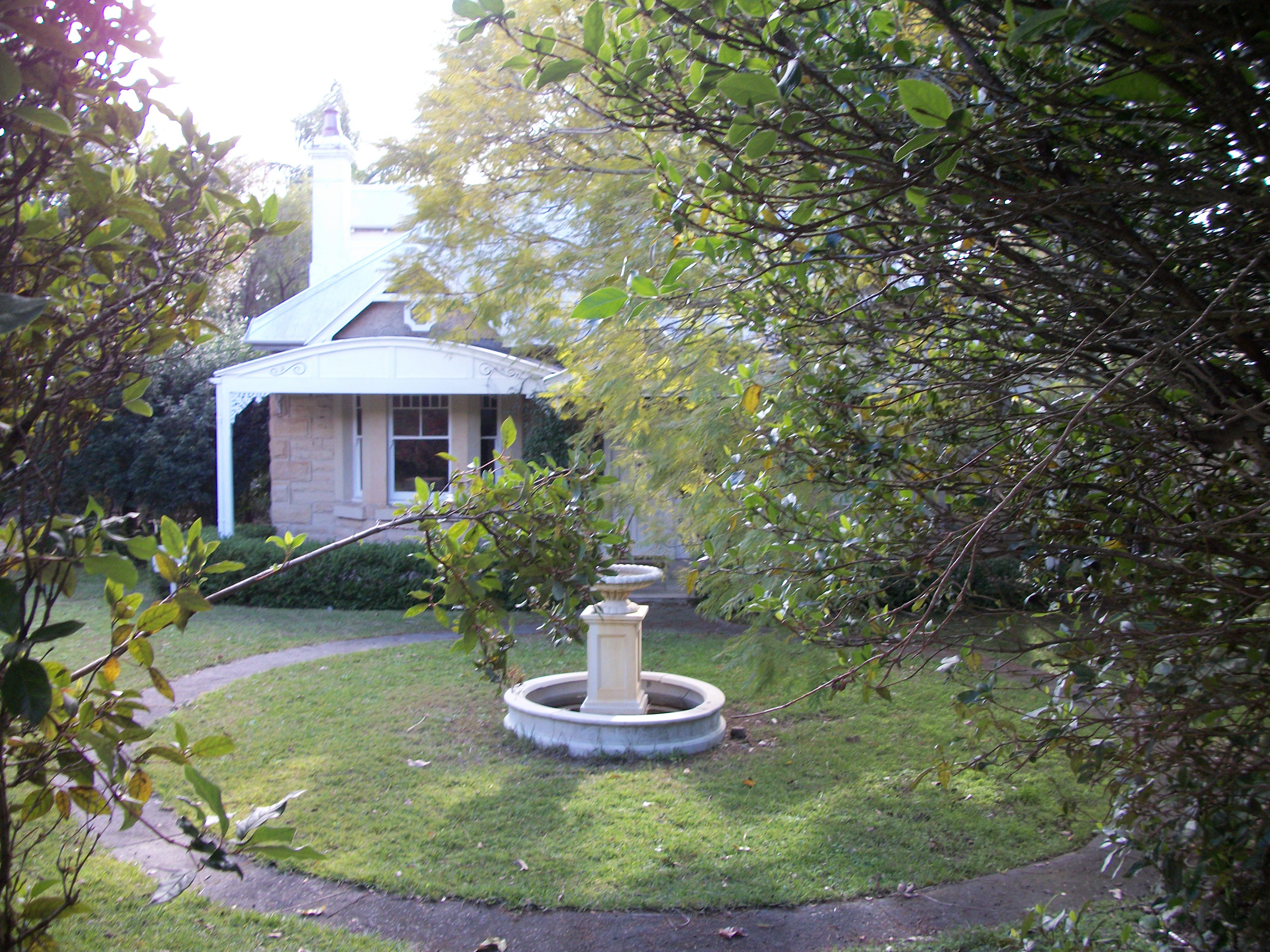
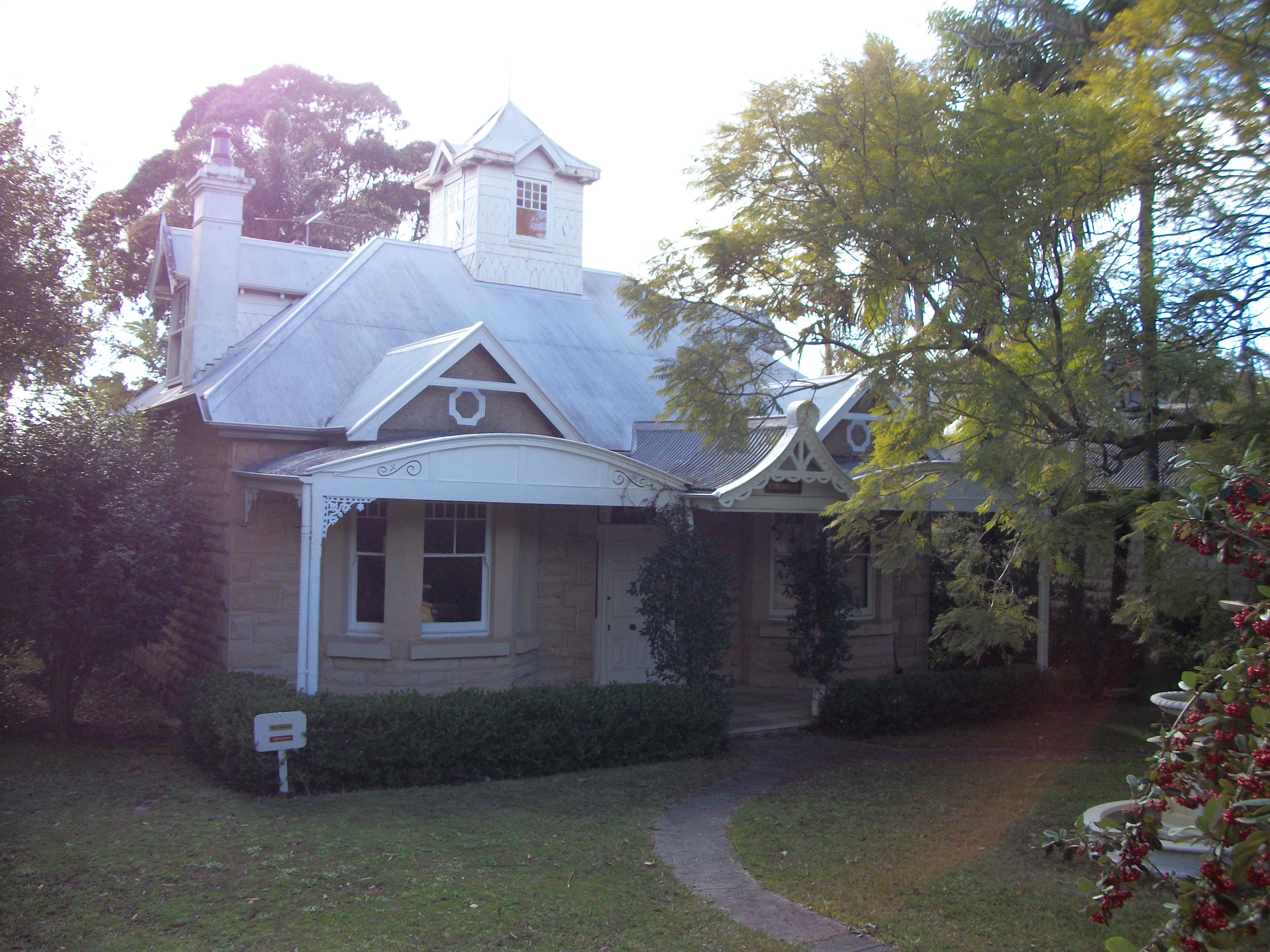
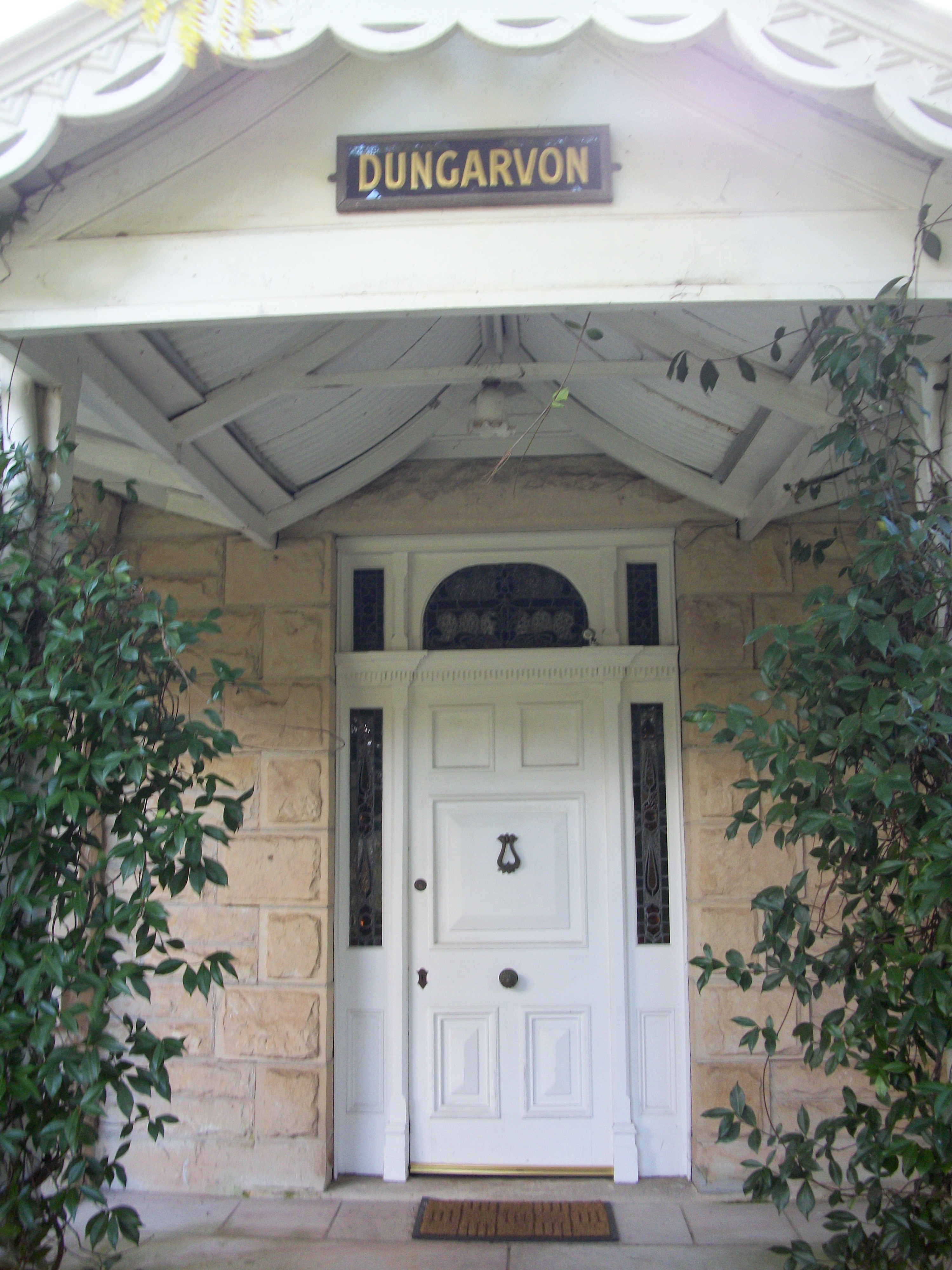
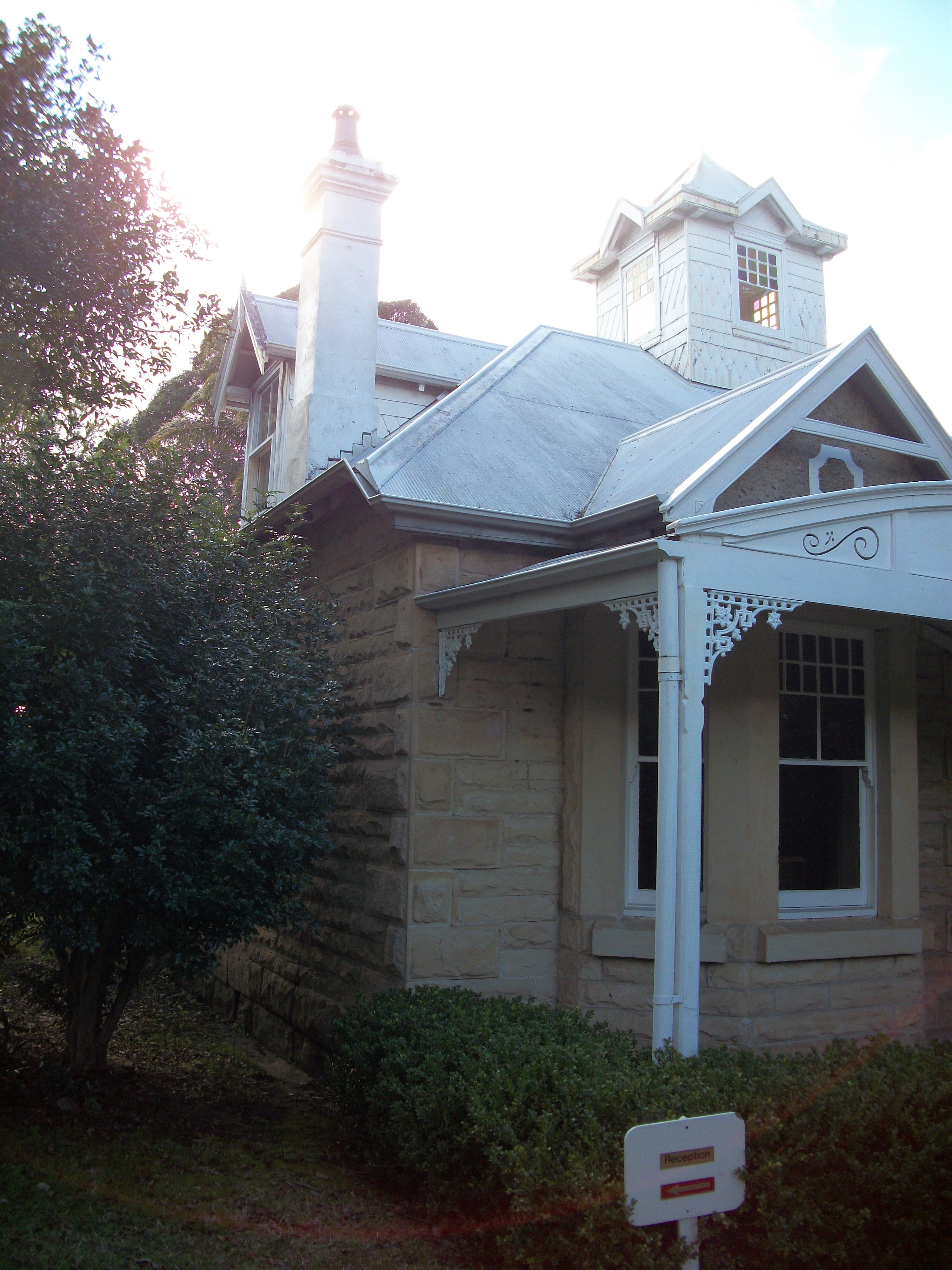
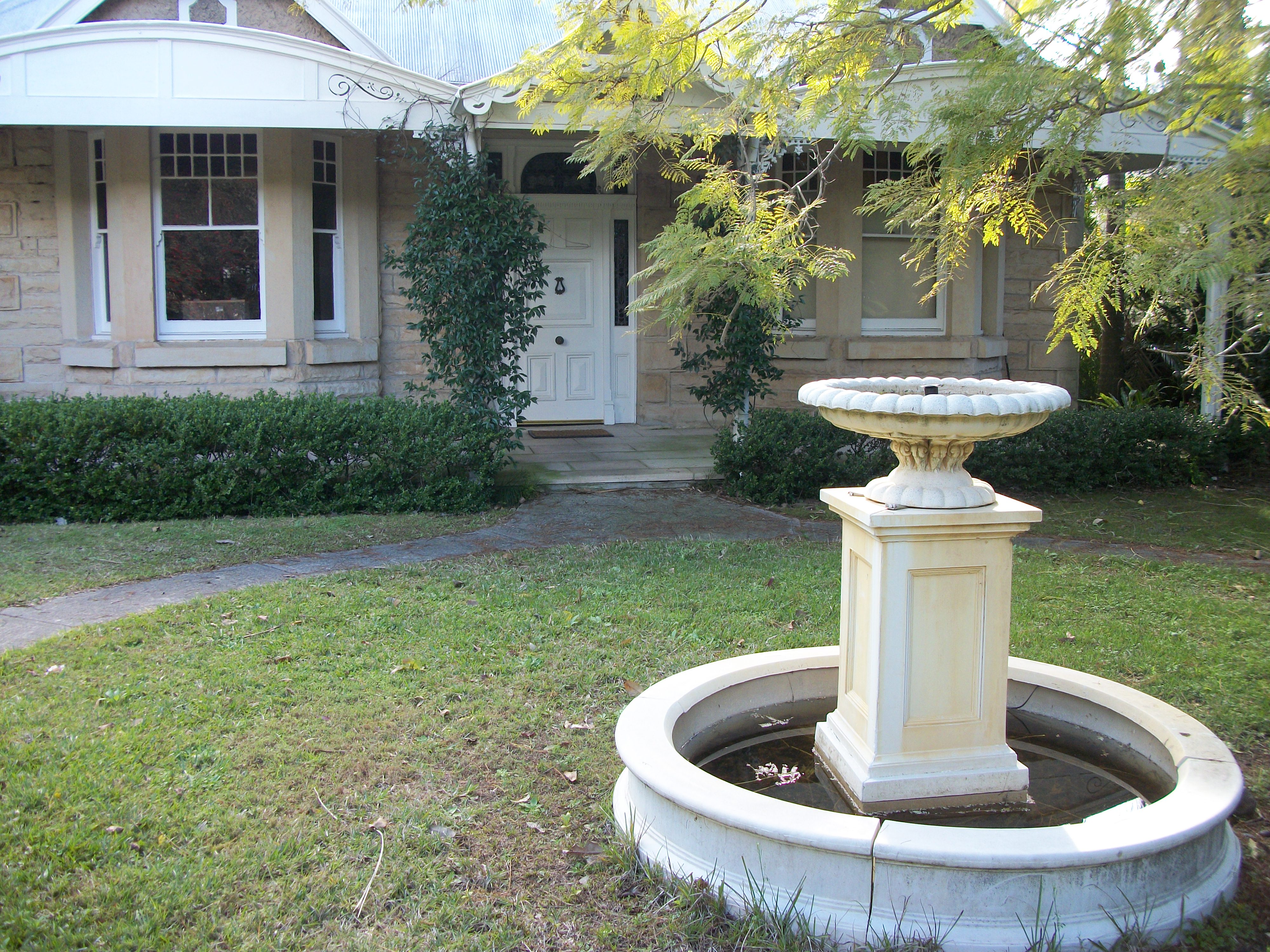
Mr. Stringer bought six adjoining blocks of land in Park Street, Mona Vale for 125 pounds, which formed section 1 of the Mona Vale Estate. He borrowed 200 pounds to finance the construction of Dungarvon and also 26 Park Street, next door, which was Mona Vale Public School for a few years before the new school was built. The Stringer family of eleven lived in the home until 1922 and the home was sold to the Squire couple (sold to them in 1923 according to some reports) - they were certainly part of a ball at Mona Vale in 1924, with Mabels' sisters Beatrice and Helen with them for this event:
Mr. and Mrs. Squires, of Mona Vale, have had many local successes with an elephant which they constructed. This clever animal would be very useful for collecting toys and dolls for Christmas treats. Mr. and Mrs. Squires are ready to lend the elephant and their services if one of the business firms would have the elephant conveyed to Sydney from Mona Vale.
The annual ball of the Mona Vale Cricket Club, which was held at the Pittwater Hall, proved very successful. Many fancy dresses were worn, prizes being awarded to Mr. J. Skinner, Miss Topsy Kuhlmorgen, Mr. E. King, and Miss Audrey Snape. A special prize was given to Mr. and Mrs. Squires for the clever elephant. They were assisted by Miss B. Harvey and Miss H. Harvey, who acted as keepers. Others wearing fancy costumes were Mesdames Austin and McLaren, the Misses B. Fairley, Thelma Austin, Poppy Notting, Dorothy Greig, Ivy Oliver, Dowling, Ethel Dunbar, Ivy Hardy, Nell Jackson, and Messrs. Hector Craig, Clyde Hicks, Austin, and Cedric Williams. Those who assisted materially to make the evening so big a success were Messrs. J. Austin, sen., G. Shepherd, and G. Shaw. PARTIES OF THE WEEK (1924, September 21). Sunday Times (Sydney, NSW : 1895 - 1930), p. 17. Retrieved from http://nla.gov.au/nla.news-article128149027
Richardson and Wrench report sales; ...hall property, village of Turrimetta, Pittwater, for the sum of £530; REAL ESTATE (1917, October 28). Sunday Times (Sydney, NSW : 1895 - 1930), p. 11. Retrieved from http://nla.gov.au/nla.news-article122787521
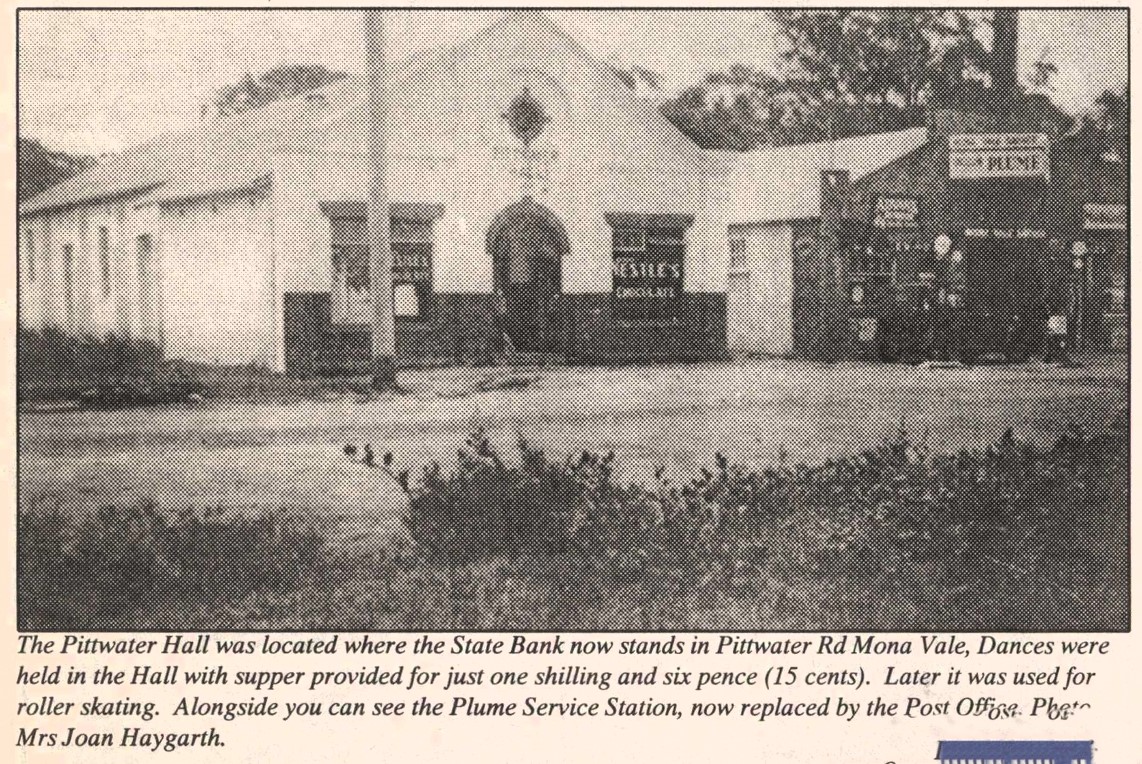
The couple were still working in town however, as this little snippet tells us:
Paintings of Orchids.
Sydney Botanic Gardens Museum has received a most attractive donation of orchid paintings from Mr. and Mrs. H. Tristram Squire, and these are now on view at the gardens. It appears that Mr. and Mrs. Squire, both of whom have marked artistic talent, were struck by the beauty of form and color displayed in the hot-houses, and they were given permission to enter and paint the exotic orchids as the various species came to flower. This done, the artists showed their public spirit by presenting practically the whole of the collection to the gardens. The paintings, which represent chiefly the beautiful Dendrobium and Cypripidium orchids, are done in oil on glass and wood, and in every case the work is faithful in execution and sound in atmosphere.
I am glad to learn that Mr. and Mrs. Squire are proposing now, as opportunity offers, to paint native orchids, with the idea of establishing a public collection. This is a most commendable objective, and one that all flower-lovers should aid by Rending native orchids in flower to the artists, at 80 Hunter Street, City. WAYS of the WILD (1925, March 13). The Daily Telegraph (Sydney, NSW : 1883 - 1930), p. 9. Retrieved from http://nla.gov.au/nla.news-article245273259
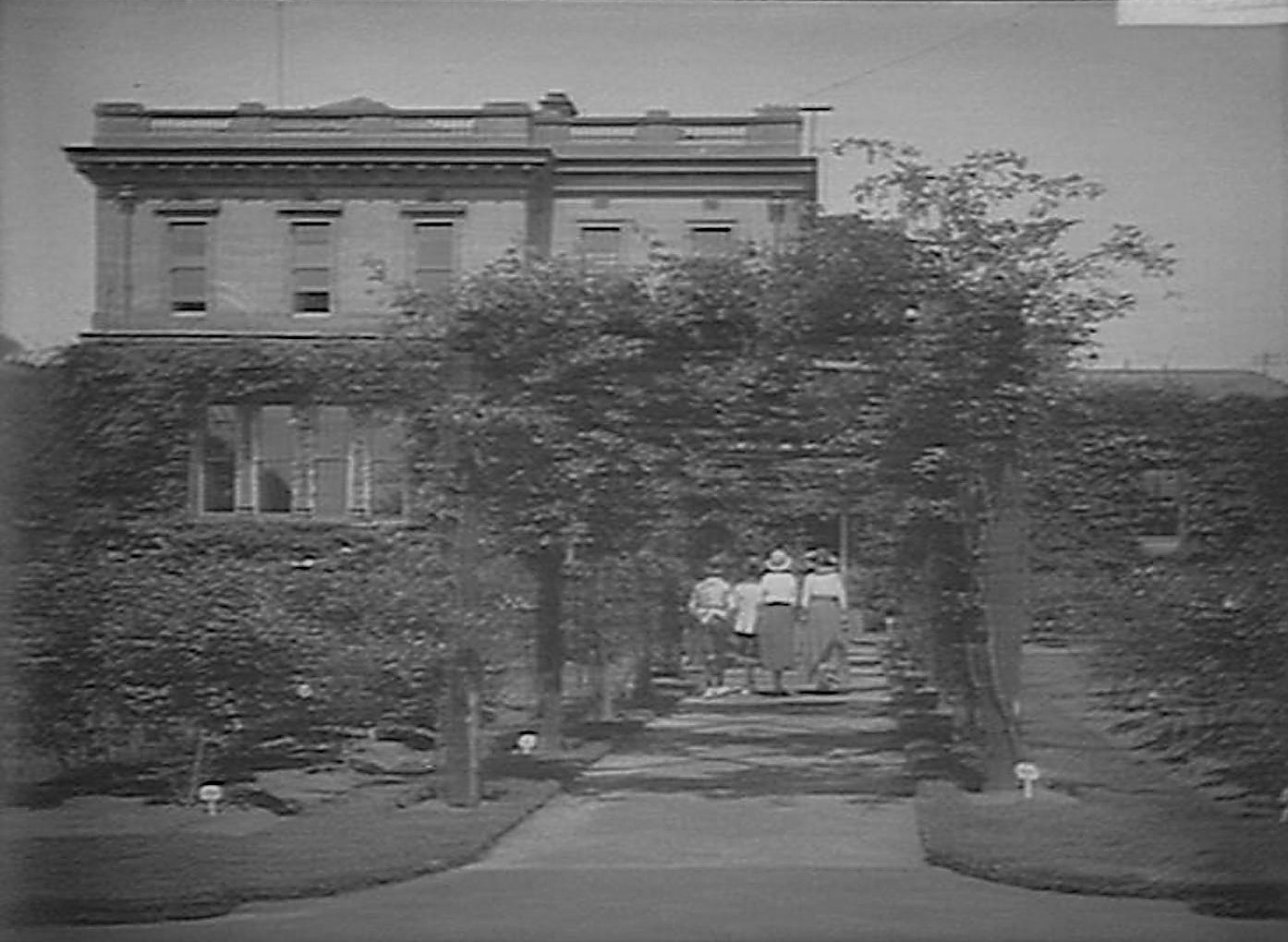
Botanical Gardens museum Item: d1_16601h Government Printing Office no date 1920s 1930s, courtesy State Library of NSW
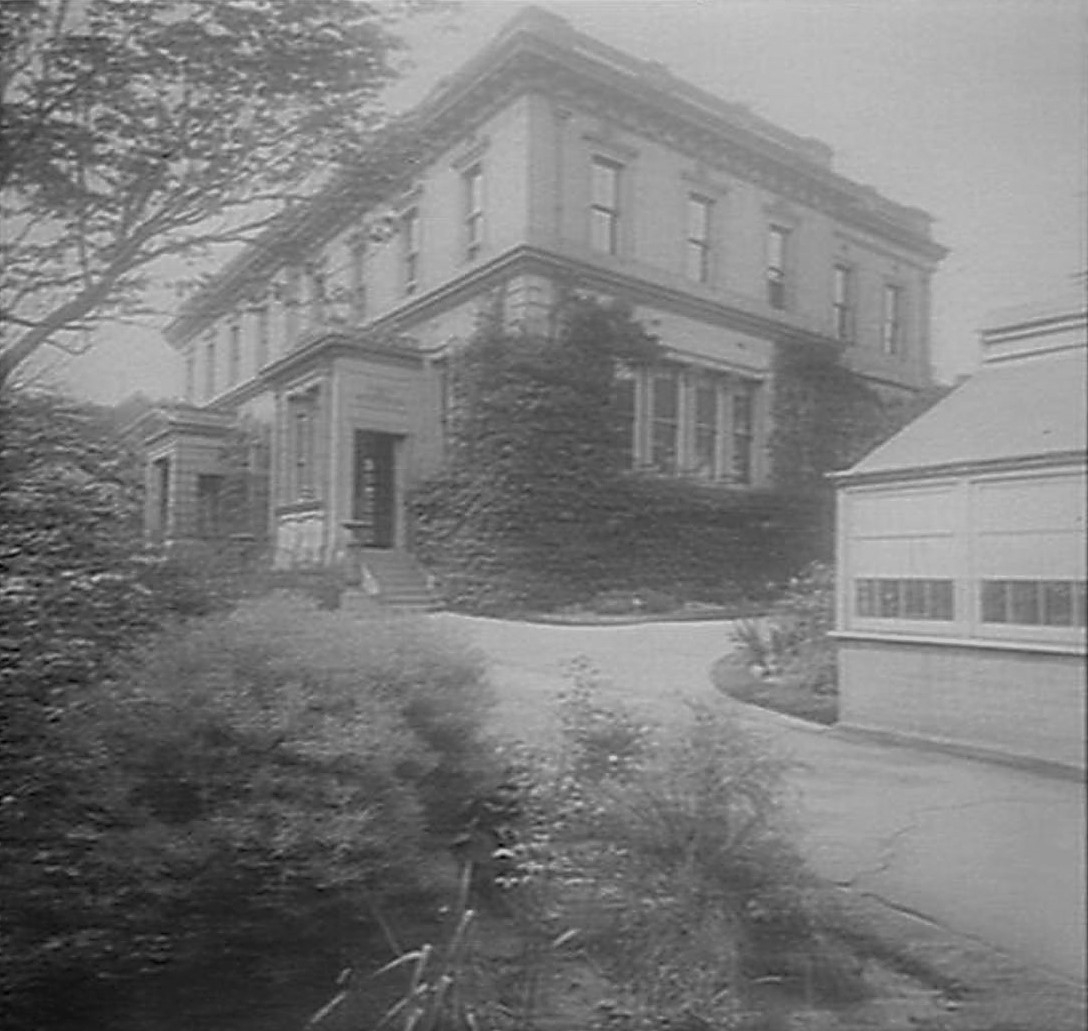
Botanical Gardens. Herbarium Museum and offices Item: d1_10752h, courtesy State Library of NSW
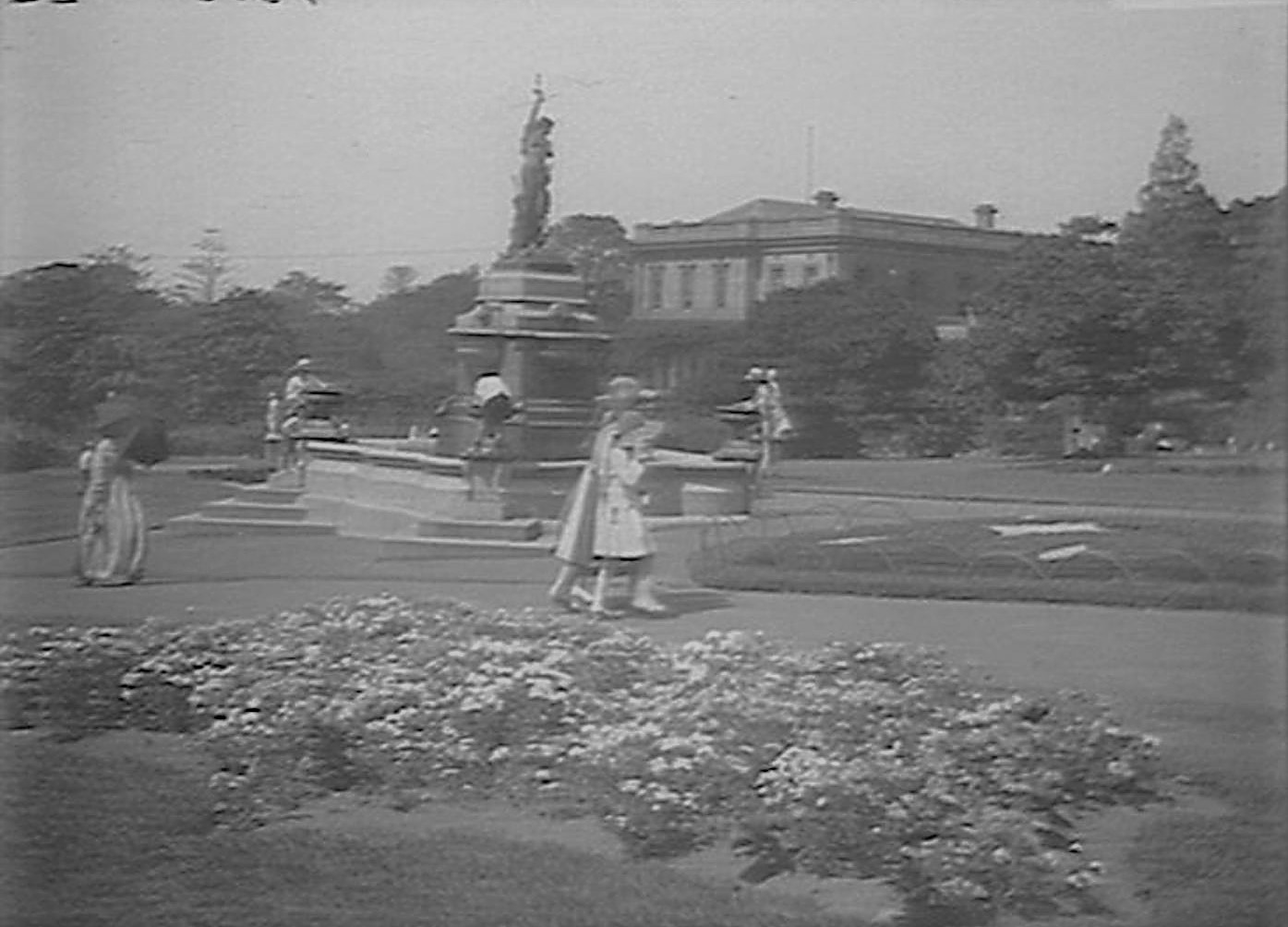
Botanical Gardens museum and fountain d1_16603h, courtesy State Library of NSW
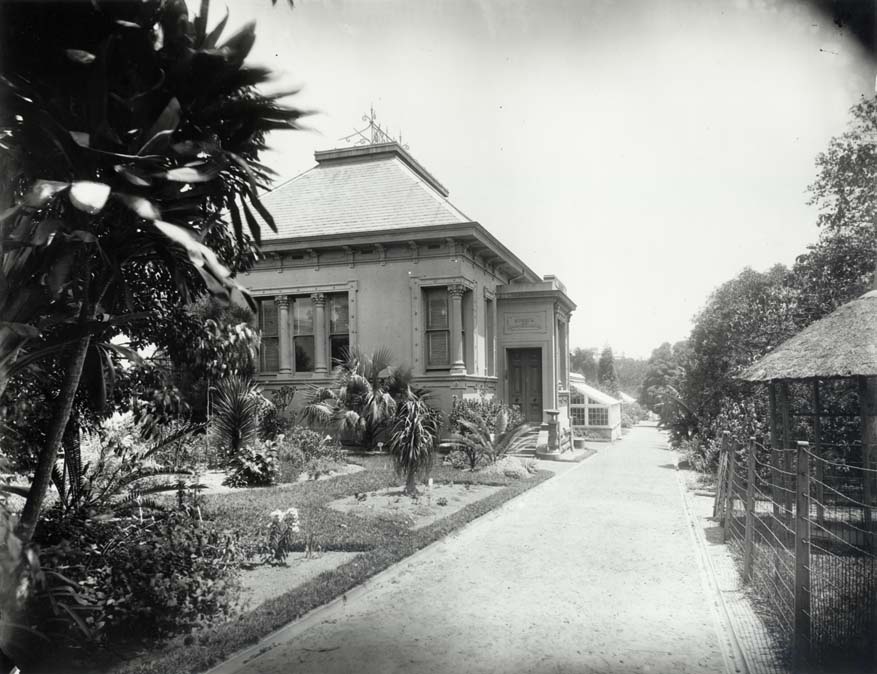
Sydney Botanic Museum - Courtesy State Records & Archives NSW - photo 4481_a026_000576 - the hothouses can be seen off to the side in this photo, just beyond the museum building
A Victorian paper ran the same notice, with an alternative spelling of their name:
An interesting gift has been made to the Sydney Botanic Gardens Museum by Mr. and Mrs. H. Trestram Squire, who have, by courtesy of the authorities, been painting the flowering orchids in the hothouses of the gardens. They have donated the series to the museum. These quaint flower-studies are done on glass, and on wood, and make a valuable addition to the treasures collected there. The artists are making special studies of native orchids and blossom, and will appreciate any specimens which can be sent to 80 Hunter street, Sydney. SOCIETY DOINGS IN SYDNEY. (1925, March 21). The Australasian (Melbourne, Vic. : 1864 - 1946), p. 53 (METROPOLITAN EDITION). Retrieved from http://nla.gov.au/nla.news-article140771590
None of these works could be found either.
The address, 80 Hunter Street, was the home and studio of Albert Bellier de Villentroy (1876-1926), professional photographer formerly of Paris and New Orleans, who owned De Villentroys Studios at 80 Hunter Street, Sydney (1921-1925) and 214 Pitt Street, Sydney (1925). His daughter, Marie-Celeste (1906-1994) also appears to have worked in her father's studio during his lifetime and for a few years after his death.
This may be also where Harold and Mabel acquired the glass used in their orchid paintings - and where photos of them may have been taken - although none have shown up as yet.
Marie-Celeste, with her mother, owned a cafe called De Villentroy's French Coffee Rooms at 31 Pitt Street, Sydney from 1931 to 1945. In 1952 she married Joseph Launay (1901-1977) a seaman and baker and Manly resident. The State Library of NSW hold the family records and papers and images of the de Villentroy family, among which there must be a photo of H T and ME Squire - or their orchids - unfortunately these have not been digitised as yet. Those that are available in newspapers, as well as those of boxers held by the National Library of Australia, show the family of photographers specialised in Portraiture. A few notes about this family from the pages of the past:
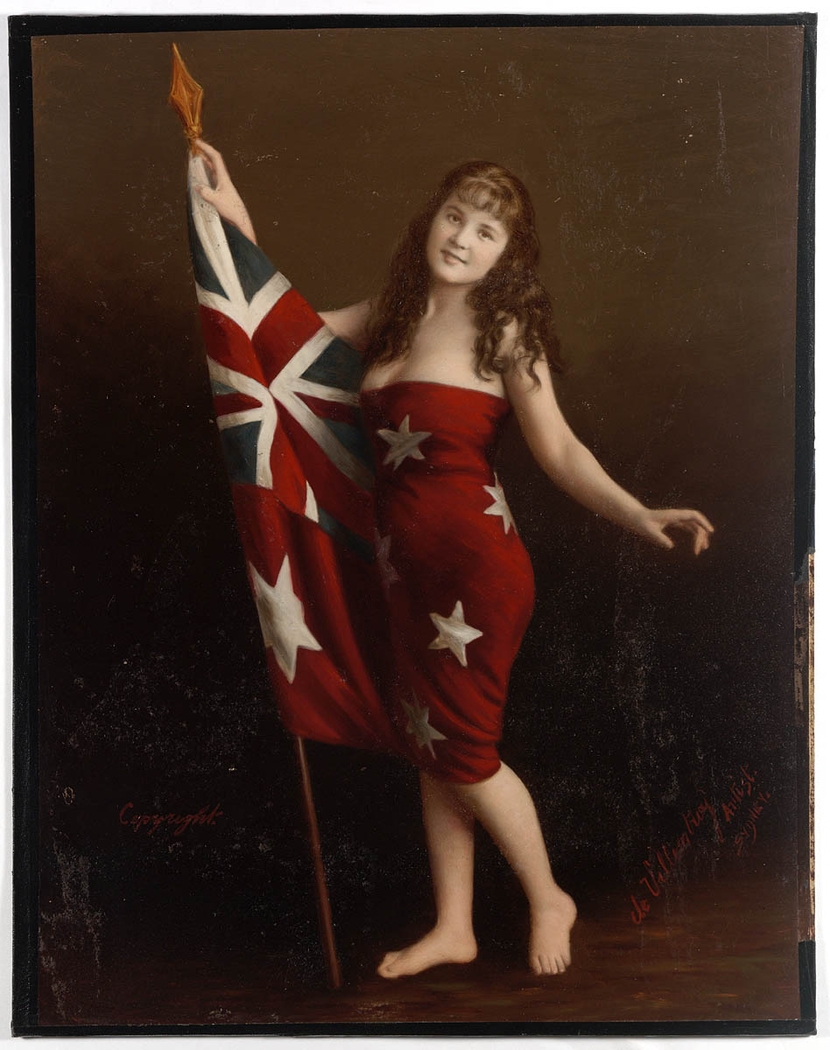
Marie-Celeste de Villentroy poses as 'Young Australia' 1921 By Albert Bellier de Villentroy. From the collections of the State Library of New South Wales [a128733 / PXD 666 (v.1)] (Mitchell Library)
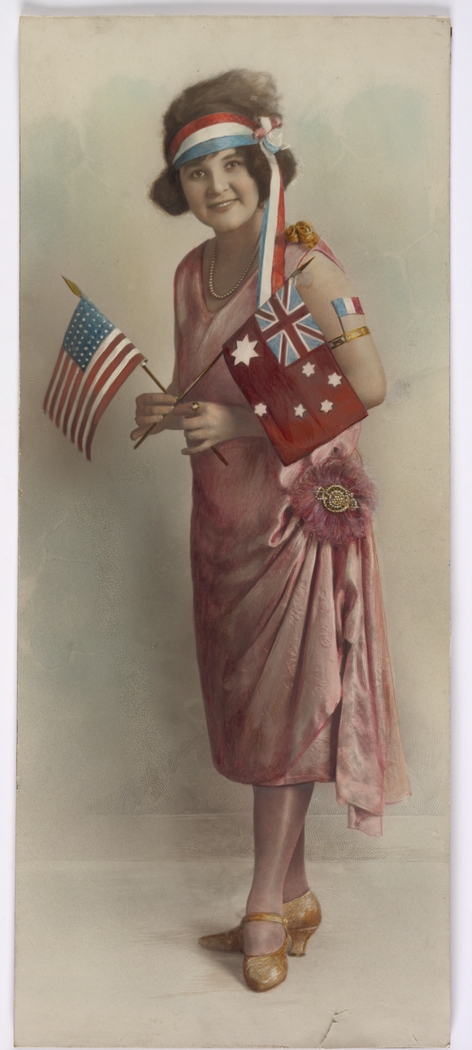
Marie-Celeste de Villentroy poses as 'Young Australia' 1921 By Albert Bellier de Villentroy. From the collections of the State Library of New South Wales [a128810h / PXD 666 (v.1)] (Mitchell Library)
Copyright applied for
4637. Albert Bellier de Villentroy, 80 Hunter-street, Sydney, N.S.W. Photograph: "Young Australia." 12th May, 1921.
4638. Albert Bellier de Villentroy, 80 Hunter-street, Sydney, ^.S.W. Photograph: "Young Australia." 12th May, 1921. PROCEEDINGS UNDER THE COPYRIGHT ACT 1912. (1921, July 28). Commonwealth of Australia Gazette (National : 1901 - 1973), p. 1120. Retrieved from http://nla.gov.au/nla.news-article232182969
4809. Albert Bellier de Villentroy, 80 Hunter-street, Sydney, N.S.W. Photographic Print: "Among the Boxers." 13th April, 1922. PROCEEDINGS UNDER THE COPYRIGHT ACT 1912. (1922, July 27). Commonwealth of Australia Gazette (National : 1901 - 1973), p. 1180. Retrieved from http://nla.gov.au/nla.news-article232526894

MISS MARIE DE VILLENTROY. 80 HUNTER STREET, SYDNEY. Fifth Batch of the "Evening News" Beauties (1922, May 5). Evening News (Sydney, NSW : 1869 - 1931), p. 7. Retrieved from http://nla.gov.au/nla.news-article118867262
£15 GIVEN AWAY IN PRIZES. For the most beautiful babies up to about years of age taken at DE VILLENTROY'S STUDIO, 80 HUNTER STREET, CITY.
FIVE CASH PRIZES IN ALL — £5 FOR THE FIRST, .£4 FOR THE SECOND, £3 FOR THE THIRD, £3 FOR THE FOURTH, £1 FOR THE FIFTH.
COMPETITION TO START FROM MAY 22 TO JULY 22.
BRING BABY EA1U/Y TO AVOID RUSH.
All Winners will be flashed on the screen of the Haymarket Theatre, George-street, City. '
GET ALL PARTICULARS AT DE VILLENTROY'S STUDIO, 80 HUNTER STREET, CITY. Advertising (1922, May 28). Sunday Times (Sydney, NSW : 1895 - 1930), p. 5. Retrieved from http://nla.gov.au/nla.news-article128212594
A COMPETITION NOT FOR ALL AUSTRALIA but for Sydney and suburbs babies alone. £15 divided in five prizes, giving better chance to every child to win and also using same photographs for TIME'S COMPETITION. Mr. and Mrs. de Villentroy are both engaged to secure that lovely smile so dear to the parent's heart. SUCCESS IS GUARANTEED, as they have 17 years' experience in children photography. Our Studio last week was transformed into a Nursery. We don't mind It, as we love the kiddies and feel happy among them. Have the photo of your darling taken by us. There is no rush to get through, AND COMPARE. Advertising (1922, June 4). Sunday Times (Sydney, NSW : 1895 - 1930), p. 8. Retrieved from http://nla.gov.au/nla.news-article128216840
ARE YOU GETTING MARRIED ? Are you aware of the fact that de VILLENTROY'S Studios, known for his good work, is giving a beautiful enlargement FREE with every dozen of bridal photographs taken in either of our studios, 80 Hunter-st., or Lyceum Studio, 214 Pitt-st. Phone, B 3529.. Advertising (1923, April 22). Sunday Times (Sydney, NSW : 1895 - 1930), p. 16. Retrieved from http://nla.gov.au/nla.news-article120536814
DEATHS . DE VILLENTROY.— 24th, May. 1926, at his late residence, 80 Hunter-street. City, Albert Bellier De Villentroy, beloved husband of Marie Bellier and devoted father of Marie Celeste. aged 50 years. RIP.
FUNERALS
DE VILLENTROY.— The Friends of Mrs. MARIE BELLIER DE VILLENTROY and MARIE CELESTE are kindly invited to attend the Funeral of her dearly beloved HUSBAND and her FATHER, Albert Bellier De Villentroy to leave Mrs P. Kirby and Son. Ltd.. Funeral Parlors, TO-MORROW, WEDNESDAY. at 2 p.m. for the Catholic Cemetery. Rookwood, Motor Funeral by road. MRS. P. KIRBY AND SON, LTD, Funeral Directors, 153 Phillip street City. Family Notices (1926, May 25). Evening News (Sydney, NSW : 1869 - 1931), p. 11. Retrieved from http://nla.gov.au/nla.news-article117286482
The Professional Photographers' Association held the annual social at the Waratah during the week, when a musical programme was given by Mdlle. Marie de Villentroy, Mrs. Peachey, Messrs. A. A. Binnie, and Appleby. Social Interest (1927, July 3). The Sun (Sydney, NSW : 1910 - 1954), p. 32. Retrieved from http://nla.gov.au/nla.news-article222487039
THE WEEK- CITY AND SUBURBAN BREVITIES.
The Professional Photographers' Association has been registered as an industrial union. THE WEEK. (1905, January 11). The Sydney Mail and New South Wales Advertiser (NSW : 1871 - 1912), p. 84. Retrieved from http://nla.gov.au/nla.news-article164035578
ARBITRATION. (Before Judge Heydon, President, and Messrs. G. H. Wright and E. Riley, members.)
PHOTOGRAPHERS' ASSOCIATION. On the application of the Registrar the registration of the Professional Photographers' Association as an industrial union, was cancelled. ARBITRATION. (1906, September 7). The Daily Telegraph (Sydney, NSW : 1883 - 1930), p. 10. Retrieved from http://nla.gov.au/nla.news-article237636920
Photographers' Outing
Mr. J. J. Rouse, on behalf of Kodak. Limited, tendered the Professional Photographers' Association of N.S.W. a harbor excursion yesterday. There was a large attendance both of city and country photographers, and as Kodak had extended the Invitation to Include the wives of members of the association many ladies.
Leaving Fort Macquarie in the morning a tour of the southern part of Port Jackson as far as the Heads was made, then to Middle Harbor, and back to Clifton Gardens, where luncheon was partaken. Sports were afterwards held, and soon after 4 o'clock a trip round Manly completed a most enjoyable day, Fort Maquarie being reached on the return Journey at 6 o'clock. Photographers' Outing (1920, November 24). Evening News (Sydney, NSW : 1869 - 1931), p. 3. Retrieved from http://nla.gov.au/nla.news-article117304858
XMAS BOX
'Sunday Times' Baby Contest May Bring Winner £1000 Prize ' ART UNION OFFER
Everybody loves a baby. The 'Sunday Times' Baby Contest has received the approbation of a large circle of readers. Entries are literally pouring in, and the covering letters received with entries point to the fact that the competition has taken on, and is greatly appreciated. From every little town and hamlet in the State we have received photographs of bonnie Australian kiddies.
Special attention is drawn to the conditions of the competition printed else where -in tho paper. The entries received up-to-date have been numerous, but there is likely to be a bigger rush when the entries reach us from outlying parts. In connection with this competition we are pleased to be able to announce that the St. Margaret's Christmas Box Art Union committee had entered into tho scheme for discovering Australia's bonniest baby. Every entrant in the 'Sunday Times' Baby Contest will be presented with an Xmas card from St. Margaret's, and, as a consequence, will be a ticketholder eligible to compete for the valuable Art Union prizes. The first prize is £1000, and there are many additional prizes. By entering your baby in the 'Sunday Times' contest, in addition to carrying off first prize, tho baby may have the winning number in the Art Union. The 'Sunday Times' has made special arrangements with the Professional Photographers' Association of New South Wales to photograph all entrants at a nominal charge. Printed below is the official list of Association members. Your local photographer may be among them. It will be to your advantage to visit him, but you are at liberty to patronise any other photographer if you can not reach a member of the Association. …..Mrs. A. B. De Villentroy. Lyceum Buildlngs, Pitt-street, Sydney : L. Dickenson, Clifford-avenue, Manly… XMAS BOX (1928, October 7). Sunday Times (Sydney, NSW : 1895 - 1930), p. 5. Retrieved from http://nla.gov.au/nla.news-article122819119
Parlez-Vous?
DISTINCTLY brighter tone is noticeable towards the Quay end of Pitt Street these days— the result of Madame de Villentroy's recent trip to Paris. Madame had planned to settle down in la Patrie; but the pull of Australia was too strong; so now she and daughter Marie Celeste have installed themselves in a perfectly French blue-white-red Coffee Shop, where they make French salads for the hot days and coffee that is" already talked about. Madame is the widow of the artist-photographer de Villentroy, whose studio in Pitt Street used to be popular some years ago. SECREISO THE TOWN (1932, January 24). The Sun (Sydney, NSW : 1910 - 1954), p. 28. Retrieved from http://nla.gov.au/nla.news-article230532282
MARIE BELLIER DE VILLENTROY, of French nationality, born at Basse Pyreenes, France, and resident 17 years in Australia, now residing at 42 Bayswater Road, Darlinghurst. Intend to apply for naturalisation under the Nationality Act, 1920-30. Advertising (1938, May 16). The Daily Telegraph (Sydney, NSW : 1931 - 1954), p. 11. Retrieved from http://nla.gov.au/nla.news-article247252335
de Villentroy, Marie Bellier, 42 Bayswater-road. Darlinghurst, New South Wales. CERTIFICATES OF NATURALIZATION. (1938, July 14). Commonwealth of Australia Gazette (National : 1901 - 1973), p. 1919. Retrieved from http://nla.gov.au/nla.news-article232653652
De VILLENTROY.-July 8, 1944, at Sydney Hospital, Marie Francoise Bellier, beloved mother of Marie Celeste, aged 64 years. Requiescat in pace.
DE VILLENTROY -The Funeral of the late Marie Françoise Bellier de Villentrov will leite cur Private Mortuary Chapel 265 Elizabelh Street Svdney, This (Monday) Alternoon at 2 lo o clock for No 2 Mortuarv In Catholic Cemetery Rookwood Mrs P Kirby and Son Ptv Ltd 26a Elizabeth street. Family Notices (1944, July 10). The Sydney Morning Herald (NSW : 1842 - 1954), p. 8. Retrieved from http://nla.gov.au/nla.news-article17912973
Albert BELLIER DE VILLENTROY
Born 20 November 1876
Deceased 22 May 1926, aged 49 years old
Parents
Marie Louis Alfred BELLIER DE VILLENTROY 1835-1906
Joseph Louise Thérèse Marie DE VILLÈLE 1841-1905
Spouses and children
Married to Marie LARQUIE with
Siblings
Camille BELLIER DE VILLENTROY 1859-1899
"Pierre" Antoine Marie Joseph Alfred Louis BELLIER DE VILLENTROY 1861-1943
Antony BELLIER DE VILLENTROY 1862-1905
Joseph Jeanne Clémentine Marie BELLIER DE VILLENTROY 1866-1962
Mélanie "Pauline" BELLIER DE VILLENTROY 1867-1896
Mélanie BELLIER DE VILLENTROY 1869-
Jeanne BELLIER DE VILLENTROY 1872-1918
Joseph BELLIER DE VILLENTROY 1874-1962
Born in New Orleans on October 12th, 1906, Marie-Celeste Bellier de Villentroy arrived in Australia on 16 January 16th, 1921 aboard the SS Beltana with her French-born parents Albert and Marie-Françoise. Albert, a photographer, established the De Villentroy Studios at 80 Hunter Street, Sydney soon after the family’s arrival, where he took ‘Young Australia: A Girl Wrapped in the Australian Flag’ featuring Marie-Celeste. The photograph came into the Archives’ collection with copyright registration paperwork Albert lodged for the photograph on 2 May 1921. Five years after Albert’s death in May 1926, Marie-Françoise opened Le Café Français at 31 Pitt Street, Sydney which she ran with Marie-Celeste.
In 1938, Marie-Françoise lodged a naturalisation application ‘in order to obtain invalid pension’ due to her ‘unsatisfactory’ health. At the time she stated her occupation as being ‘dependent on daughter’. Included in the file is Marie-Françoise’s French passport, containing a family photograph. During World War II, under the provisions of the Aliens Registration Act 1939, Marie-Celeste was investigated by Military Police Intelligence (MPI) after failing to register. Interviewed by Inspector Keefe on 9 August 1940, Marie-Celeste explained she had believed she was included on her mother’s naturalisation certificate. Keefe concluded: ‘I do not think that this alien’s failure to register had any subversive motive’ and the de Villentroys ‘appear to be also decidedly…pro-De Gaulle, which means in effect pro-British’. The de Villentroy’s café was a popular spot for visiting seamen. A Military Police Intelligence report from 1942 stated that the café was a ‘gossip shop’, ‘frequented chiefly by French seamen and women of low repute’, but found ‘no evidence of subversive… activities, though suspicions have been reported’. However, it was this frequenting by French seamen that prompted another MPI investigator to recommend that – despite her ‘wearing the De Gaulle Badge’ – ‘Miss de Villentroy should be checked up very closely in view of her apparent contact with French maritime activities’.
Le Café Français closed in 1945. In 1952, Marie-Celeste married French seaman and baker, Joseph Launay (1901–77), a survivor of the Commissaire Ramel who appeared in Marie-Celeste’s alien file. According to the Find a Grave website, Marie-Celeste Launay, born in 1906, died in December 1994 and was buried in the Field of Mars Cemetery in North Ryde, New South Wales.
Love & Kindness ended in court
COLIN GRANT McPHERSON claimed he had tried to dissuade his de facto wife, Robyn Leslie, from her grandiose Love and Kindness baby-sitting venture, Detective Jack Davis told Magistrate Denton at Central Court.
McPherson had declared, according to the detective: "I told her she had taken on something that was financially impossible, but I couldn't hold her back, no matter how 5 I tried." Police have charged 42-year-old McPherson, a mariner, and Robyn Leslie, who is 34, with having stolen a hired car valued at £800, a typewriter valued at £44, and an electric fire valued at £18/11/6; with having got money by six valueless cheques, and with having f r a u dulently misappropriated money prospective baby-sitters paid into Love and Kindness Company as deposits on uniforms. ,In In a statement to the Magistrate last week: Robyn Leslie said she established Love and Kindness Company in the hope of employing 500 baby-sitters. She admitted she had received about £130 from prospective baby-sitters, each of whom paid her £1/1 registration fee and £1/1 deposit on a uniform. One of the would-be sitters— romantically named Marie Celeste de Villentroy. of Bays-water Road, King's Cross — said that in answer to a newspaper advertisement she went to a flat in Hastings Parade, Bondi, where Robyn Leslie outlined her Love and Kindness scheme. "She told me the pay would be 3/- an hour and that if X was kept after 11130 p.m. the employer would escort me home or provide a taxi for me." said Mademoiselle de Villentroy. "I paid £2/2/- to join the company, but I got no work." Mr. Denton committed Leslie and McPherson for trial at the Quarter Sessions. 'Love & Kindness' ended in court (1950, September 3). The Daily Telegraph (Sydney, NSW : 1931 - 1954), p. 49. Retrieved from http://nla.gov.au/nla.news-article248537633
Interesting Sydney engagement is that of Mile Marie Celeste de Villentroy of Darlinghurst to M... Joseph Launay; also of Darlinghurst. During the war M. Launay served with the Free French Naval Forces. Gossip: (1951, November 11). The Sun (Sydney, NSW : 1910 - 1954), p. 43. Retrieved from http://nla.gov.au/nla.news-article230842703
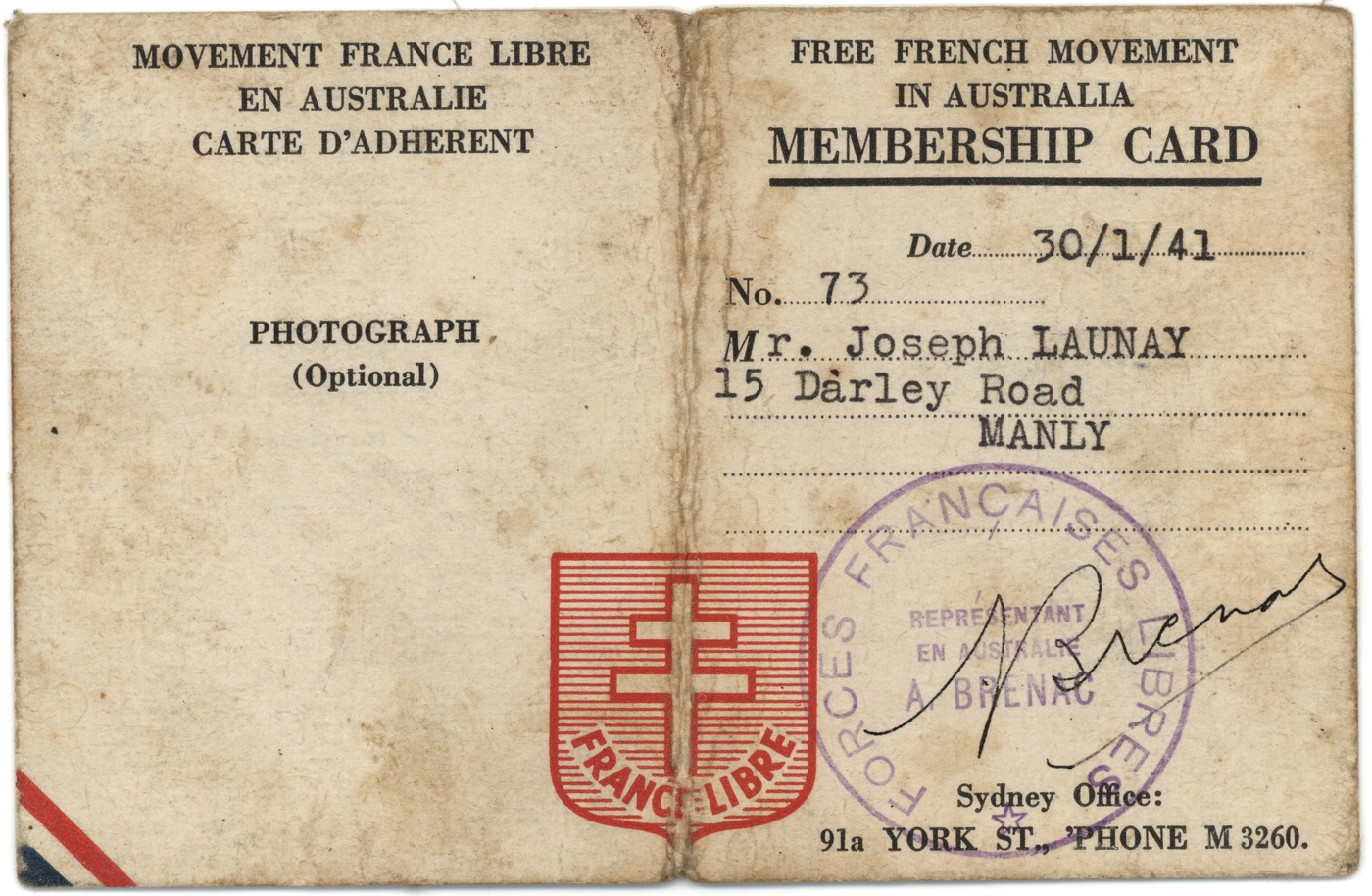
Joseph Launy ID card - Item: a1722001h - courtesy State Library of NSW
Launay, Joseph, 42 Bayswater-road, Kings Cross, 8.11. 61 CERTIFICATES OF NATURALIZATION. (1962, May 17). Commonwealth of Australia Gazette (National : 1901 - 1973), p. 1648. Retrieved from http://nla.gov.au/nla.news-article241007583
The elephants now installed at Bayview Golf Club were sculpted by Mr Harold Squire in the mid 1920s and completed by 1930. They were originally built for John (Jack) and Christina Orr and sat in their front garden, overlooking the golf course, with two being set up to be a fountain. The Orrs and the Squires seem to have become firm friends from the outset and a group of flamingos also featured in their garden overlooking what would become the present day Bayview Golf Course. A search of Construction tenders from 1922 shows a 'Bungalow for Bay View' listed in March 1922, with a city address for the tender to be submitted to.
Around 1920 New Zealand sheep farmer John Orr visited Australia. In 1924 he and his wife Christina (nee Stewart) arrived in Australia and purchased a parcel of land known as the Winnerreremy Swamp in Mona Vale. This was a parcel of 43 and a half acres originally granted to the McIntosh family.
Orr ran sheep on the property (as 'mowers'), and, as he and his wife were golfers, he constructed six holes for their amusement. This was a difficult task amidst swampland, but the Orrs used a punt to drag trees along; mounded dirt up to plant the first fairways; then gradually filled in the rest. One of the main problems was that the tide would bring large amounts of salt water into the swamp twice a day; prompting Orr to design a set of flood gates, which were placed where Pittwater Road crosses Shaw's Creek (now the inlet which crosses the first fairway in front of the green). When the course was built, passers-by enquired as to whether they could play and gradually quite a number of individuals played regularly, and a club was formed in 1926. - Bayview Golf Club History, 'Bayview - Links with a Past' 1998, pp. 11-12; and Swancott, n.d., p. 36 - From; http://www.rta.nsw.gov.au/cgi-bin/index.cgi?action=heritage.show&id=4305013
John 'Jack' also 'Jock' Orr (a Scottish surname) was a keen golfer and it was not long before he had built six holes for his own enjoyment - the layout of these was to his own design - or what would work in with filling in land and reclaiming swamp areas. A generous man he asked others to play added more holes and Mrs. Orr entertained with afternoon tea.
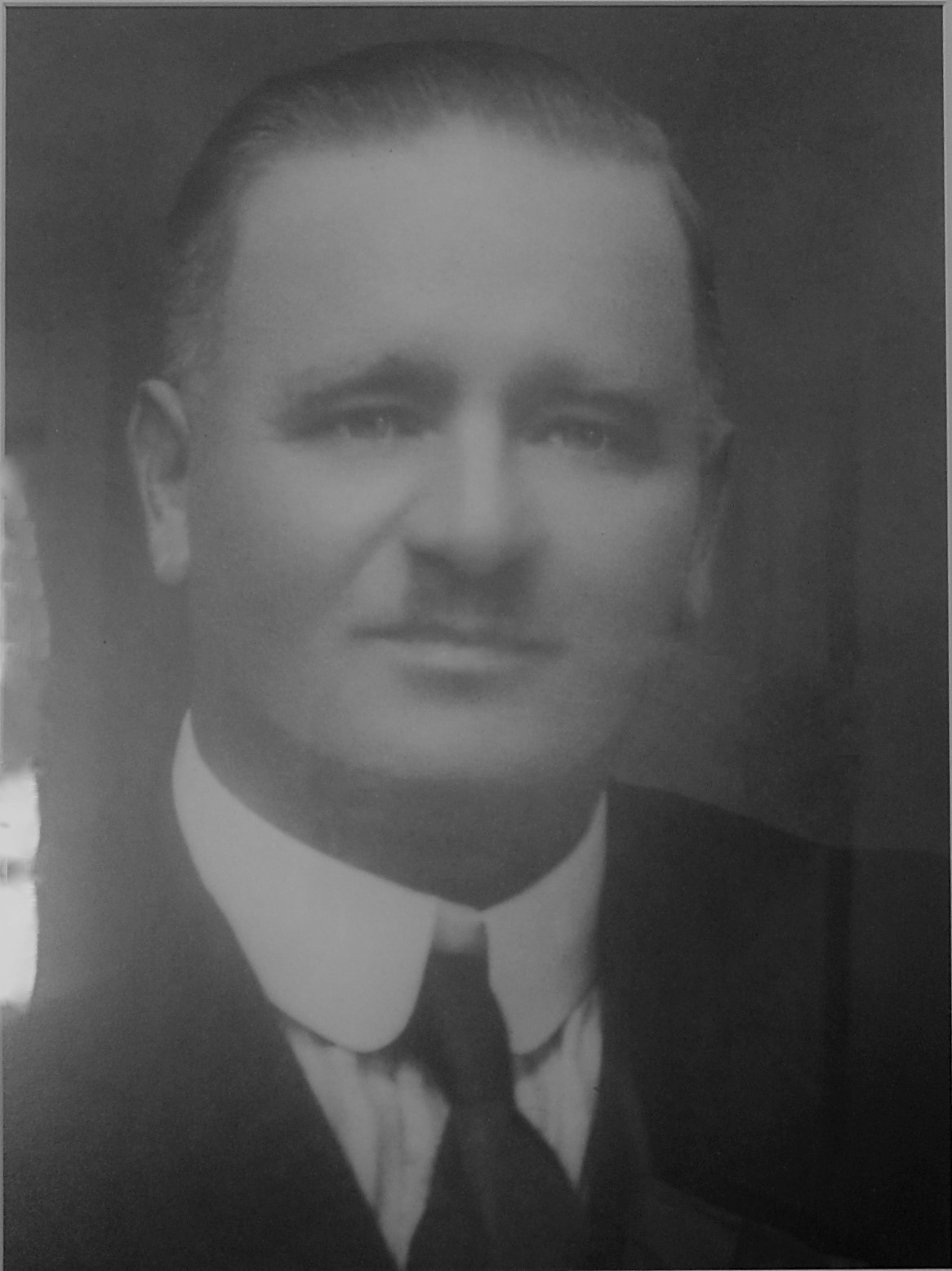
John Orr - a photo taken of a photo in the Bayview Golf Club lobby
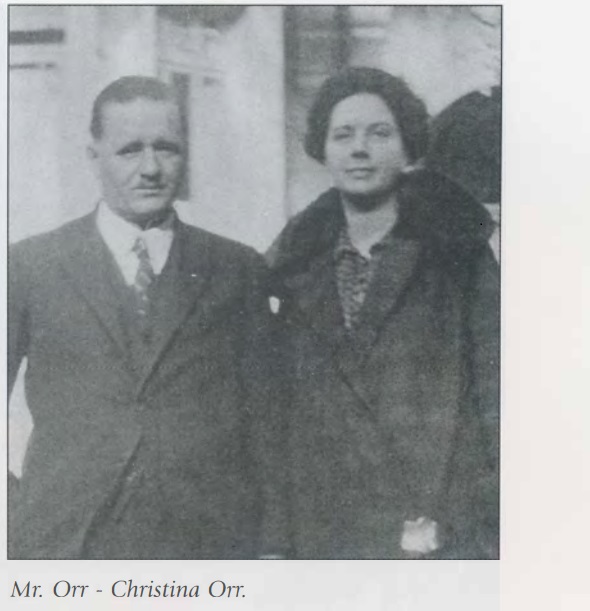
Jack and Christina Orr
.jpg?timestamp=1698691749546)
A group of flamingoes in a Mona Vale Garden, possibly the Orrs home, photo courtesy Olwyn Johnstone - bequeathed to Pittwater Local History Studies Unit at Mona Vale Library
.jpg?timestamp=1698691797631)
The elephants - original placement, and below; showing Bayview Golf Course in the background
.jpg?timestamp=1698691834242)
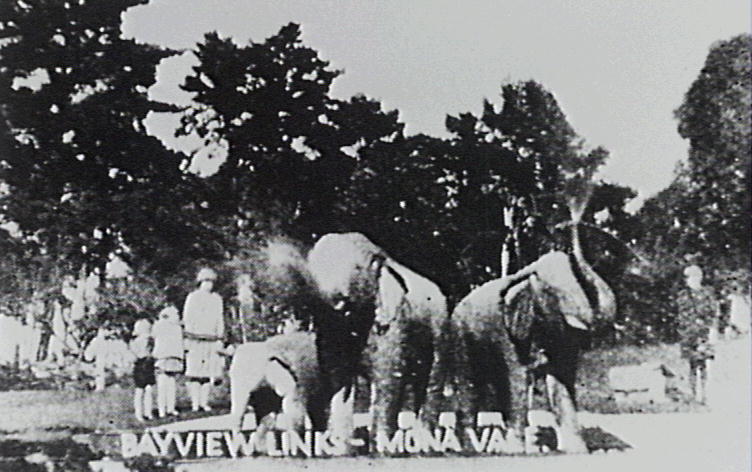
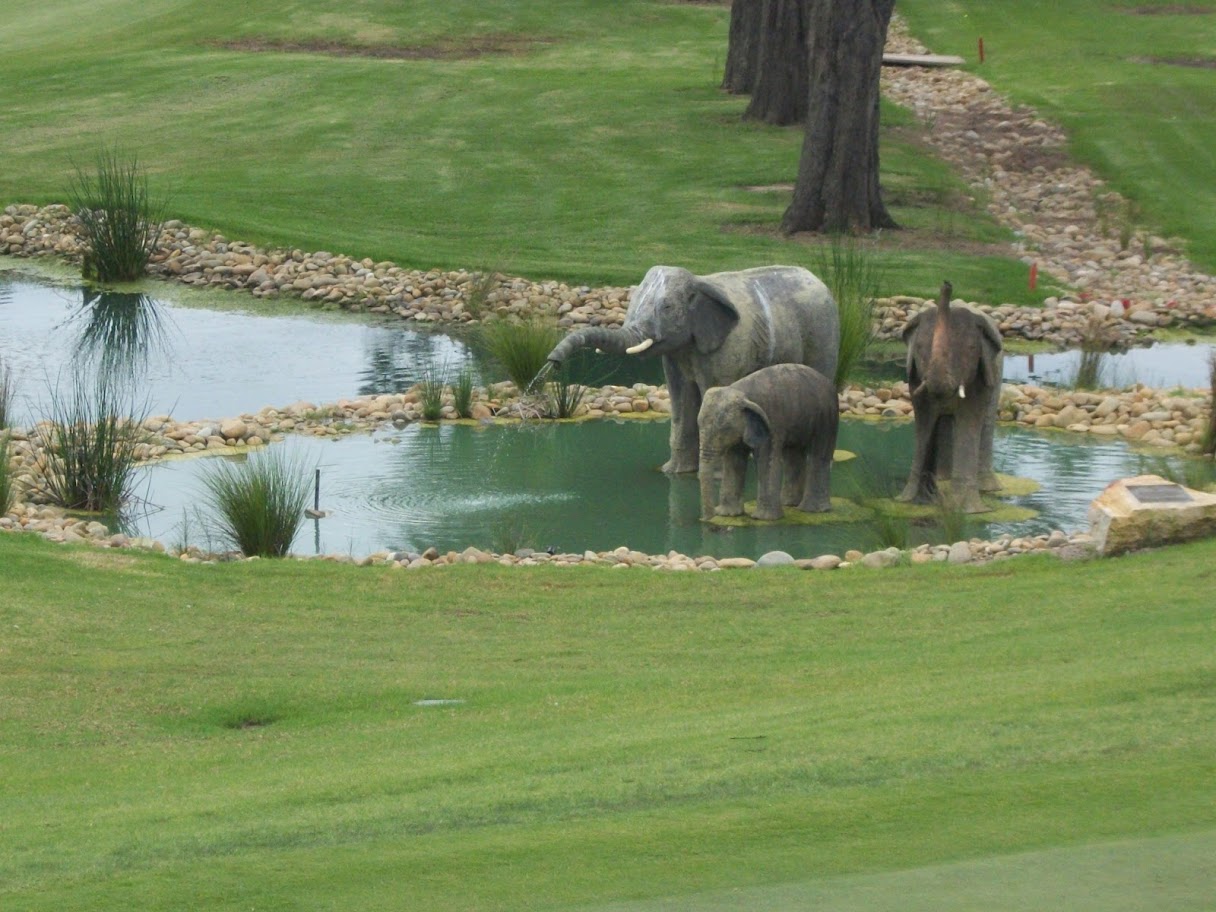
The elephants origins stem from earlier, as can be seen by the 1924 'fancy dress ball' at Mona Vale Pittwater Hall and may have been modelled on Wirth Circus elephants, which were just down the road from Harold and Mabel when they first landed in Sydney and may have been seen by them when they were still living in Tasmania:
WIRTH BROS., LTD.,
ZOO AND'HUGE ELEPHANT HERD.
WIRTH'S HIPPODROME. HAYMARKET.
The Greatest Show on Earth.
EVERY EVENING AT 8.
Preceded by a Musical Programme by the Calliope, from 7 to 7.15.
MATINEES, Wednesday. Saturday, and Holidays, 2.30.
Doors open one hour earlier.
Change of Programme.
COMPLETE NEW COMPANY OF MARVELLOUS PERFORMERS.
Specially engaged by Mr. Philip Wirth, on his recent tour of the world.
The Greatest, The Biggest, Show of all time.
PRICES for the Holidays, 7/; Reserved, 1/ extra; 0/, 5/, and 3/, plus tax.
Children Half Price in all parts, except on Saturday nights and Holiday nights.
Box Plan at the Hippodrome. Hippodrome, Tel., City 1234. Advertising (1924, April 21). The Sydney Morning Herald (NSW : 1842 - 1954), p. 2. Retrieved from http://nla.gov.au/nla.news-article16137856
OUR SYDNEY LADIES' LETTER.
FROM A WOMAN'S STANDPOINT.
[By Juliette.]
I always have such funny experiences when I am travelling about, what I mean is that I bear of strange occurrences — perhaps it is that I am so awfully interested in people that I draw their best from them, eh ? I love a circus, when I hear the claque of the riding-master's whip, and hear his 'pola' I feel that I want to be up and away. Now I am going to tell you of two curious tales connected with Wirth's Circus. When the animals were being taken over to Hobart from Sydney in the ' Westralia ' the elephant, behaving in a very story book way, it was secured in a part of the ship near the galley. The cook had to frequently ' pass by the animal. He generally gave the elephant a potato or some other delicacy. One day Mr. Cookey was in a temper, and instead of a tit bit the elephant got some hot water over him. A short time after the cook was passing leisurely by, when the enraged elephant put his trunk out, took up the man round the waist, and flung him to the other side of the deck. ' After that no one dared pass down 1 that way. The cook is still black and blue. … OUR SYDNEY LADIES' LETTER. (1909, February 18). Wellington Times (NSW : 1899 - 1954), p. 6. Retrieved from http://nla.gov.au/nla.news-article141502578
Wirths' elephant herd is the largest of any circus in the world. Fourteen of them— all highly trained— are made to earn their tucker, for Mr. Wirth has taught them to perform transport duties. Many a time they have been almost worth their weight in gold, for circuses do not stick to main roads at times. Each elephant eats a hundredweight of hay a day. See them fight for the flag each day at Wirths' at the Hippodrome. THE TEATRELAND (1925, April 8). Referee (Sydney, NSW : 1886 - 1939), p. 15. Retrieved from http://nla.gov.au/nla.news-article127573415
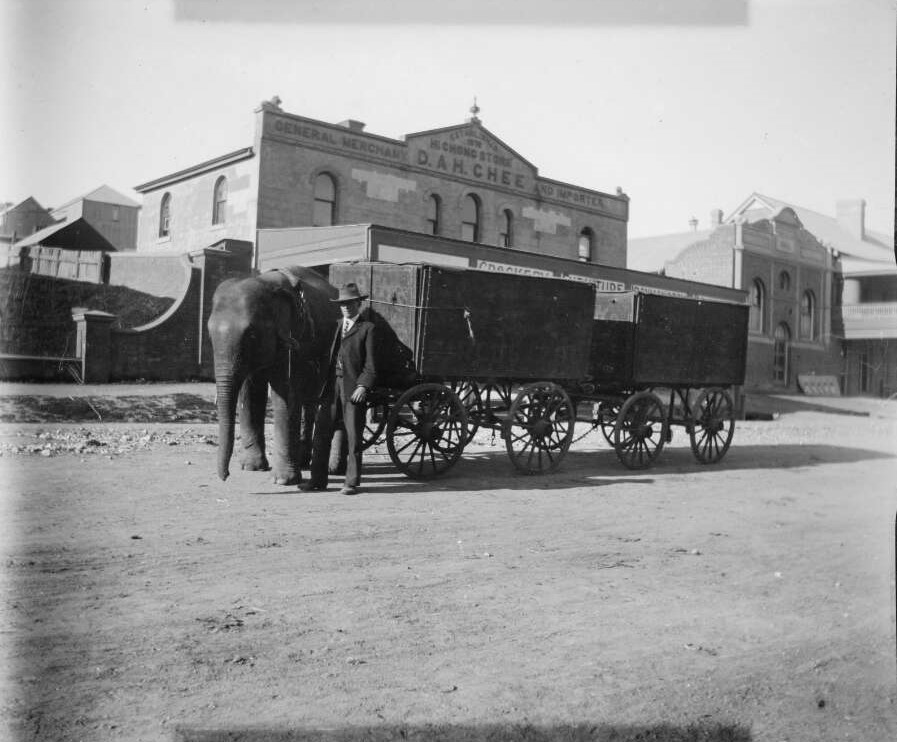
Gabriel, Charles Louis. (1887). Wirth's circus comes to town, Sheridan Street, Gundagai, New South Wales, 2 Taken between 1887 – 1927 Retrieved from http://nla.gov.au/nla.obj-139770353
Probably Mr Squires’ best known work is the black boy on the water buffalo cart which has been restored and could once be seen in E. J. Shaw’s yard on Pittwater Road. The garden at Dungarvon featured many of his native figures and animal sculptures.
Those invited inside the home state the walls were covered in murals too - of landscapes and seascapes. Residents now elderly recall going there as youngsters where the backyard was filled with aviaries so high you needed a ladder to reach the top. The couple was also known for their gentleness and kindness for all, but mostly towards children.
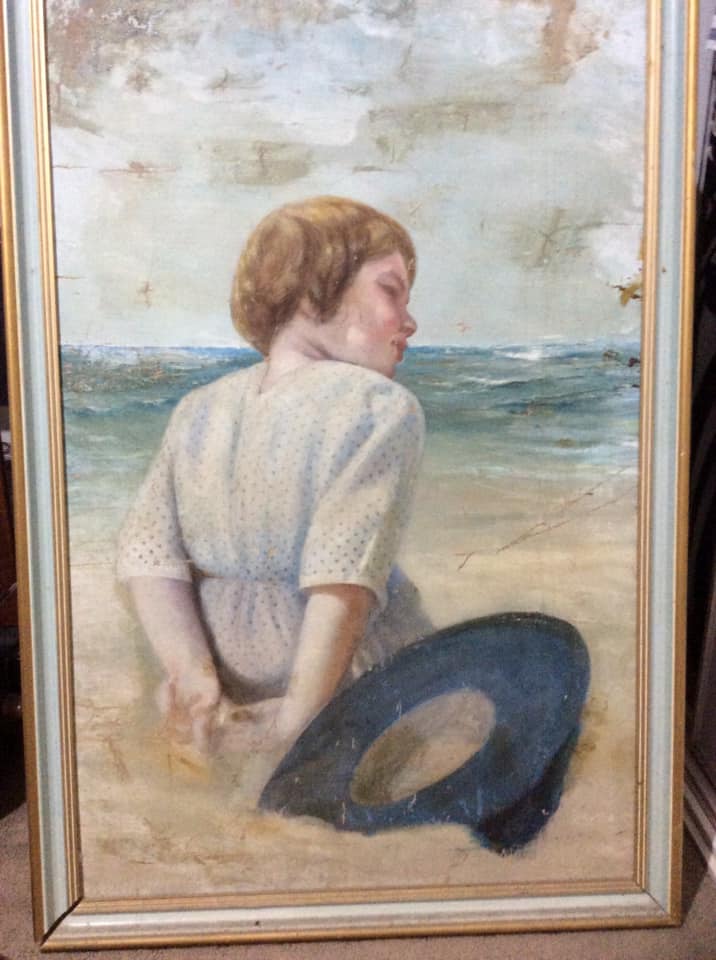
''I am Fred Thompsons' grandson and spent much of my youth living at 28 Park St. Fred bought the house in the 50s I believe at auction it was in need of a lot of work. Being a carpenter/cabinet maker and many other skills it suited him well. I remember him renovating room by room, adding a laundry and generally bringing it back to its former glory.As I look at the current picture I recall bamboo along the driveway which wasn’t paved back then, with loquat trees and Chinese gooseberry also. At the end of the driveway was a very large mulberry tree and beside that a large shed which Fred used for storage and woodwork.There were many statues throughout the property, aboriginals standing by trees, kangaroos, birds etc, I believe but can’t be sure that the cart and bullock from Shaws was originally from there as well. I remember the statues were concrete like chicken wire and then concrete over.The picture I have was given to me by mother Gloria it was part of a mural of a beach scene of Mona Vale. Unfortunately I don’t know who it is or when it was painted but remember it was on the wall in the largest room in the house and the mural took up the whole wall, I believe the rest was in poor condition and needed to be removed or covered over during the renovation.The house was used occasionally for TV, I remember a commercial being filmed there and of course it was photographed by many.On the Bayview side was Dr Spence, and 26 Park St another beautiful old house who I remember to older ladies lived in and I think there names were Ivy and Violet, I used to go visiting for cordial and cake as a kid.''
''Larry gives a good description of the place. The painting was on canvas and fitted to the loungeroom wall which had a beach mural so that it appeared as though it was all one mural. Grandad (Fred) took the canvas down and rolled it into a tube as when we moved to Queensland he had plans to sell the house. The murals were peeling.In my bedroom was a semi relief plaster figure of a woman, absolutely beautiful. The statues of aboriginal children and adults were, as Larry said, chicken wire stuffed with newspaper and concreted over, very life like and life size. I have a few photos in mums stuff (sadly passed in 2019) that I could share with you.[We have requested these and Glenys will get them to us over the next week or so - thank you Glenys - Ed./PON]Grandad said the Squires used to travel to Queensland a lot and evidence of this could be the travellers palm that used to be in the front yard. In addition to that photos were in the house when grandad bought it of indigenous peoples.I have looked at photos of the house when it was on the market before and must admit I much prefer how it was when we lived there.I have many memories of us kids climbing the massive mulberry tree that was in the back yard close to the kitchen and mum (Gloria) making baking tray sized mulberry pies. There were also mature plum and fig trees in the back yard.''
MONA VALE SCULPTOR'S NOVEL ART IN CONCRETE
At Work on Life-sized Mob of Elephants
Descendant of a family of artists and sculptors, Mr. H. Tristram Squire, of Mona Vale, has turned his ability as a modeller and sculptor in a novel direction.
His home is full of statues in concrete, and a big group on which he is now engaged is that of a life-sized mob of elephants. A flamingo in concrete causes the visitor to pause at the front gate, and a jackass and frilled lizards fraternise with life-like rabbits. Mr. Squire's plaques in concrete are in demand, and he is kept fully occupied at his work.
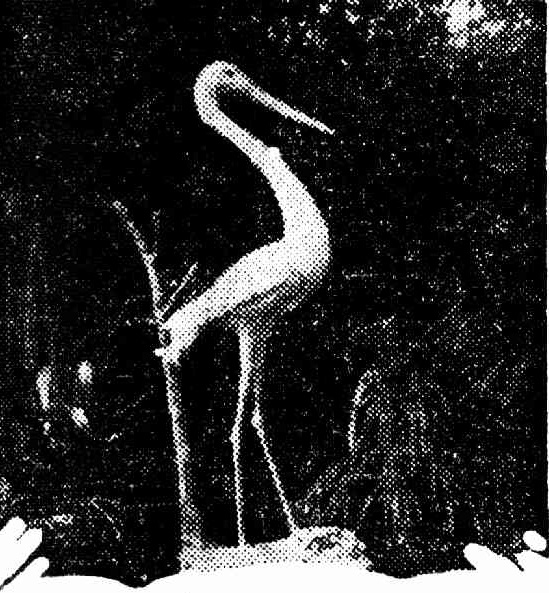
IT WOULD TAKE a big gun to scare this flamingo from his perch. He is a concrete bird.
MONA VALE SCULPTOR'S NOVEL ART IN CONCRETE (1930, May 15). Daily Pictorial (Sydney, NSW : 1930 - 1931), p. 13. Retrieved from http://nla.gov.au/nla.news-article246185285
The plaques Harold Tristram Squire was making must adorn headstones at Mona Vale Cemetery - where he and his wife were eventually laid to rest, and where, surprisingly, although it is known where they were placed, no headstone or plaque is to be found.
Records held by the Bayview Golf Club indicate that a lot of the bird sculptures made by H. Tristram Squire, and the group of elephants currently at tee 18, were commissioned by John and Christina Orr. Mrs. Orr apparently had a passion for birds which she shared with the Squire couple:
She Cultivates Birds
MRS. J. ORR, of Bayview, Pittwater, is a lover of birds, and they have a great time at her beautiful home overlooking Bayview golf links.
Lest the birds be molested, not a cat or dog is allowed on the premises, and, as a result, the wild birds are as trustful as canaries. Butcherbirds roam the verandahs, while smaller birds invade the sunny rooms, and take all sorts of liberties. Mrs. Orr-'is proud also of the fact that her garden is frequented daily by a wild magpie, said to be the only one not in captivity in the district. GOSSIP OF THE TOWN (1930, May 18). Daily Pictorial (Sydney, NSW : 1930 - 1931), p. 7. Retrieved from http://nla.gov.au/nla.news-article246176312
STATUARY STOLEN.
MONA VALE CEMETERY DESECRATED.
A flagrant act of desecration occurred at Mona Vale Cemetery within the past few days, a symbolic statue, the creation of Mr. H. Tristram Squire, having been stolen from the grave of the late Mr. Henry Moncur Atkinson.
About four months ago Mr. Atkinson, a resident of Mona Vale, died at the age of 92, and, as he was an ardent bird-lover, his niece, Mrs. O'Reilly, of Pymble, thought it would be appropriate to perpetuate his memory by a drinking vessel for the native birds with which the Mona Vale district abounds. Mr. Squire, who during recent years has specialised in statuary representing birds, animals, and aborigines, was commissioned, and a fort-night ago he placed on the grave a handsome statue of a stork, five feet high, standing over a large bowl. The latter, which was inscribed with grape leaves, was filled with water for birds to drink from.
Apparently the statuary was only in position a week when the stork disappeared. The bowl was carried a few yards, turned upside-down, and smeared with mud, the thieves apparently intending to disguise its beauty pending an opportunity to return for it. One evening at dusk a man was seen from a distance in the cemetery staggering under a heavy load, with which he drove off in a car. This was evidently the stork, which, being constructed of concrete and reinforced with iron; weighed about a hundredweight. The police, who are investigating the robbery, are puzzled as to the motive of the thieves, since the stork is signed with the sculptor's name.
Mr. Squire's work is familiar to tourists who pass along the road to Bay View and Church Point. His group of elephants is conspicuous at the Bay View golf links, and a family group of aborigines encamped about a natural pond in his grounds causes many a motoring party to stop. STATUARY STOLEN. (1935, April 10). The Sydney Morning Herald (NSW : 1842 - 1954), p. 13. Retrieved from http://nla.gov.au/nla.news-article17157874
GRAVE DESECRATED TABLET UPROOTED
A second act of desecration has occurred at the Mona Vale cemetery following the theft of a statue, the work of Mr. H. Tristram Squire, a fortnight ago.
The statue was a representation of a stork, five feet high which Mr. Squire had modelled and sculptured in cement, and erected over the grave of the late Mr. Henry Moncur Atkinson. Associated with the stork was a large drinking vessel for the native birds, of which Mr. Atkinson was an ardent protector.
After the disappearance of the stork, Mr. Squire tended the grave. He visited the cemetery again yesterday and found that the grave had been disturbed. The tablet inscribed with the name of Mr Atkinson had been torn from the ground and was upside down. The drinking bowl, a handsome engraved vessel, 15 inches in depth and two feet across, was lying on the grass. GRAVE DESECRATED. (1935, April 19).The Sydney Morning Herald (NSW : 1842 - 1954), p. 8. Retrieved from http://nla.gov.au/nla.news-article17168390
MR H. M. ATKINSON.
Mr Henry Moncur Atkinson, who died recently at Munnell, Mona Vale, was born in 1839 at Singleton. He was the eldest son of the late James Henry Atkinson, who was well known in the early life of the colony, and who introduced wool scouring into Australia at the Collingwood scour, Liverpool, where he resided for many years. Mr. H. M. Atkinson had an excellent memory, which remained clear and accurate to the last. He had made three voyages to England before he was 20 years of age, and vividly remembered the departure of troops for the Crimean War. An accident as a child having destroyed his hearing, he lived a retired life, but always took a keen interest in current events. The late Mrs. Brodhurst-Hill and Miss Louisa S. Atkinson (one-time secretary of the Kindergarten Union of New South Wales) were his sisters. MR. H. M. ATKINSON. (1934, November 21). The Sydney Morning Herald (NSW : 1842 - 1954), p. 10. Retrieved from http://nla.gov.au/nla.news-article17127759
Why The Spear Was Stayed —
STORY OF GRIT AND SILENCE
"EVERY muscle tense, an aboriginal chieftain stood poised over a pond in a Mona Vale garden yesterday, his hunting spear drawn back for the deadly thrust. Although the carp beneath him was an easy target, the spear was not launched, for realistic though the figure is, it is made of cement, not flesh and blood. He is one of the many works modeled by Mr. H. Tristram Squire, whose garden is filled with life-like representations. Kangaroo and wallaby, lizard and snake are mingled with a dozen flamingoes, whilst a group of children stand quietly looking on.
The interior of the house is no less remarkable than the garden.
"Blank walls are hard and damaging to the sight," said Mr. Tristram Squire yesterday, whose walls are painted to represent land and seascapes. "The effect of a distant scene keeps the eye at a more or less natural range."
Mr. Squire told of a large, black snake that he recently made for a friend, who placed it in a natural position among some bushes in his garden. The next morning the snake was smashed by an alarmed milkman.
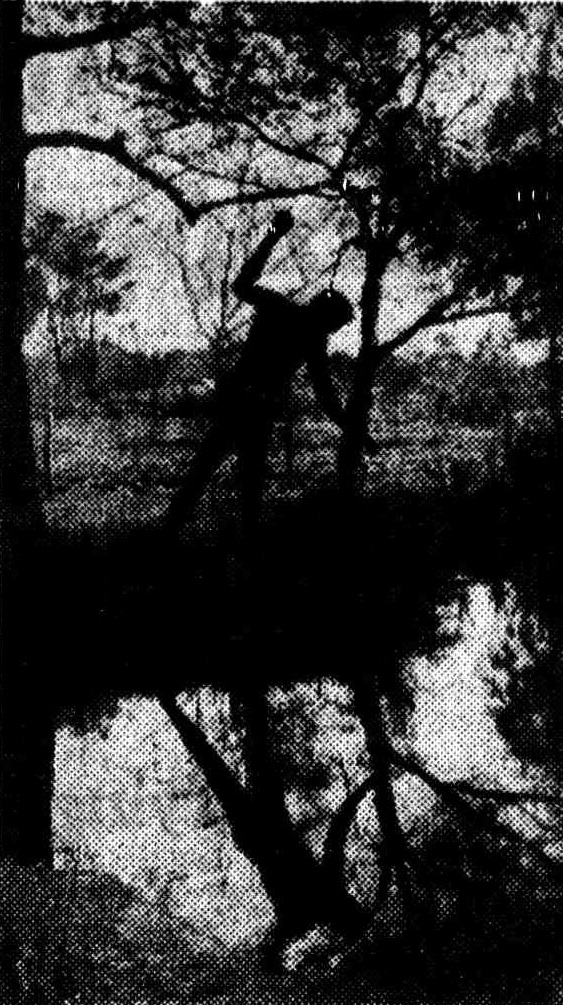
MR. SQUIRE'S immobile aboriginal.
Why The Spear Was Stayed (1935, May 14). The Daily Telegraph (Sydney, NSW : 1931 - 1954), p. 7. Retrieved May from http://nla.gov.au/nla.news-article246472427.jpg?timestamp=1698691910924)
Harold's work in the backyard of Dungarvon - from newspaper clipping
Warringah Shire Council Minutes of Meetings Records:
39. H. Tristram Squire, 9/6/37, requesting permission to place his statuary group - "blackfellow spearing water buffalo", at the intersection of Park Street, Bassett Street and Bayview Road. Resolved, - That he be granted permission. (Crs. Hewitt, McPaul)
BLACKFELLOW STATUE REFUSED
Permission for the erection of a statue of a blackfellow spearing a water-buffalo, at the intersection of Park, Bassetts, and Bayview Roads, Mona Vale, has been refused by Main Roads Board. One reason given was that the policy of the board was against the placing of objects on the road which might distract a driver's attention. The statue is a life-size one by a Mona Vale sculptor, Mr. H. Tristram Squire. BLACKFELLOW STATUE REFUSED (1937, June 17). The Daily Telegraph (Sydney, NSW : 1931 - 1954), p. 3. Retrieved from http://nla.gov.au/nla.news-article247138983
17. Tristram Squire, 19/1/38, declining to erect his statuary in the position suggested by the Main Roads Department, but offering to remodel the water-trough at Bayview Road-Newport Road junction "combining the water-trough's utility with a handsome and-original setting', designs of which work may be seen at his address. Resolved, - That the Main Roads Department be asked to approve of the proposal. (Crs. Latham', Batho)
The H. T. Squire sculpture entitled 'Peter and the water Buffalo' has a bit of a story that goes with it. In ‘Mona Vale Stories', compiled by Guy and Joan Jennings(2007) it is recorded that an elderly farmer Mr. Rundle, who had a roadside fruit and vegetable stall, wanted to improve sales and, as he had previously lived in Darwin and had employed an indigenous Australian by the name of Peter to transport his produce on a cart pulled by a water buffalo, came up with the idea of making a sculpture of the same for his stall. Harold Squire was commissioned to make the statue. However, this didn’t work out for Mr. Rundle, who then on sold the statue of Peter and the Water Buffalo to a Mr. Noble, who had a better site, and perhaps could get permission to install the sculpture.
A Life-like Model of a Water Buffalo.
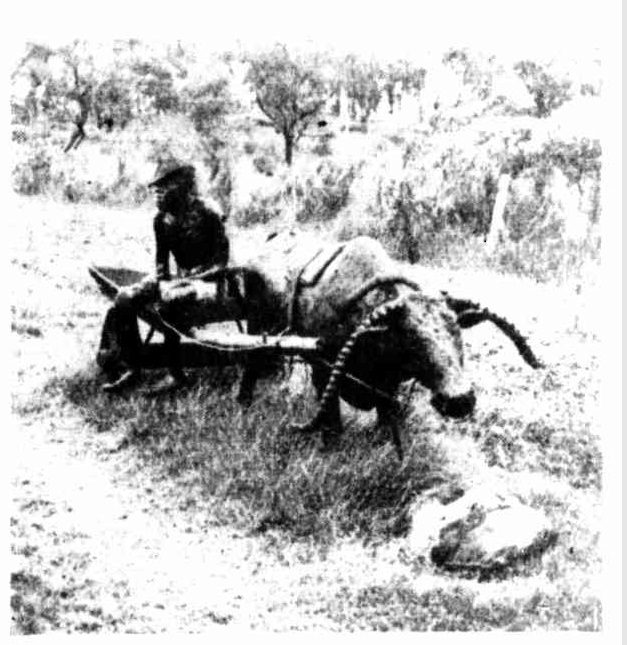
THIS realistic -looking water buffalo and its driver stand near a road-stall on the Pitt water Road, Mona Vale (near Sydney), and are seen by thousands of motorists driving to Palm Beach every week. In the vicinity are many other models — of elephants, kangaroos, flamingoes; in fact, all kinds of animals and birds equally as life-like. Most surprising is the life-size model of an aboriginal standing with poised spear among the bushes at the end of a little-used paddock. The models are the work of a local artist. — N.G. A Life-like Model of a Water Buffalo. a survey and Some Opinions (1938, March 30). Sydney Mail (NSW : 1912 - 1938), p. 6. Retrieved from http://nla.gov.au/nla.news-article166229605
A little about the Rundles and Nobles of Mona Vale during this era:
GOLDEN WEDDINGS.
RUNDLE-STEVENS.-October 10, 1889, at St. Mary's Church of England, Waverley, Sydney, by the Rev. R. McKeown, Henry Alfred George, eldest son of the late Mr. and Mrs. S. H. Rundle, of Beechworth, Victoria, to Mary Edney, eldest daughter of the late Mr. and Mrs. John Stevens, of Beechworth, Victoria. Present address, Mindel, Pittwater Road, Mona Vale. Family Notices (1939, October 21). The Sydney Morning Herald (NSW : 1842 - 1954), p. 14. Retrieved from http://nla.gov.au/nla.news-article17633681
SHIRE TO PAY DAMAGES
GARDENER'S CLAIM
SYDNEY, Friday: A District Court jury, awarded Harold Victor Noble, market gardener, of Mona Vale, £350 damages against Warringah Shire Council. Noble sued the Council oil grounds alleging that as a result of its negligence in maintaining drains, water flowed through his property and caused loss of large quantities of tomato plants and 150 cubic yards of subsoil from his farm. The council denied negligence and alleged contributory negligence. SHIRE TO PAY DAMAGES (1950, May 20). National Advocate (Bathurst, NSW : 1889 - 1954), p. 1. Retrieved from http://nla.gov.au/nla.news-article161221998
NEGLIGENCE CLAIM
Verdict Against Council
A District Court jury yesterday awarded £350 damages to a Mona Vale market gardener against the Warringah Shire Council. The plaintiff, Harold Victor Noble, Ellimatta Road, Mona Vale, said that because of negligence by the Council in the construction and maintenance of road drains, rain water last year flowed through his property destroying thousands of tomato plants.
The Council denied negligence and alleged contributory negligence.
Noble's son, Bruce Victor Noble, who worked the property which his father owns, also claimed damages on his own behalf.
On this claim the jury, by direction of Judge Holt, returned a verdict for the defendant, on the ground that Noble junior was not entitled to damages because he did not own the property. NEGLIGENCE CLAIM (1950, May 19). The Sydney Morning Herald (NSW : 1842 - 1954), p. 5. Retrieved from http://nla.gov.au/nla.news-article27573029
NOBLE.—December 8, 1954, at Manly Hospital, to Betty and Bruce —a daughter (Anne Elizabeth). - Sydney Morning Herald Family Notices
Harold Tristram Squire passed away on May 16th 1938 and was interred at Mona Vale Cemetery, Section A of the Anglican section, on the 18th of May. The Sydney Morning Herald ran this Tribute 10 days later:
OBITUARY.
MR. H. TRISTRAM SQUIRE.
Mr. H. Tristram Squire, of Mona Vale, died this week, aged 69 years. Mr. Squire was a native of Victoria, and as a youth studied art with Sir John Longstaff and Sir Arthur Streeton. He developed especially as a portrait painter and sculptor, and in recent years devoted much time to modelling of life-sized figures and groups of animals. In the garden of his home at Mona Vale are several groups of aborigines one of which depicts black-fellows spearing fish in a natural pool.
Mr Squire was a lover of animals. His garden is the home of opossums, wallabies, kookaburras and aviary birds, many of which would perch fearlessly upon him. He is survived by Mrs. Squire, who is also an artist. OBITUARY. MR. H. TRISTRAM SQUIRE. (1938, May 28). The Sydney Morning Herald (NSW : 1842 - 1954), p. 16. Retrieved from http://nla.gov.au/nla.news-article17469079
His works were still appearing in newspapers and remain, in Peter and the Water Buffalo, and the Bayview Golf Club elephants on Hole 18, part of the places he once strolled through and a tribute to those who came before us, marked with respect in the case of Bayview Golf Club and perhaps symbolic of the friendship between the Orrs and the Squire couple, who had been married for close to 48 years by the time Harold passed away, and had been among some of the great shifts Australia went through from the 1850's on.
GLASS-HOUSE TOMATO-GROWING AT MONA VALE.
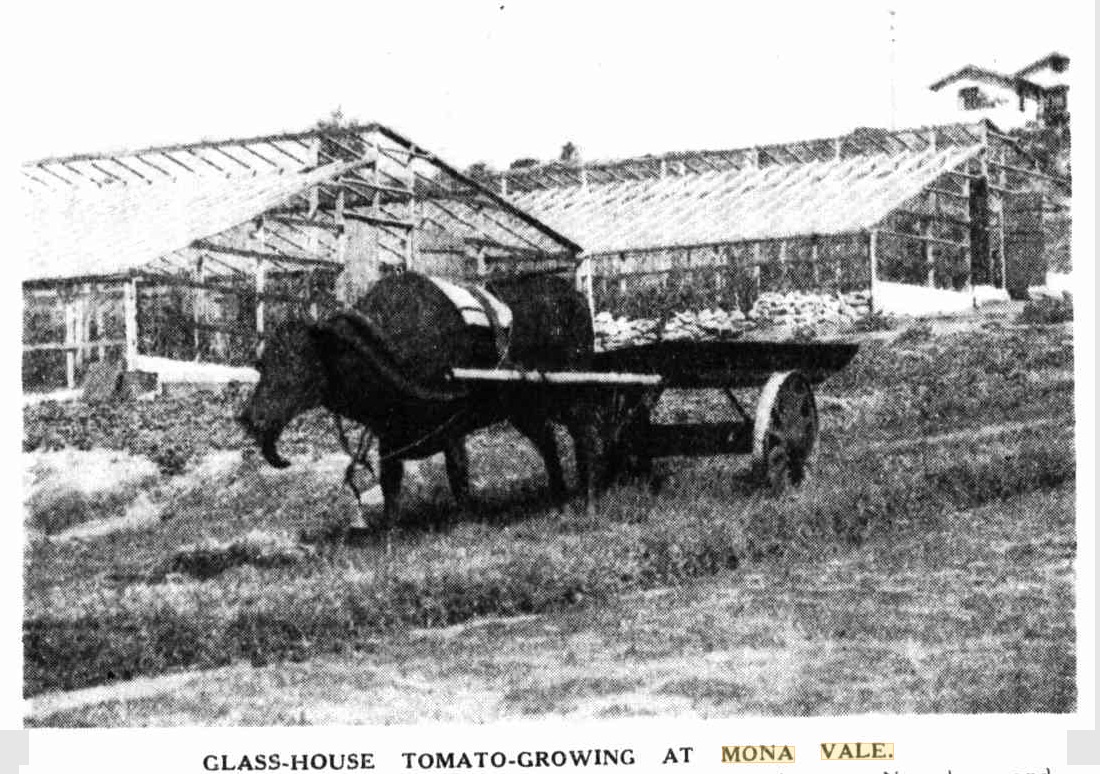
Large quantities of early tomatoes are grown at Mona Vale, between Narrabeen and Newport, Sydney, the glass-house system there having proved very successful. Disease has to be guarded against by stringent precautions and treatment, but, with clean crops, the returns are highly remunerative. The buffalo in the picture, although wonderfully realistic, is made of cement. GLASS-HOUSE TOMATO-GROWING AT MONA VALE. (1938, November 2). Sydney Mail (NSW : 1912 - 1938), p. 39. Retrieved from http://nla.gov.au/nla.news-article166526289
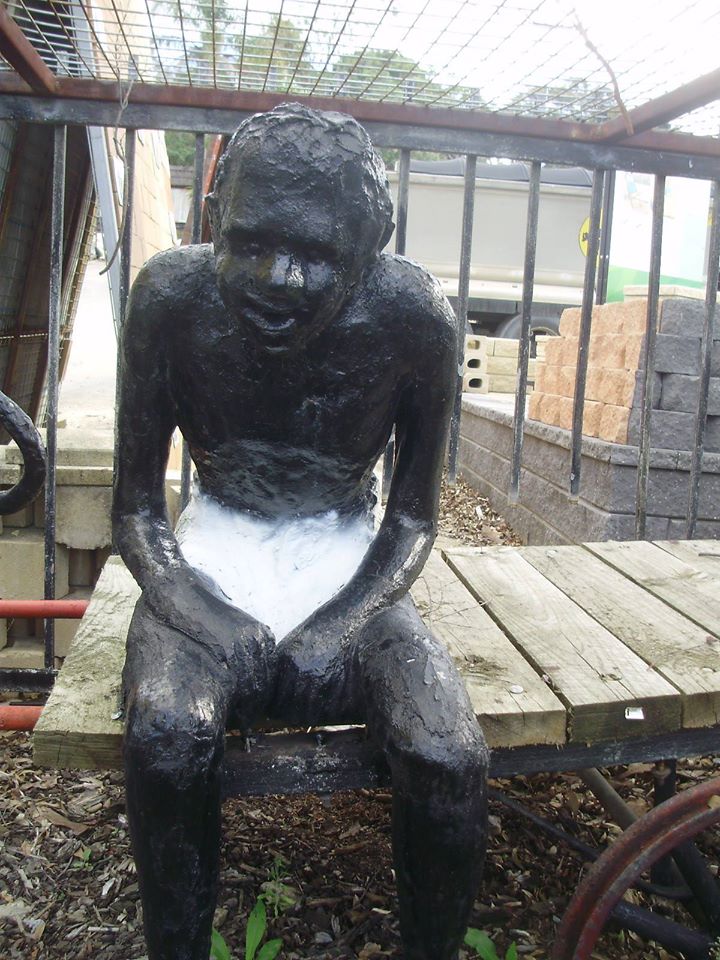
''Peter'' in 2011 photo by and courtesy Dave Murray
Peter and the water buffalo - from Manly Warringah Pittwater Historical Society records - published in Mona Vale Stories by Guy and Joan Jennings - note the difference between the 1930's 'Peter' and that of 2011, particularly around the mouth - it seems there was a substitution somewhere along the way for another of H Tristram Squires' many aboriginal creations.
Mabel continued to live at Mona Vale - and continued in her Art Practice in many ways. The Australian National Archives records:
AUTHOR Mabel Eunice Squire : ADDRESS Sydney : TITLE OF WORK ''Universal Maps of the Heavens for Any Latitude or Place'': TYPE OF WORK Literary : APPLICANT Mabel Eunice Squire : DATE OF APPLICATION 13 Aug 1931 : DATE COPYRIGHT REGISTERED 18 Aug 1931 : WORK ENCLOSED? Yes. 1931 - 1931
A universal map, represents the whole surface of the earth and sea; such is ... all places, except seas, woods, and deserts, are here laid down. No record of this work being published, or the artworks it contains, could be found.
Her friendship with Christina Orr persisted even after her husband 'Jack' Orr passed away, with anecdotes published in Guy and Joan Jennings' ''Mona Vale Stories'' and the Bayview Golf Club's Histories speaking of Christina sending butter to the Squire home during WWII when such foods were rationed and scarce and that the garden remained filled with his works, scaring the small local children sent forth on this butter delivering mission.
ORR.-November 3, 1941, John Orr, of Bayview and Papakura, Gisborne, New Zealand, and loving husband of Christina Orr, and second son of the late Mr. and Mrs. John Kirrit Orr, of Hawkes Bay, New Zealand. Family Notices (1941, November 4). The Sydney Morning Herald (NSW : 1842 - 1954), p. 15. Retrieved from http://nla.gov.au/nla.news-article17771998
Mabel's sister Beatrice Annie Harvey passed away at Ryde in 1943. Her sister Helen seems to disappear - no further records of her could be found.
Mabel Eunice Squire passed away on the 27th of March 1957, aged 92, and was buried with her husband on March 29th. Despite his work at making 'plaques' no headstone or plaque marks their final resting place in Mona Vale Cemetery at present - any that was there has gone. Their graves are in the old section of the cemetery 'COE-A-000' (Church of England), marked by driven into the ground yellow pegs where council has identified remains of them, and others, but with any memorials that had been present gone - perhaps the victims of yet more thieves and vandals in a place where all visitors entering should do so with great respect:
An exhaustive search over a few years has failed to find any of their earlier paintings, despite good descriptions of them, and Harolds' in particular as having a red haired girl in one, a good understanding of perspective and filling frames with light, and being proficient at 'fine, delicate and detailed' work.
With 58 years of work at least done by the time he left the mortal plane it seems all these must be held in private collections and considered too good to resell, or perhaps his seeking the light in backroads, the moonlight along rivers, and rural peace instead of cultivating society and publicity means those who hold his works, signed, are unaware of the long road travelled from there to here to give them such visions and that they hold something of greater value than would appear at first glance.
His fine and delicate work remains with us in these treasures - thanks to Bayview Golf Club.
References
- TROVE - National Library of Australia
- State Library of Victoria
- David Potts, 'Bindon, Samuel Henry (1812–1879)', Australian Dictionary of Biography, National Centre of Biography, Australian National University, http://adb.anu.edu.au/biography/bindon-samuel-henry-2994/text4377
- Mona Vale Cemetery - Online records of Deaths and Burial dates
- Guy and Joan Jennings. Mona Vale Stories. 2007. Arcadia Publishing, Newport, N.S.W.
- Taramatta Park, Mona Vale
- A Historic Catalogue And Record Of Pittwater Art I – Of Places, Peoples And The Development Of Australian Art And Artists: The Estuary
- Historic Catalogue And Record Of Pittwater Art I: Coastal Landscapes and Seascapes
- Historic Catalogue and Record of Pittwater Art I: Artists and Artists Colonies

|
ADM-196-6-341 Lt William Squire Ships Lists again National Archives UK.pdf Size : 157.157 Kb Type : pdf |

|
Harolds Birth Cert_178802-2020.pdf Size : 181.223 Kb Type : pdf |

|
Fanny Mabel Squire Death Certificate Spet 13 1859 Cert_259417-2020.pdf Size : 169.331 Kb Type : pdf |
Extras
IN A NEW EDEN: SOUTHERN TASMANIA BY RANDOLPH BEDFORD (1895, March 12). The Kerang Times (Vic. : 1889 - 1901), p. 1 (SUPPLEMENT TO KERANG TIMES). Retrieved from http://nla.gov.au/nla.news-article221109748
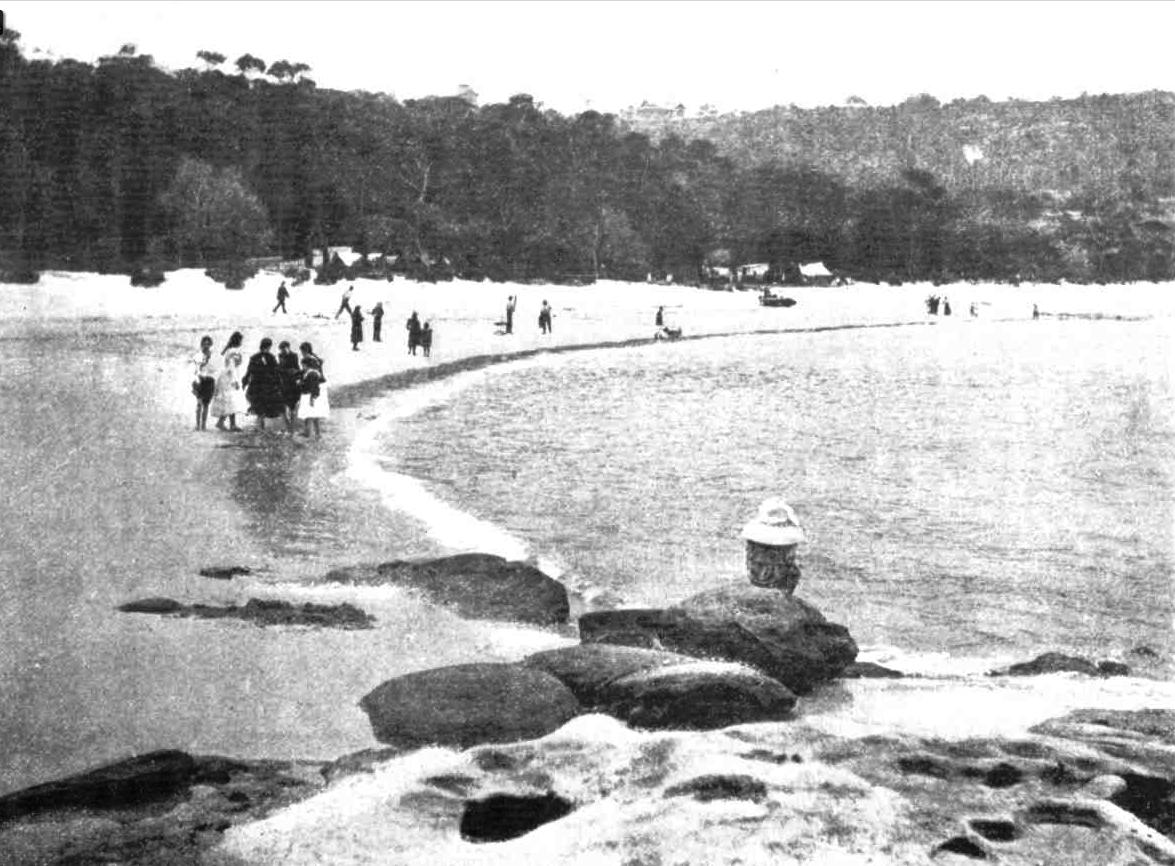
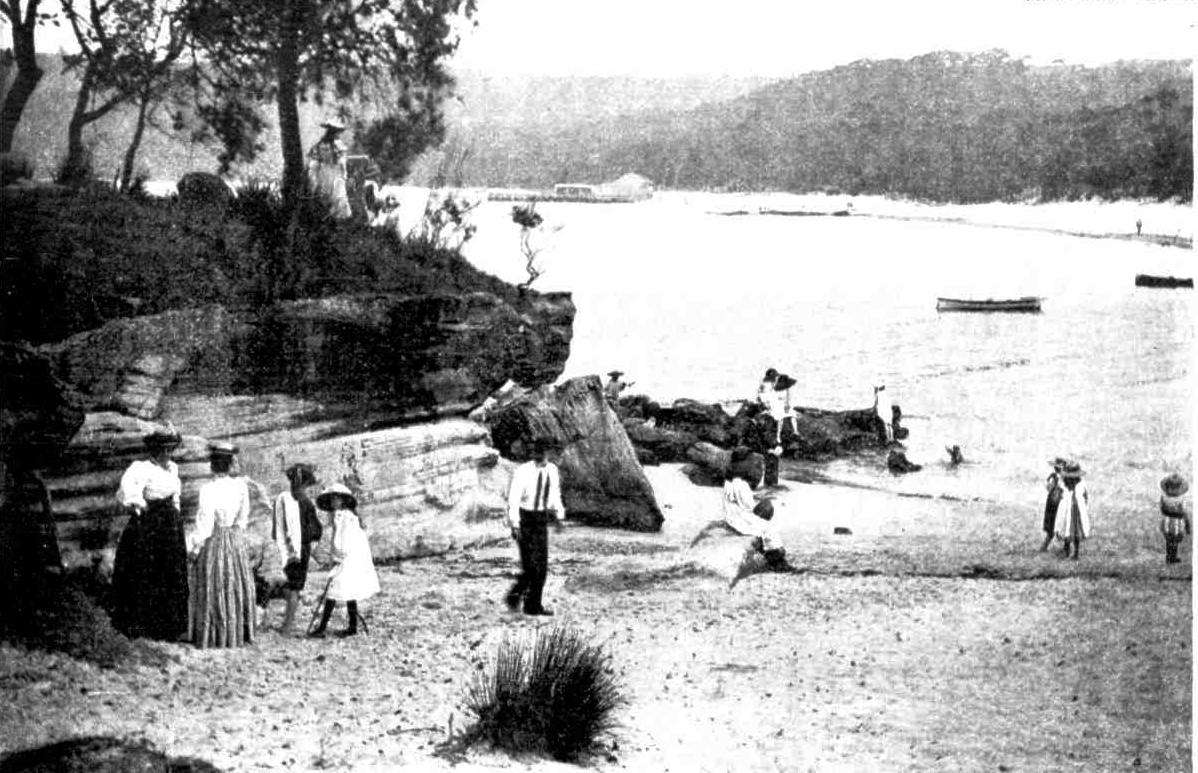
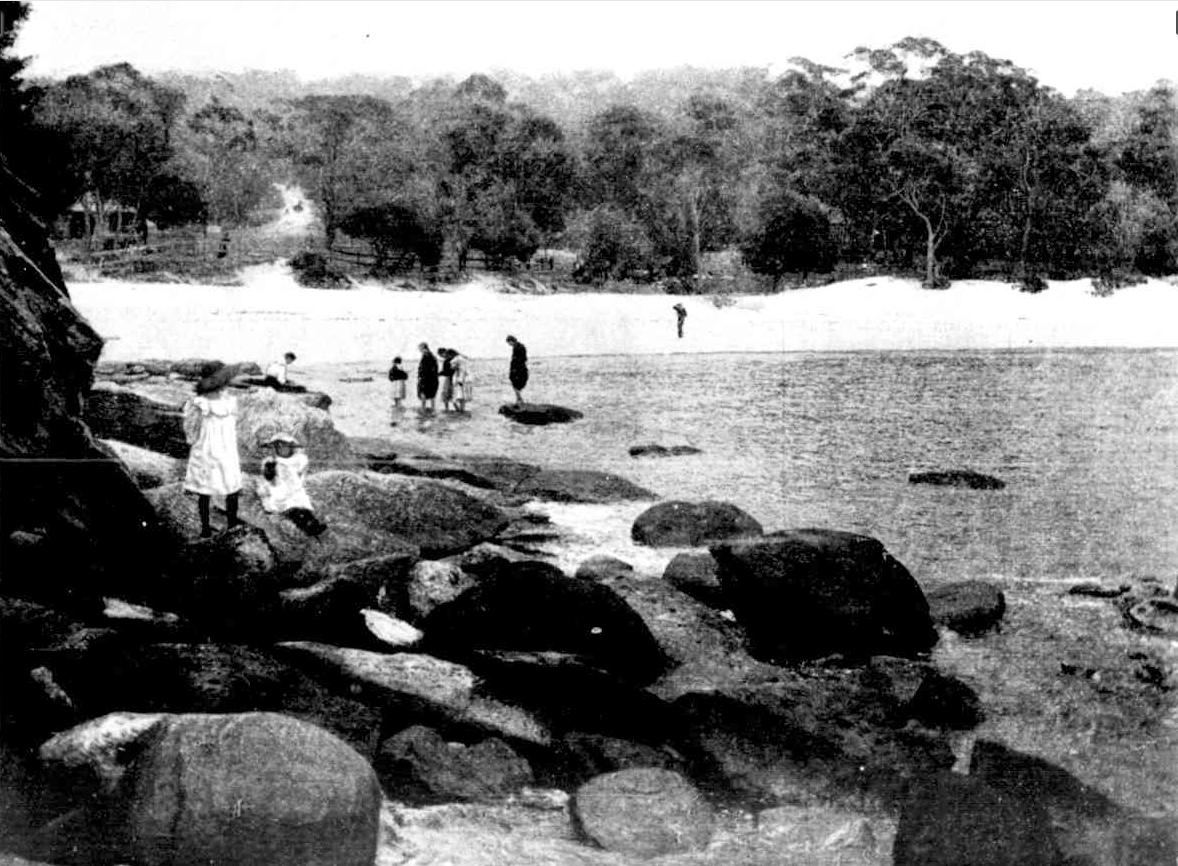
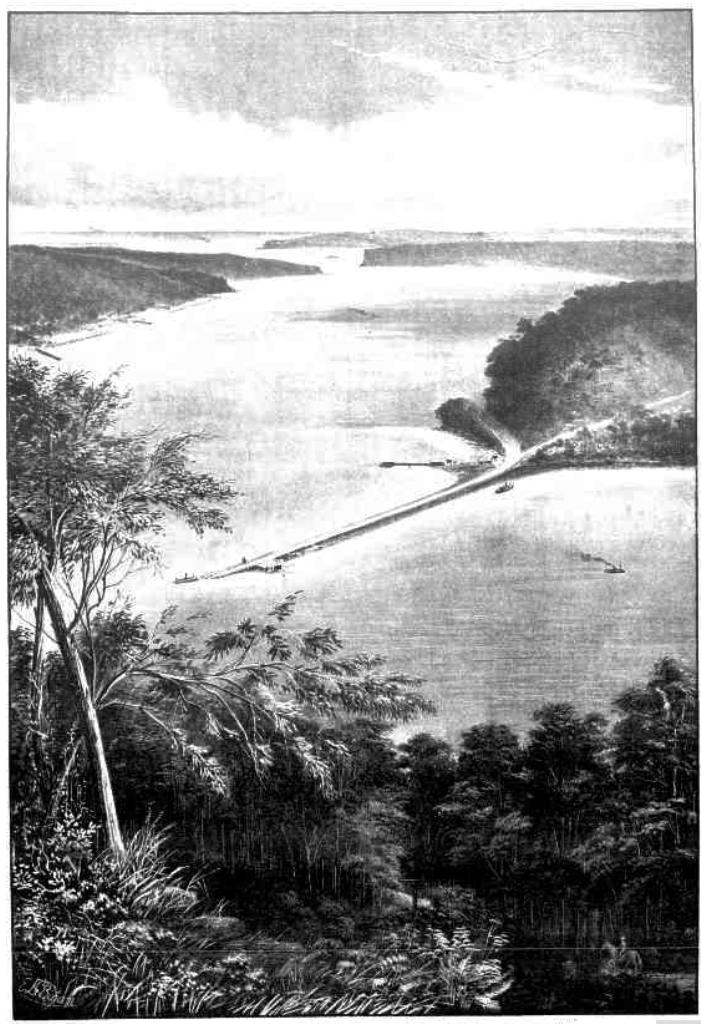
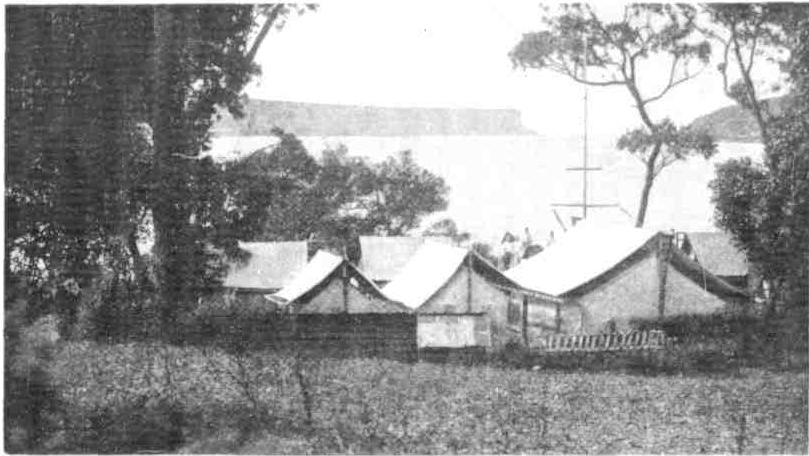
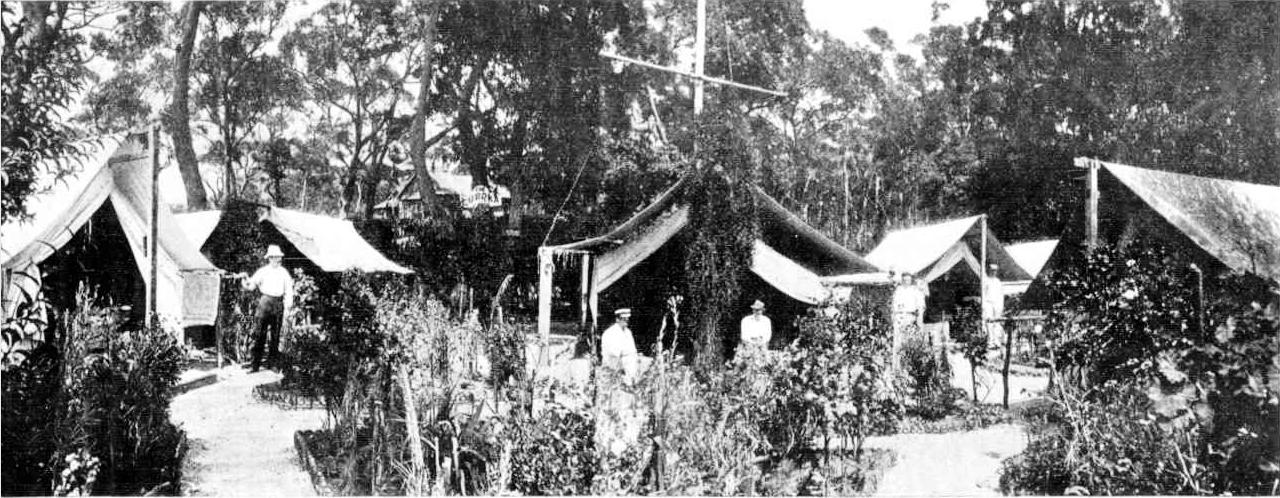
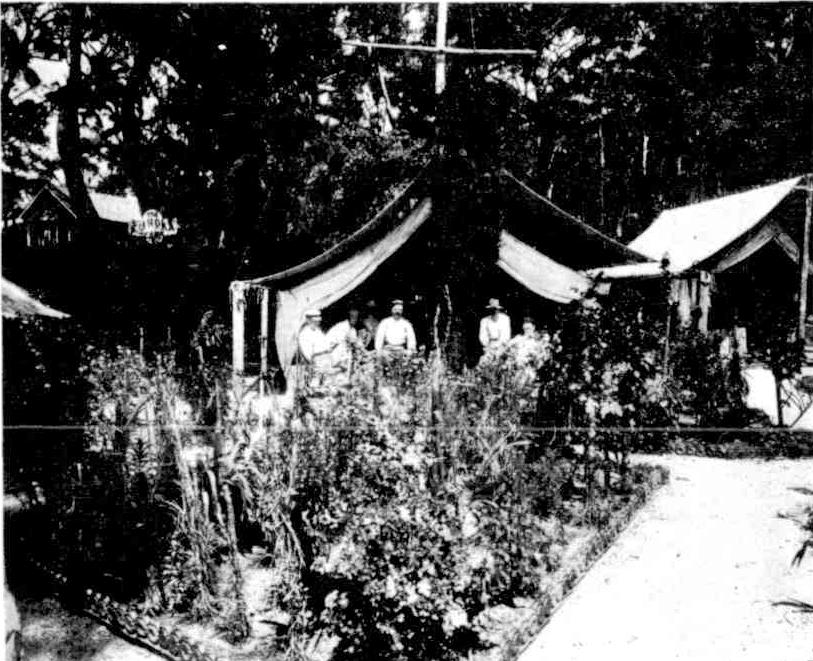
AN IMPRESSION EXHIBITION
The very title of an exhibition styled as above, to be opened at the Buxton Gallery this afternoon, is provocative of inquiry and speculation It may be well, therefore, to premise, before treating of the exhibits more particularly, that the objects on view are neither casts nor engravings, but the product in oils, more or less, 9 inches by 5 in dimensions, of artists on canvas or in clay who possess the rare faculty of recording what strikes them from an artistic point of view, such record to be available for a finished work should the artist hereafter feel the divine afflatus of reproduction.
In other words, the Impression Exhibition, collected and shown by Messrs. Tom Roberts, Chas. Conder and Arthur Streeton, may be defined as an exemplification of Dr. Aitkins and Mrs. Barbauld's didactic sketch, entitled Eyes and No Eyes, or the Art of Seeing, in the form of a choice assemblage of rapid sketches in oil, color being the quality most sought after, the original millboards being neatly framed, deftly set off by hangings and other accessories in the Kalizoio fashion, and offered to the purchasing public at extremely modest prices, on the principle apparently that a half-hour's work is worth but a half-hour's pay. The fallacy of such a theory is sufficiently demonstrated by the fact that one of Landseer's most popular works — The Challenge — now priceless, was drafted on a sheet of blotting paper for Lady Blessington, and that Holmnn Hunt's most ambitious pro ductions, involving five years of labor, have been reduced to the level of oleographs by excessive elaboration. The objects of the exhibitors are stated in their sumptuous catalogue, tyr a quotation from Geronic, to the effect that if painting, as contra distinguished from drawing, the general impression of color is of primary importance, and in their own address to the public, as follows : —
" An effort is only momentary, so an impressionist trusts to find his place. Two half-hours we never alike and he who tries to paint a sunset on two successive evenings must be more or less painting from memory. So, in these works, it has been the object of the artists to render faithfully, and thus obtain first records of effects widely differing, and often of cry fleeting character."
It was well pointed out in an excellent illustrated article on Coret, which recently appeared in the Century Magazine, that the rapid handling and brushwork of this muster, and, it might be added, bf mun-kacsy and others, apparent in their finished pictures, is in reality the result of years by study and of sketches innumerable. It is on record that Mozart wrote his finest overture, that to Don Giovanni, in an incredibly short space of time, but the whole scheme and abstract, so to speak, of the grandest of grand operas were already in the brain of the composer, and their transmission to piper was merely a mechanical act. Thus the "impressions " on the walls of the Buxton gallery are but the shadows of coming events, more charming it may be in some instances, from their simplicity and truth than the inord labored works of which they are in fact the parent. It is only to be regretted that the exhibition does not possess greater catholicity, and tin; so few artists have opened their portfolios to nil to grace the walls, which are in truth harrdly adequate to accommodate what has been already been contributed. Of the works in general it is unnecessary to speak in detail.
Their producers ask rities to appraise them from the spectators' point of view, and merely claim for tliera that they are records, truthful so far as their authors are competent to record their impressions of scenes, and more particularly the color pervading those scenes, of what struck the artist as noticeable. An early morning scene on the Thames Embankment, a sketch in Venice, and other neutral tinted drawings, by Mr. Tom Roberts, contrast with his daring one of color in other subjects, in which line he is even surpassed by Mr. Chas. Conder. Mr. Arthur Streeton is so truthful and conscientious in his sketches of Victorian scenery that his admirers feel a sense of regret that so natural an artist is not studying in Paris or London. Mr. Richardson contributes a pair of nice wax modellings and a few sketches; and Mr. McCubbin is also represented. With these exceptions the artists of the colony are conspicuous by their absence, although more than one have already shown work of the same clubs. A little humor is here and there observable, as in the fcitlos of Nos. 122 and 25. This interesting exhibition will be open for about three weeks, afternoon tea being provided for the delectation of the ladies, as well as musical and other attractions, more particularly on Wednesday afternoons. AN IMPRESSION EXHIBITION (1889, August 17). The Age (Melbourne, Vic. : 1854 - 1954), p. 15. Retrieved from http://nla.gov.au/nla.news-article197330557
Australians in the 1880s were the richest per capita in the world. The gold rushes had brought people, money and ideas flooding into a rapidly expanding Melbourne. Between 1881 and 1891 the city’s population swelled from 268,000 to 473,000. The visiting English journalist George Sala named the metropolis, ‘Marvellous Melbourne’. By the 1880s a sense of nationalism was building in the Australian population. People were yearning for stories and imagery that resonated with their newfound sense of identity.
Australian culture
The strong economy and a cosmopolitan population promoted a healthy appreciation of the arts, which saw the establishment of the National Gallery of Victoria in 1861 and the National Gallery School in 1870. The latter became the primary training institution for young artists in the colony. The first master of painting at the School was the Austrian expatriate Eugene von Guerard. He modelled the School on the European academies in which he had been educated. Early students included Tom Roberts, Arthur Streeton and Charles Conder.
Tom Roberts
In 1869, at the age of 13, Tom Roberts moved with his family from England to Melbourne. As a teenager he worked as a photographer’s assistant during the day while studying art at night and eventually began classes at the National Gallery School in 1874. After finishing his studies, he was encouraged by his teachers to train overseas and the School awarded him a travel bursary. Roberts was one of the first Australian artists selected to study at the prestigious Royal Academy of Arts in London. Roberts travelled and painted in Europe between 1881 and 1885. In Spain in 1883 he met the artists Ramon Casas and Laurea Barrau who introduced him to Impressionism.
Impressionism
Impressionism was a new and exciting art form sweeping the world in the late 19th century. It originated in France but quickly spread across Europe in the 1870s and 1880s. Impressionists focused on quickly rendering the transient light and colour of a scene using rapid, loose brushstrokes to highlight the immediacy of the impression. Painting en plein-air (in the open) was a major feature of Impressionism. Sketching outdoors had been popular since the 18th century but typically artists had used these images as studies, which became the basis of more finished studio works.
Roberts and Australian Impressionism
On his return to Australia in 1885, Roberts wanted to pass on his newfound approach and knowledge to his Melbourne colleagues. In 1886 a core group of artists established their first ‘Artists’ Camp’ at Box Hill on the eastern outskirts of the city. There they painted Impressionist pieces en plein-air. Another camp was later established in Heidelberg and the artists also painted in the city’s seaside suburbs. At these locations the painters focused on the distinctly Australian landscape and light. The paintings were also influenced by naturalism, another growing school of European art that focused on the reality of daily life rather than a romanticised image of it. This emphasis on Australian landscape and light, and the heroism of the everyday created pictures that struck a chord with a growing sense of nationalism.
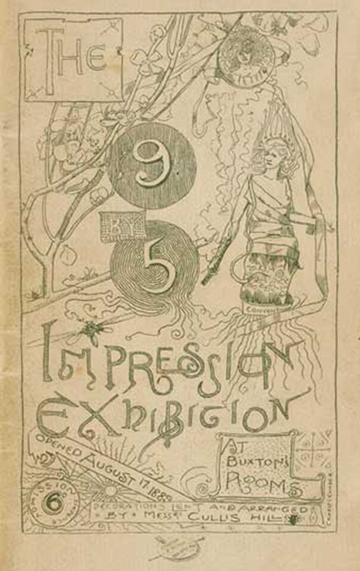
Cover of the 9 by 5 Impression Exhibition catalogue by Charles Conder, printed by Fergusson & Mitchell, 1889. National Gallery of Victoria
Arthur Streeton and Charles ConderThe same year the Box Hill camp was set up, Roberts met Arthur Streeton while painting around the waterside suburb of Mentone. By then Streeton had completed his studies at the National Gallery School and was working as a lithographer in Collins Street. Roberts was immediately impressed with Streeton’s paintings, which he described as ‘full of light and air’, and invited him to join the ‘Artist’s Camp’.
Like Streeton, Charles Conder also worked as a lithographer in the 1880s. He moved to Melbourne from Sydney in 1888 and soon began painting with the plein-air group at Box Hill and Heidelberg.
9 by 5 Exhibition
Roberts, Conder and Streeton decided to hold an exhibition of their work. They named it the 9 by 5 Impression Exhibition, as the majority of the works were painted on nine-by-five-inch wooden boards (many of which were cigar box lids). The small size meant the paintings could be priced to make them accessible to the general public. It was the first major exhibition of Impressionist paintings in Australia. It was a carefully planned, marketed and presented display. Initially the artists intended to stage the show in Roberts’ studio but changed the venue to Buxton Galleries on Swanston Street. It was a larger space located in Melbourne’s most popular gallery and artistic supply store.
The artists explained their goals as Impressionists in the exhibition catalogue:
An effect is only momentary; so an impressionist tries to find his place. Two half hours are never alike, and he who tries to paint the sunset on two successive evenings, must be more or less working from memory. So in these works, it has been the object of the artist to render faithfully, and thus obtain first records of effects widely differing, and often of very fleeting character.
The show opened on 17 August 1889 and featured 183 works, the majority created by Roberts, Conder and Streeton. The paintings’ subject matter varied widely from idyllic landscapes around the rural outskirts of Melbourne to atmospheric city views, figurative work and crowd scenes. Particular attention was paid to the presentation of the gallery. The paintings were mounted with simple wooden frames rather than the more common gilt frames and the space was decorated with silk scarves and drapes, Japanese umbrellas, screens and vases. This staging was inspired by the fashionable Aesthetic movement, which in contrast to traditional Victorian design focused on elegant, simple design with Oriental influences.
Reaction
The exhibition was a sensation. It attracted impressive numbers of visitors but press coverage varied from curious to condemnatory. The public were generally positive; a ‘lady visitor’ reported in The Evening Standard on the opening day:
Persons interested in art should not fail to visit it. If they have no other satisfaction it will be again to have an ocular demonstration of what an artist’s ‘impression’ means.
However, the Victorian arts establishment was less than enthusiastic. Australia’s best-known art critic of the period, James Smith, said in the Argus:
Of the 180 exhibits catalogued on the present occasion, something like four-fifths pain the eye.
Despite the mixed reaction, over 80 paintings had sold by the exhibition’s end and the rest were auctioned off after closing. The show was a resounding financial success for the artists.
9 by 5 Exhibition as a Defining Moment
Roberts, Conder and Streeton went on to become key figures in the history of Australian art. They were founding members of what the American art critic Sidney Dickinson named the ‘Heidelberg School’ in 1891. This was the first truly Australian art movement. Paintings from the 9 by 5 Impression Exhibition are held in almost all the major public galleries in Australia and retrospective exhibitions on the development of Impressionism in Australia frequently refer to them. The Australian Impressionism movement has come to visually represent the nation during the crucial years leading up to and after Federation in 1901.
Victorian Artists' Society's Exhibition.
By Rita.
In the anticipation of seeing a collection of works of art representative of the Australasian artists of the past, I went to the exhibition now being held in the National Gallery under the auspices of the Victorian Artists' Society in common with many, to whom such an exhibition properly carried out would prove more than ordinarily interesting, I was much disappointed. The artists of the past are not fairly represented, in some oases they are not represented at all, in others by about the worst specimens of their works available. In this section Nature is sometimes terribly libelled or parodied, though this might pass with the shoulder shrug accorded to the same liberties when taken by latter day artists, were it not that the progress of art under these skies and the improvement of the artists are not. marked, and the ostensible reason d'etre of exhibition is nullified. Nor have our contemporary artists fairly shown their own progress. Some of their best pictures are shown and some of the worst of their predecessors, the object of those responsible seeming to be that the " moderns" may have as shocking a contrast as possible. Or is it utter indifference to art amongst those who cannot forgive the least apathy in the "masses" towards their own productions, and a desire to find a new excuse to push their work age in before the public, or — charitable supposition — not being business men, and engrossed over commissions, have they been unable to spare the time necessary for the proper carrying out of their ideas ? I want not, I care not, but I cannot but regret the result, loving all art, contemporaneous and past. Again, how unjustly have some of those— who maybe termed the pioneer Australasian painters — been treated by their successors. Oh, fie, whoever is responsible ! To particularise these for a moment. Is that Valley of the Mitta Mitta a fair specimen of Guerard's style? Do the works shown include his best work obtainable! Also with Chevalier? He can afford to smile since he has become famous Why is John Gully not represented ' One of his water colors— -and an earlier one too, and far from his best, so it should have suited — is in the National Gallery. Could it not have been borrowed, at others have been? Have you not heard of any Victorians who possess a Gully produced after his water colors were hung along side the British water colorists works And John C. Hoyte. He has labored much in the cause of art, and many a Victorian would have lent a better picture to hang alongside the crude one exhibited to testify to his progress. Standing before the works of those who have gone to that Melbourne whence none return, the first thought that strikes one is that Australian scenery is viewed by them through foreign spectacles and so painted. Who would ever suspect these resemblances to the crudest types of German paintings to be well-known Australian scenes ? We need not ask where the artist got his ideas of art. His style and coloring tell us.
Pioneers of art in Australia—and let us reverence our pioneers, they are the chief antiquities, so to speak, of a new country — they were never Australian artists. No; they are growing up now around us, and may they take lessons from the paintings I allude to and be true to themselves and their country, and paint it as it fa, and not as seen through spectacles put on in any art centre, however famous. " A hand to do, a head to plan, a heart to feel and dare" is what is wanted to make Australian artists. Nicholas Chevalier — who that has seen any of his later works, with their clear brilliant coloring, would suspect he could at any time have been responsible for Buffalo Ranges ? Yet he is the — I had better say alleged artist — till the libel law is altered. Some little water-colors — not the best specimens of the artist's style — by Mr W. M. Hodgkins, an amateur who has done much in the cause of art in Dunedin (N.Z.) remind me when my eye falls on them of several other enthusiastic workers who. are not represented. On the screens where the water colors hang some of Mr J. Mather's, work confirms an opinion I formed some time ago that the artist is usually much more successful with his aquarelle fork than with his oils. On the end screens Carl Archibald's pen and ink sketches show some clever drawing. Action is depicted, and ofttimes remarkable expression fa achieved by a single line. The rest of the work is done by two classes of artists, sometimes Australians, sometimes not, who are comparatively recent arrivals. These have completed their studies in Europe, and naturally send the best work. The others are Australians who, struggling against many adverse circumstances, are endeavoring to increase their art knowledge and paint Australian scenery according to their light. The former class should act as a leaven to the other, and lead to improved results in the future. Mr Bernard TTflll is doing good work in this direction, and by my side stood several of his pupils; examining his study of a model, showing good method and drawing. Mr Tucker is at his best in An Urgent Call, notable for clever drawing composition and coloring. This artist imparts a feeling into his work that arrests attention at once.
Too much of the work on the walls is exercises in color without sentiment. Mr Fox is another artist that interests immediately. Still, both of these must show something distinctively Australian if they wish to be regarded as Australian artists. Foreign interiors and exteriors Are excellent in their but Bp %ax!y of them have been done find Che is 6o Bkd another, and there is everything to be done in Australia Vet. "When our travelling students return home probably we shall find that as others before them they have run after strange gods, and Australian subjects remain untouched. That is one reason why I like Mr F. M'Cahbin's work— he is patriotic. Some of his best work is to be seen in this collection. Victoria pays L23,000 a year subsidy for the present British mail carriage - Weekly Times (Melbourne, Vic. : 1869 - 1954), Saturday 2 September 1893, page 7
Sydney's Botanical Gardens Museum – opened March 8th, 1901
BOTANICAL MUSEUM AND NATIONAL HERBARIUM.
New buildings have been erected in the Botanic Gardens for the purposes of accommodating a Botanical Museum and National Herbarium, and these were officially opened on the 8th inst by the Hon. John See, Colonial Secretary, and Mrs. See. The director, Mr. T. H. Maiden, had invited a number of ladies and gentlemen interested in botany and kindred sciences to attend at the new building, and there was in consequence a large gathering. Among the gentlemen present were Mr. Crachett Walker, C.Md., Canon Hey Sharp, Rev. W. Ivor Smith, Rev. W. R. Mounssy, Judge Doceer, Professor David. Dr. R. N. Moirs, Dr. O. E. Kennie, Dr. Cobb, Mr. P. G. King, M.L.C., Captain Charles, M.L.C., Mr. A., W. Meeks, M. L.C., Messrs. Her.ry Deane, It. A. Price, W.L.A., P. N. Trebeck, .1. R. Girlan'l, Harrie Wood, A H. S. Lucas, W. M Froggatt. W. M. Hamlet, G. H. Knibbs, K. Grieg Smith, Littlejohn, H. A. Lenhan, G. Hoper, G. Layton, J. H. Norton, and Alderman M'Eltmne. Mr. Maiden briefly stated the disposition of the collections, and Mrs. John See, who was presented with a handsome bouquet by Miss Mary Maiden, declared the museum opened. Mr. See, in addressing the company present, said he was invited to say a few words, and he congratulated the people of New South W. L-s on the of session of so valuable an adjunct to scientific knowledge. Not only was it a State possession, but it was a value to the whole continent, both from its historical collections and its possibilities for the future. The money which the Botanic Gardens cost was well spent, for nowhere had lie seen better gardens. While he was Colonial Secretary he would not begrudge liberal assistance to so delightful a possession of the city. He cordially congratulated Mr. Maiden on the admirable work that gentleman had done. Mr. R. A. Price, M.L.C. moved a vote of thanks to Mr. and Mrs. See, and he also pointed out that the museum had a commercial and utilitarian value in connection with our forest resources which he believed was inestimable. The ground floor of the building contains a herbarium, 41ft. x 31ft. ; museum, 40ft. x 30ft. ; and other rooms and conveniences. On the first floor are a herbarium, 41ft. x 31ft. ; herbarium, 40ft. x 30ft. ; and other rooms.
THE BOTANICAL MUSEUM.
This is said to be the first museum in Australia strictly botanical in character. A botanical museum is a recognised adjunct to a botanical garden through out the world. While scientific accuracy it always aimed at, the museum will be found attractive to the great majority of visitors. As regards the specimens, the nucleus of them was brought together by Mr. Charles Moore, the late director, and his specimens have been retained wherever possible. An original museum contained about 800 specimens, the new one contains over 7000. Those of lesser public interest are arranged for easy reference in cabinets fitted with drawers, which form the pedestals of all the the cases. The arrangement is strictly botanical. In each natural order will be found samples of seed, fruit, leaves, bark, wood, gum, crude time, and anything in imy way illustrative or characteristic of the order. The wealth of plants in the gardens furnishes much material for the museum, while cognate institutions in various parts of the world regularly contributes to the ocllectioin by way of exchange.
The room in which the museum is at present housed will be remembered as the home of the former museum, altered somewhat in consequence of the election of the National Herbarium and administrative offices in the same block. Mr. Maiden has a small native flower show, in which are displayed flowers indigenous in the neighbourhood of Sydney and others growing in the Botanic Gardens. Precedence has been given t- jialinh, cycarte (the Bunawang family), couit'erre (piue-, &c), iiintexds (honeysuckles, geebungs, &c), acacia, and eucalyptus. A fine case of fungi arranged by Mr. A Grant claims attention ; it contains only typical specimens. In the south-west angle of the museum start the ranuncuiaceae, and the orders are thenceforward arranged from left to right. Most orders are represented. In jars, preserved in its liquids, are a large number of specimens of fruits (edible and otherwise) cultivated in the Botanic Gardens or growing wild in Australia. The museum contains Urge models to illustrate the anatomy of the root, the stem, the leaf, series lilustrating the various stages in the germination of a dicotyledon (bean) and of a monocotyledon (whist). There are other models to illustrate the positions of the ovule with regard to the cavity or cell in which they are placed, and an inter piing series showing some of the principal forms of inflorescence. A number of large models to illustrate natural orders of plants is on view. A good series of models to illustrate the fertilisation of the flower of the grape vine will be found instructive. Also there is a fine series of specimens of insect pests which damage garden plants*. Photographs of characteristic specimens of native trees, such as the various kinds of ironbarks, spotted gum, blackbutt, woollybutt, blue gum, tallowwood, with their botanical and common names attached, will interest all those who desire knowledge in regard to our native trees.
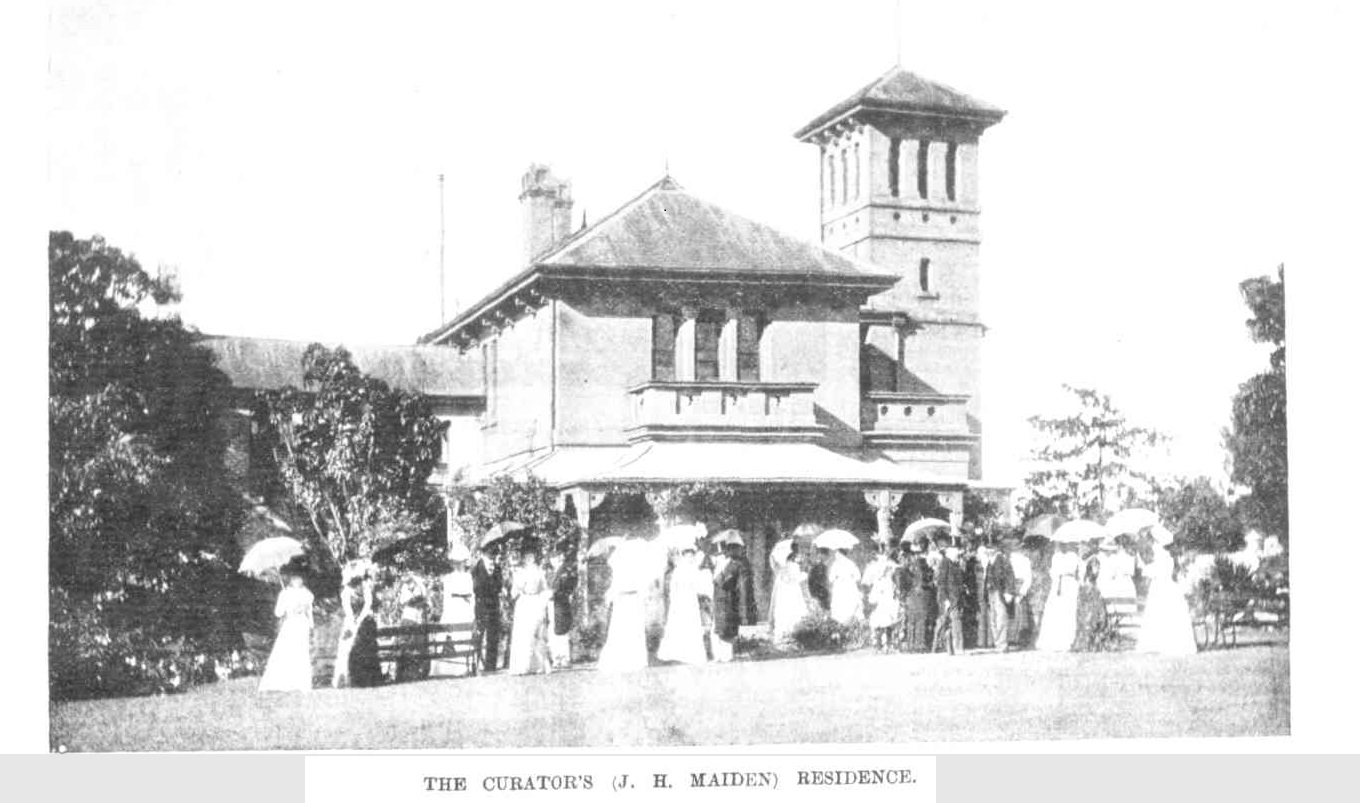
THE CURATOR'S (J. H. MAIDEN) RESIDENCE.
.jpg?timestamp=1586589615917)
THE HERBARIUM.
.jpg?timestamp=1586590003548)
HERBABRIUM No. I. THE CURATOR IN HIS OFFICE.
A fine series of photographs showing characteristic trees and other vegetation of the dry West is shown, also steel engravings showing characteristic scenes of Australian vegetation and interesting trees. A number of pictures of our beautiful native flora are displayed. A very fine series of large coloured drawings, showing the inflorescence and fruit of certain plants yielding articles of everyday use, is specially attractive. They consist of tea, coffee, cocoa, sugar cane, cotton, cinnamon, block pepper, allspice, cloves, ginger, nutmeg, and vanilla. There are many coloured pictures of interesting garden and hot-house flowers, the latter including a fine collection of pictures of orchids from the London ' Garden.' The walls of the museum are adorned with a number of portraits of botanists, and it is intended to make a specialty of memorials of such men it Science.
THE HERBARIUM.
The herbarium contains the reference collection of dried plants just as the garden contains the collection of living plants. But whereas a garden can in practice only contain a few thousand species, a herbarium contains 10 or a 100 times as many, and all in a small compass. In the garden when a plant goes out of flower or fruit, we may have to wait the greater part of the year to find it in that stage again ; in a herbarium, once in flower, always in flower. Besides a herbarium contains seeds and all parts of plant whether fit for cultivation in the garden or not, and many plants which certainly could not be brought under cultivation in Sydney even if it were desired to do so. Plants from the vicinity of the Poles and of the Equator, from the sea level and from high elevations, all rest comfortably in the herbarium. In the present building the cryptogenic herbarium is in a large room on the ground floor. Here are stored the mosses, the fungi, the lichens, and the seaweeds, together with the fossil plants. The first floor is devoted to the phanerogams of flowering plants. The room to the east coutains the Australian plants to the number of some thousands, and New South Wales is very strongly represented.
.jpg?timestamp=1586590139193)
VISITORS AT THE OPENING CEREMONY.
.jpg?timestamp=1586590181857)
THE STAFF. E. Betche. G. Harwood. A. H. S. Lucas. J. H. Camfield. E. Nichol. A. D'Arcey. E. C. Saint Smith. Miss E Vivian. Miss S. Hynes. J. H. Maiden (Director). Mrs. D. C. Murphy. E. Atkinson-Price. Miss E. Ambler. V. Roberts
The room to the west contains the exotic plants, and is already rich in plants from all parts of the world. Tables of the director's own design for pui poses of study anl for handling the collections are placed in convenient situations. The building has no balconies, and plenty of large windows, through which comes a flood of light, so that on the dullest day the examination of specimens may be proceeded with without interruption. Iron bookshelves of special design, known as the Oxford bookcases, are placed alongside the plants to which they refer. Scientific botany has now worthy headquarters in New SouthWales, and the director expresses the hope that the erection of this excellent building will be contemporaneous with the active development of botanical science in the colony.
.jpg?timestamp=1586589859697)
THE MUSEUM.
BOTANICAL MUSEUM AND NATIONAL HERBARIUM. (1901, March 16). The Sydney Mail and New South Wales Advertiser (NSW : 1871 - 1912), p. 662. Retrieved from http://nla.gov.au/nla.news-article165292514
WHEN AUSTRALIAN ART WAS IN ITS STURDY YOUTH
Some National Gallery Memories Recalled by a Picture of the Student Days of Present Celebrities
By JO SWEATMAN
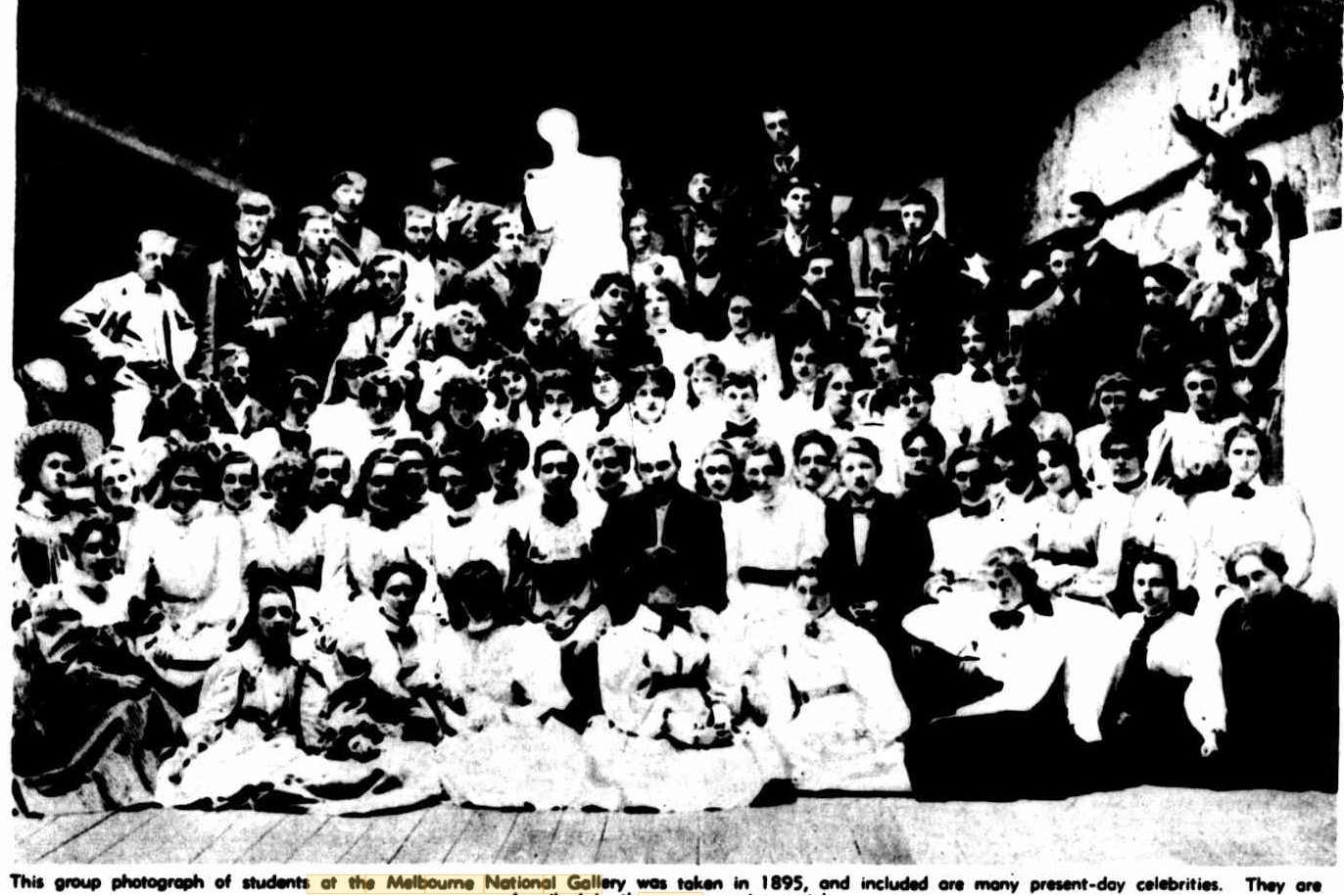
[Photo Caption]: This group photograph of students at the Melbourne National Gallery was taken in 1895, and included are many present-day celebrities They are described in the accompanying article.
Memories of early days at the National Gallery, where many of Australia's finest artists first put pencil to paper, are revived by the Victorian artist, Miss Jo Sweatman, who from her home of Warrandyte - that artists' paradise "discovered" by some of these early students - sends the following reminiscences, with interesting comments on the personalities in the accompanying photograph
"It is impossible to think of the Old Gallery days apart from Fred McCubbin, that dearly loved man.
In both Mr. and Mrs. Mac students found inspiring and sympathetic friends, who kept open house on Sundays to painters, musicians, and senior students at their home in Brighton.
Mr. Mac had a fine tenor voice, and, singing "The Erl King," hands clenched, hair more than ever on end, and voice almost hoarse with horror, he thrilled one to the marrow. Mrs. Mac was full of energy and enterprise. She first discovered the Athenaeum Hall and helped to make it the present home of painters.
Among the students surrounding Mr. Mac in the photograph are many now well known. Isobel Hunter (Mrs. J. T. Tweddle), who was nicknamed Diana and considered the cleverest of the girls, is on the extreme left in a big hat; A. M. E. Bale can be easily recognised second to the right of Mr. Mac, and also the Hake sisters, Dora (Mrs. Percival Searle) in the back row behind Alice Bale, and Elsie (Mrs. A. Barlow) on the floor in front of Alice.
Second to the right of Alice sits Bessie Norris, a remarkable personality, who considered she was "the reincarnation of an Egyptian princess. A genius in her way, she did little study, but worked along her own lines with water-colours and pastels. Later she made a name for herself in London for her miniatures, and married Jim Tait, one of the theatrical family.
No reminiscences of gallery days would be complete without mention of "The Family." This institution arose through Agnes Kirkwood, who sits just below the statue of Venus. She being rather older than the other girls adopted a motherly attitude to them, and was nicknamed "Mamma" a name which persisted all her life. Then George Coates, who was a solemn "boy and intensely interested in his work, became "Daddy," which he took with complete equanimity. "Pa, Ma, and Young Hopeful" he remarked once as they and Max Meldrum traversed the corridors together.
This was Meldrum's first nickname, but later he inevitably became The Laird. He, standing high up next Venus in a felt hat, was full of fun and mischief, and even then it was fruitless arguing with him. George Coates stands in front of him, and beside him, next Venus, is Leon "Sonny" Pole. In front of him to his right is Ada Plante, nicknamed The Tinted Venus (after a book of Anstey's in vogue at the time) because of her head of brilliant hair. This nickname was shortened to "V," and aroused The Laird's curiosity which we never gratified.
Once he dashed into a studio - "I have it Miss Kir-r-rkwood I have it Vesuvius!" and fled before he would be dealt with. To the left of "Mamma" is Rose McPherson, who soon went Londonwards, and returned (so it is said) as the Margaret Preston who dropped the bomb of modern art on Sydney. Standing next George Coates is Carl Archibald, brilliant black and white worker, who went to London and was killed on his way home The Archibald prize, founded by a Sydney uncle was doubtless to his memory.
Below Coates and Archibald is Harley Griffiths who went from art to commerce. His son Harley now carries on the artistic torch. John Hen-nessy's well-known face is seen a little to the left again. At the right Victor Cobb, the etcher towers level with Venus, with George Bell just below him, both easily recognisable. Quiet, shy Leslie Wilkie stands away to the right. He later became Director of the Adelaide Gallery until his death. "Sonny" Pole was a caricaturist and light-ning sketcher, who delighted in adorning the walls with himself in various moods. He was inseparable from an aged brass whistle on which he could pipe "The Yeomen of the Guard" with such pathos that it almost drew tears.
A MUSICIAN of a different calibre was Herman Kuhr, an Austrian, who played the French horn in Marshall Hall's orchestra, and had a big reputation there.
The Lindsays and other bright spirits are not in the picture Percy was the steadiest worker of the family, which fact helped to make him the fine artist he is. Lionel came later, and used to float round in a curly moustache and cycling knickers which looked rather like "side" in those days, but which we heard later were his only pair. Another brother told a story of him that he grew tired of making his bed, so tacked the clothes all round the stretcher and henceforth happily slid in and out night and morning
Of Norman there is just one memory of a journey to the Macs from town, when he argued all the way and half through the afternoon about Wagner's music. It then transpired that he had never heard the opera in question, only read criti-cisms of it, and was just letting the wind blow his tongue about.
Lovely, vivid Ruby, with eyes like stars only joined the gallery family occasionally. Her work was largely influenced by her brothers, but she married Billy Dyson and went to London. There she found her own province in delicate pen and ink illustrations until during the last war death put an end to her electric personality.
There was also Hughie Ramsay, whose rapid transit through the schools gave rise to murmurs of "fatal facility" his fellows little knowing how short a time he had to do his work in, and Dora Meeson, who came from the N.Z. schools, and later married 'Daddy" Coates in England when he got the travelling scholarship in 1897. ‘’Young Hopeful’’ followed him with the next scholarship.
Jim McDonald one mainly remembers for his arguments. Did he ever have a premonition of the future, I wonder, when "Barney" Hall's warning cough resounded along the corridor? There were also lanky Ambrose Patterson and handsome energetic Myer Blashki, both of whom went to America. The former brought a pre-modernist exhibition back many years ago and the latter re-turned as Miles Evergood, that delightful colourist.
In post-gallery days "The Family" made contact with Clara Southern, discoverer of Warrandyte and accompanied her there, and thus was instituted "week-ending and the cult of the gumtip." This formed the nucleus of the present Warrandyte group, with its ramifications into music and literature. WHEN AUSTRALIAN ART WAS IN ITS STURDY YOUTH (1941, April 5). The Argus (Melbourne, Vic. : 1848 - 1957), p. 4 (The Argus Week-end Magazine). Retrieved from http://nla.gov.au/nla.news-article8153082